Signals One™ - What's New
Signals One™ is a complete, integrated data capture, processing & analysis SaaS software for scientific research. Capture, manage, and share experiment data, notes and research findings in a secure and accessible environment built on the foundation of the Signals Platform.
Check out the latest improvements:
Releases By Year
What's New
We are delighted to release our new version of Signals, 25.10. This release brings enhancements in versioning, equations, Variation Tables, Inventory and Synergy amongst others. We have new beta capabilities for viewing published data from Material libraries and around calculating protein properties. We have extended beta capabilities around Hierarchical Tables and Contextual Lists. The beta capabilities around text extraction from images and publishing samples are now available to all systems. Finally, we have also fixed a number of small bugs.
The following improvements are available for users, administrators and developers on the Signals platform. Certain features may only be available with appropriate licensing and/or with enablement by an administrator.
- Fundamentals
– Origin Template (Original Name) property for versioning
– Increase of Task creation limit to 2000 - AI
–Text Extraction from Images for Signals One customers available to all systems*
–Admin options to enable/disable AI functionality in Signals One available to all systems* - Data Workflows & Analytics*
–SPR Data Import App available in Spotfire for Signals now supports Carterra file schema versions up to 10 - SAR & Decisioning*
–View Published Data from Material Library (beta) - Synergy†
–Failed Status on Work Orders
–Choice of Work Order transition when submit the only Synergy Experiment - Chemistry
–Inclusion of Barcode to Internal Enumerator mapping
–Inventory Decrements from Parallel Experiments
–Context-sensitive ChemDraw floating toolbar
–Drag-and-drop RXN files onto the ChemDraw canvas converts to CDXML
–Atom numbers can now be enabled via a checkbox in the Properties panel - Admin Defined Tables, Variation Tables and Hierarchical Tables
–Calculate Number with Unit from a Number property
–Calculate Maximum
–Publish Samples available to all systems
–Updates to the Internal Reference Column Name Configuration
–Addition of Internal Reference Lookup in Variation Table
–Copy/Paste with Hidden Rows in a Variant Table
–Internal Reference type properties can be used as source for Contextual Lists (beta)*
–Search of Hierarchical Tables (beta)*
–Hierarchical table data optionally included in exported PDF (beta)* - Inventory
–Updates to Bulk Container Import
–Return Containers to Home Location
–Updates to Container Aliquot Workflow
–Create Sublocations from Parent Location
–Deleted Locations removed from Recent Locations - Materials
–Loading Measure Added to Number with Unit in Materials
–Update to Batch/Lot page
–Calculated properties for protein complexes (beta) - ELN Archive
–Preview ELN Archived Experiment Types directly in search results - Administration –Update Definition privilege
–Spotfire for Signals Custom Apps Configuration available for Private Cloud now tracks Custom App module version*
–Configuration Transfer of Contextual Lists in Worksheets (beta)
–Configuration Transfer of Hierarchical Table Templates (beta)
–Hierarchical Tables included in Configuration Report (beta)
–Contextual Lists included in Configuration Report (beta) - Integrations & APIs
–New API for exporting Orders
–New APIs to support Supplier List
–Enhanced APIs to support Supplier List Fields
–Enhanced API for Text element export
–New API to replace Chemical Drawing with a Duplex
–Enhanced API to allow expanded chemical formats for uniqueness checking
–New API to update Synergy Experiment Status
–New API to close Synergy Work Orders
–Enhanced API to allow creation of Work Orders with templates
* Requires Signals One license
† Requires Signals Synergy license
We also fixed several small bugs in this release. Details of the enhancements are described below.
Administrators should be aware that the Normalized Compound Salt Stripping tool will change to better handle fractional coefficients by altering how multi-fragment salts are interpreted from the Salt List. This change will occur in a future release and only apply to registrations subsequent to the change, existing compounds will remain with the prior understanding until edited.
Developers should note that this release addresses an issue with the GET /entities/{eid}/export endpoint, where the response returned an incorrect Content-Type header for Text entities. The header was set to text/plain, while the actual content is text/html. This only applies to text elements created through text file upload.
Data Factory administrators should be aware of several important updates. The latest version of Data Factory has officially exited beta, and all older versions of Data Factory projects and apps are now designated as “Legacy.” As part of this transition, it is no longer possible to create new legacy Data Factory projects through the user interface. We strongly encourage administrators to begin adopting the latest Data Factory features, as legacy projects will be fully deprecated in a future release. A simple migration path will be provided in a future release to support this transition.
Data Factory administrators should also note that the Advanced Security policies in Inventa apply an “AND” logic across all user groups, restricting access if any groups lack permissions. This behavior differs from the standard Signals security model and will be fixed to align with the standard in a future release.
Administrators are recommended to subscribe to the channels within our support news site found at https://support.revvitysignals.com/hc/en-us/categories/360004446171-Support-News which contains more information about releases and other pertinent product information.
This content is anticipated for release on our Production E3 environments, and for Private Cloud customers on our deferred release schedule, in March 2026.
Further Details
The following improvements are available for users, administrators and developers on the Signals platform. Certain features may only be available with appropriate licensing and/or with enablement by an administrator.
Fundamentals

A new property, called “Origin Template (Original Name)” is now captured on templated content such as ADTs, Variation Tables, Hierarchical tables, Worksheets and Experiments. This searchable property captures the name of the template used to create the item. Unlike the existing Origin Template property, which updates to reflect the current name of the Template will show the name at the time of creation. For items where the definition can be updated, the captured value will be updated if you update the definition. This allows the name of the template to be used to indicate and update the version of the definition. Note that this property is only present for content added or updated after this change.
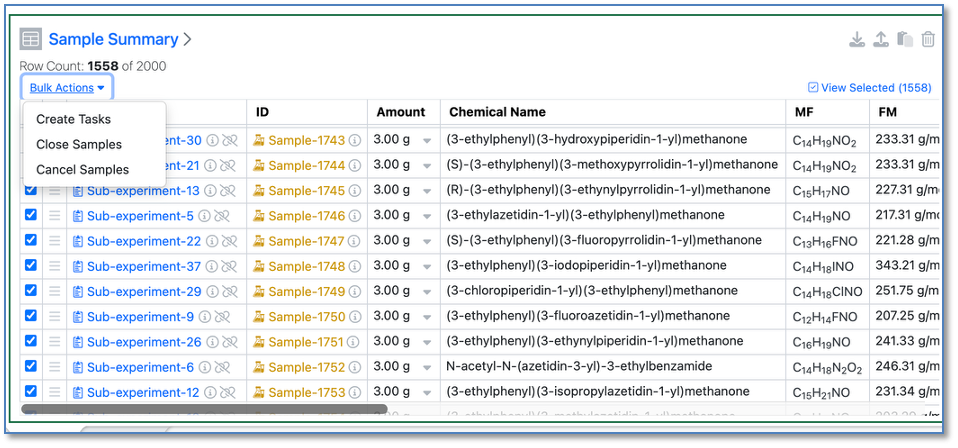
Users will now be able to create up to 2000 tasks at a time through the task creation modal and via bulk actions. It should be noted the behavior of task creation is unchanged only the limit has been extended.
AI
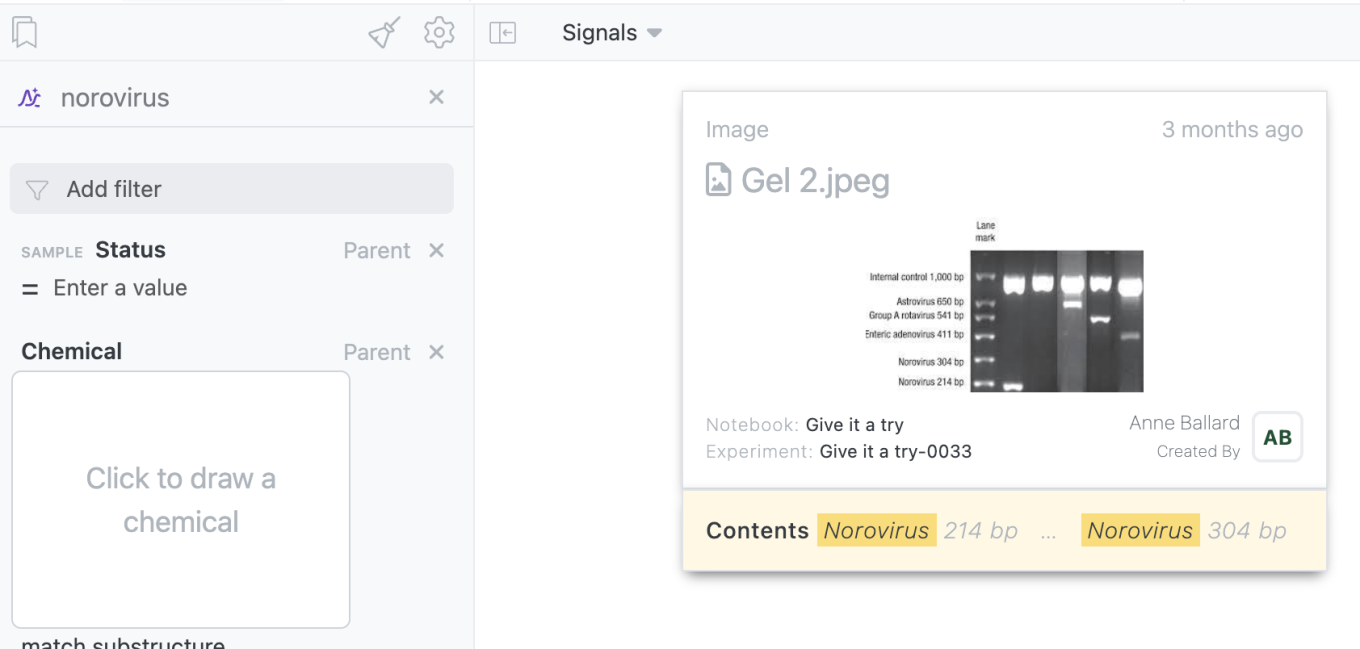
For tenants with a Signals One license, users will now be able to utilize AI to extract and search by text from Images uploaded to Signals Notebook. This includes files of JPEG, PNG, and TIFF. This will apply to newly uploaded images only. Should a use load an image similar to the one below they would be able to search for it using keywords from the image like Control, Norovirus, etc.

Administrators will now be able to enable or disable new AI features utilizing the AI settings options. AI features still require a Signals One license and infrastructure to function. This just allows the admin more granular control on when these features are made available to end users. This currently only includes Text Extraction from Images for all systems
Data Workflows & Analytics
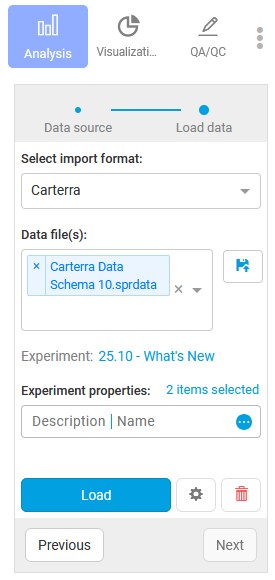
SPR Data Import App available in Spotfire for Signals now supports Carterra file schema versions up to 10.
Synergy
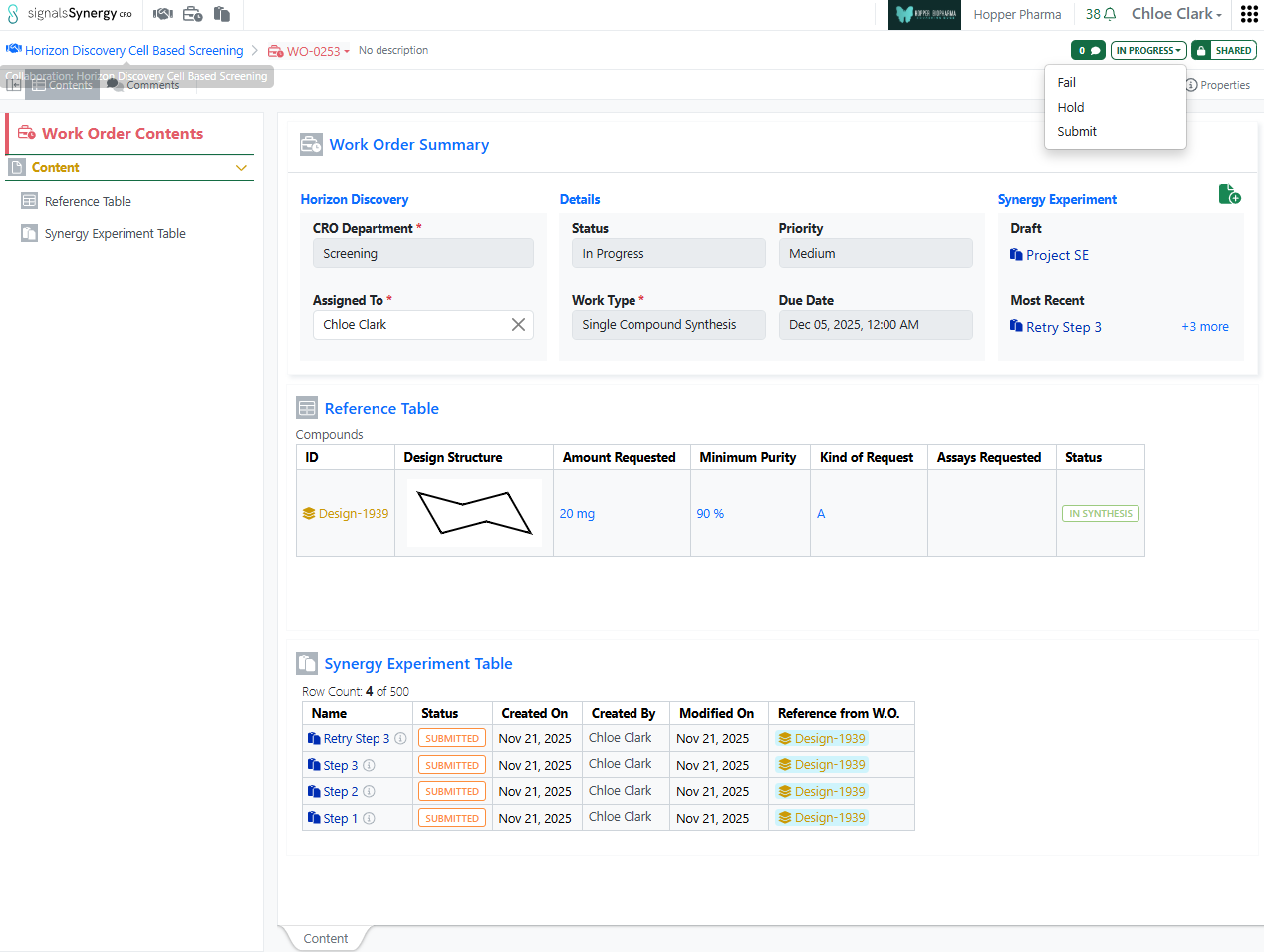
Sometimes a CRO is unable to successfully complete a Work Order for the Sponsor. For example, synthesis of a Design may fail, even after several successful steps or attempts, each submitted as a Synergy Experiment. Thus, at the time of Work Order submission, the CRO can alternatively submit a Work Order as Failed and provide a reason. The new Failed status is represented on the Work Order Kanban Board and included as an available External Notification.

Previously, in the case where there was only 1 Synergy Experiment for a Work Order, submitting the Synergy Experiment automatically submitted the Work Order. We now allow the user to choose how to transition the Work Order when submitting the 1 Synergy Experiment. The user can Submit the Work Order along with the Synergy Experiment, Fail the Work Order as they submit the Synergy Experiment, or do nothing to the Work Order (e.g., desire to continue adding more Synergy Experiments to the Work Order).
Chemistry

The barcode can now be mapped as part of importing SDFs into the Parallel Experiment internal enumerator along with the container ID. These values should also be visible in the stoich grids for the enumerated subexperiments.
We are now able to support Inventory Decrements from Parallel Experiments. Users may need to unhide the Inventory Decrement, Container ID and Barcode in the table:

Add New Compounds:
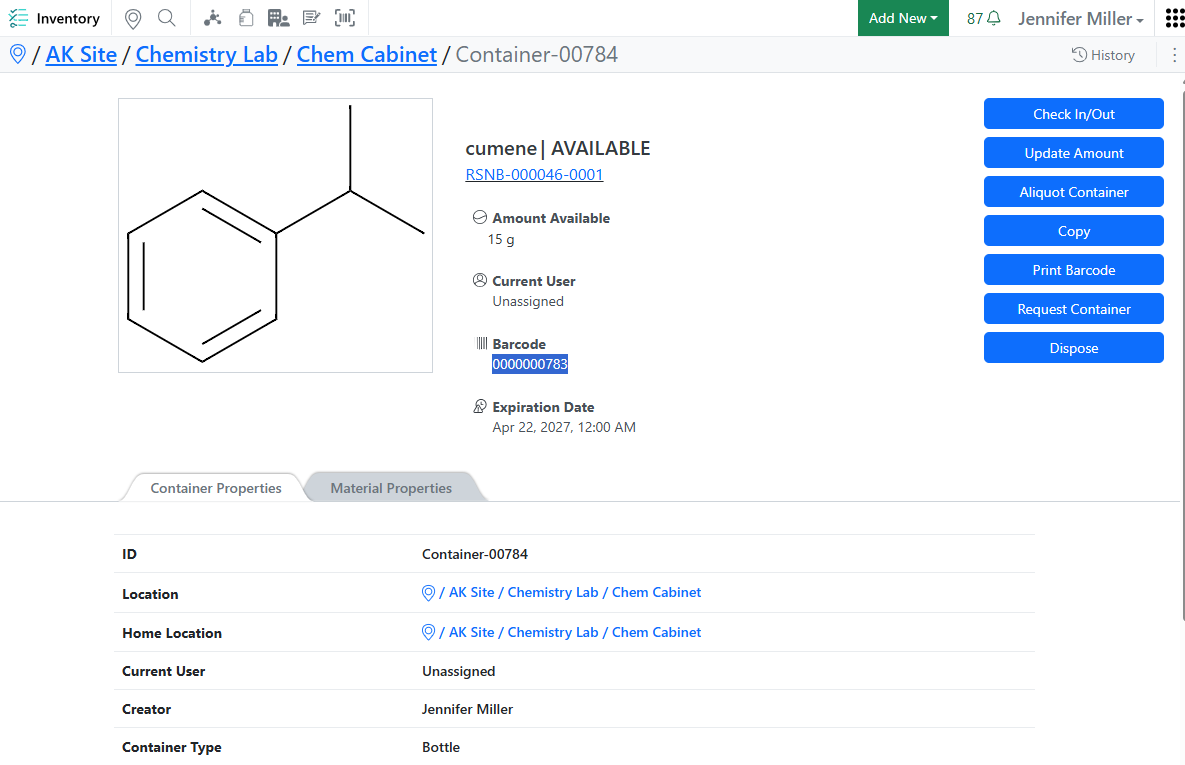
Containers will automatically update from Available to In Use and the Current User will update from Unassigned to the logged in user.
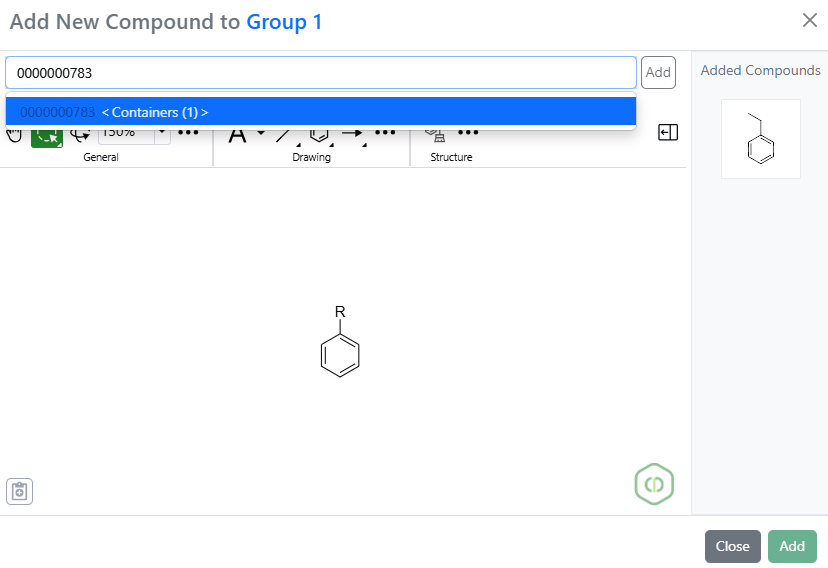
Scan or type the barcode into the search bar:

Add the container to the enumeration:

The container ID and Barcode will appear in the table. Users need to type in the full amount they will be removing from the container in the Inventory Decrements. This means that the user needs to know how much they will need for each sub experiment and put the total of that in the Inventory Decrement. This saves the user from having to navigate to every sub experiment to put in the Inventory Decrement:

Once the user types a value in the Inventory Decrement, the Current User, the Status and the Amount Available will be automatically updated. Users need to type in the Inventory Decrement before they enumerate the reaction:
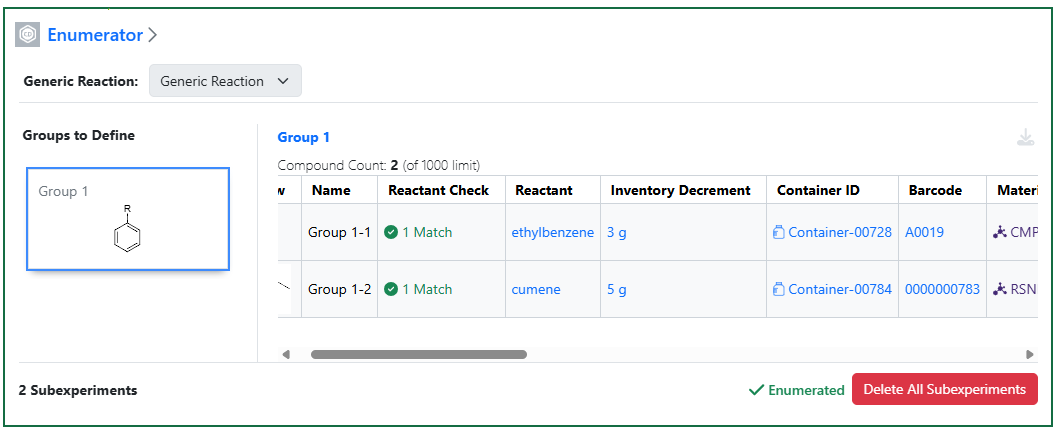
Once the reaction has been enumerated, the Inventory Decrement column can no longer be updated:

Each sub experiment will show the Container ID and the Barcode, but not the Inventory Decrement column. This is done on purpose, so that users do not try to update the Inventory Container from a Sub experiment:

The ChemDraw editor now includes a context-sensitive floating toolbar. When content is selected on the ChemDraw canvas, a toolbar appears above the selection, displaying commonly used tools based on the selected object. As the pointer moves away from the toolbar, it automatically hides to minimize disruption to the editing process.
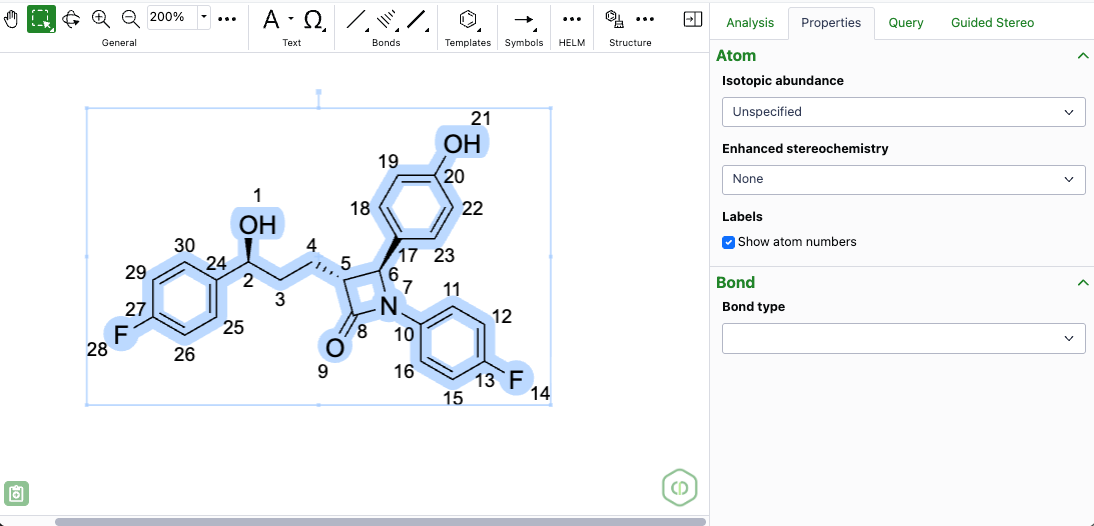
RXN files can now be dragged and dropped onto a ChemDraw canvas and converted automatically to cdxml for continued editing.
Atom numbers in ChemDraw can now be enabled for a selected object by selecting 'Show atom numbers' in the Atom section of the Properties panel
Admin Defined Tables, Variation Tables and Hierarchical Tables

Configuration Administrators can now define an equation to convert Numbers to Number with Unit properties. The CONVERTNUMBER function can be applied to properties of type Number with Unit. The function follows the format CONVERTNUMBER(Arg1, Arg2, Arg3) where Arg1 is an input property of type Number, Arg2 is the unit within the measure to apply to the Number. Arg3 optionally allows conversion to a different unit within the Measure.

A Configuration Administrator can also define equations to calculate the maximum of a series of data. The functions MAX and MAXOVER allow the selection of the largest of a set of data. If applied in a Header, the conditional maximum can be calculated using MAXOVER or by nesting an IF functions within MAX.
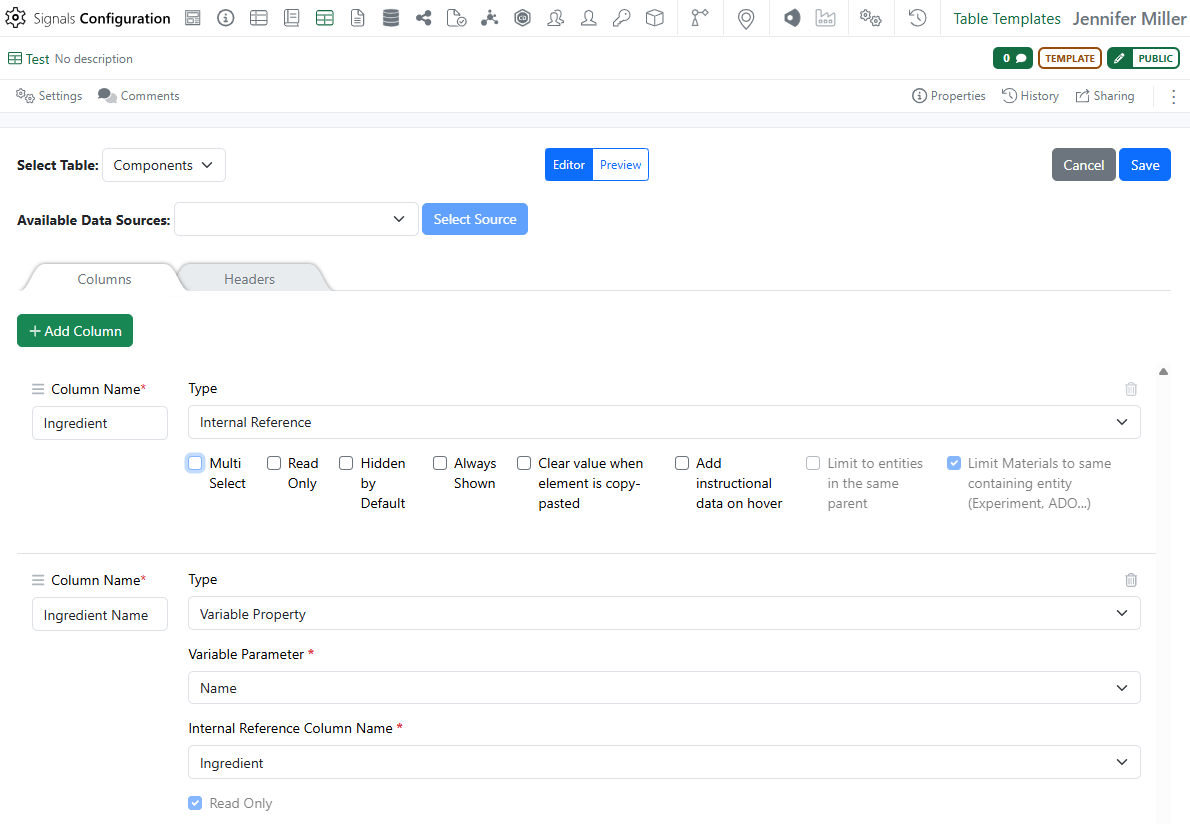
Publish Samples is now available to all systems. We’ve made an update to the Internal Reference Column Name drop down. When using the Internal Reference in configuration, the ability to refence the Internal Reference is not available for fields set to Multi-select. This has been updated to prevent misconfigurations.

If Multi-select is checked the Internal Reference is no long available to select in the Internal Reference Column Name:
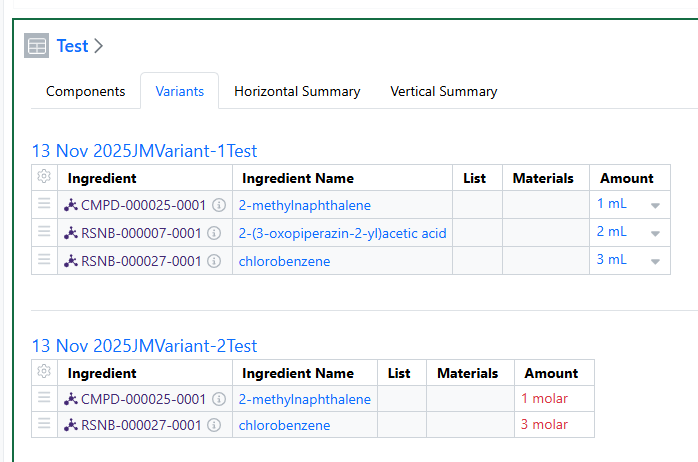
Variation tables with hidden rows in the variant can be copy/pasted into. The hidden rows will be skipped over and the values will be added to the next row that is visible:
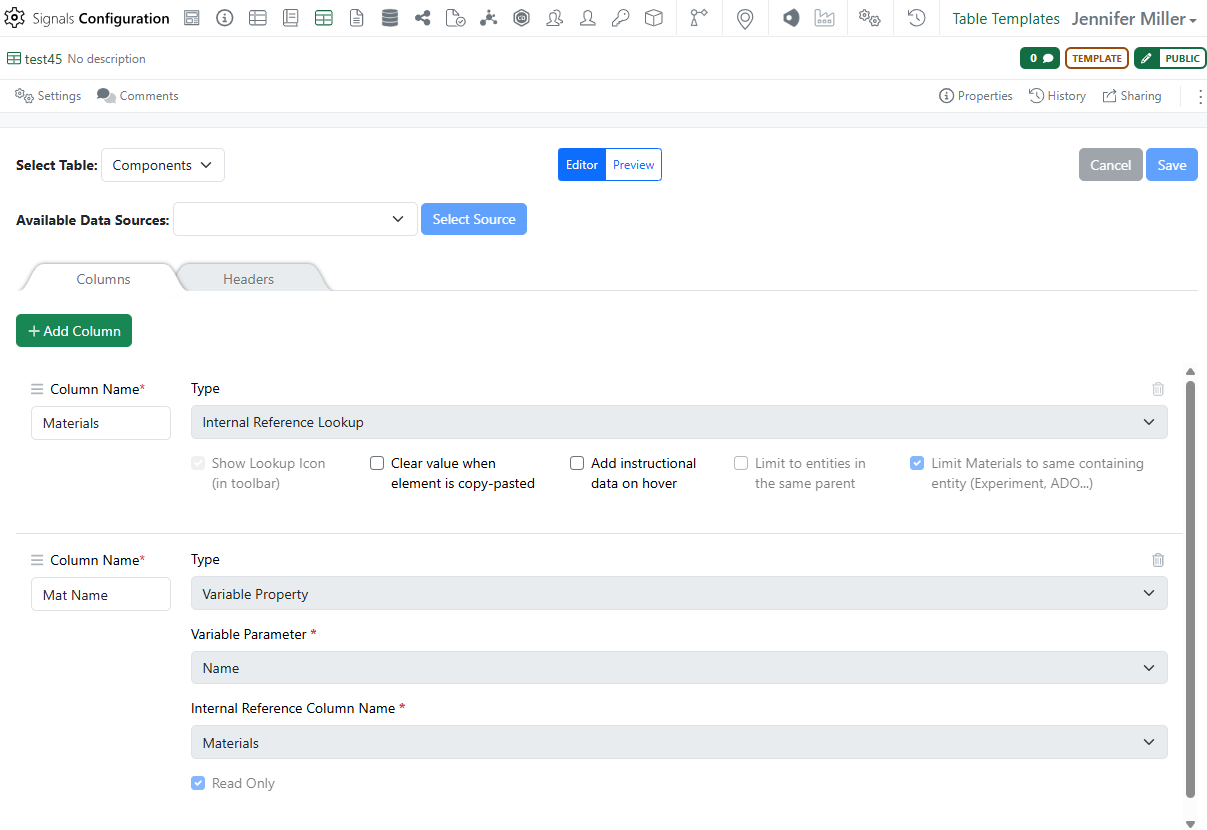
We’ve added a new Type in the configuration of the Variation Table. This is called Internal Reference Lookup. The purpose of this type is so that the administrator can configure a multi-select (from Materials already referenced in the experiment) that will put the materials into separate rows in the Variation Table.
Administrators should select the new Internal Reference Lookup from the Type drop down menu. Only 1 Internal Reference Lookup column is allowed per table so that the magnifying glass icon is associated with only one Internal Reference Lookup column. Administrator will need to select the “Limit Materials to same containing entity…” The “Show Lookup Icon…” will be automatically selected and greyed out:

When users make a new table in the experiment, they will see the magnifying glass in the top right corner of the table:

When users select the magnifying glass, they will see a list of Materials that are already referenced in the experiment. They can multi select all the Materials they would like to add to the Variation Table:
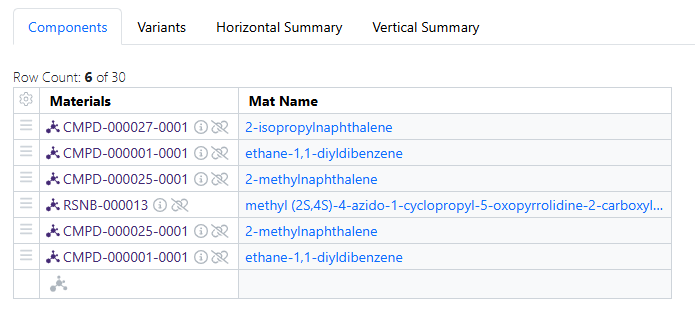
Selected Materials will be added in separate rows in the Variation Table:

Under the Property Type column Administrators can now choose Sample Properties as an option to be printed on the container labels:

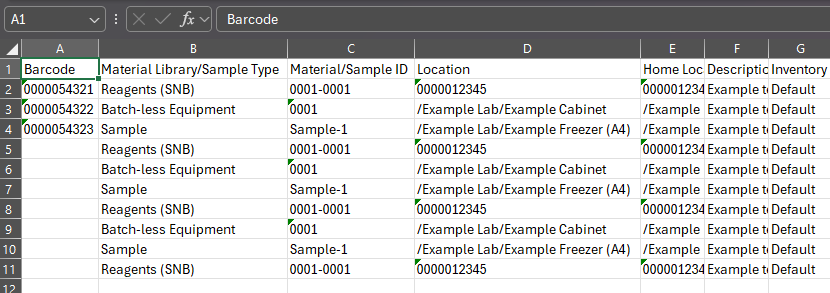
We’ve made an update to the Bulk Container Import to have separate columns for the Material Library/Sample Type and the Material ID (Asset + Batch/Lot). This means that the example files have been updated and any template files that were used previously to bulk import containers, will need to be updated to have the additional column to import the data correctly:

Users can now return a series of containers to their Home Locations. Users can Search or filter for the containers that they would like to have returned to their Home Location on the Containers Search Table:


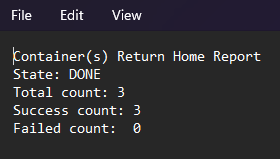
Once the containers are selected, and the Return to Home Location has been selected the containers with Home Locations will be updated. Any containers with out a Home Location will remain in the Current Location and they will be shown in the report as failures:
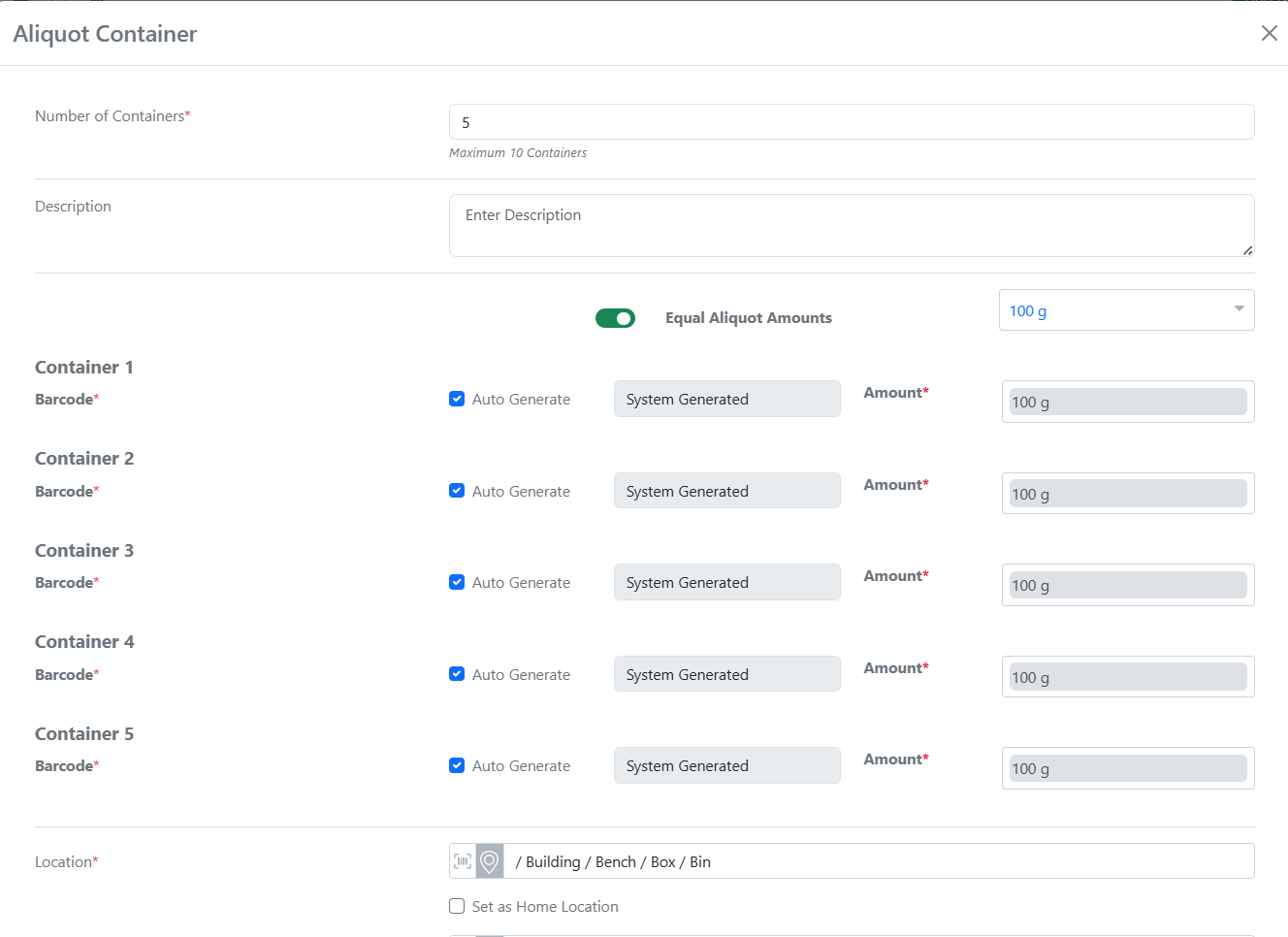
You can now split a container into multiple sub-containers with an option to make all aliquot amounts identical. This helps save time and reduce manual entry when preparing multiple identical vials.
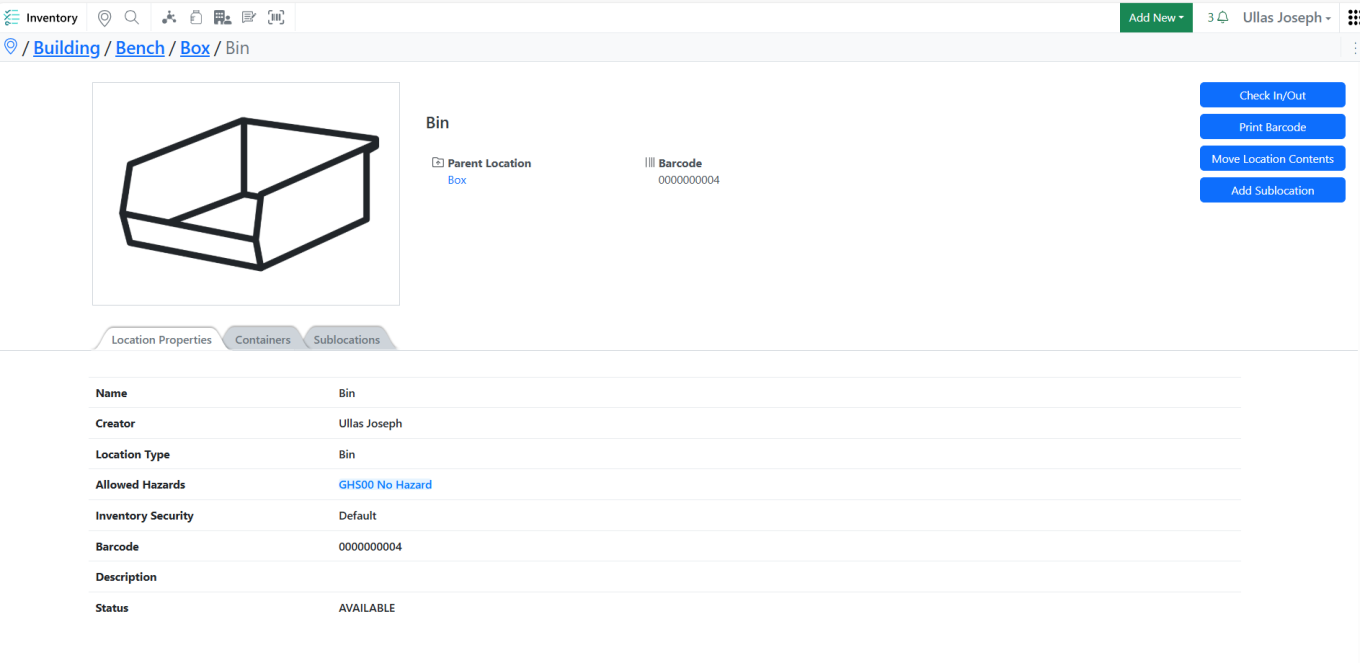
Admins can now create a new sublocation directly while viewing a specific location. The parent location is automatically pre-filled in the creation form, making it faster and easier to build hierarchical location structures.
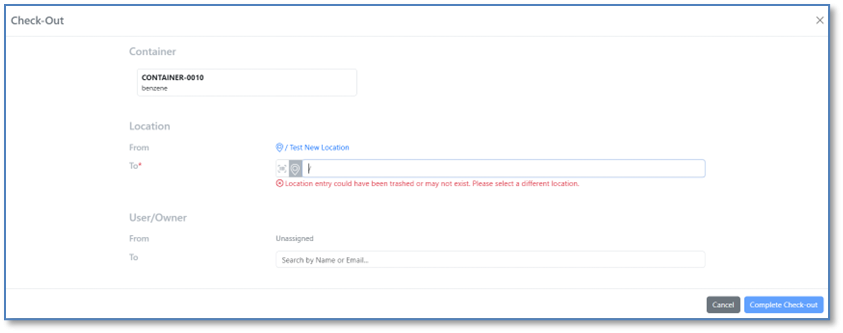
When a user selects a deleted location from the Recent options list, the system now displays a warning: “Location entry could have been trashed or may not exist. Please select a different location.”
After this warning the trashed location is removed from the Recent options list and cannot be reselected. If the user navigates away and returns, the deleted location will not reappear in Recent options. All workflows involving location selection will automatically exclude deleted locations going forward.
Materials
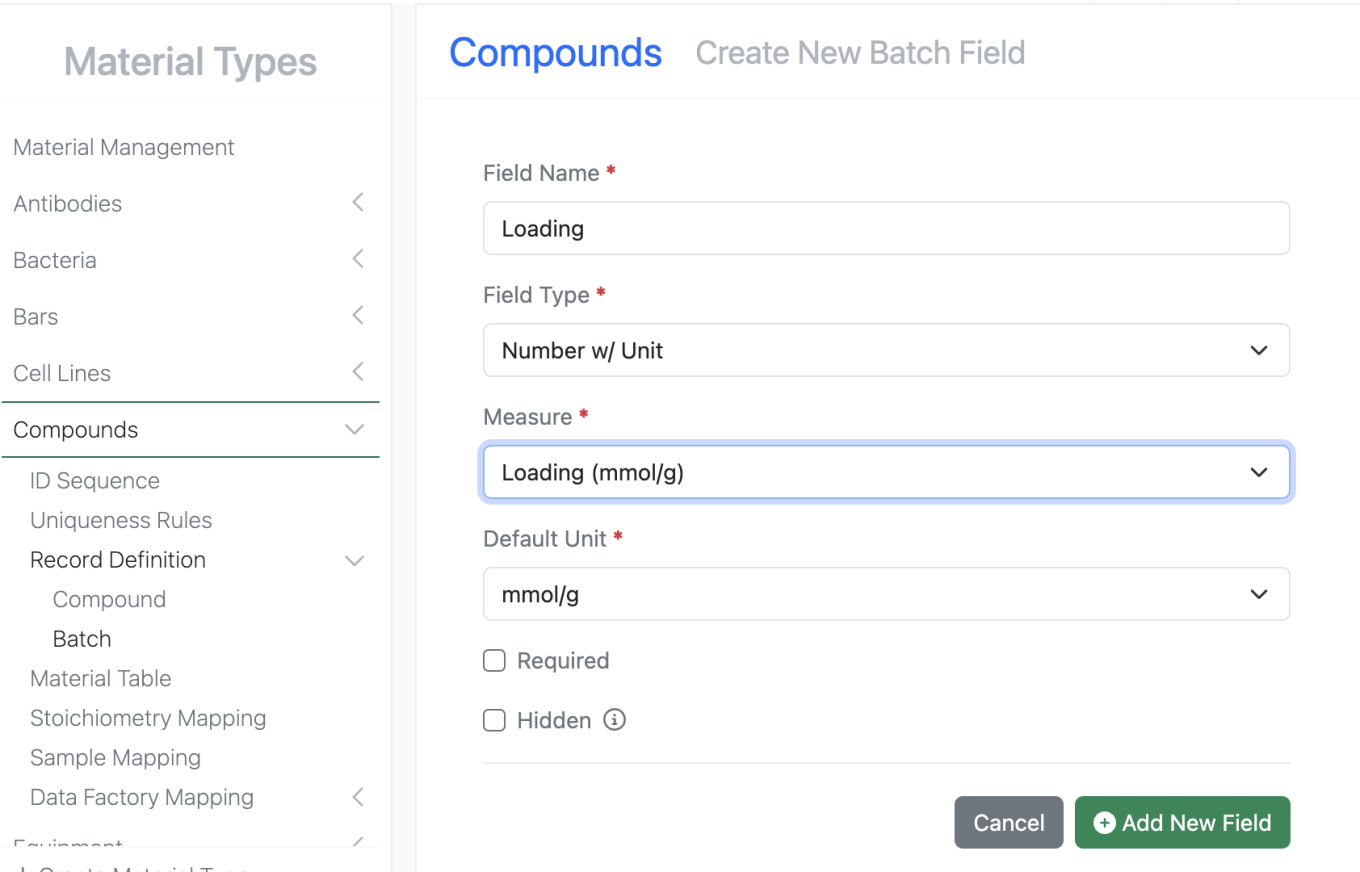
Admins can now utilize the measure Loading (mmol/g) for Number w/ Unit properties in Material Libraries and utilized in Sample mapping.
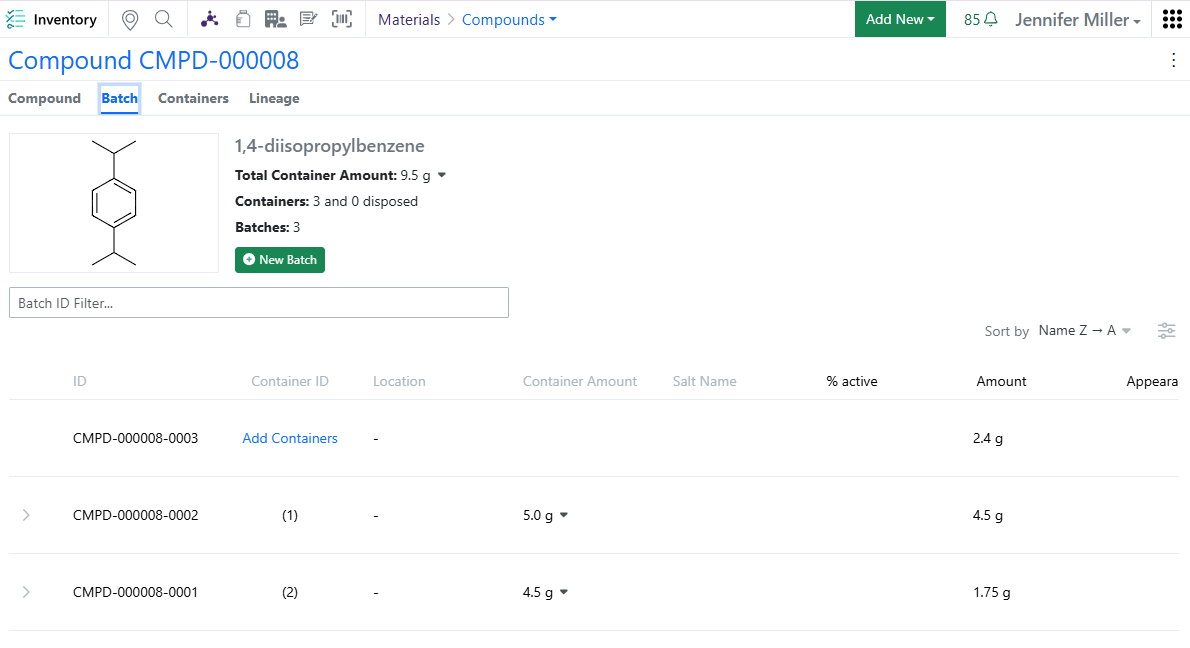
The Inventory Container Amount column has been moved to be next to Location:
ELN Archive
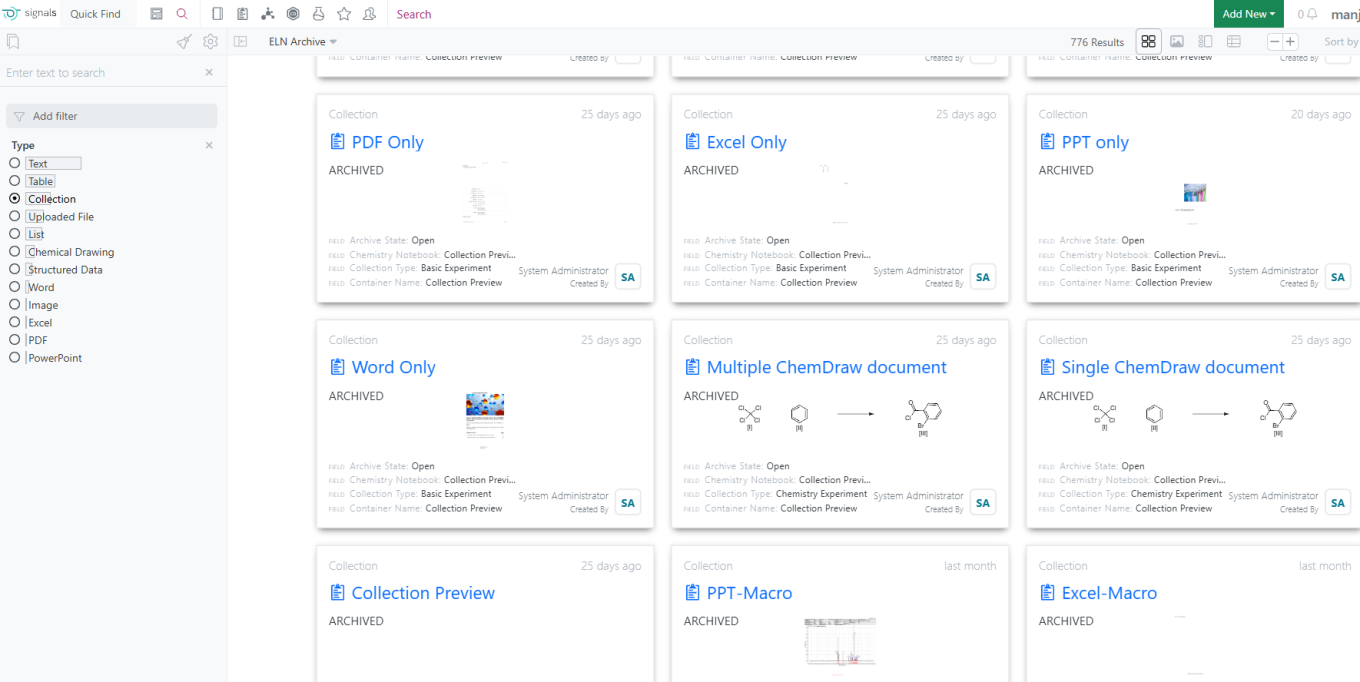
Support for previewing ELN Archived Experiment Types across all search result views
Administration
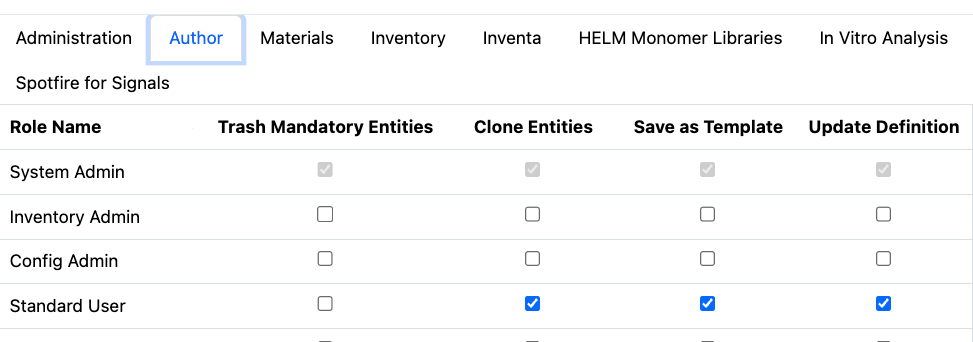
Administrators can now define if user can update the definition of tables and Worksheets. The Author privilege “Update Definition” will determine if the Update Definition option is available to users.

Signals One Private Cloud environments with Spotfire for Signals Custom Apps enabled now track module version of Custom Apps.
Integrations & APIs

We have added new APIs for exporting your Orders to a CSV or SDF file. The default value will be CSV. This is an asynchronous API flow with three endpoints to support it. First to initiate the bulk export, this requires a request body specifying the Orders you want to export and the columns you want to export. Second is to check the status of the export job. Third is to download the exported file.

We have added new APIs to fetch and update the Suppliers list. The update requires a well formatted CSV as part of the request. For convenience an example CSV is available via API.
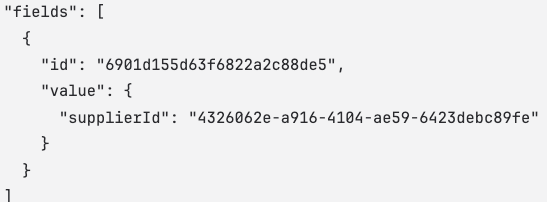

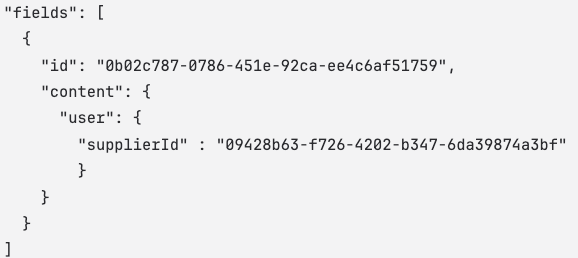
We have enhanced APIs for stoichiometry tables, materials (assets and batches), and containers to support Supplier list field types. You will be required to specify the supplier list by the supplier ID as fetched in the new APIs. Alternatively, the Name and Country of the supplier may be used instead. Below are examples for Assets, Stoichiometry tables, and Containers using the supplier ID.

We have enhanced the entity export API to allow for Text entities to be exported as text files. This is specified using the “format” URL parameter which defaults to HTML if not specified for a text element.

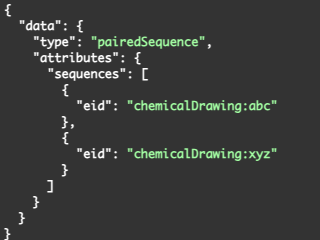
We have added a new API to replace an existing chemical drawing with a paired duplex. The request body must contain two Chemical Drawing entities to be paired.



We have enhanced the API for uniqueness checking of a material to allow for additional chemical structures to be used. The content type must be specified as part of the value object for Chemical Drawing fields. InChI, SMILES, and HELM are now supported in addition to CDXML.

We have added a new API to support updating the Status of a Synergy Experiment. Synergy experiments can be updated from Active to Submitted, Submitted to Closed, Submitted to Active, and from Closed to Submitted based on the “action’ specified in the request.

We have added an enhancement to our APIs to support closing of Work Orders. This is a new action, “approve_and_close” allowed when updating Work Orders via API and transitions a Work Order from Submitted to Closed.

We have enhanced the Work Order creation API to allow for specifying a template as part of the request. It should be noted that if the Work Order template includes a template for the Synergy Experiment associated with the Work Order it will not be automatically created. To achieve this, users should use the API to create the Synergy Experiment after successful creation of the Work Order.
Further Details
The following capabilities are in beta and are available for users, administrators and developers on the Signals platform upon request. Please contact your account representative or our support team if you would like access to the following features.
SAR & Decisioning

Quickly access published data without leaving the Material Library. The new Published Data tab automatically retrieves results for the selected material, displaying aggregated values by measurement type in a summary table. Interactive tables allow users to drill down to specific measurement results.
Admin Defined Tables, Variation Tables and Hierarchical Tables
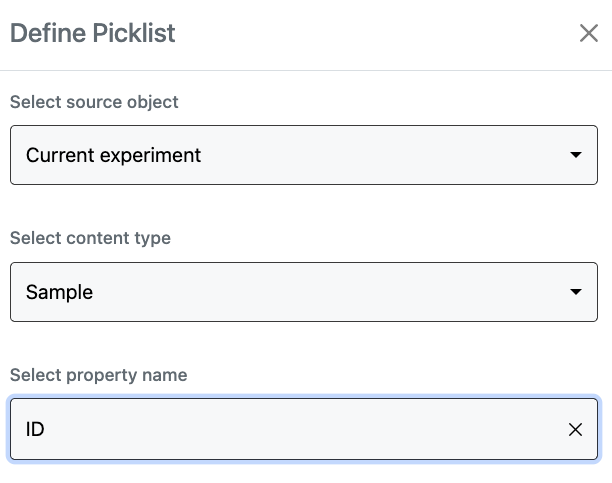
Contextual Picklists now allow the use of Internal Reference properties as the source, including IDs from Sample, Task and Material tables, and Internal Search Attribute Lists.
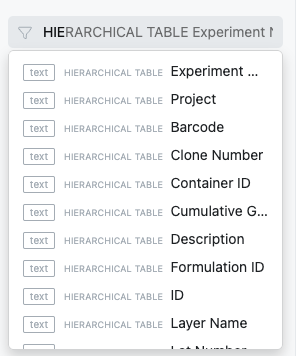
Search is now enabled for Hierarchical Tables. Hierarchical Table is available as an option under the Type query tool. Additionally Hierarchical Table properties are available as individual query facets.
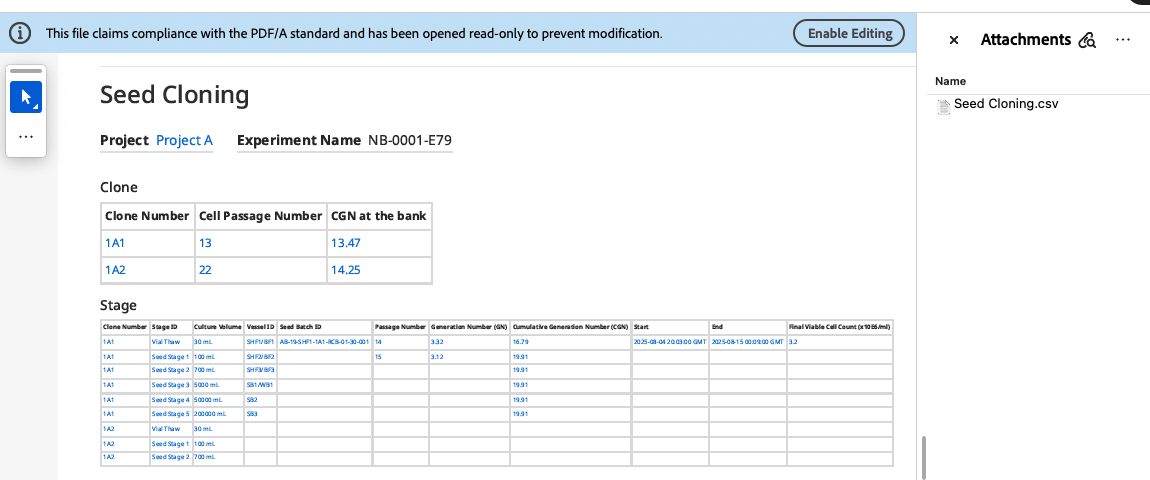
The data from Hierarchical Tables can also now be included in the Exported PDF as an attached .csv file.
Materials
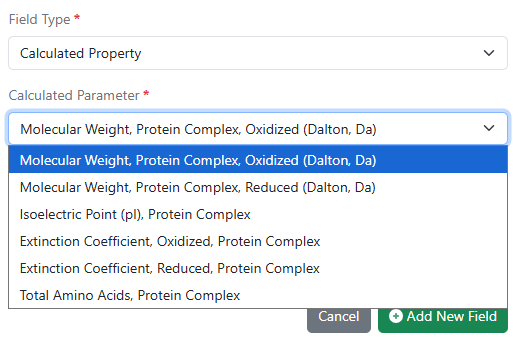
A new set of calculated properties for protein complexes is available upon request for Custom and Protein material types and in the preconfigured Antibodies library. Molecular weight, isoelectric point, extinction coefficient, and total length can now be computed for complexes comprised of multiple protein parts linked to via internal references.
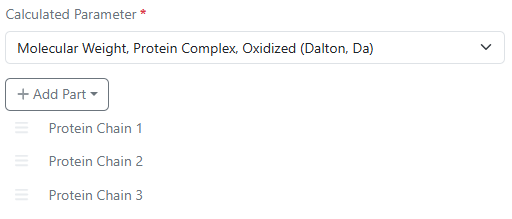
Up to 20 individual protein parts can be specified per calculation.

Updates to any of the underlying protein parts are automatically checked for when viewing the complex material.
Administration
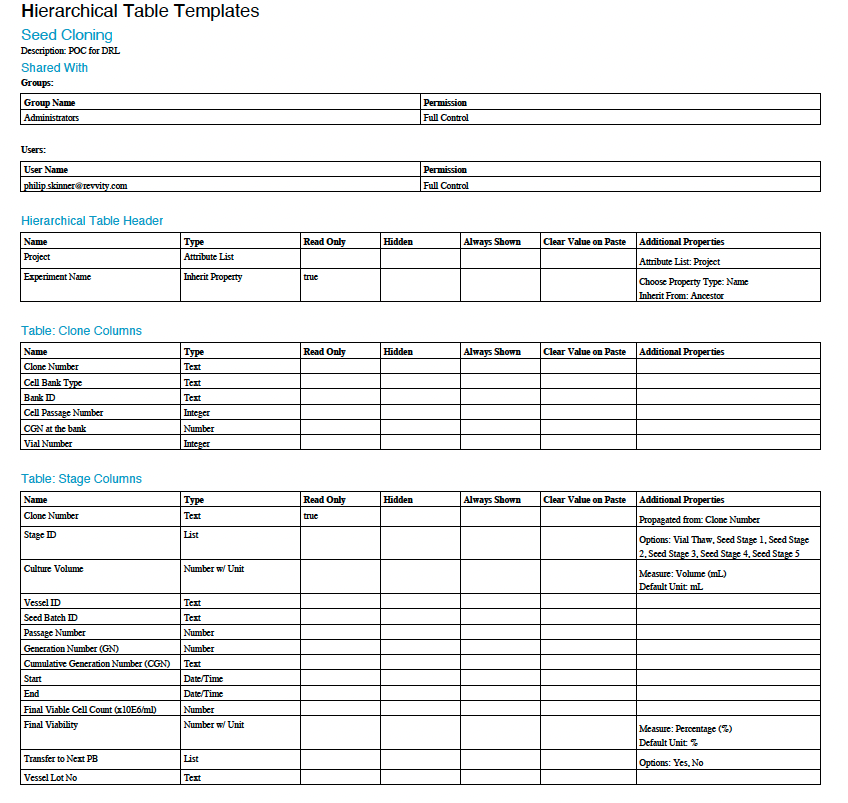
Contextual Lists and Hierarchical Tables are now supported in both the Configuration Transfer process in addition to the new Configuration Report.
What's New
We are delighted to release our new version of Signals, 25.9. This release brings enhancements in Synergy, ChemDraw, Inventory and calculations in Tables, amongst others. We have new beta capabilities for the publish of Samples from Tables and for a Configuration Report, and have extended beta capabilities around Contextual Lists and Hierarchical tables. The beta capabilities around In Vitro Analysis, Data Factory and Supplier Lists are now available to all systems. Finally, we have also fixed a number of small bugs.
The following improvements are available for users, administrators and developers on the Signals platform. Certain features may only be available with appropriate licensing and/or with enablement by an administrator.
-
Fundamentals
–Experiment description in the Grid view
–SDF export for Samples Grid view - Data Workflows & Analytics*
–In Vitro Analysis is now available to all systems
–Preview of the assembled data In Vitro Analysis is now available to all systems
–Calculations can be applied when analyzing two instrument readouts In Vitro Analysis is now available to all systems
–Re-execution of Analytics steps In Vitro Analysis is now available to all systems
–Improved error handling In Vitro Analysis is now available to all systems
–Data Factory 2.0 Publishing In Vitro Analysis is now available to all systems
–Exclusion of Plates or individual Wells In Vitro Analysis is now available to all systems
–Analytics annotations In Vitro Analysis is now available to all systems
–Audit log and history In Vitro Analysis
–Publishing enhancement, including Units publishing In Vitro Analysis
–Multiple visualization options in normalization QA mode In Vitro Analysis
-
SAR & Decisioning*
–Mapping useability enhancements in Publish Results to Data Factory app is now available to all systems
–Downloadable report for successful publications is now available to all systems
–Automapping improvements in Publish Results to Data Factory app is now available to all systems
–Data Factory projects now support Custom Entity data and Material Sync is now available to all systems
–System generated IDs can be used when publishing data to Data Factory is now available to all systems
–Changes to Data Factory’s information design now propagate to published data (excludes legacy projects) is now available to all systems -
Synergy†
–Create Work Order from selected Designs in Designs Smart Folder Data Grid view
–Send internal Experiment content to Work Order for CRO
–Hidden from CRO properties on Work Orders
–Custom Work Types
–Work Order or CRO can be included in auto-naming Sequence Attributes for Synergy Experiments naming -
Chemistry
–Name to Structure capability expanded to use ChemACX
–Periodic table tool now available in ChemDraw editor
–Creation of atom lists are now possible in ChemDraw using the periodic table tool
–Chemical objects can now be copied as 'MOLV3000 (Expanded)'
–Monomers are now searchable and replaceable when editing biopolymers
–'Copy As HELM (natural analog)' replaced by 'Copy as FASTA' - Admin Defined Tables, Variation Tables and Hierarchical Tables
–GETVALUE function to convert a Variable Measure to a Number
–Allow a function to operate on the same column if within ROWOFFSET
–Calculate the Product or conditional Product of all or some of the values in a column
–Internal Reference column limited to Materials in a Material table in the same containing entity setting available to Admin Defined Tables
–Publish Samples (beta)
–Total row limit for Hierarchical Tables (beta)*
–Header display settings for Hierarchical tables (beta)*
–Define Internal or External Data Sources in Hierarchical Tables (beta)*
–Add Inventory Columns to Hierarchical Tables (beta)*
–Internal Reference column limited to Materials in a Material table in the same containing entity setting available to Hierarchical tables (beta)*
-
Worksheets
–Contextual List property (beta)* - Inventory
–Map Sample Properties to Container Labels
–New labels
–Bulk Print Barcodes from Container Search Table
–PubChem Update to allow manual selection when CAS has multiple entries
–Export Material Orders
–Update to Uniqueness Rule for Reagent Material Libraries
–Container Status Filter in Location Details View
–Cancel bulk actions
–Bulk Import Containers available for all users
–System Supplier List available for all users
–System Supplier List available in new container creation workflow available for all users
–System Supplier List available in new Material Library available for all users
–System Supplier List available in Chemistry Settings Configuration available for all users
–Updates to System Supplier list
-
Administration
–Rearchitected SDF Projects, improved performance with row-level updates, and new methods for project creation and data publication is now available to all systems
–Configuration Transfer of Contextual Lists (beta)*
–Configuration Report (beta) - Integrations & APIs
–API support for SMILES on Salts
–APIs for Bulk Sample Update in Sample Tables
–Users included in Sign and Add reviewers External Action
–PATCH Contextual List properties
–External Notifications for Synergy Designs
–New CRO specific APIs for interacting with ADTs, Worksheets, and Stoichiometry
* Requires Signals One license
† Requires Signals Synergy license
We also fixed several small bugs in this release. Details of the enhancements are described below.
Administrators should be aware that the Normalized Compound Salt Stripping tool will change to better handle fractional coefficients by altering how multi-fragment salts are interpreted from the Salt List. This change will occur in a future release and only apply to registrations subsequent to the change, existing compounds will remain with the prior understanding until edited.
Developers should note that this release addresses an issue with the GET /entities/{eid}/export endpoint, where the response returned an incorrect Content-Type header for Text entities. The header was set to text/plain, while the actual content is text/html. This only applies to text elements created through text file upload.
Data Factory administrators should be aware of several important updates. The latest version of Data Factory has officially exited beta, and all older versions of Data Factory projects and apps are now designated as “Legacy.” As part of this transition, it is no longer possible to create new legacy Data Factory projects through the user interface. We strongly encourage administrators to begin adopting the latest Data Factory features, as legacy projects will be fully deprecated in a future release. A simple migration path will be provided in a future release to support this transition.
Data Factory administrators should also note that the Advanced Security policies in Inventa apply an “AND” logic across all user groups, restricting access if any groups lack permissions. This behavior differs from the standard Signals security model and will be fixed to align with the standard in a future release.
Administrators are recommended to subscribe to the channels within our support news site found at https://support.revvitysignals.com/hc/en-us/categories/360004446171-Support-News which contains more information about releases and other pertinent product information.
This content is anticipated for release on our Production E3 environments, and for Private Cloud customers on our deferred release schedule, in March 2026.
Further Details
The following improvements are available for users, administrators and developers on the Signals platform. Certain features may only be available with appropriate licensing and/or with enablement by an administrator.
Fundamentals

Users will now be able to view the Experiment description, which currently appears on the card view, in the Grid view of the Experiments Smartfolder.

In the Samples Smartfolder, Chemical samples can now be exported to SDF from Samples Grid view by selecting “Export” in the same manner a csv export can be generated. If a selected sample does not have an associated chemical drawing, it will be skipped in the SDF export.
Data Workflows & Analytics

In Vitro Analysis and all previously released capabilities are now available to all systems.

For tenants with a Signals One license, users will now be able to perform In Vitro (screening, assays) data analysis, visualization and results quality control. The first curve fitting method available is the logistic 4 Parameter (4P) fit.
The activity in each of the In Vitro Analysis steps is now logged and appears in the history of the analysis:
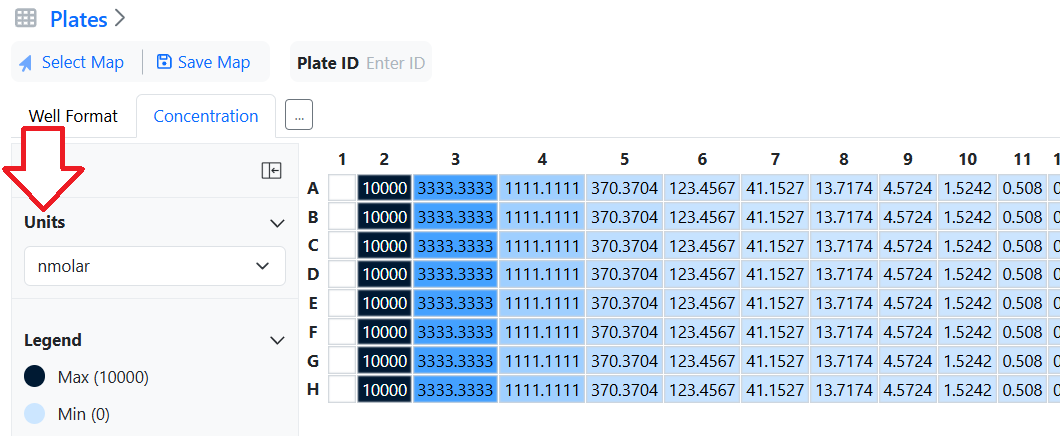
The results published from a deleted In Vitro Analysis will automatically disappear from the Data Factory, in agreement with the principle of Signals constituting the single point of truth.
Concentration units, defined at the plate level, are now propagated to the results of the analysis published in the Data Factory 2.0:
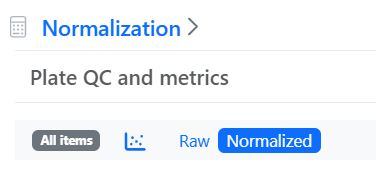
In the detailed plate view it is now possible to switch the plate heatmap from raw to normalized data:
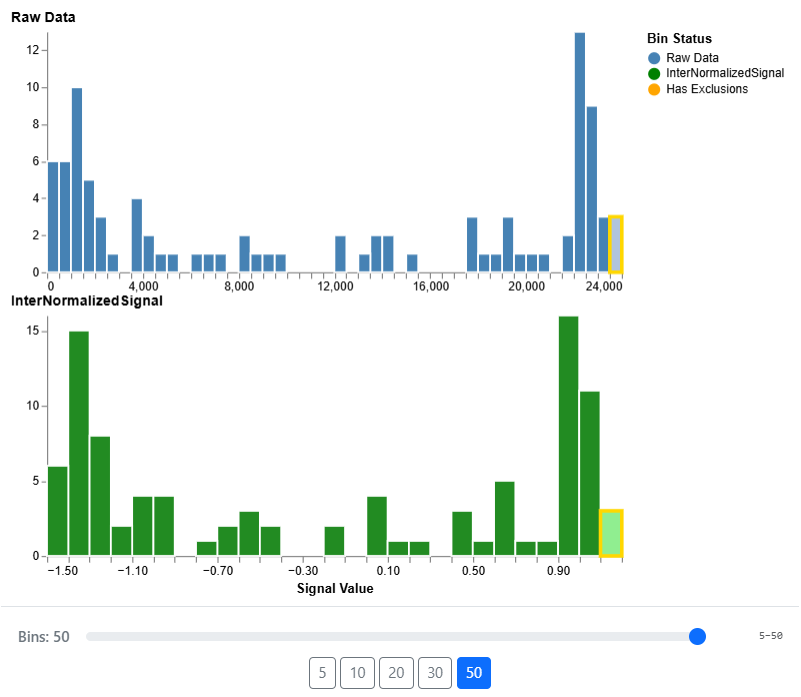
Moreover, as well as changing the visualization to the histogram view allowing to better compare the data distributions before and after normalization The histogram visualization is fully dynamic, with interactive selection and binning:
SAR & Decisioning

The Data Factory capabilities previously in beta are now fully available across all systems in Signals One. Key updates include support for row-level updates, improved performance, enhanced mapping usability, expanded publication paths, and new public APIs.
Synergy
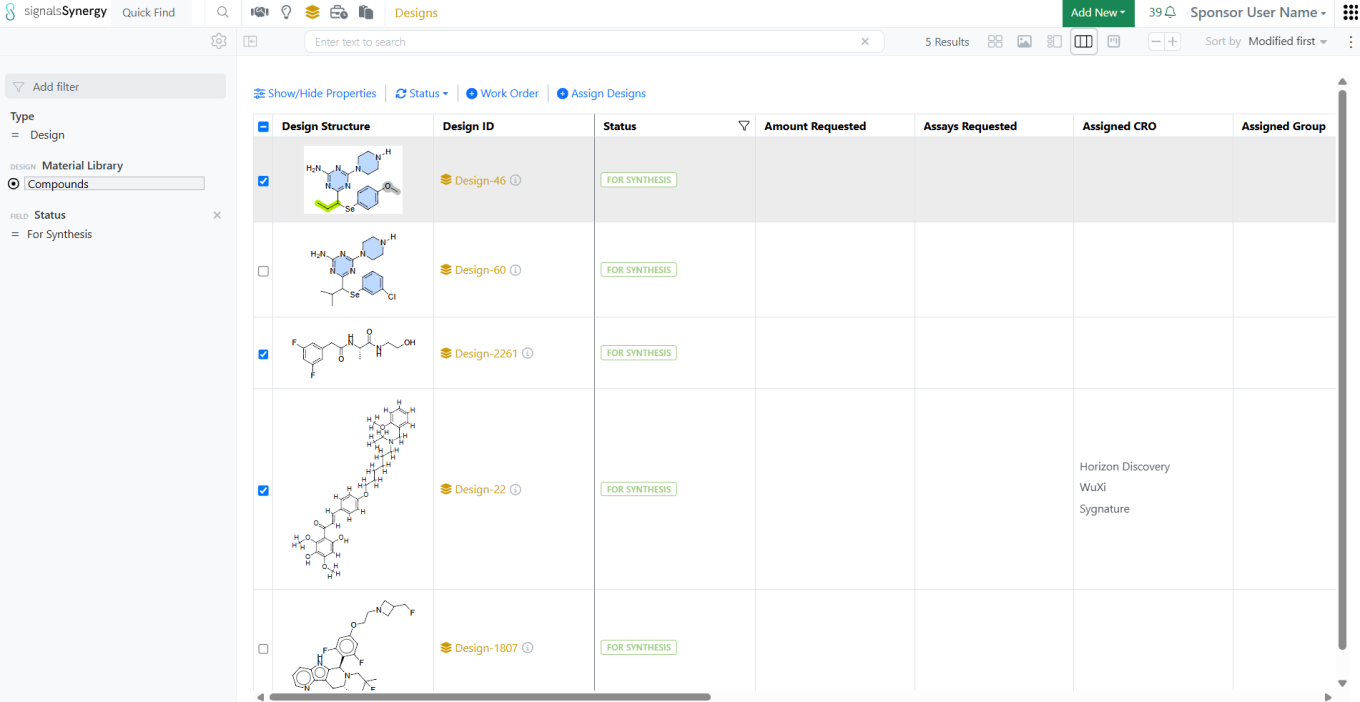
The Designs Smart Folder Data Grid view allows users to easily manage Designs across multiple Ideas or projects. Users can now easily Create a Work Order from selected Designs in the Designs Smart Folder Data Grid view.


From inside an Experiment, a Sponsor user with the privilege to Create Work Order can now select Create Work Order and include content from the Experiment to share with the CRO. Related Work Orders created from the Experiment are captured and tracked in the Related Work Orders Table within the Experiment, while the newly created Work Order has the Experiment linked in the Originating Experiment property.

Hidden from CRO properties can now be applied to Work Orders, in addition to Collaborations and Synergy Experiments. Hidden from CRO properties allow the Sponsor to protect proprietary metadata from external partners. Synergy or System Admins can mark fields on Work Order Templates as Hidden from CRO; when a Work Order is created from these templates, only the internal Sponsor users can view and/or edit these properties and their values on the Work Order. These properties are never visible to CRO users.
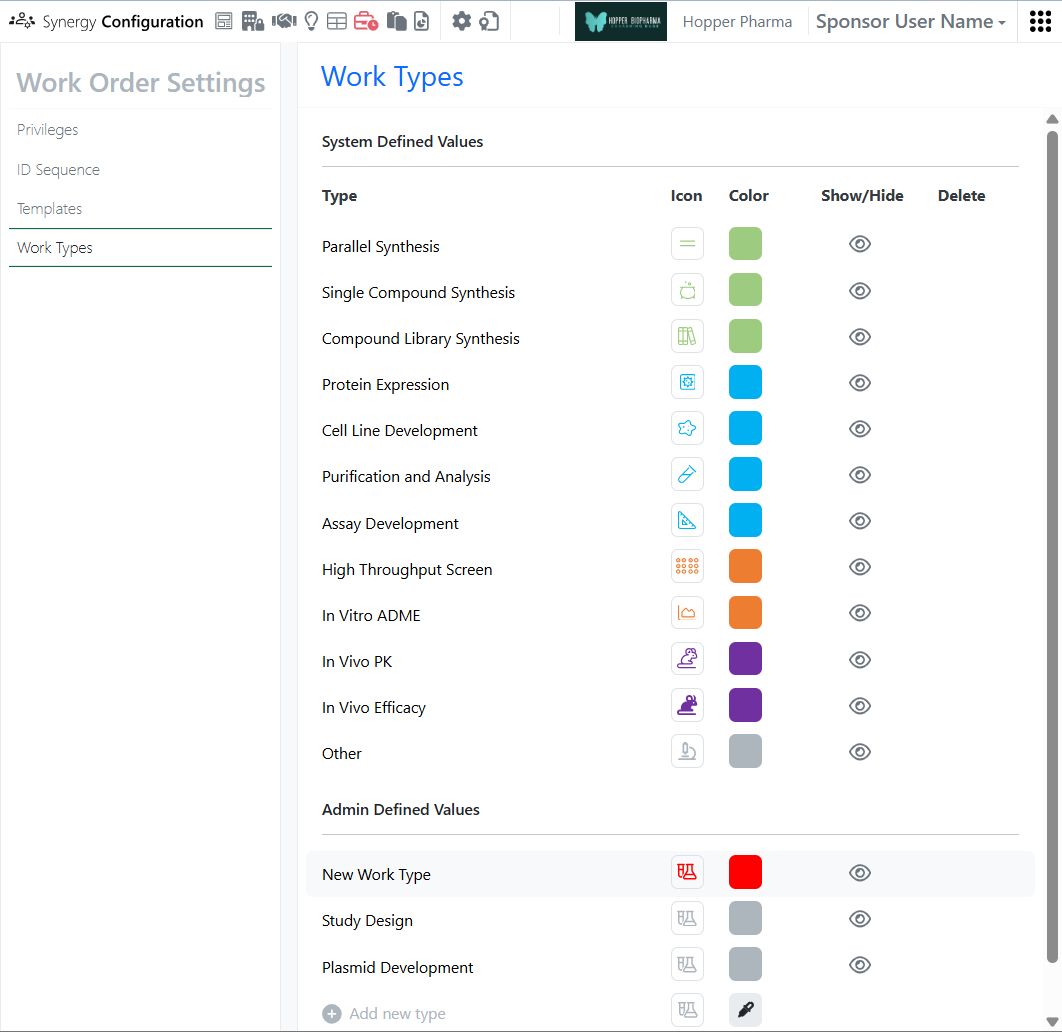
The admin can now define custom Work Types for labeling and organizing Work Orders. Work Types can be marked as Shown/Hidden for simplifying user selection.

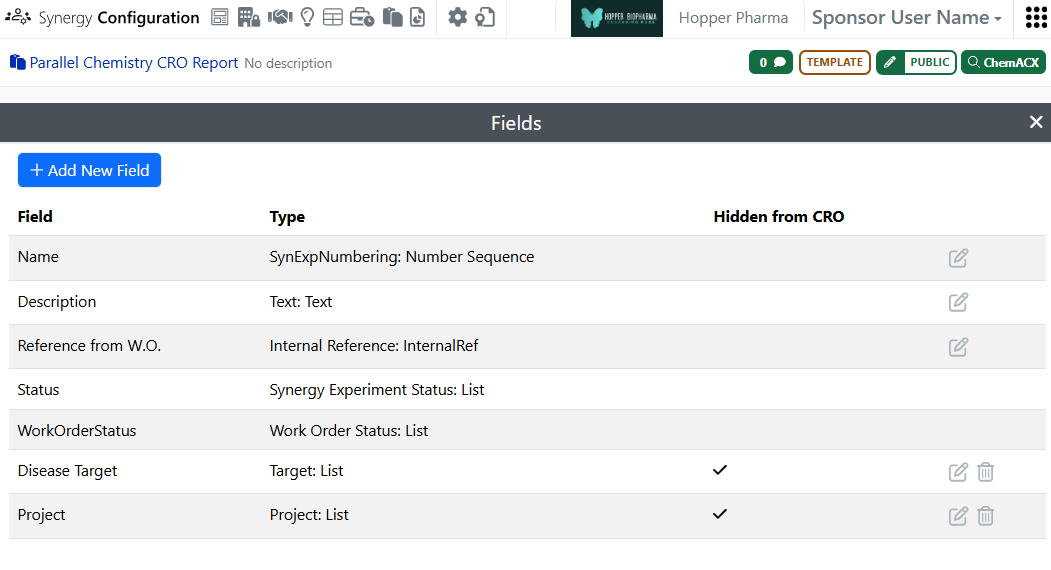
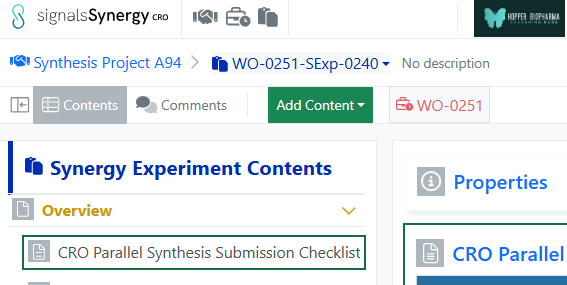
Finally, the admin can include the associated Work Order or assigned CRO in an auto-naming number sequence Attribute list in Signals Configuration. When the auto-naming number sequence is used as the Name on a Synergy Experiment Template, the associated Work Order or assigned CRO will be included in the Experiment name.
Chemistry

The Name to Structure capability in ChemDraw now utilizes ChemACX, a unified chemical database containing tens of millions of substances. This enhancement enables conversion of synonyms, trade names, and common names within the database directly to structure representations in the ChemDraw editor. This improvement can be accessed by using the ‘Name to Structure’ tool in the ChemDraw editor or pasting plain text of the structure name onto the ChemDraw canvas.

The periodic table tool, now available in the ChemDraw editor, enables the selection of an element to add to the canvas. When an element is selected from the periodic table, it can replace an atom, selection, or be added to blank space on the ChemDraw canvas.
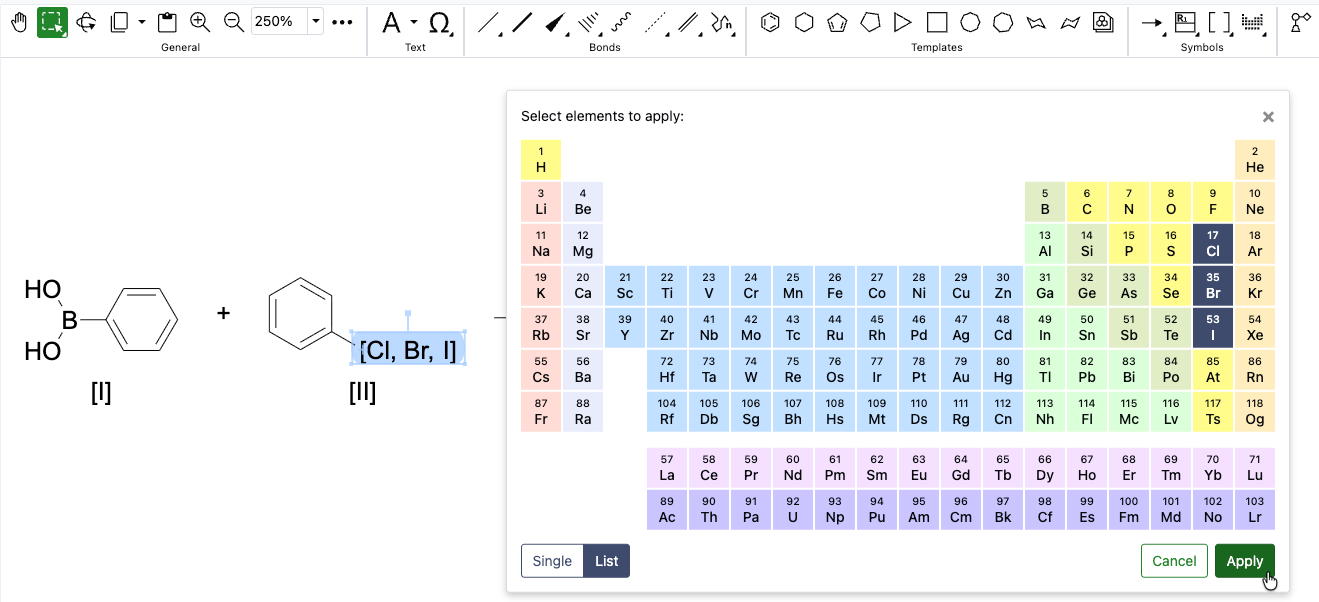
Creation of atom lists for the generation of generic structures is now possible using the periodic table tool. Upon opening the tool in ChemDraw, users can select the ‘List’ option which will allow the selection of multiple elements. Once the list is generated, selecting 'Apply' will allow the user to place the element list on the canvas in brackets.

Chemical objects on the ChemDraw canvas can now be copied as an expanded V3000 molfile. When using 'Copy As MOLV3000 (Expanded)', a fully expanded version of the chemical object will be copied, including the expansion of all nicknames, labels, and HELM monomers.
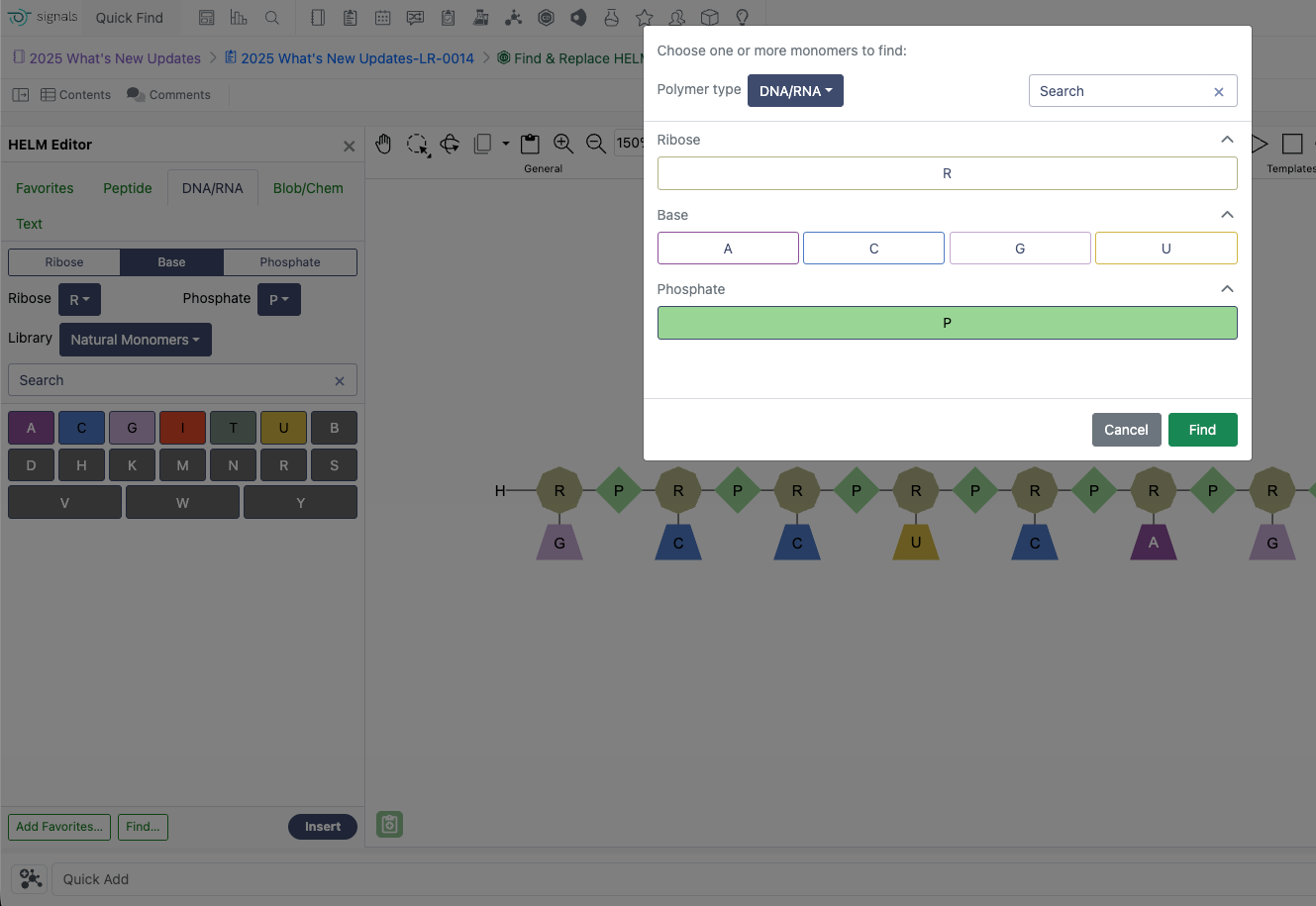
The HELM Editor in ChemDraw now supports finding and selecting specific monomers on the canvas for replacement. One or more monomers can be identified and selected simultaneously using the ‘Find….’ dialog in the HELM editor, and all instances found will be selected for replacement.
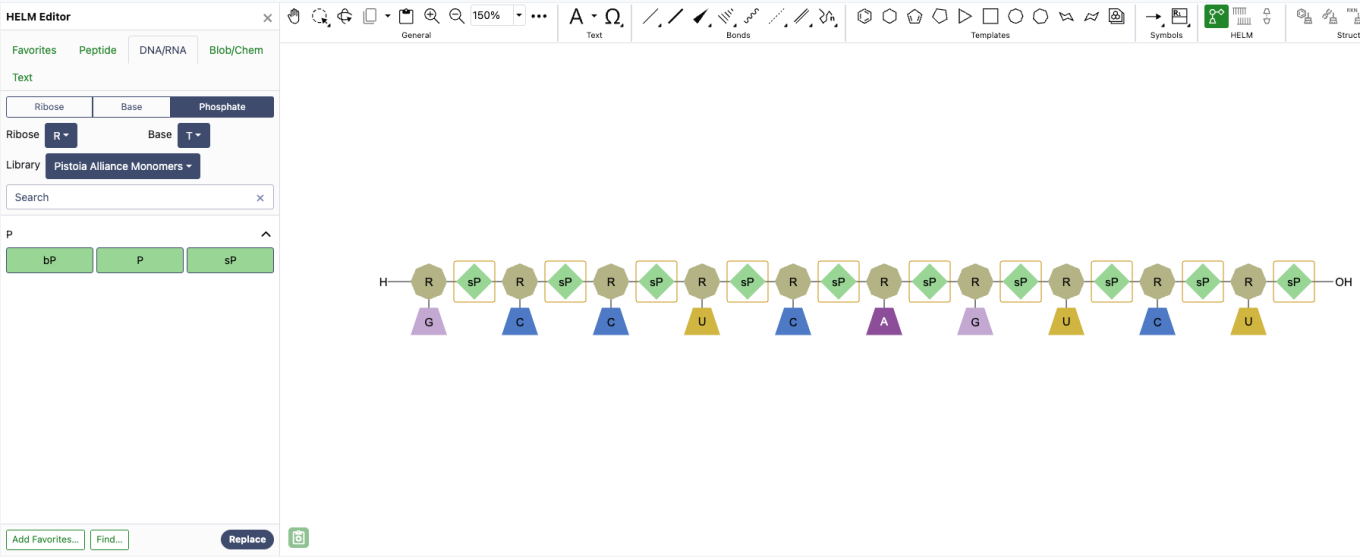
Selecting a new monomer from the HELM editor replaces all selected monomers on the canvas with the chosen selection. This bulk find and replace capability streamlines large-scale modifications of sequences, enabling rapid transformation of a natural sequence from a FASTA string into a highly complex sequence with custom modifications.
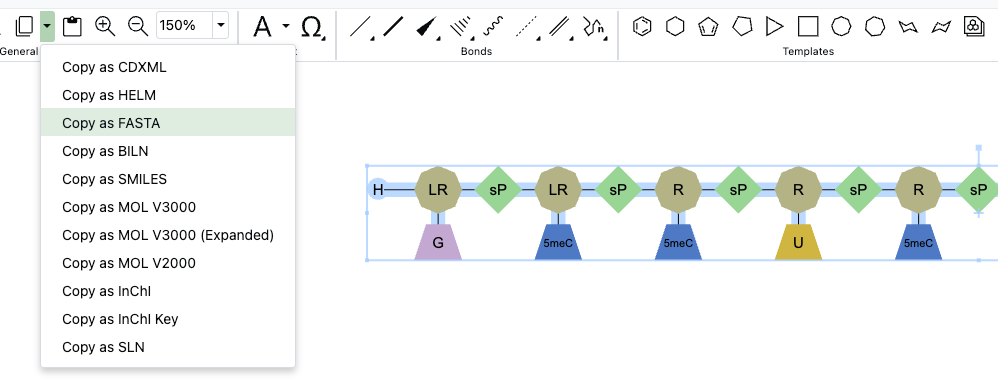
The Copy As options for HELM biopolymers in ChemDraw have been updated. The 'Copy as HELM (natural analog)' function has been replaced by 'Copy as FASTA.' This change more accurately reflects that a FASTA sequence containing all natural analogs will be copied when this option is selected, with no change in the underlying behavior.
Admin Defined Tables, Variation Tables and Hierarchical Tables
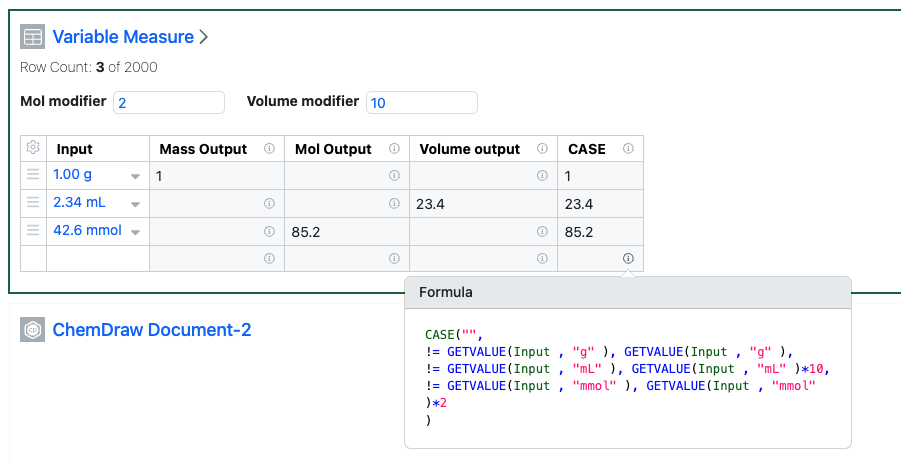
The Function GETVALUE has been extended to allow operation on a property of type Variable Measure. The formatting remains the same, whereby the first argument defines the property being input and the second property defines the unit for conversion. Numbers within the same Measure will be converted to the equivalent number with that unit. The function can be used within a CASE statement in order to output numbers across Measures.

A limitation on self referencing of columns has been relaxed. Columns can be self referenced when within a ROFFOFFSET function, avoiding a circular reference. This allows the prior value in a column to be used to calculate the next value in the same column.
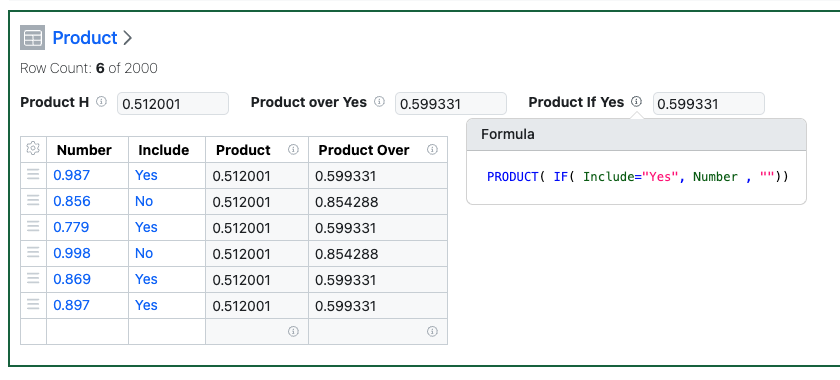
New functions to calculate the product of the values in a column have been added. PRODUCT() and PRODUCTOVER() allow calculation of the product of the values, or a conditional subset of the values, either as a column of as a Header.

Properties of type Internal Reference can now be defined to limit to “within the same entity”. This capability, already available in Variation Tables, is now extended to Admin Defined Tables. When selected the list of available references will be limited to Materials referenced in Material Tables within the same Experiment.
Inventory

Under the Property Type column Administrators can now choose Sample Properties as an option to be printed on the container labels:
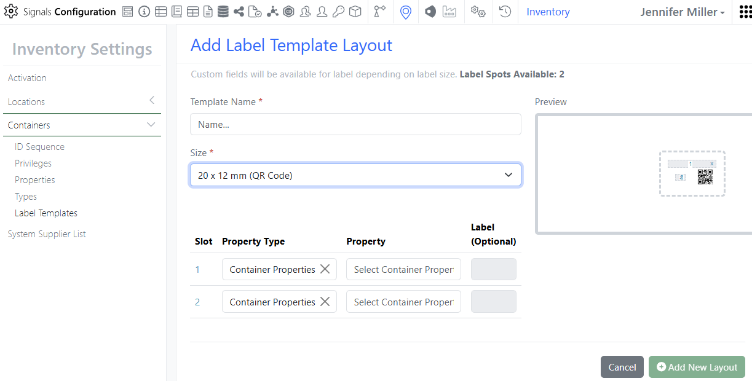
In the Inventory Container Label Templates we have released 2 new label options: 20 x 12 mm:
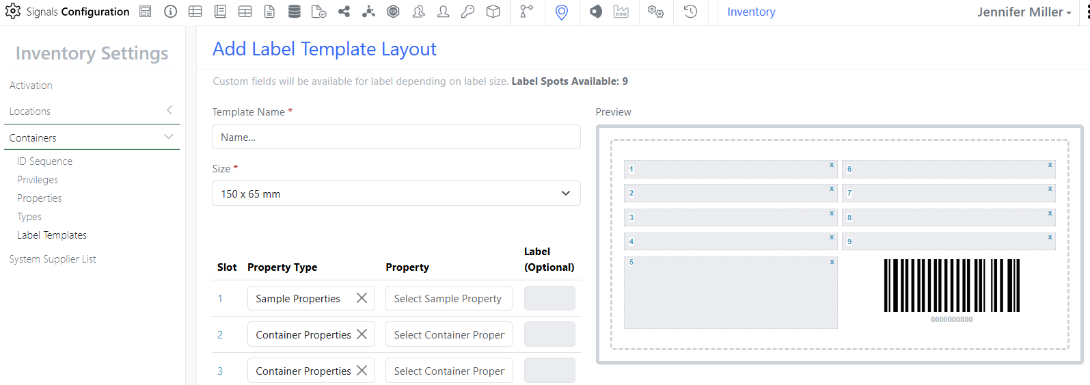
150 x 65 mm:

101 x 50 mm:

Users can select containers on the Containers Search Table that they would like to print/re-print barcode/labels for. Select the containers using the checkboxes to the left and choose the Print Barcode option:
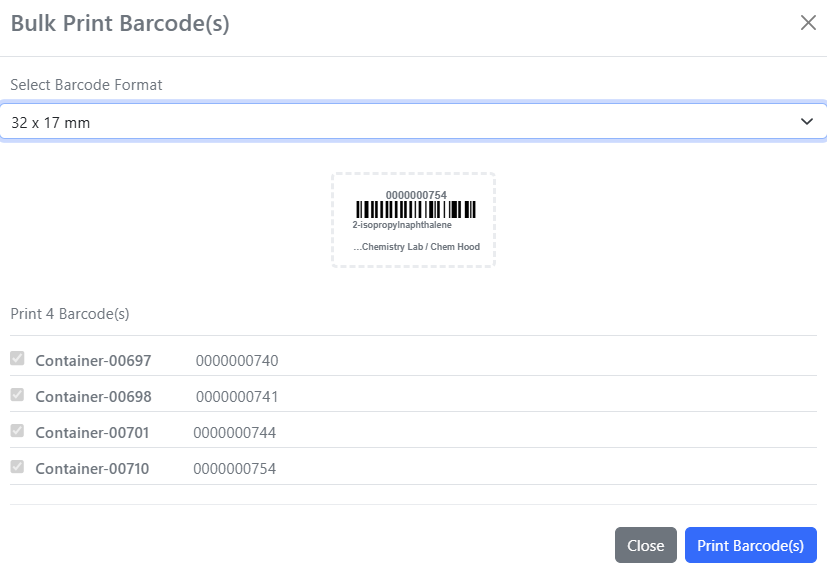
The select barcode label size window will appear:
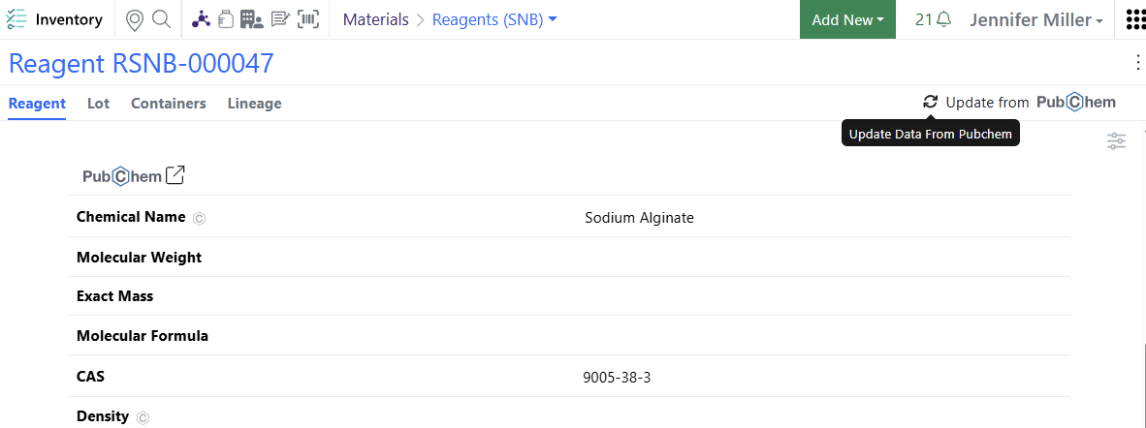
There has been a PubChem update to allow manual selection when CAS has multiple entries. When a given CAS has multiple entries associated in PubChem, the users will now get an option to select which entry they would like to pull the data into the Reagent Library:
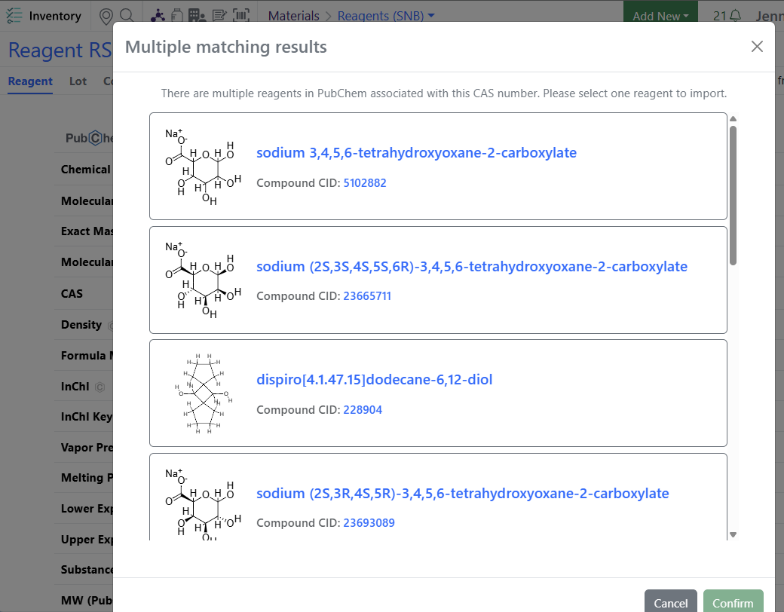
Users will see a modal appear when they choose to update the data from PubChem to select from:

Once an option is selected, the data will be updated in the Regent Library:

In the top right corner of the Material Orders page is the new Export Order option:
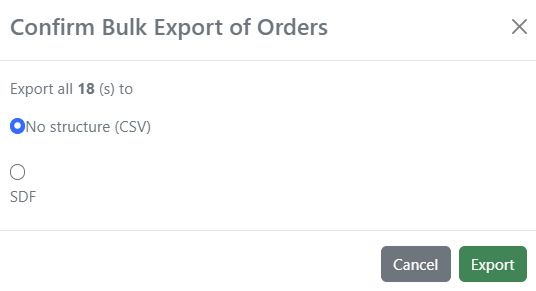
Users can choose to export as a csv or a SDF:

Reports can be found in the Inventory Bulk Reports Material Reports Material Order:
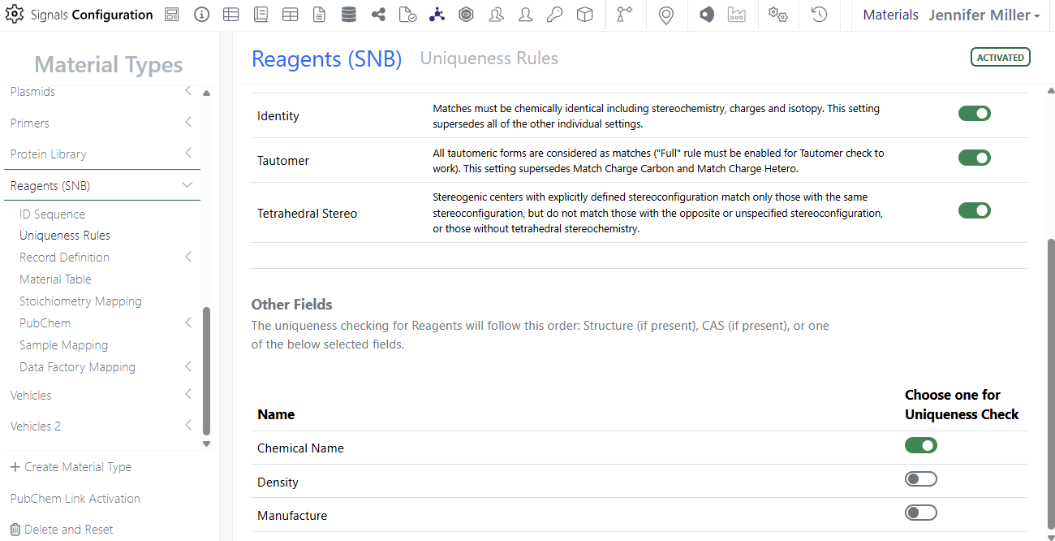
There has been an update to Uniqueness Rules for Reagent Material Libraries. Administrators can select 1 additional required field for uniqueness checking for Reagent Libraries:
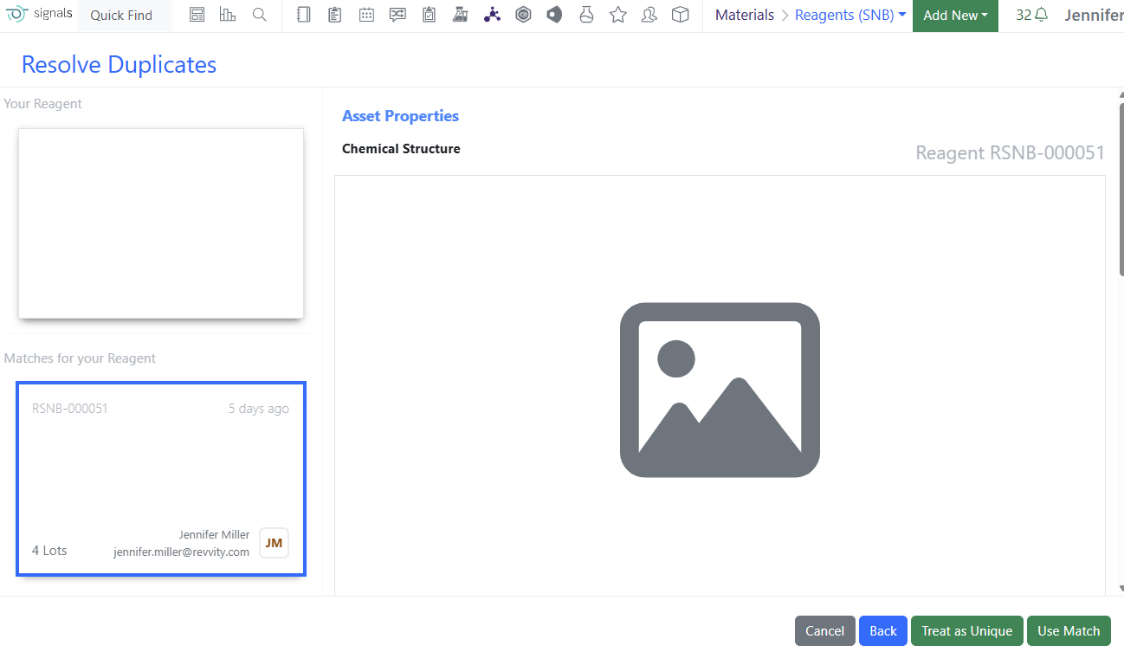
This means that when a new Reagent is being created the Structure is checked first, then the CAS number and if both Structure and CAS are empty, the chosen Other Field is used for uniqueness. Users will see the Resolve Duplicates screen if a match is found:
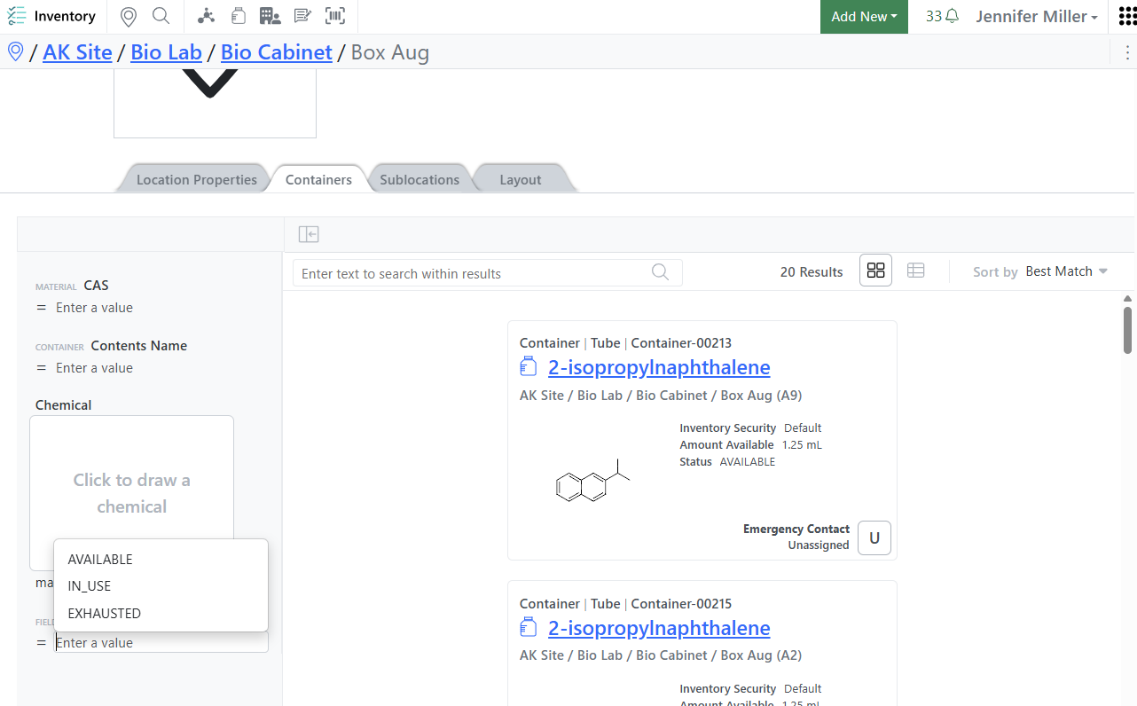
An additional Container Status Filter has been added in the Location Details View. This allows users to choose to see Disposed, Final Disposed, Exhausted containers instead of the default In Use and Available that the page defaults to:



When users initiate an action or a bulk download from the Containers Search Table or from a Move Location Contents or a Move Location, they are now able to cancel the request by navigating to the Inventory Bulk Reports page and choosing the Cancel Job icon:

Please note that some actions are very quick so the Cancel Job option may not appear to work or may not be present at all since the job runs so quickly. Bulk Import Containers is now available for all users:

Please remember that users need the permission to create containers in order to bulk import containers.
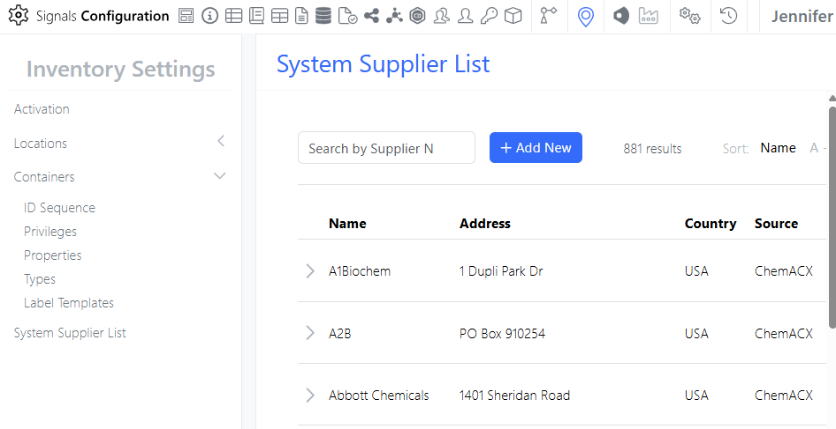
System Supplier List is available for all users. In addition, there are a few updates to System Supplier List. Inventory Administrators will see the System Supplier List available in the Inventory Settings page:

Inventory Administrators will be able to sort the System Supplier List by ChemACX or Admin Defined. The sort will keep the Favorite Suppliers at the top of the list and will sort those first and then sort the rest of the Suppliers below:
Integrations & APIs

We have updated our fragments APIs to allow for fetching and updating the SMILES values for Salts.

We have added new APIs to bulk update Samples in a samples table. This is an asynchronous API with two new endpoints. One to kick off the request and one to check the status (Success or Failure). The request body of the first PATCH request requires a well formatted CSV with the first column representing the ID of the sample and the subsequent the properties to be updated.

We have enhanced the External Action for “Sign and Add Reviewers” and “Sign and Add Two Stage Reviewers” to include the selected reviewers in the External Action request body. This is only applicable when submit method is set to POST.
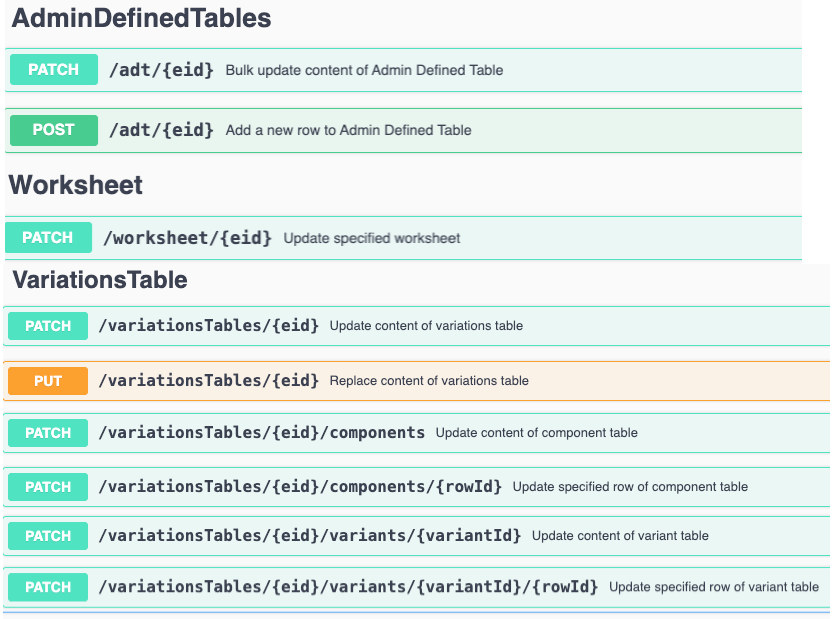
We have enhanced our APIs to support Contextual List fields and columns. This applies to APIs for updating Admin Defined Tables, Variations Tables, and Worksheets. Note that using the External API any text value can be entered into these fields/columns regardless of the contextual list definition.
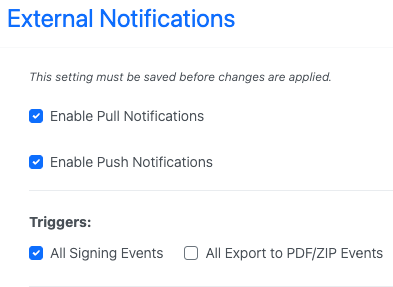
For our Synergy product we have added External Notifications for Design signing Events. These are included in the Notification Trigger “All Signing Events”.
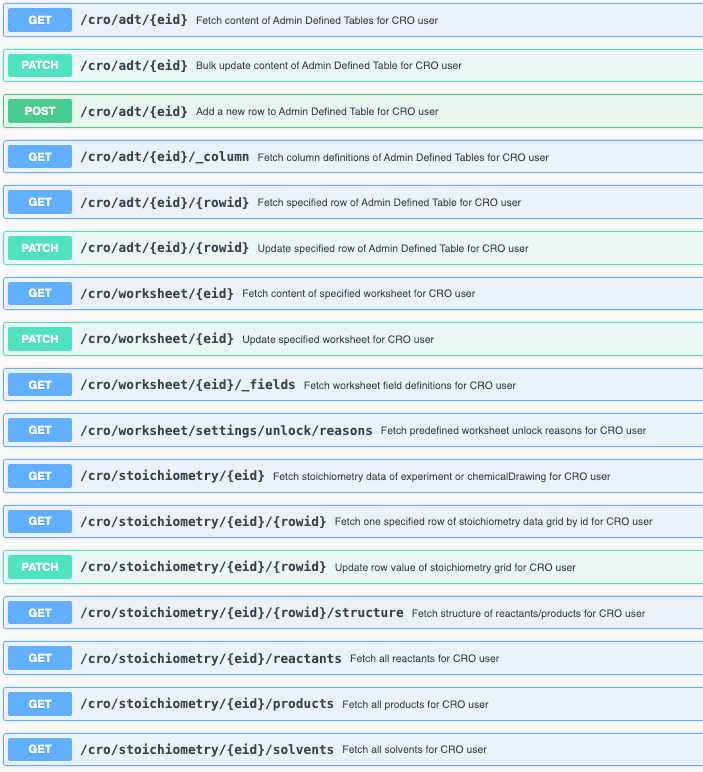
We have expanded the APIs for our Synergy Product CROs to include Admin Defined Tables, Worksheets, and Stoichiometry. These allow for specific APIs to be utilized by CRO users. This enables customers External Actions to read and write for CRO users without exposing details that CROs are restricted from seeing or interacting with.
Further Details
The following capabilities are in beta and are available for users, administrators and developers on the Signals platform upon request. Please contact your account representative or our support team if you would like access to the following features.
Admin Defined Tables, Variation Tables and Hierarchical Tables

Publish Samples is a new beta feature. To publish Samples for analysis the configuration will need to be done in at least 2 places and up to 3 depending on where the information is being filled stored or entered. The simplest option is to configure the Sample Template and the Table Template (ADT or Variation Table).
To configure the Sample Template the administrators needs to navigate to the System Objects Samples Templates. Choose the Template for the Samples to be published and click the Data Factory Mapping in the top right corner:

Select the Data Factory Project that the Sample data will be published to and click Save and Continue:

For the map to be able to be filled out, the Data Factory Entity Type needs to be selected. Administrators can map the Sample to the Asset or to the Batch/Lot. This is where the configuration depends on where the data will be stored or entered. Administrators can configure the system so that every Sample is an Asset is Data Factory and then associate Variants in a Variation Table as the batch/lots OR a configured field in an ADT can be the batch/lot. Another option the administrator could configure is the Experiment ID as the Asset (or another field on an Experiment/ADO, ex: a Material ID that links back to a Materials Library) and map each Sample as a batch/lot of that ID.
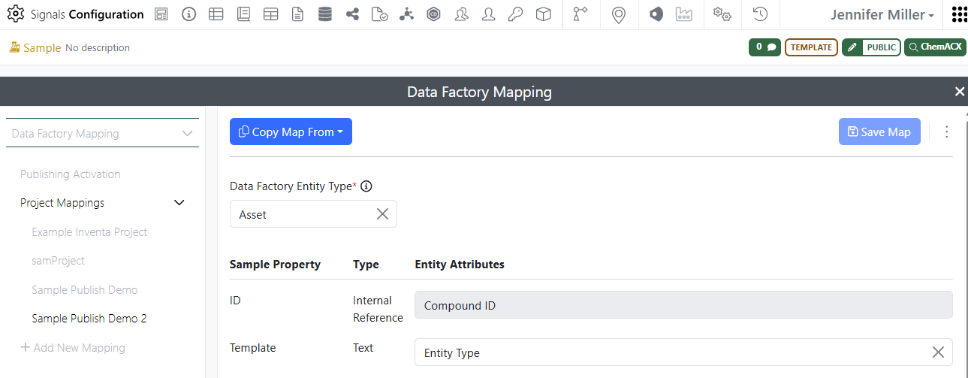
Once the administrator chooses the Data Factory Entity Type, either the Compound ID (if Asset is chosen) or the Batch ID (if Batch/Lot is chosen) the value will automatically fill in the ID row. The ID is expecting an Internal Reference. This means that in the ADT/Variation Table there is expected to be an Internal Reference field that will be filled in (by the user) with a viable Sample ID from Signals Notebook:
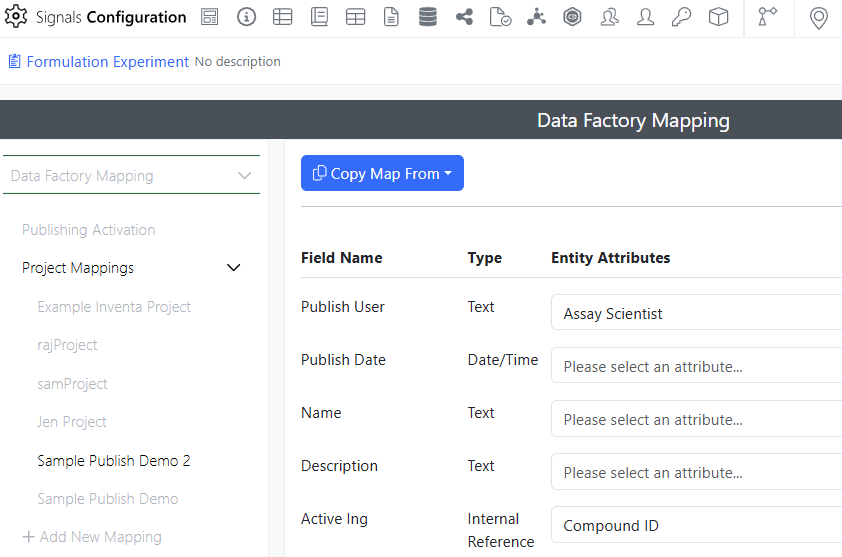
Configure any additional entity fields that should be associated with the Sample creation as an entity and Save the map (ex: Purity). Next the administrator should configure the Experiment/ADO template if that is where the asset or any additional should be entered by the user (ex: Date, Scientist…):
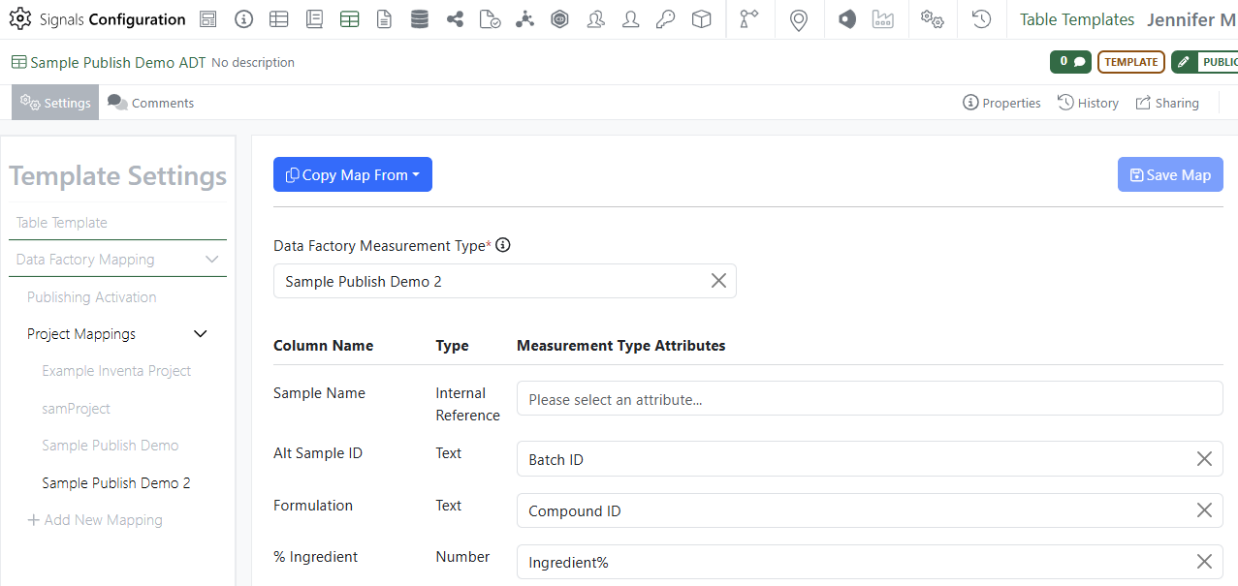
After the Experiment/ADO is configured, the ADT or Variation Table where the Samples and the data to be published will be entered will need to be mapped:

If the Asset is in the table, it can be mapped as well. When all the mapping is done then the users will be able to publish the data from their experiments:

The report will be available with the Status once the publication is complete:
Note: Setting up the Data Factory Entity and Measurement Types before configuring Signals Notebook will help ensure a smoother process. Starting with configuring the Experiment/ADO, then Sample Template and then ADT/Variation Table can help with keeping track of the least detailed mapping to the greatest detailed mapping. Administrators should remember to enable the publishing before leaving the configuration of each Template. Samples as the Asset with the Batch/Lot as the Variant Name Samples as the Asset with the Batch/Lot as an additional field in the ADT/Variation Table Experiment/ADO as the Asset and Samples as the Batch/Lot Experiment/ADO additional field as the Asset and Samples as the Batch/Lot Samples as the Batch/Lot with an additional field in the ADT/Variation Table as the Asset Experiment/ADO (or additional field) as the Asset and Variants as the Batch/Lot- if you choose this method be sure that the Variant is configured to be unique for every Variation Table the user may add to the Experiment (ex: Add the Table Name to the Variant)

A total row limit of 2000 rows has been applied to Hierarchical Tables. This limit is applied across all of the table layers.

Administrators can now define properties for display of the headers. Headers are displayed in consecutive vertical blocks of up to four, a maximum number of headers in each block and a definable maximum width of the labels and values.
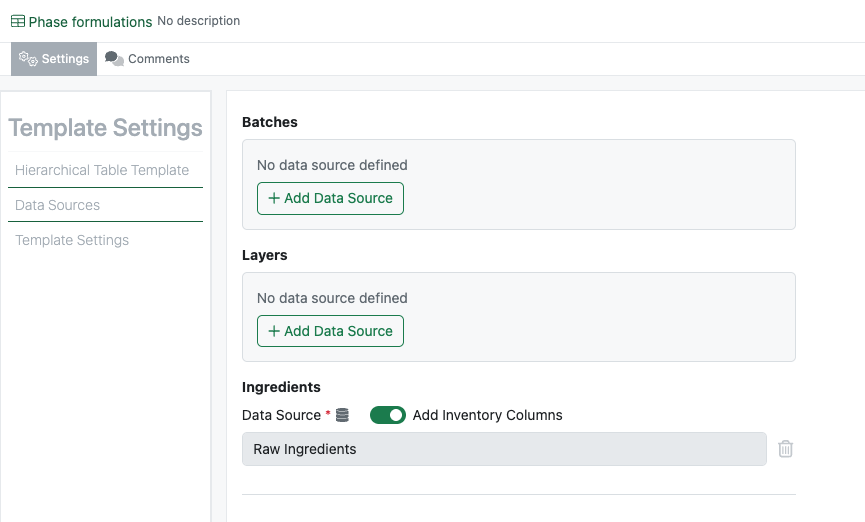
External and Internal Data Sources can now be applied to the table layers in Hierarchical Tables. Each table layer can have up to one data source applied.

If the data source is an appropriately configured Internal Data Source, Inventory columns can optionally be added to a single data layer. This will add the barcode lookup capability to the ID column, along with Barcode, ContainerID and Inventory Decrement columns.
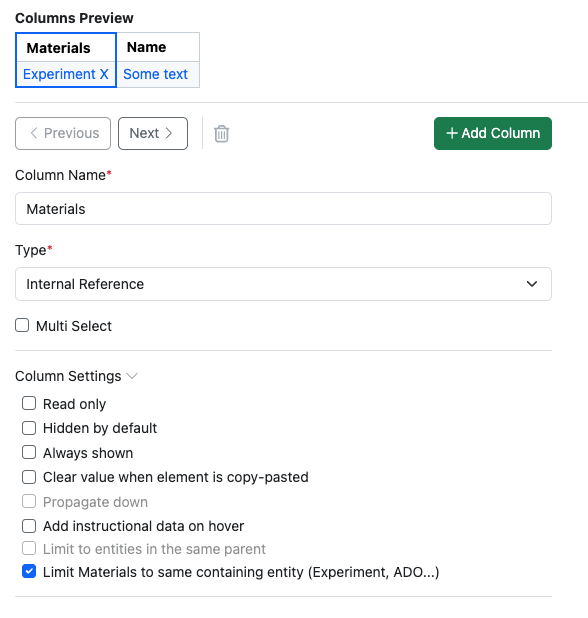
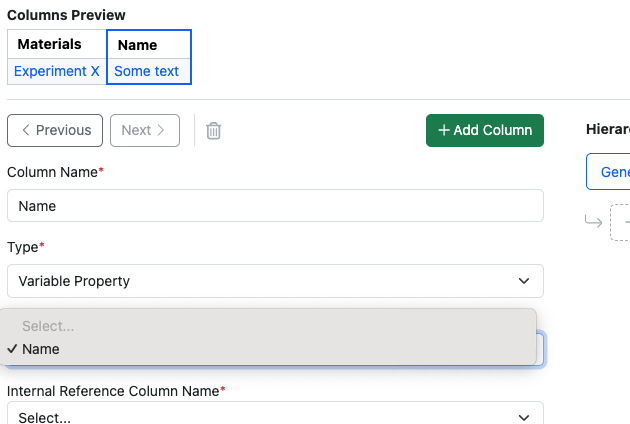
Properties of type Internal Reference can now be defined to limit to “within the same entity”. This capability, already available in Variation Tables, is now extended to Hierarchical Tables. When selected the list of available references will be limited to Materials referenced in Material Tables within the same Experiment. An additional column of type Variable Property can be added to add the Material Name.
Worksheets

The Contextual List property type has been added to Worksheets.
Administration

Contextual Lists are now included in Configuration Transfer.
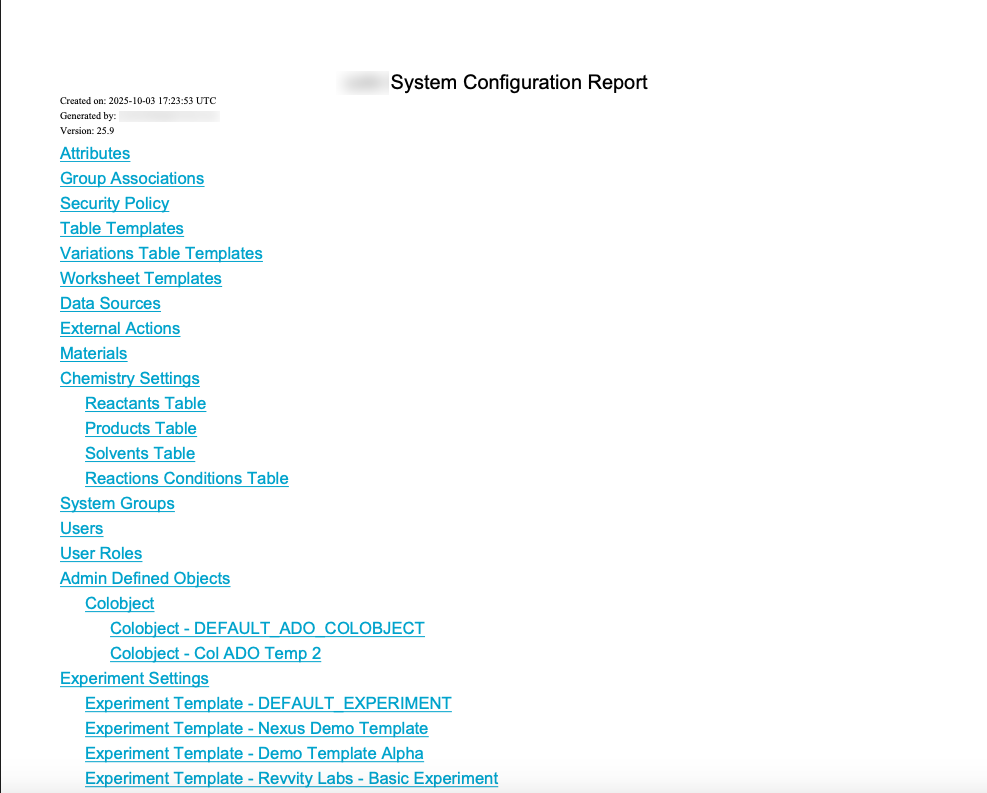
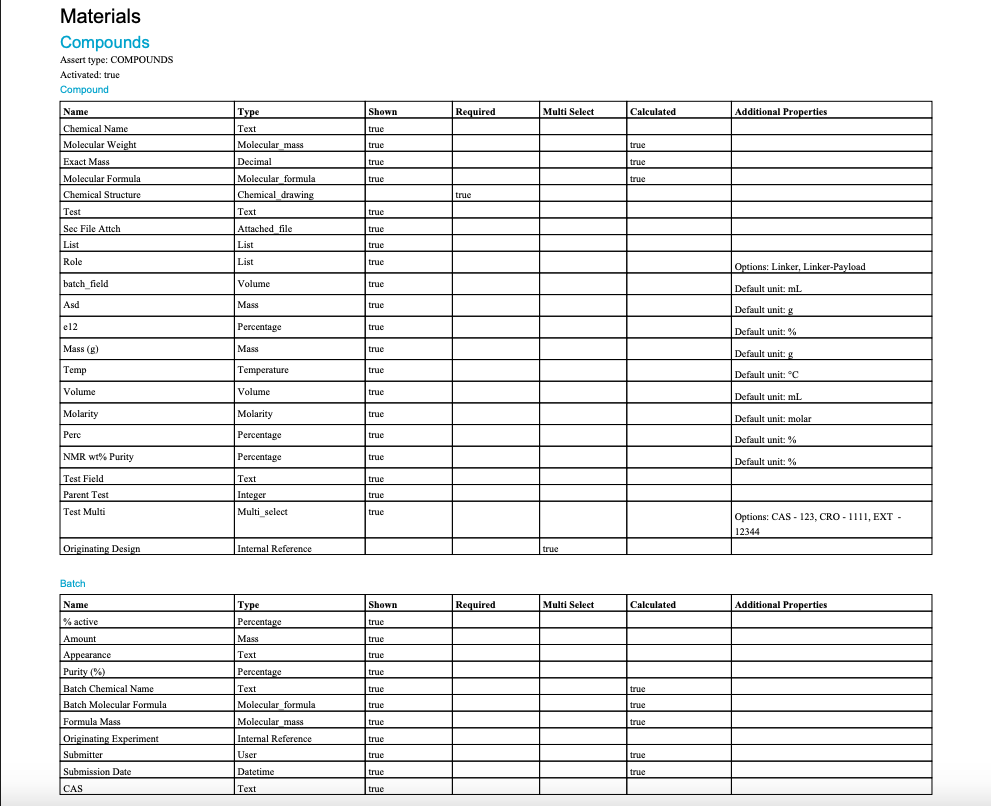

This release brings the beta release of a System Configuration Report. This feature allows the generation of a PDF that captures the current configuration settings for a tenant. The Configuration Report is accessed from the Export Configurations dropdown.
What's New
We are delighted to release our new version of Signals, 25.8. This release brings enhancements in our Data Workflows and Analytics, SAR and decisioning, Inventory, Tables and Plates amongst others. We have new beta capabilities for Hierarchical Tables, Contextual Lists and extended beta capabilities around Supplier Lists, Data Factory and InVitro Analysis. Finally, we have also fixed a number of small bugs.
The following improvements are available for users, administrators and developers on the Signals platform. Certain features may only be available with appropriate licensing and/or with enablement by an administrator.
- AI
–Admin options to enable/disable AI functionality in Signals One (Beta) - Data Workflows & Analytics
–Animal Selection & Group Assignment App with Randomization capabilities is no longer available
–Data Factory 2.0 Publishing (beta)
–Exclusion of Plates or individual Wells (beta)
–Analytics annotations (beta)
- SAR &Decisioning
– System generated IDs can be used when publishing data to Data Factory (beta)
– Changes to Data Factory’s information design now propagate to published data (excludes legacy projects) (beta)
– ChemCharts manual sequence alignment visualization, HELM enhancements, and structure visualization improvements
- Synergy
– Copy/Copy Partial of Work Order
– Bulk create Designs from enumerated Products in Parallel Experiments
- Chemistry
– Drawing of individual RNA or DNA monomers is now supported in the HELM editor
– Selection and replacement of multiple monomers at once when using the HELM editor is now possible
- Admin Defined Tables & Variation Tables
– ROUND function
– Hierarchical Tables (beta)
– Contextual Lists (beta)
- Plates
– Load/update plate via CSV upload
- Inventory
– 3 New labels
– Update to Export Containers for searches that return no results
– Additional Container Privilege for updating Home Location
– Search by CAS and select containers in Quick Add in Chemical Drawings
– Remove link to any container in the Materials Table
– Bulk Import Containers (beta)
– Update to Advanced Search for Home Locations with grid coordinates
– System Supplier List available in Chemistry Settings Configuration (beta)
- Materials
– Option to utilize structure AND additional fields in uniqueness checking
– Total Cysteine Content (%) for protein sequences
- Adminstration
– Privilege to create or use personal templates
– Privilege to copy experiments or entities
- Integrations & APIs
– Enhanced APIs to allow RXN files for export and replacement of Chemical Drawings
– API enhanced for adding items to Stoichiometry grids without Chemical Structures
– New APIs for moving location content to a new location
– New API to create relationship links between entities
– API enhanced fetch all samples from a Samples Table
– New APIs to fetch and update Order details
– External Notifications for Work Orders
– New CRO specific APIs for interacting with Entities and Samples
We also fixed several small bugs in this release. Details of the enhancements are described below.
Developers should note that we are planning to address an issue with the GET /entities/{eid}/export endpoint, where currently the response returns an incorrect Content-Type header for Text entities. The header is currently set to text/plain, while the actual content is text/html. This only affects text entities created through text file upload. This will be corrected in an upcoming release.
Data Factory administrators should be aware that in an upcoming release you will no longer be able to create Legacy Data Factory projects. We encourage adopting the Data Factory beta features which will soon replace the current (legacy) projects.
System Administrators of E3 or Private Cloud systems using our validation ready deferred release should be aware of the upcoming change to our patch process. Starting November 2025, we will introduce a planned patch to E3 and select Private Cloud environments approximately 3-4 weeks after the update to Production. These patches will contain resolution to critical issues identified late stage during PQ testing or immediately post-Production. Note: These critical issues can include those not identified via a Sandbox tenant that were not fixed in sufficient time in our Standard releases to be part of the Production update. If no appropriate issues are identified, no patch will be released. The planned timing for the patch will be communicated in the Release Notes.
Administrators should note that the beta capability “Animal Selection & Group Assignment App with Randomization capabilities” is no longer available.
Administrators should be aware that the stereochemical annotation of pseudochiral OR centers using the guided stereo tool now will add an additional label which is interpreted as chemically significant. This change only applies to annotations made subsequent to this change, existing compounds will remain with the prior understanding until edited.
Data Factory administrators should be aware that you can no longer change the data type of an attribute to an incompatible format (e.g.: from chemical structure to date).
Data Factory administrators should be aware that secondary (AER) maps will now only be handled by the Data Factory backend. You can no longer create nor modify these maps manually. Consequently, the following are breaking changes in Primary APIs:
GET /information-design-service/import-maps/{importMapId} no longer returns secondary maps
POST /information-design-service/import-maps/search no longer returns secondary maps
POST /information-design-service/import-maps no longer allow the creation of secondary (AER) maps. This will return a 400 error if attempted. Query parameters and response fields related to secondary maps have been removed.
The following endpoints will no longer return fields related to secondary maps:
PATCH /information-design-service/mtypes/{name}
GET /information-design-service/mtypes/{name}
The following endpoints have been marked deprecated and will no longer include fields related to secondary maps:
GET /information-design-service/attributes/{attributeId}
POST /information-design-service/mtypes
PUT /information-design-service/attributes/{attributeId}
Administrators are recommended to subscribe to the channels within our support news site found at https://support.revvitysignals.com/hc/en-us/categories/360004446171-Support-News which contains more information about releases and other pertinent product information.
This content is anticipated for release on our Production E3 environments, and for Private Cloud customers on our deferred release schedule, in March 2026
Further Details
The following improvements are available for users, administrators and developers on the Signals platform. Certain features may only be available with appropriate licensing and/or with enablement by an administrator.
SAR & Decisioning
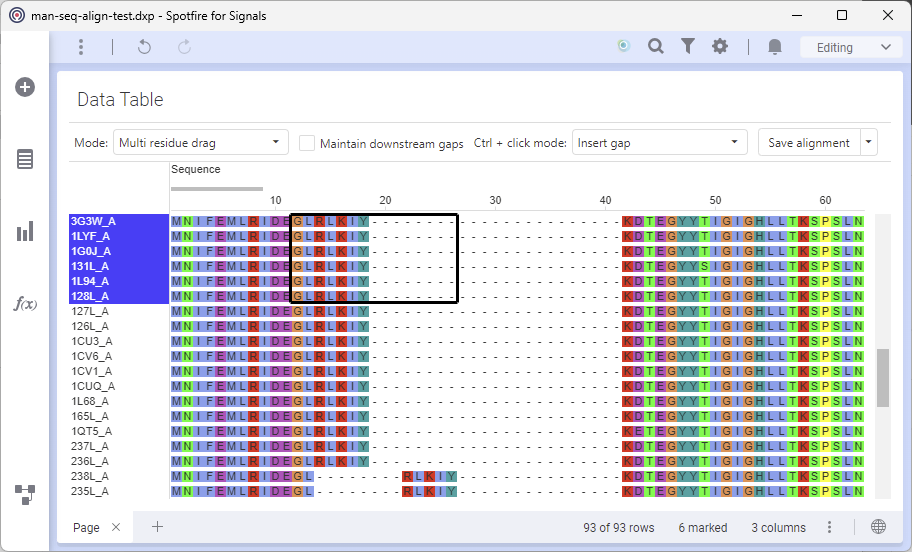
The ChemCharts “Manual Sequence Alignment Visualization” allows users to manually align biological sequences (including HELM). Drag to align single or multiple residues and modify gaps as needed.

The ChemCharts HELM visualization introduces a handful of customer-requested helper data functions.


Convert biosequence formats using the BILN to HELM data function.
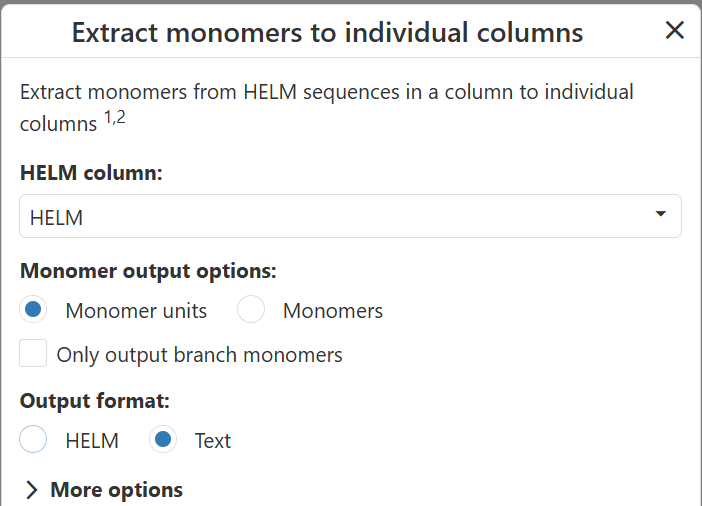

Extract all monomers or monomer units from HELM into a set of columns
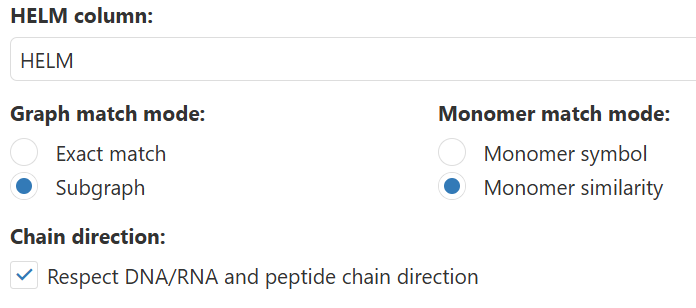
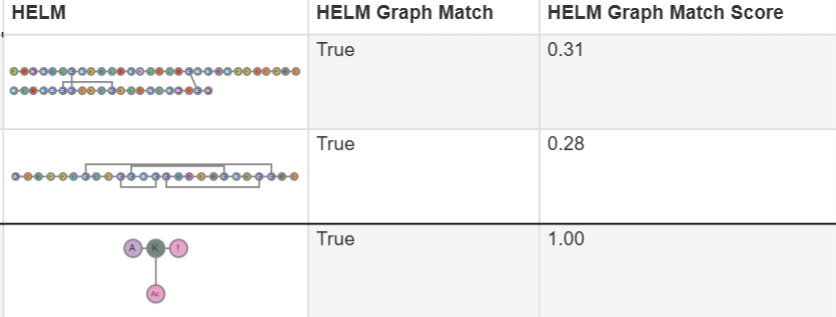
Perform HELM substructure or similarity searching using a powerful graph-based comparison of query structure and target structures.

Optionally use a local data table as a monomer source

ChemCharts now supports SVG image format within Table/Gallery visuals, and the Embed Image data function.

There are minor enhancements to the Kinome, Chemistry, Gallery, and Table ChemCharts
In the Kinome visualization, optionally use column names as node labels.
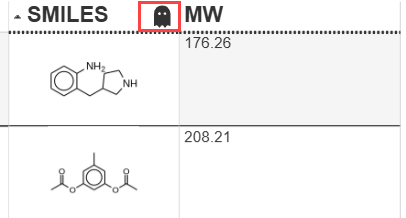
In the Table visualization, there is a new visual indicator for columns with a shadow column assigned.
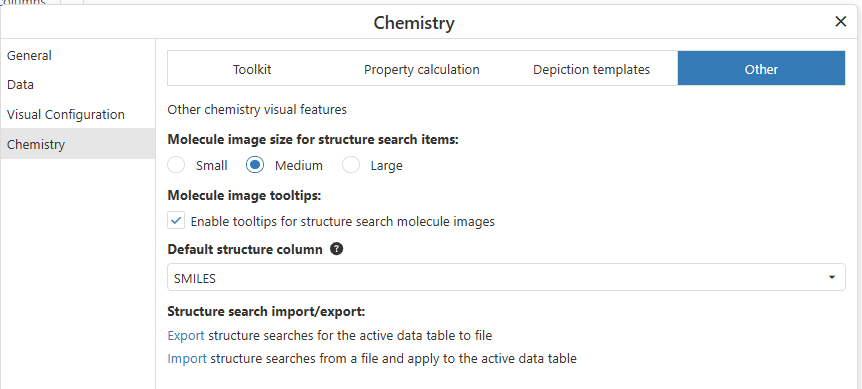
The Chemistry visualization now supports defining a default structure column, enabling/disabling tooltips for structure search images, specifying the image size in structure searches, and importing/exporting structure searches
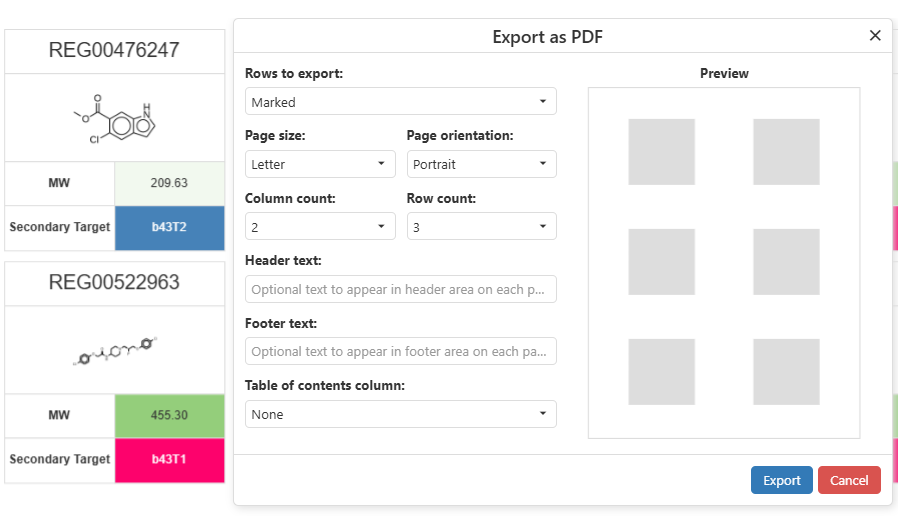
Gallery visualizations can now be exported to PDF


Antibody and Nanobody data functions, including Developability Dashboards, now support the ABodyBuilder v3 model
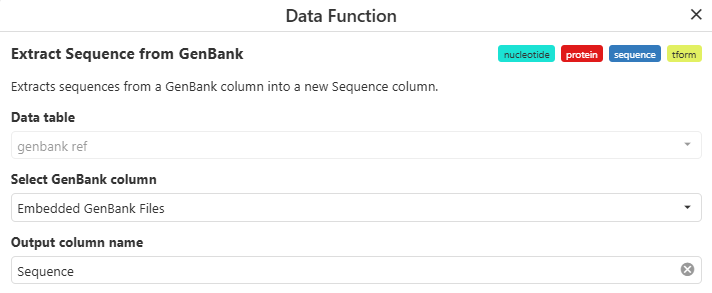

Use the new “Extract Sequence from GenBank” data function to output the sequence into a new column.
Synergy
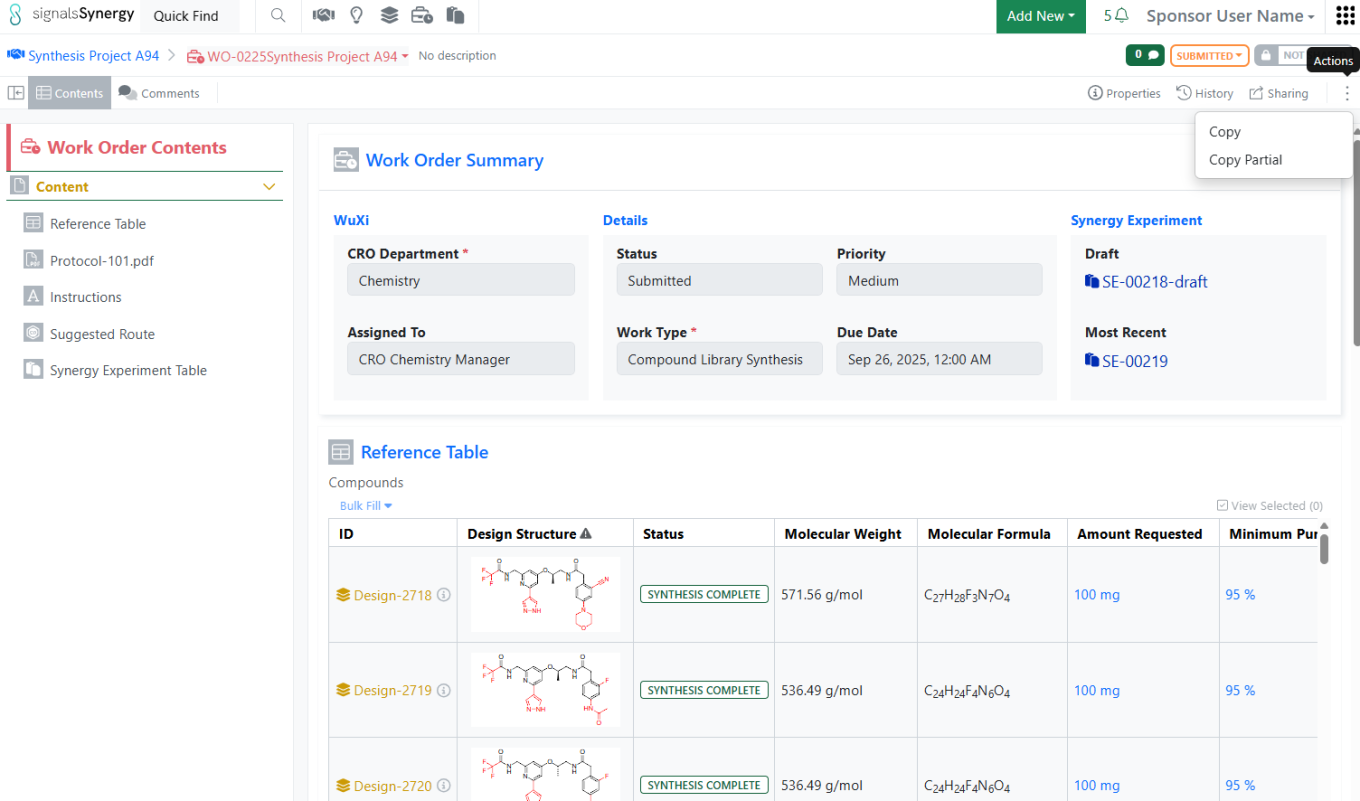
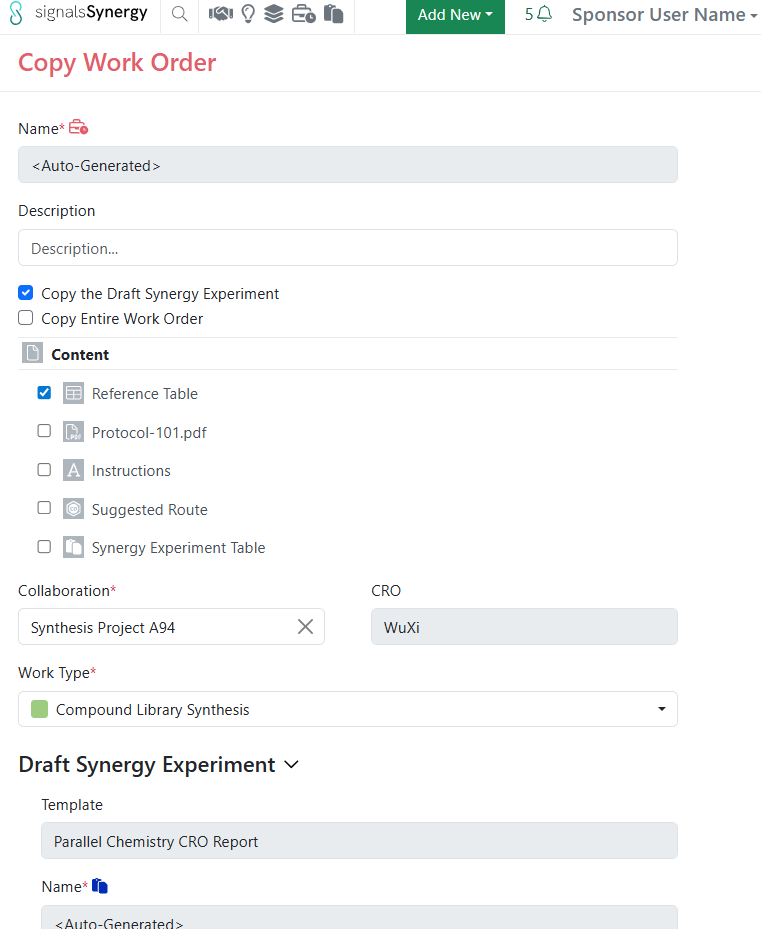
Sponsor users with the new privilege Clone Entities can Copy or Copy Partial Work Orders. This allows the Sponsor to easily send the same compounds for another assay or easily repeat common Work Orders.
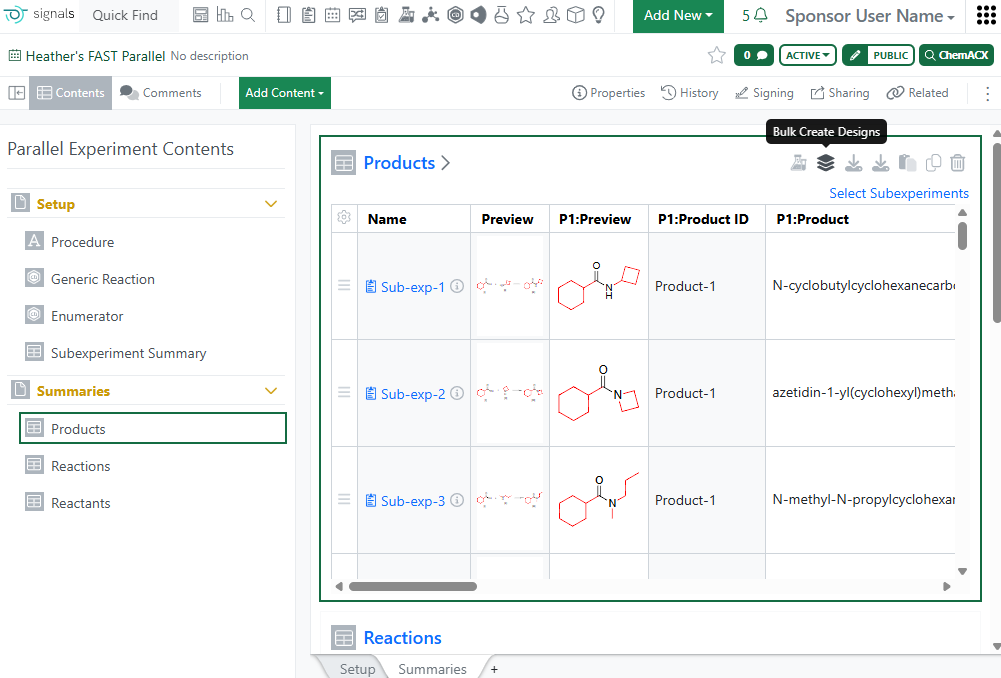
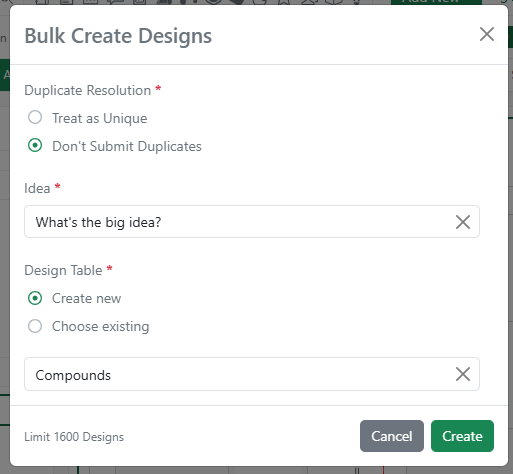
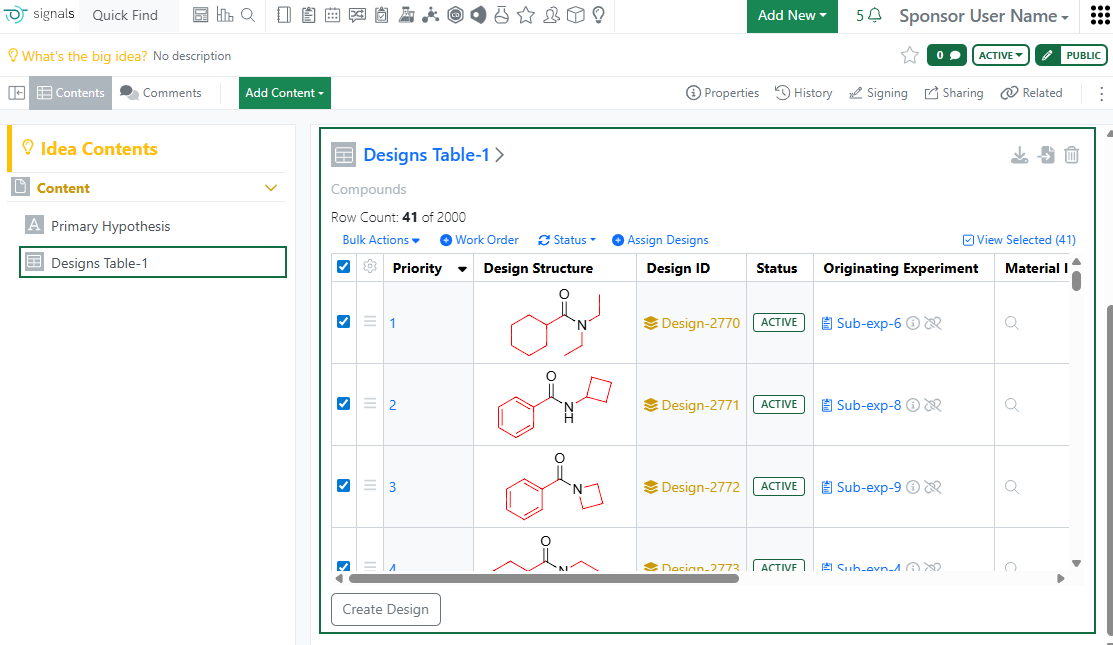
After enumerating Products in a Parallel Experiment in Signals, a Sponsor may want to synthesize the products internally or send the Products off to a CRO for synthesis. On a Sub-Experiment/Products Table in a Parallel Experiment, a Sponsor can now Bulk Create Designs. Created Designs are marked with the Originating Experiment for traceability and are easily sent off in a Work Order for synthesis at a CRO.
Chemistry

Support for drawing individual RNA/DNA monomers has been added to the HELM editor. When editing in the RNA/DNA tab of the HELM Editor, there is a new "None” option available in the dropdown menu for secondary monomers. When “None” is selected, a monomer of that type will not be drawn when the primary monomer is added to the ChemDraw canvas. Additionally, if the user wishes to draw using only the primary monomer (ribose, base or phosphate), a modifier key is available. Selecting alt/option + the monomer will only add the primary monomer to the canvas.
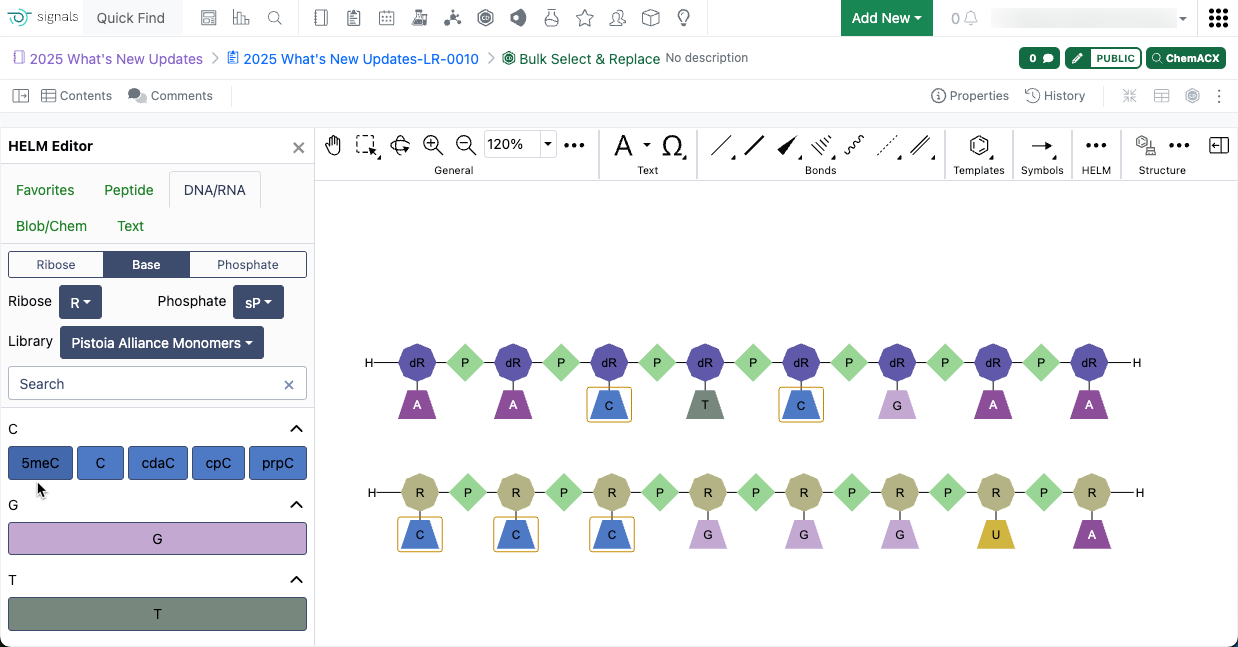
Bulk selection of monomers while in HELM edit mode is now possible by using the 'Shift' key and selecting multiple monomers on the canvas. Once selected, these monomers can be replaced simply by selecting a new monomer in the HELM editor.
Admin Defined Tables & Variation Tables
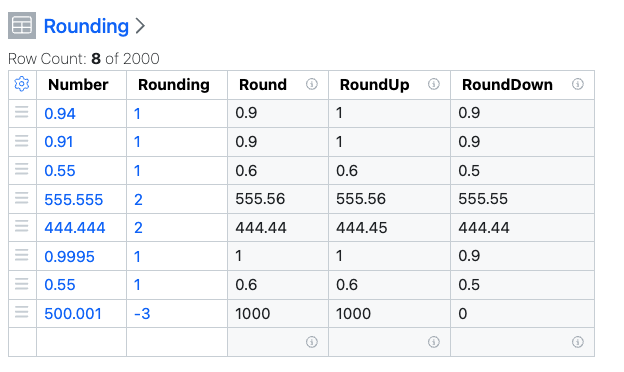
A new function “ROUND” is available in table calculations, to supplement our exiting ROUNDUP and ROUNDDOWN functions. ROUND uses the method “Rounding half away from zero”, an optional second argument allows definition of which position relative to the decimal point the value is rounded to. If the second argument is absent, the value is rounded to the nearest whole number.
Plates

Users are now able to load or update Plates via a csv upload by selecting “Update plates from csv”.
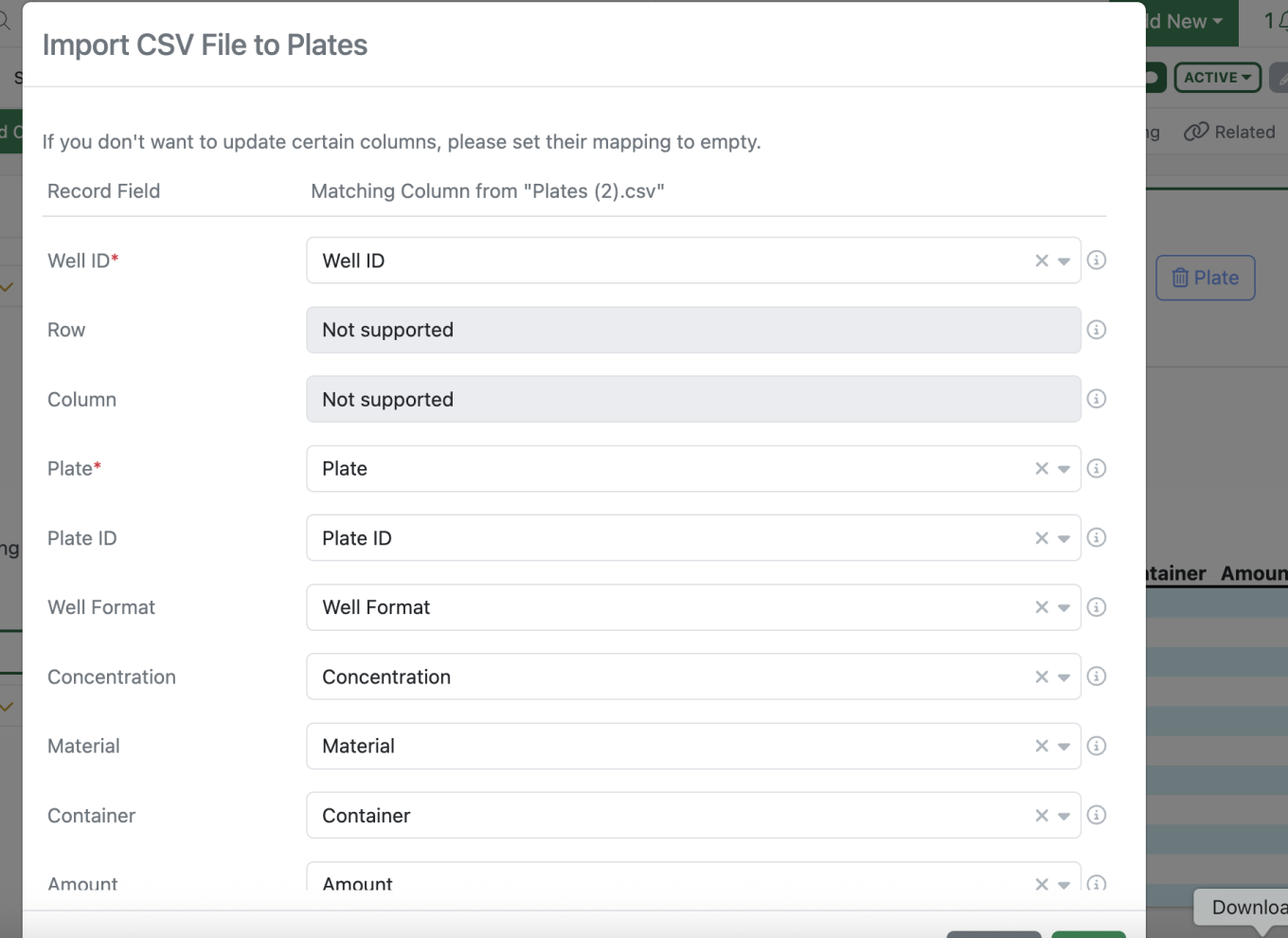
This brings up a mapping modal which allows the user to map columns from their csv to the associated annotation layers.
Once imported the plate is updated.
Inventory
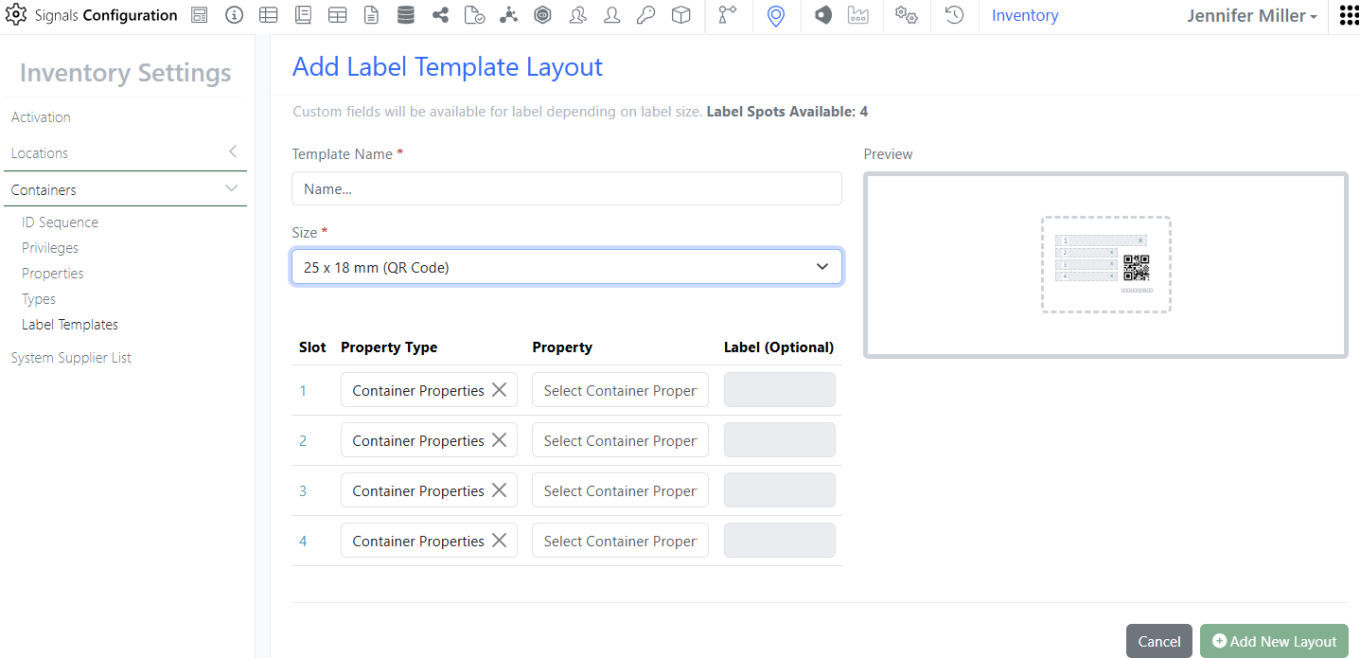
3 New Labels:
25 x 18 mm:
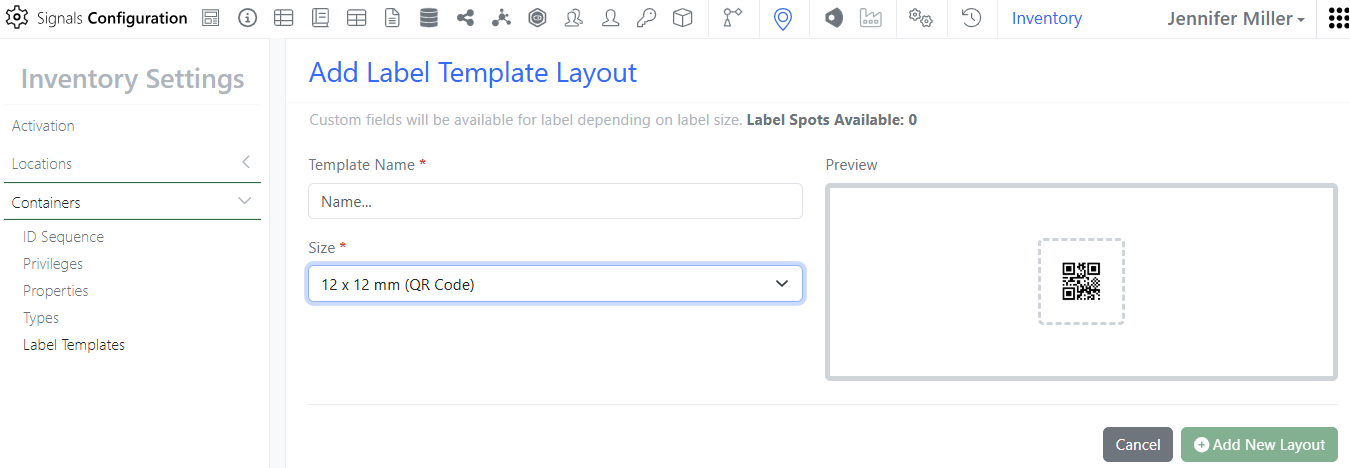
12 x 12 mm:
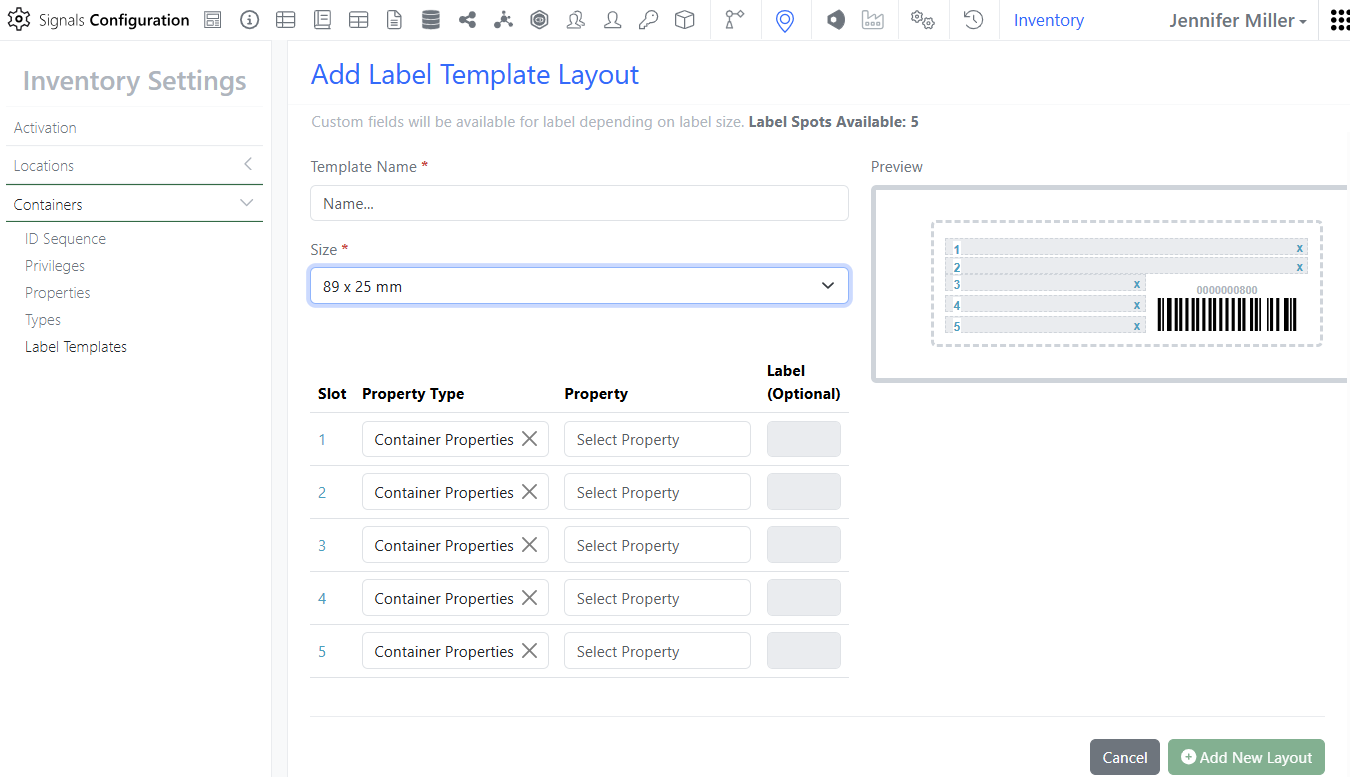
89 x 25 mm:
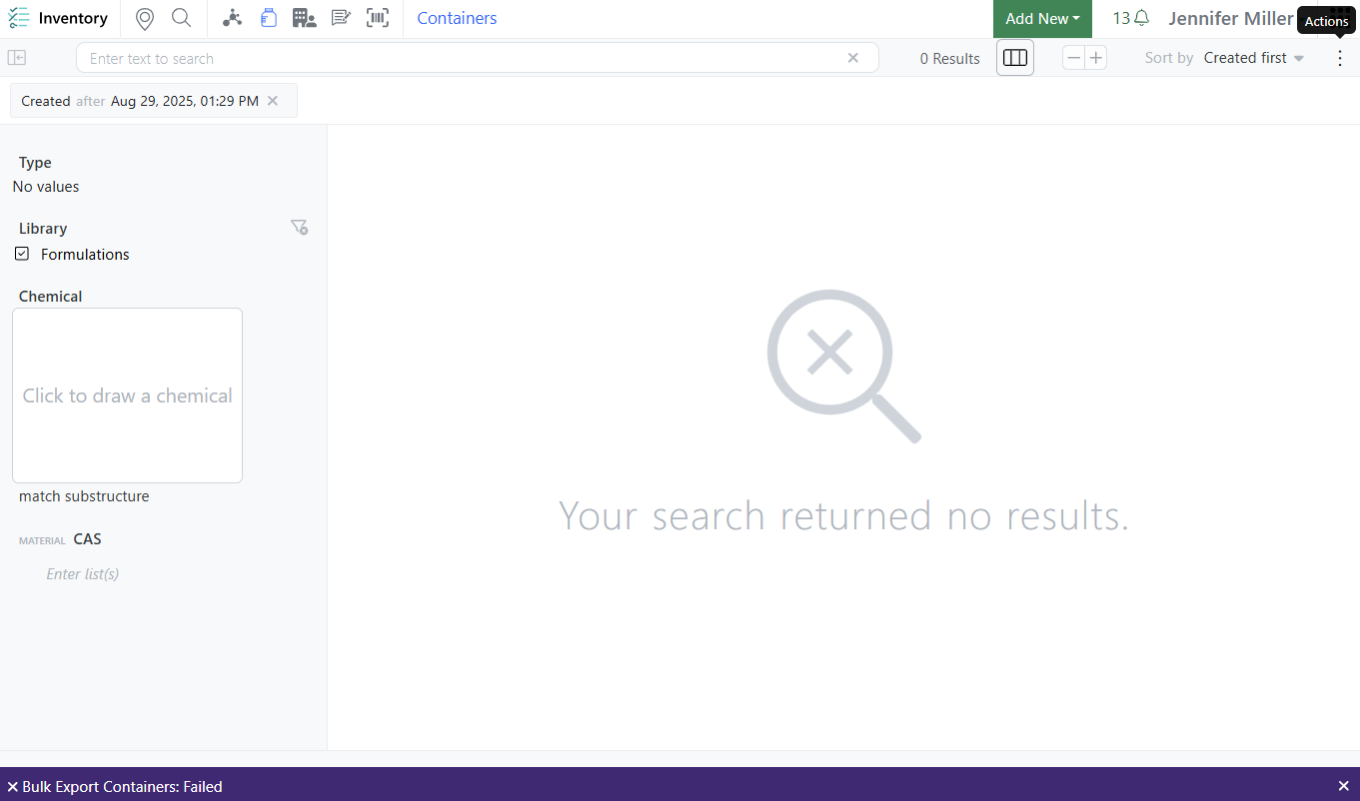
Update to Export Containers for searches that return no results. If the data changed during the export the job would not finish, Users will now see a failure message on the page:

And on the report page:

Additional Container Privilege for updating Home Location. Now users can be given the privilege to update a container’s Home Location. Previously this was reserved for System and Inventory Administrators. Users still need security access to the containers as well as Edit Container privilege to update the Home Location:
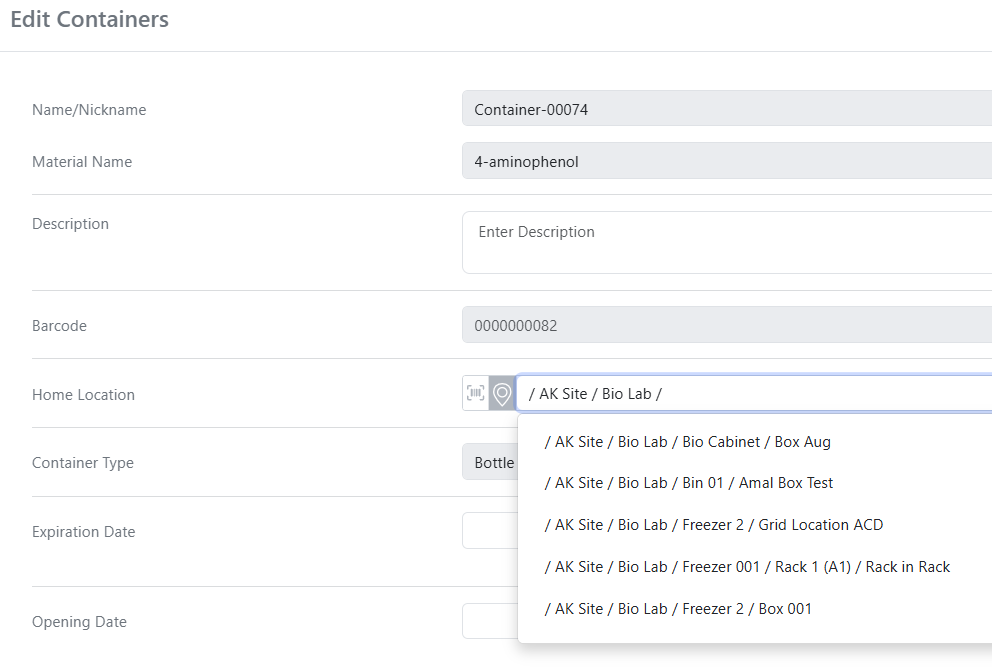
Once the user has the privilege to update the Home Location, they can use the vertical 3 dots in the top right corner to open the Edit menu:
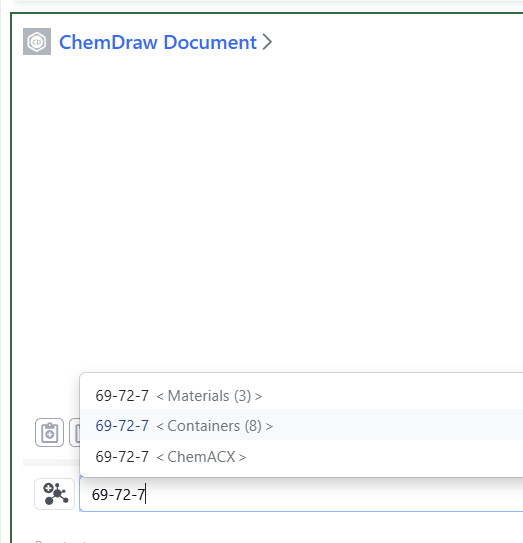
Search by CAS and select containers in Quick Add in Chemical Drawings. When users type a CAS number in the Quick Add, associated containers will show as an option:
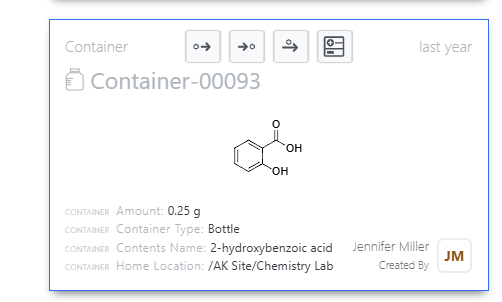
Users then select the container they would like to add to the Chemical Drawing:
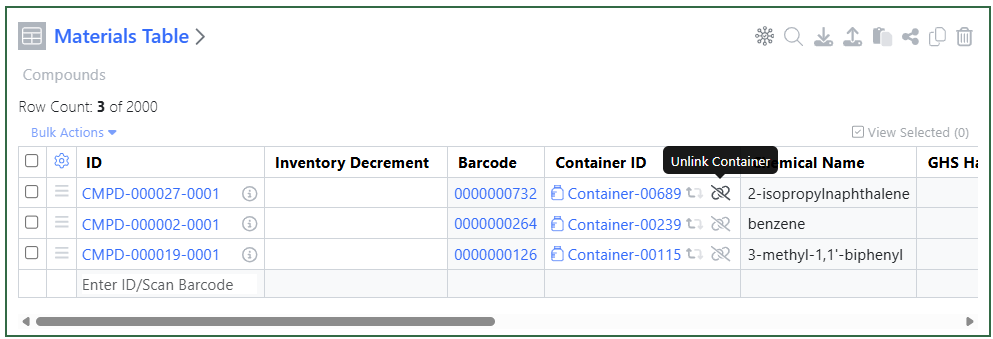
Remove link to any container in the Materials Table via the unlink icon:
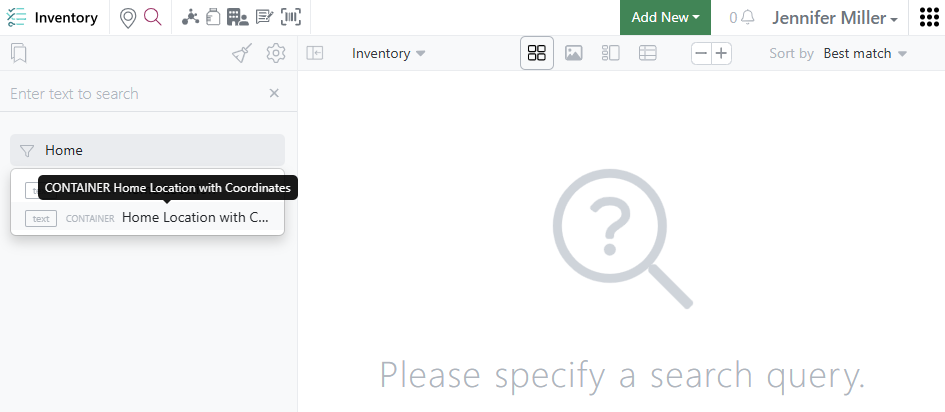
Update to Advanced Search for Home Locations with grid coordinates filter:
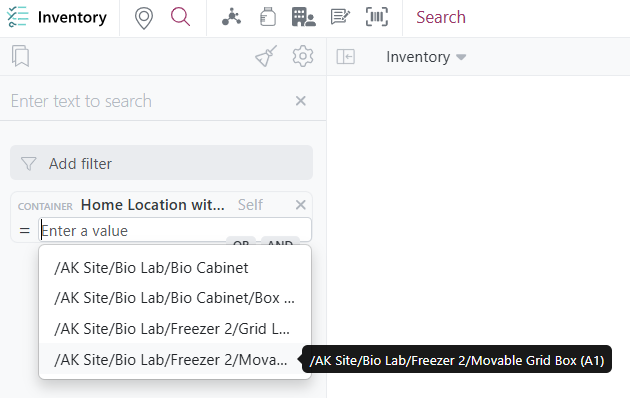
Users can select a location with a grid coordinate to find which container is supposed to be in that location:
Materials
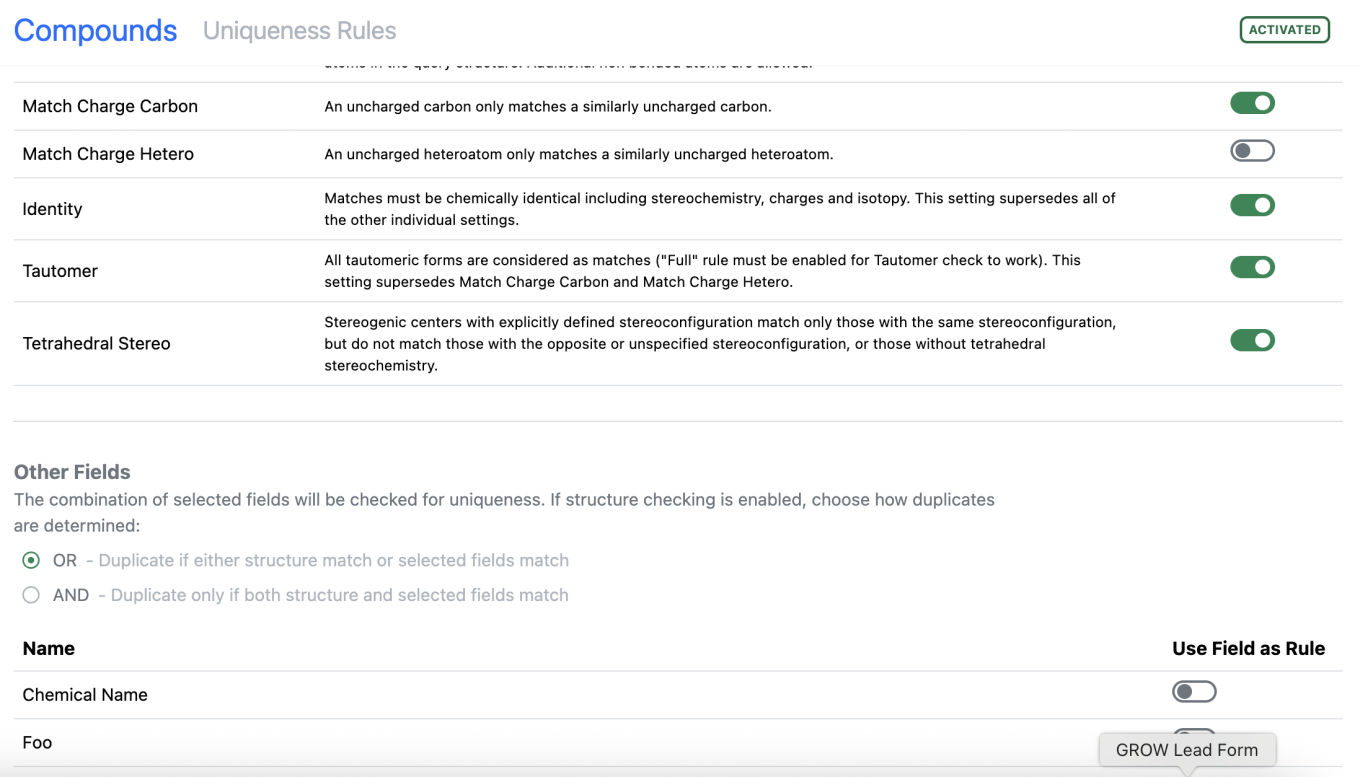
Admins now have the option of utilizing both the structure rules AND material fields in uniqueness checking during material registration.
This is an addition to the existing OR option for uniqueness checking. If AND is utilized, a duplicate will only be identified with there is a match on the Structure AND all selected rules.
These options are deactivated if the Structure rules are turned off as all fields will be utilized regardless of selection.

Calculated total cysteine content (%) is now available for Protein materials.
Administration




Admins can set a privilege to control users’ ability to copy experiments or entities. The “Clone Entities” privilege allows users to copy and partially copy experiments, and content entities within an experiment. Disabling this privilege from all roles for a user will disable the their ability to copy content.


Admins can also set a privilege to control users’ ability to save or use personal templates. When the “Save as Template” privilege is disabled for users they cannot save nor use Personal Templates.
When admins disable both the ‘Clone Entities’ and ‘Save as Template’ privileges, end users are forced to use the latest definition of a system template when creating an experiment.
Integrations & APIs

We have updated our APIs to allow for exporting and replacement of Chemical Drawings with RXN files. A replaced Chemical Drawing will maintain the entities ID while replacing the content from the provided RXN file.

We have added new APIs for adding custom products and reactants to Stoichiometry grids. This enables the ability to add either a product or reactant to a stoichiometry table without need of a chemical structure.

We have added new APIs for moving location content to a new location. This will move all the containers in a location to another location. You will need to provide an option for handling duplicates as part of the request.
The API is asynchronous and kicked off in three steps: Create the Move Content Job -> Check the Status of the Job -> Get a report of a completed Job.

We have added a new API to create relationship links between entities. The type of relationship: related, repeats, repeated_by, duplicates, duplicated_by, precedes, or preceded_by is required for creating the link.

We have updated our API to allow fetching all Samples in a Samples Table.

We have added new APIs to fetch and update Material Orders.

For our Synergy product we have added External Notifications for Work Order signing Events. These are included in the Notification Trigger “All Signing Events”.
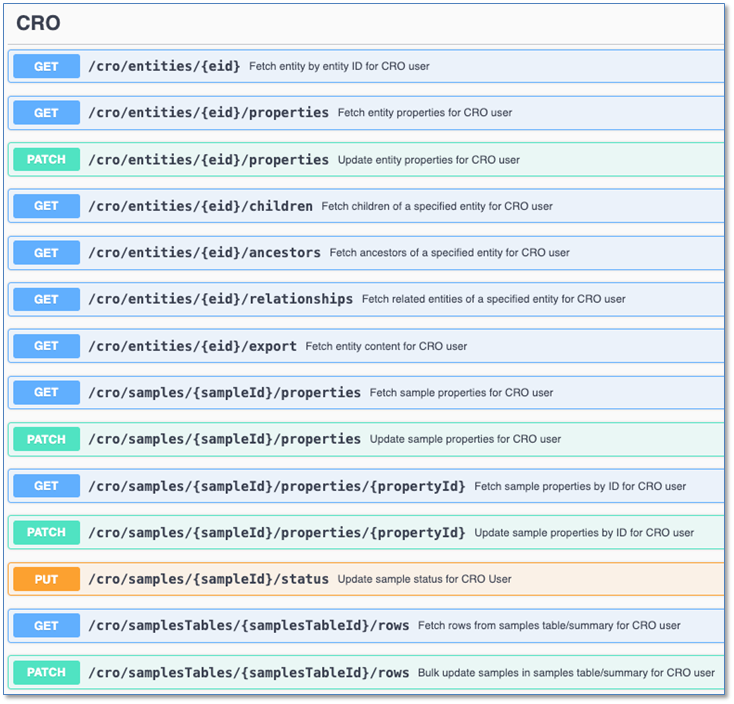
We have added new APIs specific to our Synergy Product CROs. These allow for specific APIs to be utilized by CRO users. This enables customers External Actions to read and write for CRO users without exposing details that CROs are restricted from seeing or interacting with
Further Details
The following capabilities are in beta and are available for users, administrators and developers on the Signals platform upon request. Please contact your account representative or our support team if you would like access to the following features.
AI
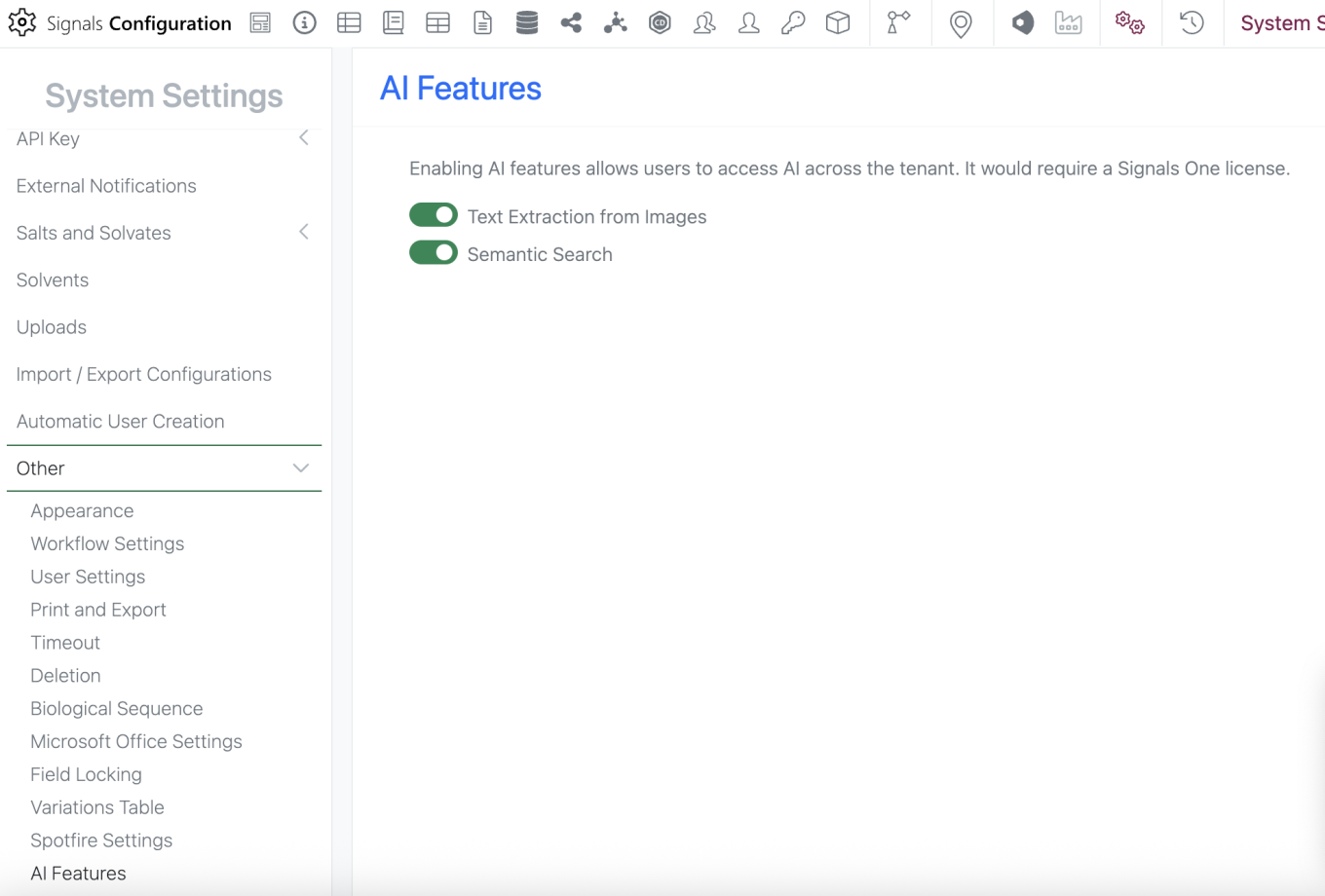
Administrators will now be able to enable or disable new AI features utilizing the AI settings options. AI features still require a Signals One license and infrastructure to function. This just allows the admin more granular control on when these features are made available to end users.
Data Workflows & Analytics
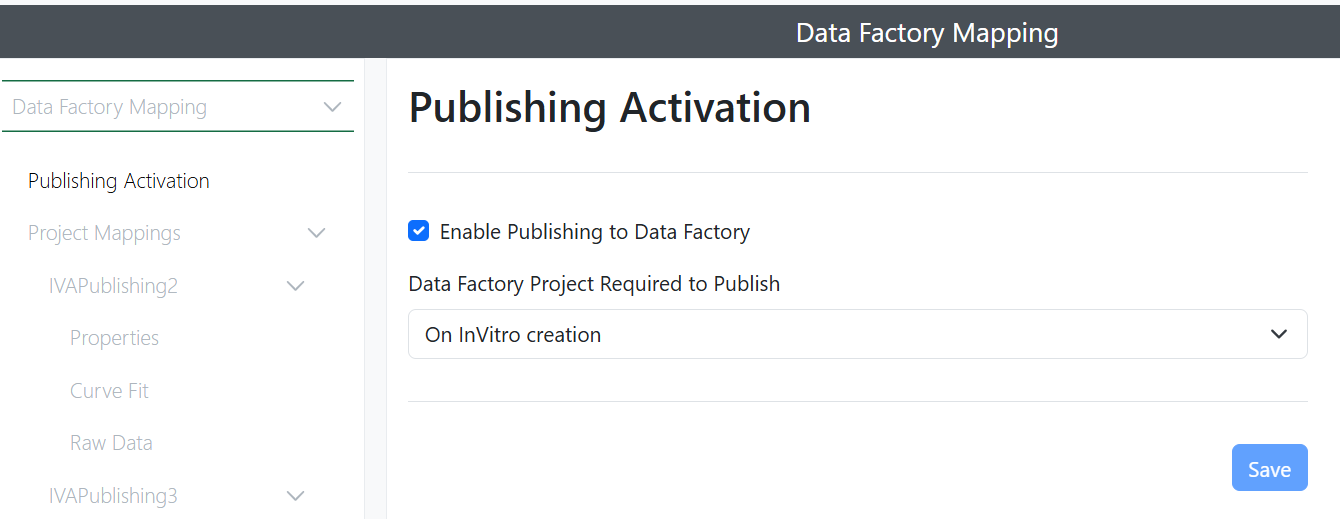
For tenants with a Signals One license, users will now be able to perform In Vitro (screening, assays) data analysis, visualization and results quality control. The first curve fitting method available is the logistic 4 Parameter (4P) fit.
It is now possible to define the mappings of the raw data and curve fit results with the Measurement Types of a Data Factory 2.0 project in the In Vitro Analysis templates.
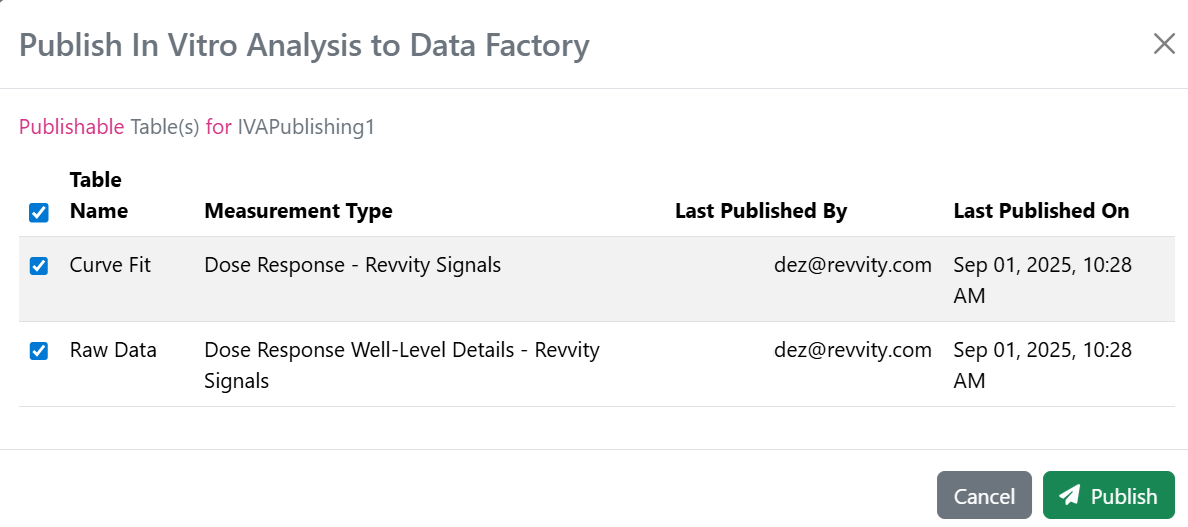
In addition to the raw data and curve fit results, which are interrelated, a set of general properties can also be mapped for publication.
The users of an In Vitro Analysis template with publishing activated can decide whether both raw data and curve fit related tables or only one of them should be published for their analysis.

In addition to the exclusion of curves and curve data points, it is now possible to exclude whole plates or plate wells from normalization.

The exclusions at the plate or well level affect the normalization and the curve fitting downstream. Therefore, the users are notified that they should recalculate the normalization results.
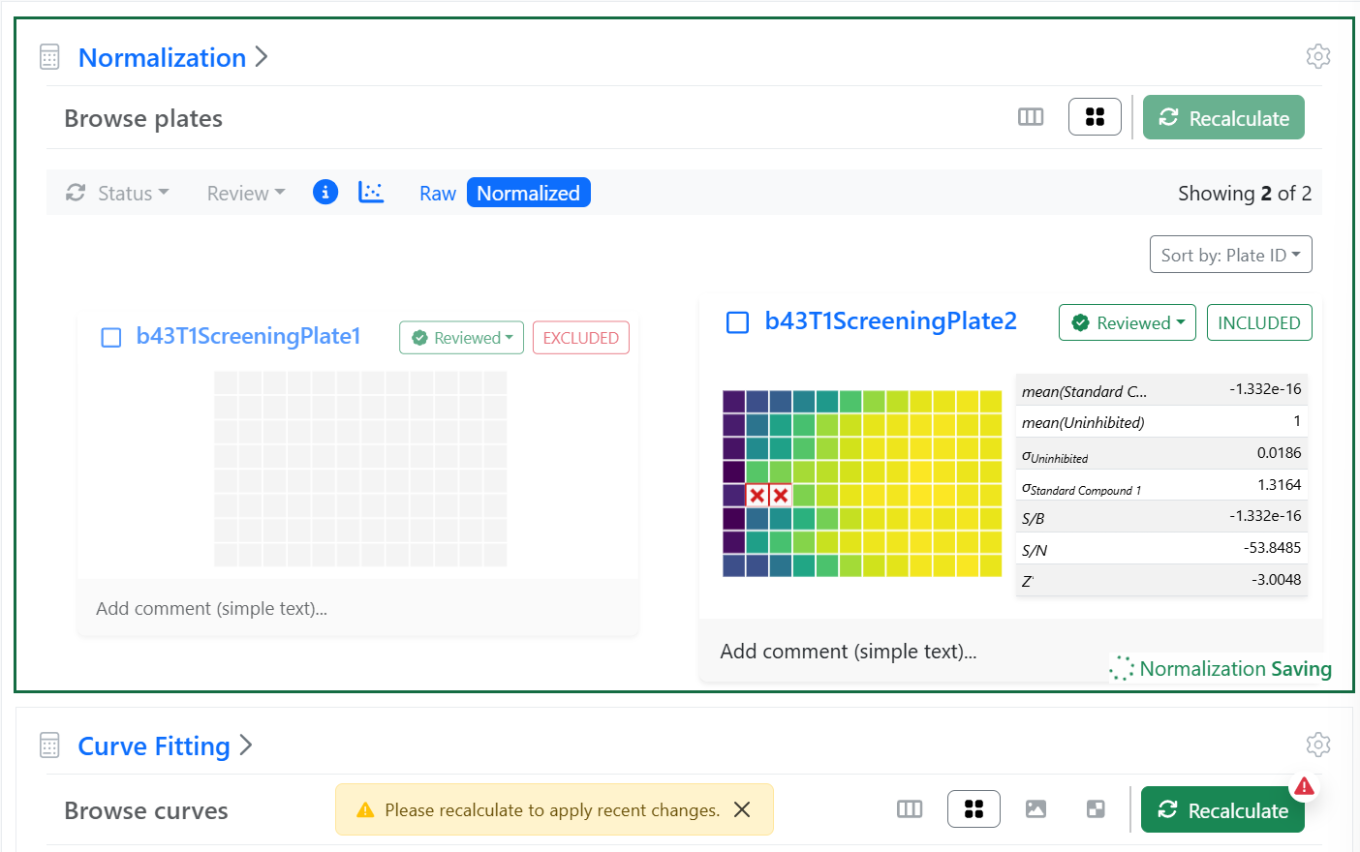
Successively, downstream steps dependent on the normalization, like the curve fitting, will also need to be recalculated and the user gets another notification.
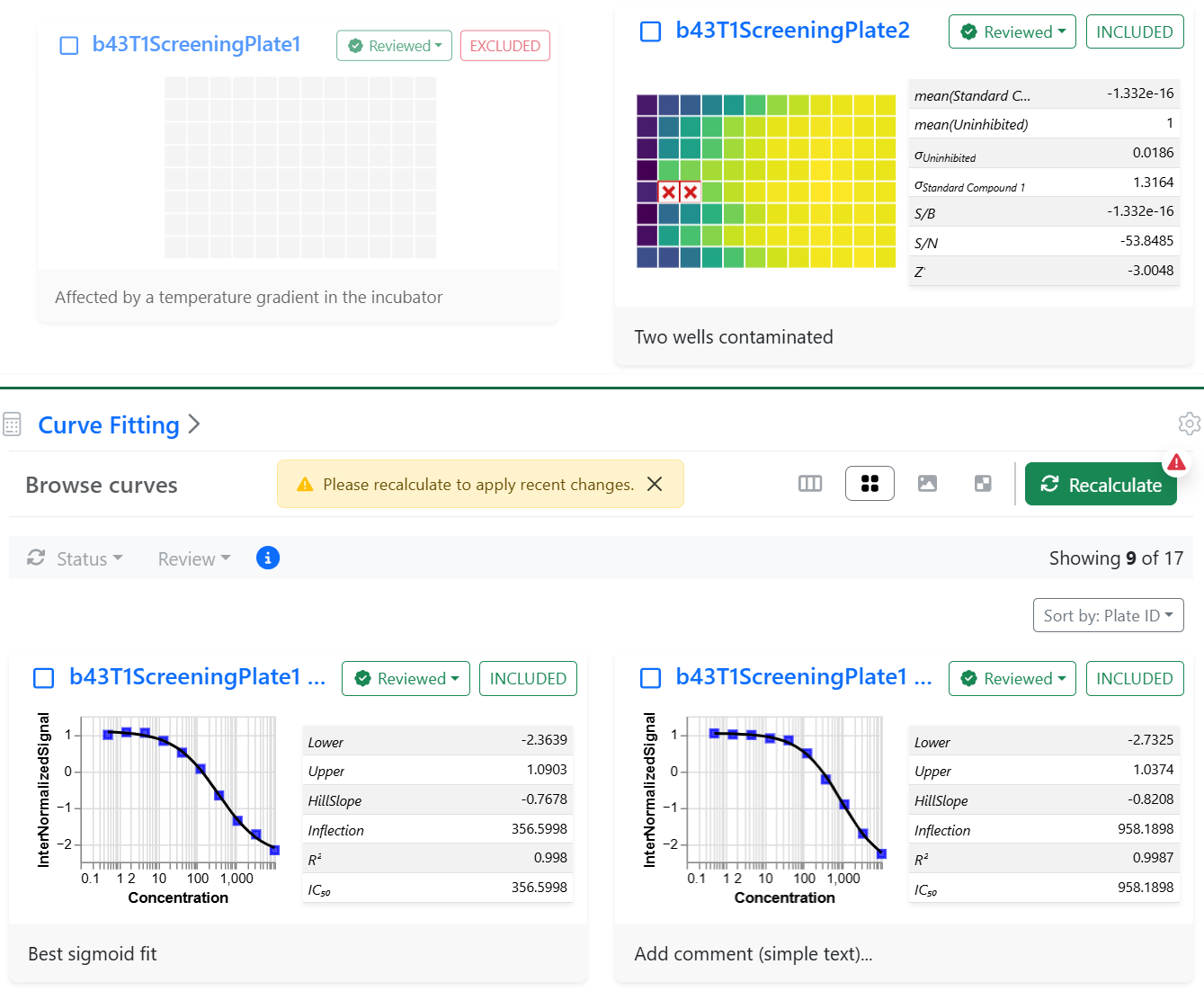
Plate, well, curve and point-level annotations are now embedded in an In Vitro Analysis.
All the annotations can be reset and result recalculated in a row by clicking on the global RUN button, while the recalculate buttons maintain the annotation.
SAR & Decisioning
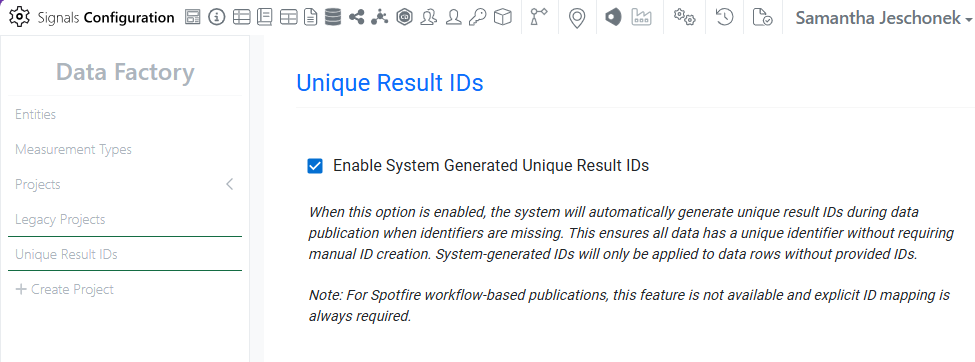
System generated unique result IDs are now available for use with Data Factory (beta) projects in Signals One. When enabled by an Administrator, unique identifiers will be automatically generated for any empty ID values during publication, while preferentially using any explicitly provided identifiers. This feature does not apply to legacy projects.

Data Factory will now propagate changes in entity, attribute, or measurement type design to maps and published data. When making a change to the information design, administrators will be warned if the change will require data reprocessing. Once an admin makes a change requiring data reprocessing, newly published data will be inaccessible until after the admin selects “Reindex Now”, and data finishes processing. When reindexing, all design changes are applied to any existing data or newly published data. Any existing admin-defined maps will continue to work.

When an admin has made changes that require data reprocessing, end-users will see a “New Data Pending” notice, indicating that access to newly published data may be delayed. Previously published data will remain accessible during this time. The label is removed once data finishes processing.
Admin Defined Tables, Variation Tables and Hierarchical Tables

A new tabular content type, Hierarchical Tables, has been added. Hierarchical Table Templates can be defined by an administrator in the Table Templates folder. Hierarchical Tables can contain multiple table layers, with association between an upper row in a table and one or more rows in the lower table, to provide layers of data containing different levels of detail. Hierarchical Tables require the end user to have a Signals One license.

The association between rows can be indicated with “propagating down” an identifier value from a row above. Rows from multiple associated upper rows can be displayed, to add rows however a single parent must be selected.


Available property types include a similar library to in Admin Defined Tables, such as Text, Number, Date/Time, Internal Reference etc. Equations in a table layer or between table layers, or Headers, can be defined. Number properties can also be defined with conditions for data entry, ranges can be set and the property set to either not allow an out of range value, or to provide a visual indication when a value does not match.
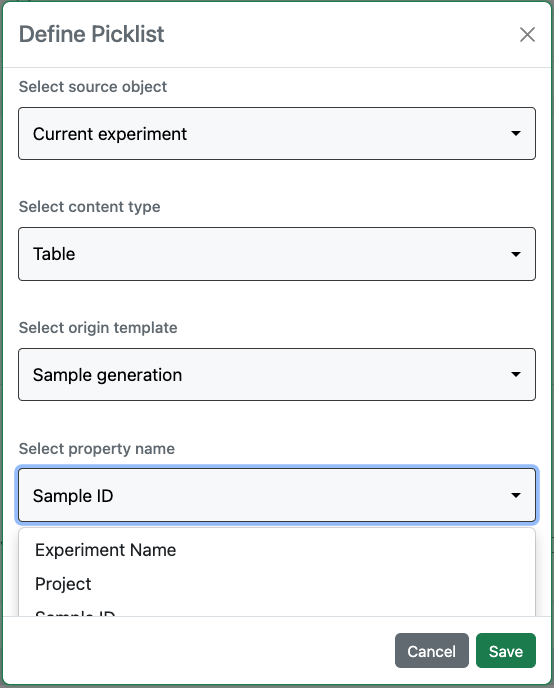
A new property type, Contextual Picklists, have been added to ADTs, Variation Tables and Hierarchical Tables. Contextual Picklists allow an administrator to define a logic for generation of a dropdown list, where the values for the list are sourced from other content within the system. This capability is only available to users with a Signals One license.
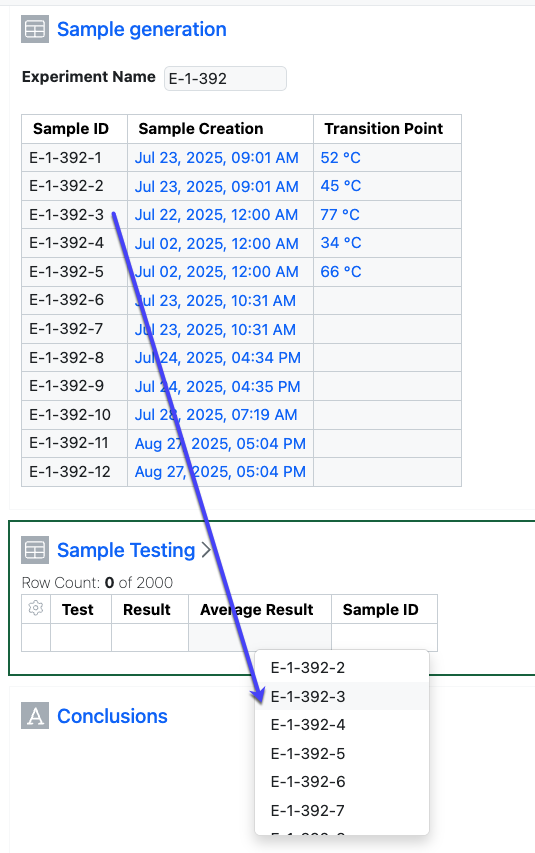
The source of the list can be defined as coming from the Experiment the user is in. The source is further defined as to the content type, such as an Admin Defined Table. Depending on the content type, the source is further refined to identify the Origin Template. Finally, the Property where the values are found is defined. A dropdown list of the unique values, given the prior definition, is presented to the end user as a dropdown.

The source for the list can also be defined as a different Experiment or similar object (Admin Defined Object etc.) The other Experiment must be defined in the table with an Internal Reference type field.
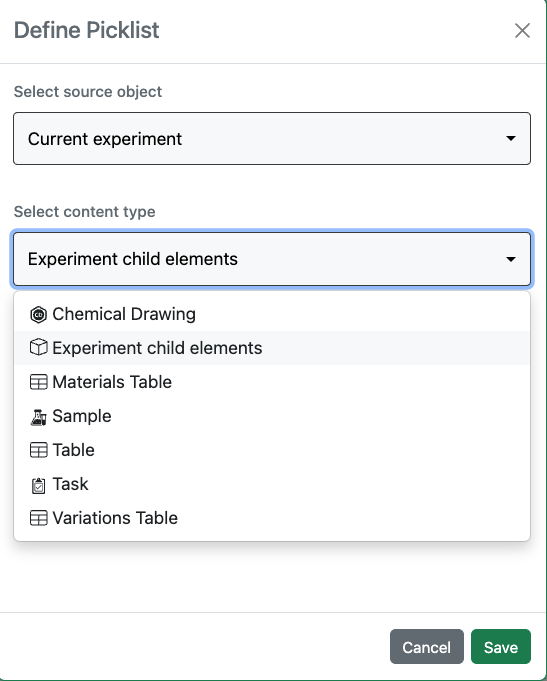
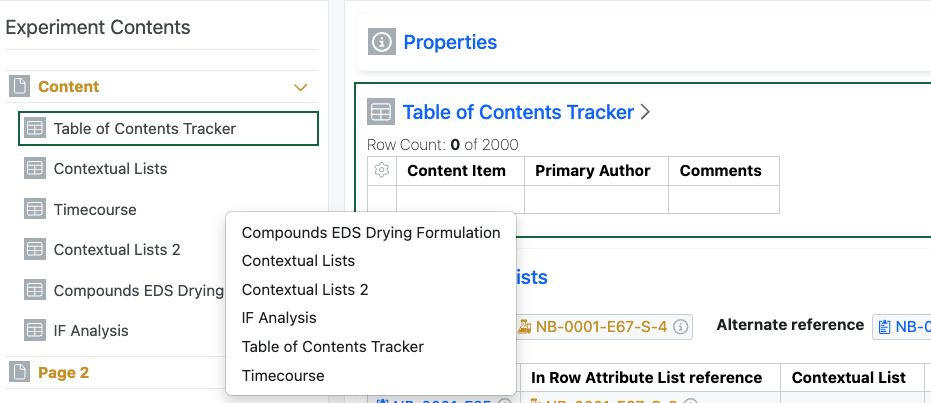
In addition to choosing data from table type objects, the values in the list can also represent the names of the content items within an Experiment by selecting the option “Experiment child elements”.
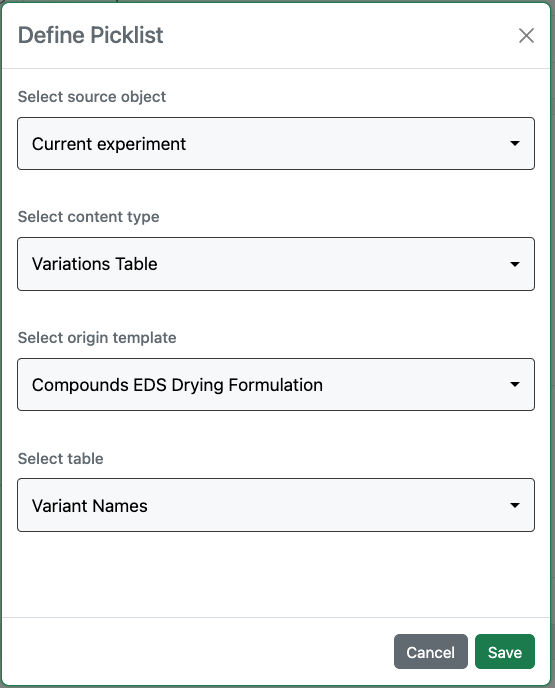
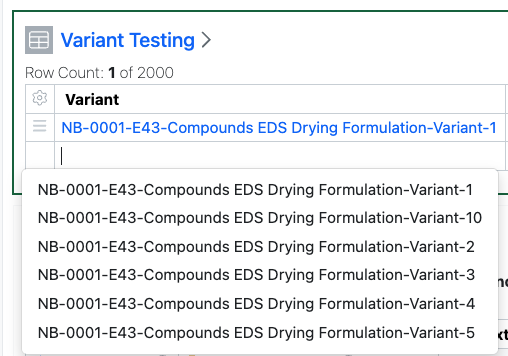
The values in the list can also represent the Variant Names from Variation Tables to aid in associating testing or other data on those Variants by selecting “Variant Names” after selecting the Variation Table and Origin Template.
Inventory
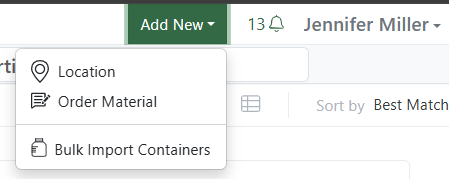
Bulk Import Containers into Inventory. Users need to navigate to Inventory, to the Add New menu:
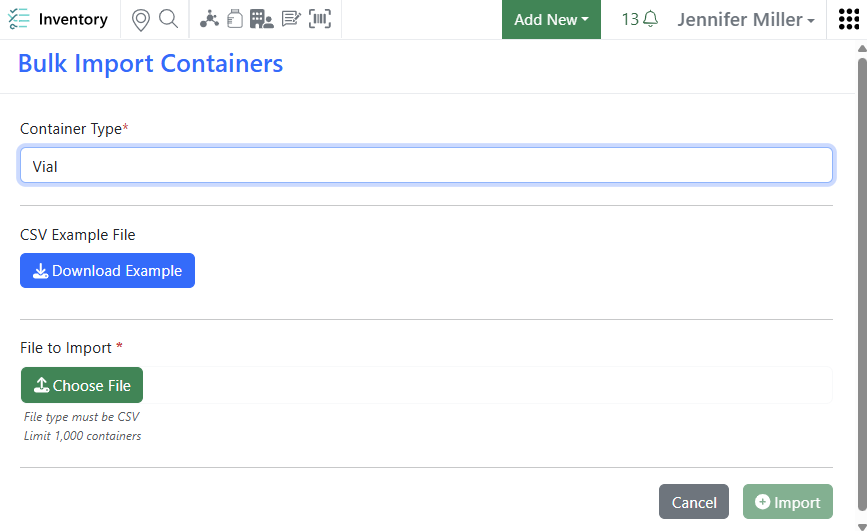
Select a Container Type to activate the Example download and the File Upload:

A csv example file will be created based on the container type properties:
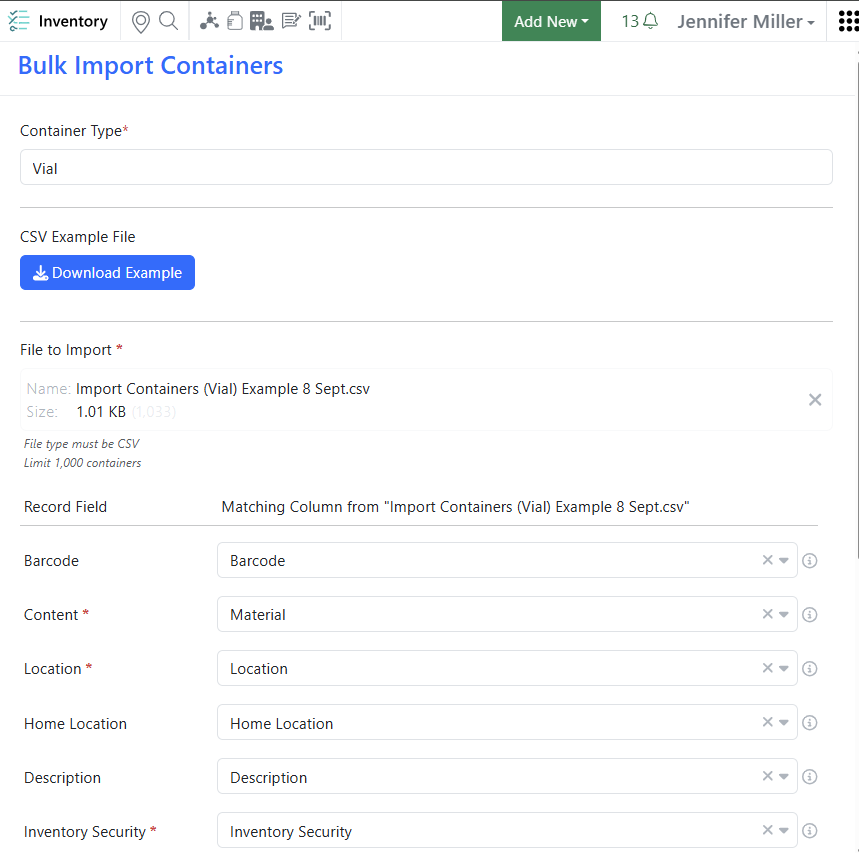
Users need to be able to create containers and have (at least) read access to locations to import containers:

Once the import is started, the progress will be displayed at the bottom of the screen:

When the import is complete a report will be created. If there are any errors, they will appear in the report and the containers with errors will not be created.
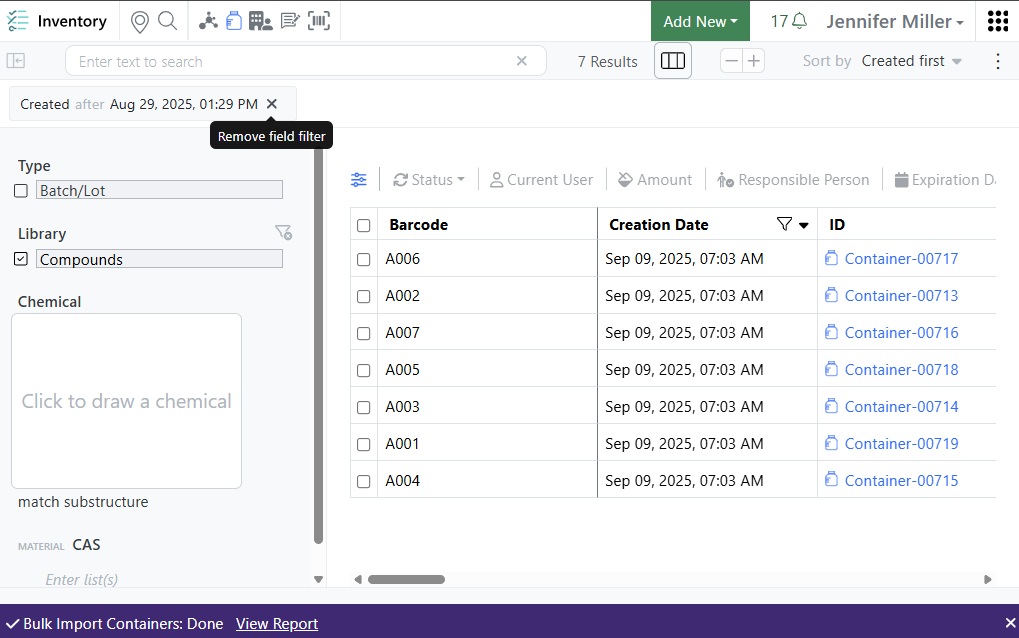
Once complete, the users will be brought to the containers search table with the filter pre-set for the date:
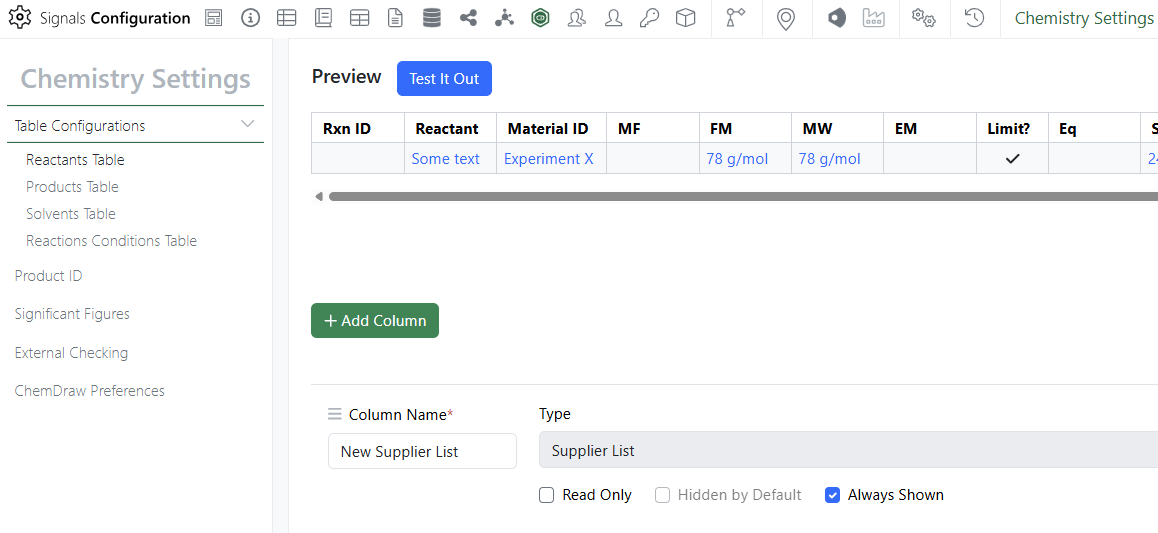
System Supplier List available in Chemistry Settings Configuration. Navigate to the SN Config Chemistry Settings to create a column using the System Supplier List option:
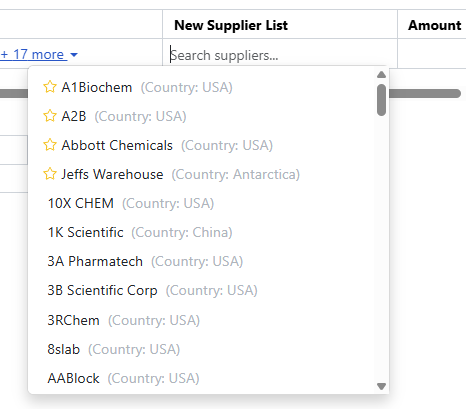
Users will see the column in the stoichiometry table with the favorite suppliers at the top of the alphabetical list:
What's New
We are delighted to release our new version of Signals, 25.7. This release brings enhancements in Signals Synergy, our ChemDraw sketcher, Tables, Samples, History, Inventory, Plates and Materials. We have new beta capabilities enabling Semantic Search and extended beta capabilities around the in vitro analysis object, updated data factory and supplier lists. Finally, we have also fixed a number of small bugs.
The following improvements are available for users, administrators and developers on the Signals platform. Certain features may only be available with appropriate licensing and/or with enablement by an administrator.
- Fundamentals
–The audit trail for System Templates and Experiments captures the previous and current versions of Layout Changes for actions including Rename Page, Add Page, Delete Page, & Reorder Page
–The “Updated User” audit record within the Admin Audit Trail displays current and previous versions of the specific changes to User metadata
- AI
–Semantic Search (beta)
- Data Workflows & Analytics
–Preview of the assembled data in Vitro Analysis (beta)
– Calculations can be applied when analyzing two instrument readouts in Vitro Analysis (beta)
– Re-execution of Analytics steps in Vitro Analysis (beta)
– Improved error handling in Vitro Analysis (beta)
- SAR &Decisioning
– Inventa Analysis SAR Groups preview can now be filtered by Data Factory project
– Integrated Summary App now supports well-level details within the combined unsummarized table.
– Target Engagement Profiler now uses “continuous” as the default x-axis
– Data Factory projects now support Custom Entity data and Material Sync (beta)
- Synergy
– Bulk fill values in Reference Tables for selected rows
– Sharing of batch salt information to CROs in Reference Tables
– Status Modified field and filter for Designs and Work Orders
– Notifications for internal users and groups assigned to Designs
- Chemistry
– View basic chemical properties in the Analysis panel
– Add chemical properties directly to the ChemDraw canvas
– Hydrogen-bonded fragments are treated as a single structure
- Admin Defined Tables & Variation Tables
– Update to Material selection from experiment to include Name
- Samples
– Inclusion of Reaction ID in Sample Update Modal
- Plates
– New Properties Annotation Type
- Inventory
– System Supplier List available in new Material Library (beta)
– Exponential notation update on Container Amount on Batch/Lots
- Materials
– Bulk import of salts for compounds
– Bulk update of salts & solvates for materials
– 'dd-MM-yyyy' date format for bulk import
- Integrations & APIs
– New API to recall Synergy Work Order
– New APIs to move locations to new parent locations
– New API for creating a material from a material table
– Download option for Notebook API Yaml Files
We also fixed several small bugs in this release. Details of the enhancements are described below.
Administrators should be aware that the stereochemical annotation of pseudochiral OR centers using the guided stereo tool will change to add an additional label which will interpreted as chemically significant. This change will occur in a future release and only apply to annotations made subsequent to the change, existing compounds will remain with the prior understanding until edited.
Administrators are recommended to subscribe to the channels within our support news site found at https://support.revvitysignals.com/hc/en-us/categories/360004446171-Support-News which contains more information about releases and other pertinent product information.
This content is anticipated for release on our Production E3 environments, and for Private Cloud customers on our deferred release schedule, in November 2025.
Further Details
The following improvements are available for users, administrators and developers on the Signals platform. Certain features may only be available with appropriate licensing and/or with enablement by an administrator.
Fundamentals

When a user updates the Layout for System Templates and Experiment-like objects, the audit trail captures previous and current versions for the layout changes including Rename Page, Add Page, Delete Page, & Reorder Page. This change only applies to content updated after the update.
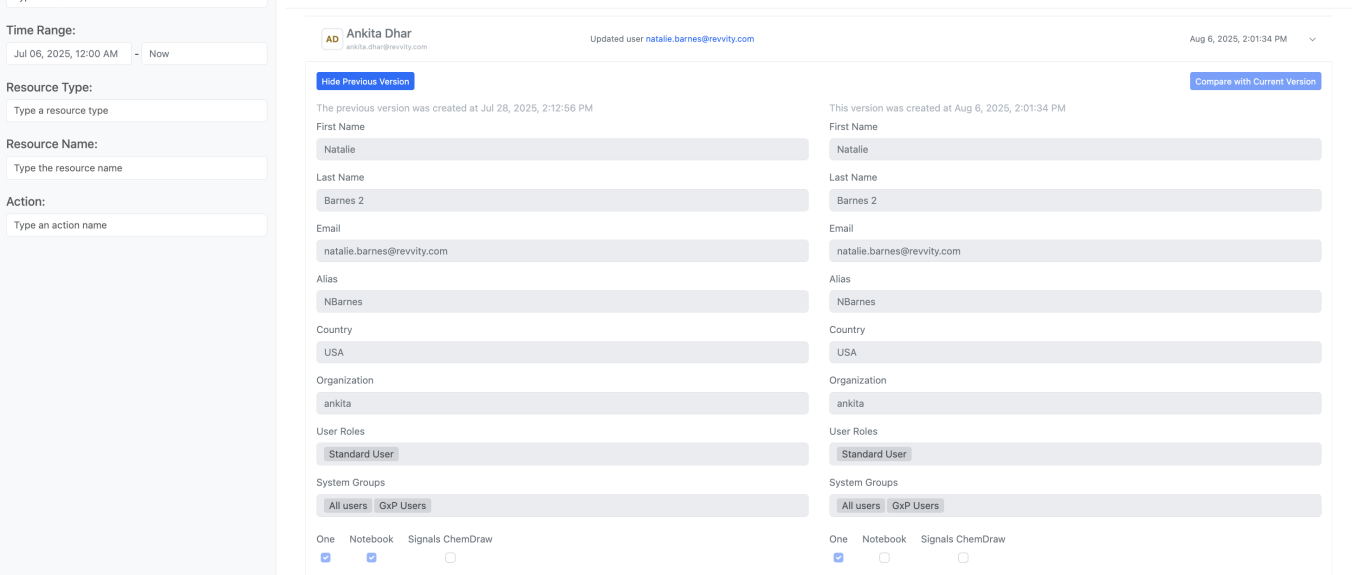
Additionally, when an admin updates metadata within a User’s profile, the “Updated User” audit record within the Admin Audit Trail displays current and previous versions of the specific changes to the user’s metadata.
SAR & Decisioning
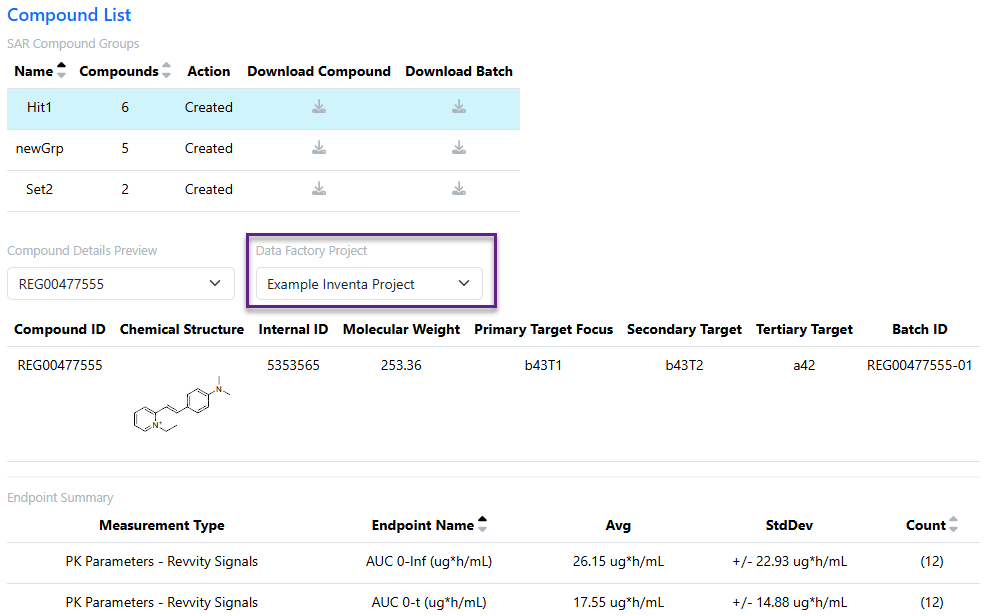
Inventa Analysis users can now filter SAR Groups data by Data Factory project to focus on the most relevant data.
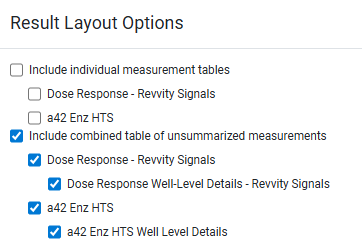

Users can now include Details-level measurement types in the Combined Unsummarized Table within the the Integrated Summary App.
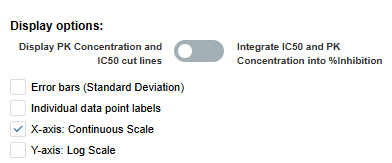
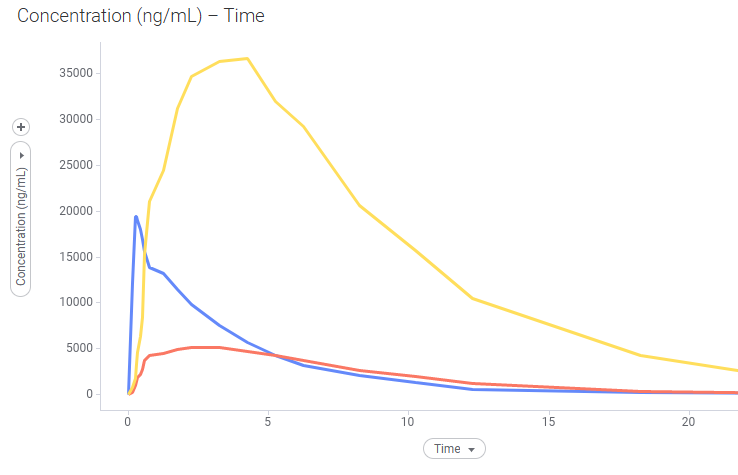
The Target Engagement Profiler now defaults to “continuous” x-axis when viewing Concentration vs. Time, within a convenient checkbox to switch to a categorical view.
Synergy
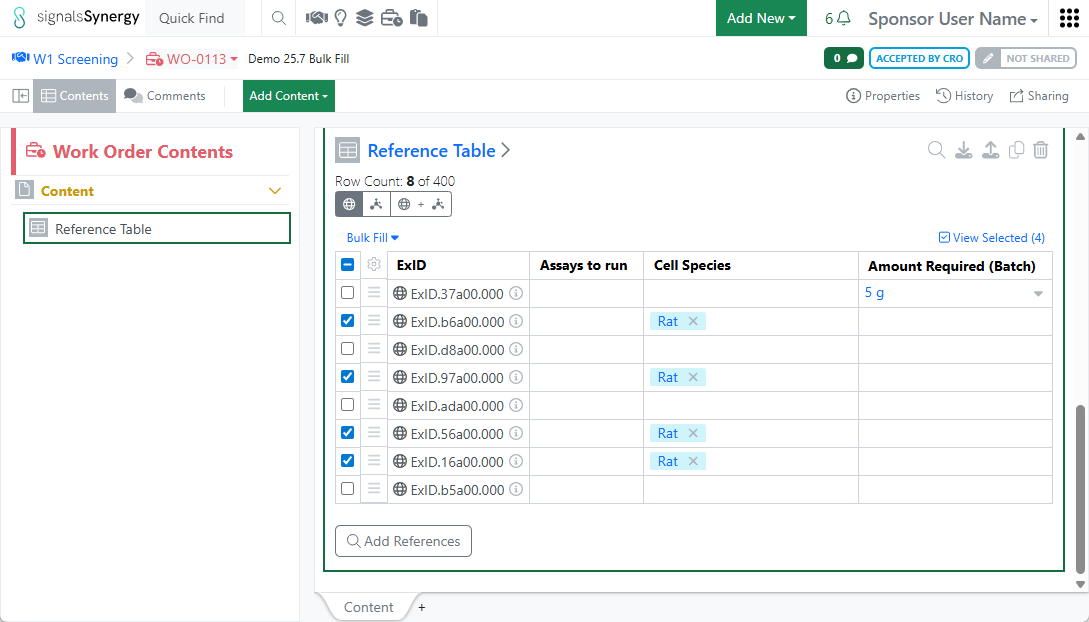
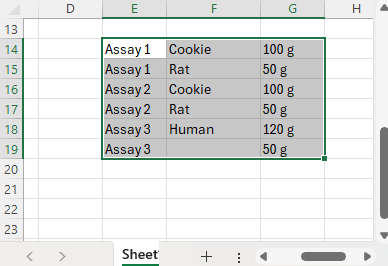
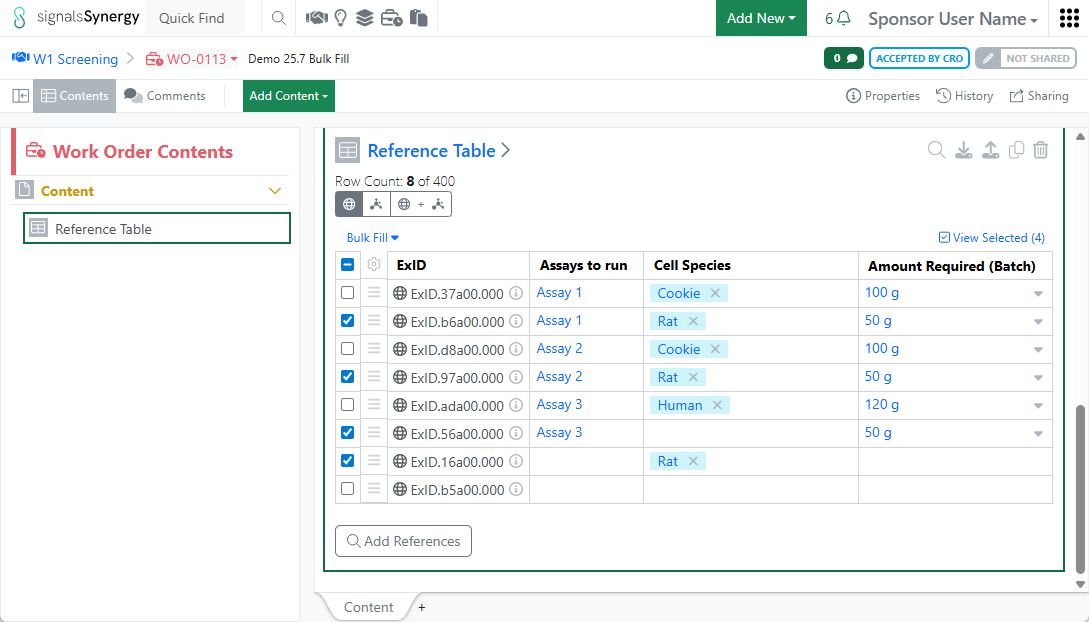
Sponsors often need to provide additional information related to a specific Design or Material (ExID) using Reference Table admin-defined fields. For example, a Sponsor may need to indicate which assays to run on specific compounds or the amount and minimum purity requested for each Design being synthesized. Sponsor users can now Bulk Fill values in Reference Tables using copy-paste from cells within the table or from an excel or csv file.
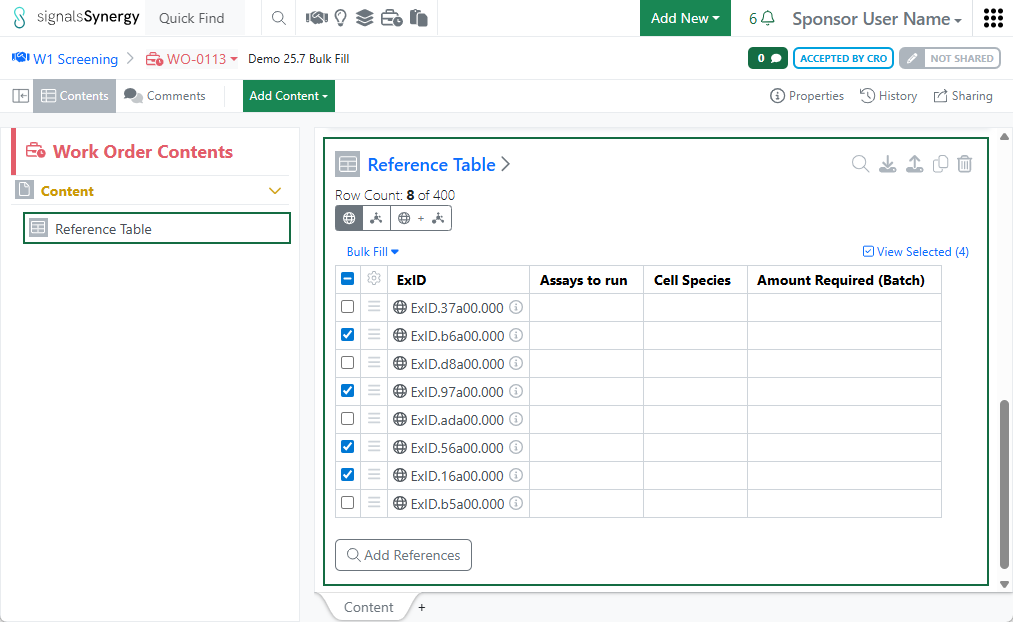
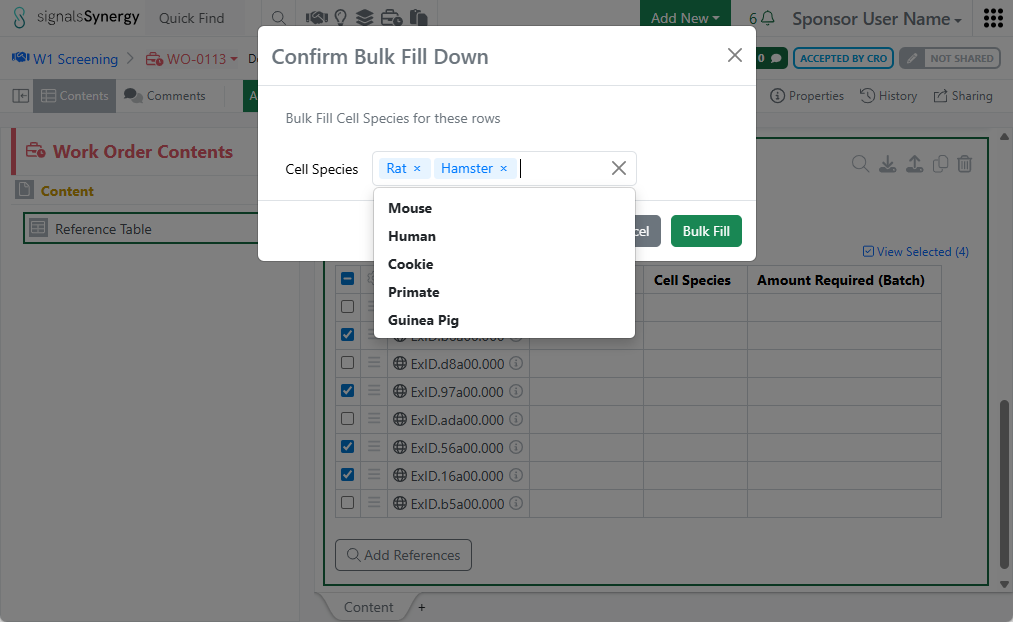
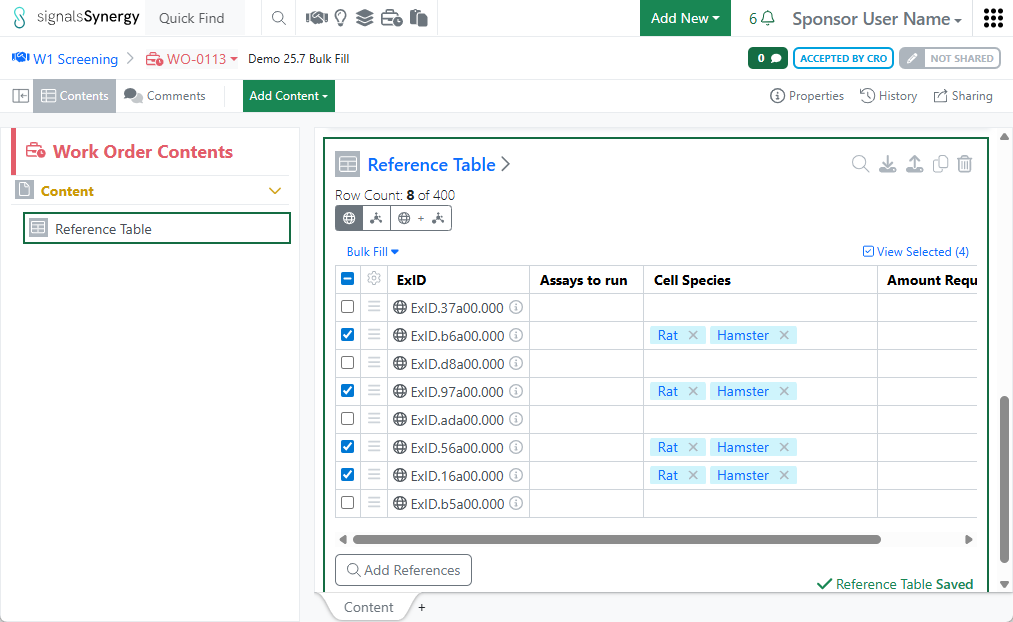
In addition, users can also Bulk Fill multiple cells in a column with the same value. After selecting a set of rows, users choose a column from the Bulk Fill menu and then enter or select a value. After pressing Bulk Fill, the same value is applied to the cells in all selected rows.
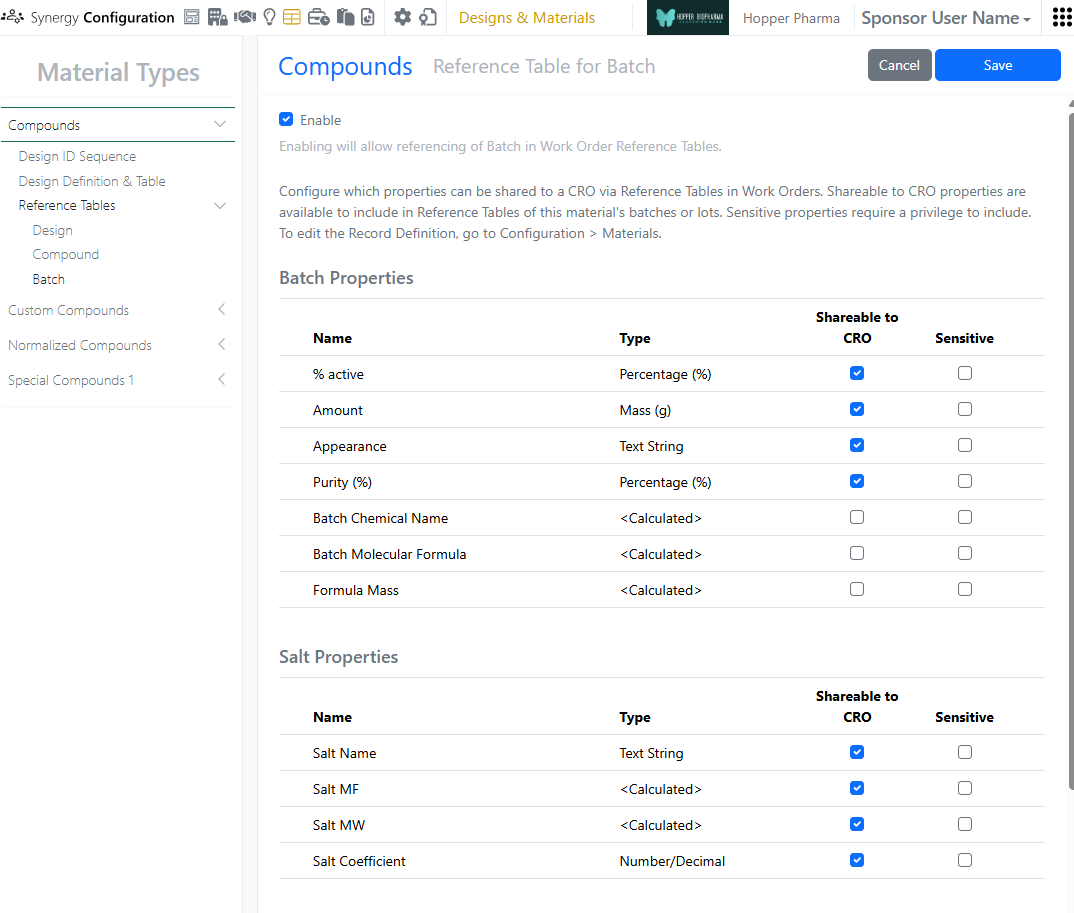
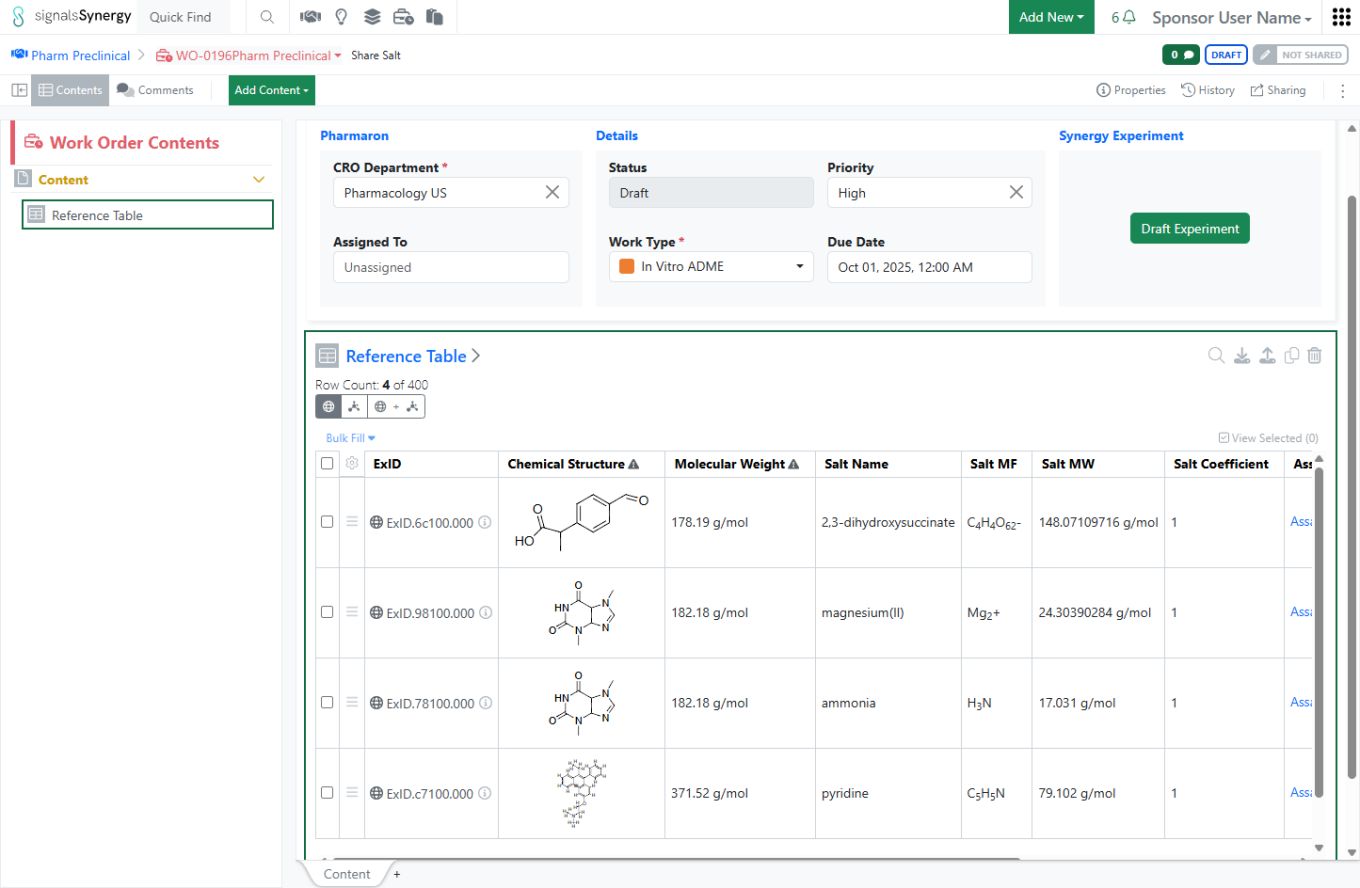
Salt information for a batch may be very important for a CRO to know when running an assay or analysis. Thus, Salt information can now be configured as Shareable to CRO in batch Reference Tables for Material libraries of type Compounds. When set to Shareable to CRO, a Sponsor can include the primary (first) Salt Name, MF, MW, and Coefficient in a batch Reference Table for a CRO Work Order.
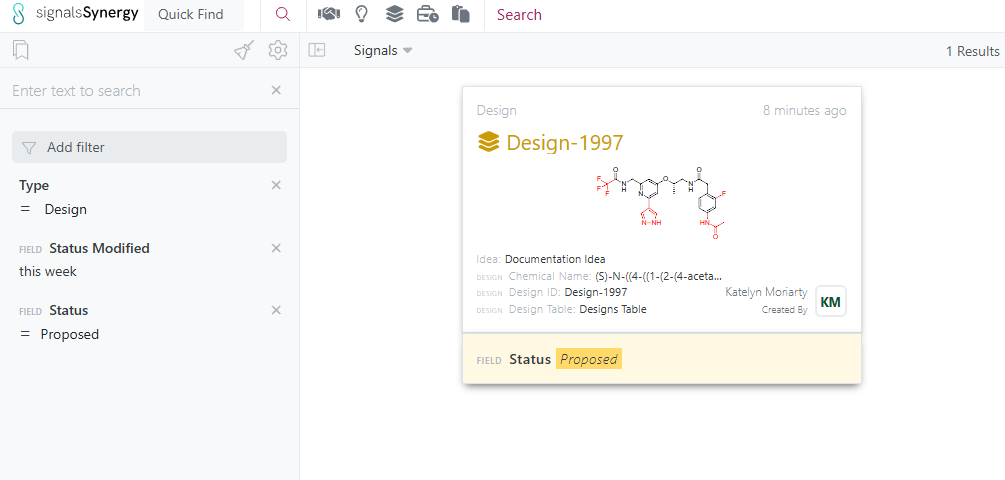

When searching for Work Orders or Designs, it may be useful to search for those that recently changed Statuses. For example, which Work Orders were recently transitioned or which Designs were Proposed or Sent in the last week. Status Modified is a new properties on Work Orders and Designs available in Advanced Search and Smart Folder filters.

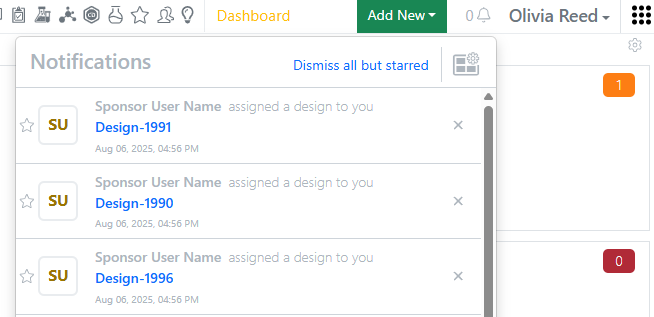
Finally, internal users and user groups now receive a notification (if configured) when a Design is assigned to them.
Chemistry
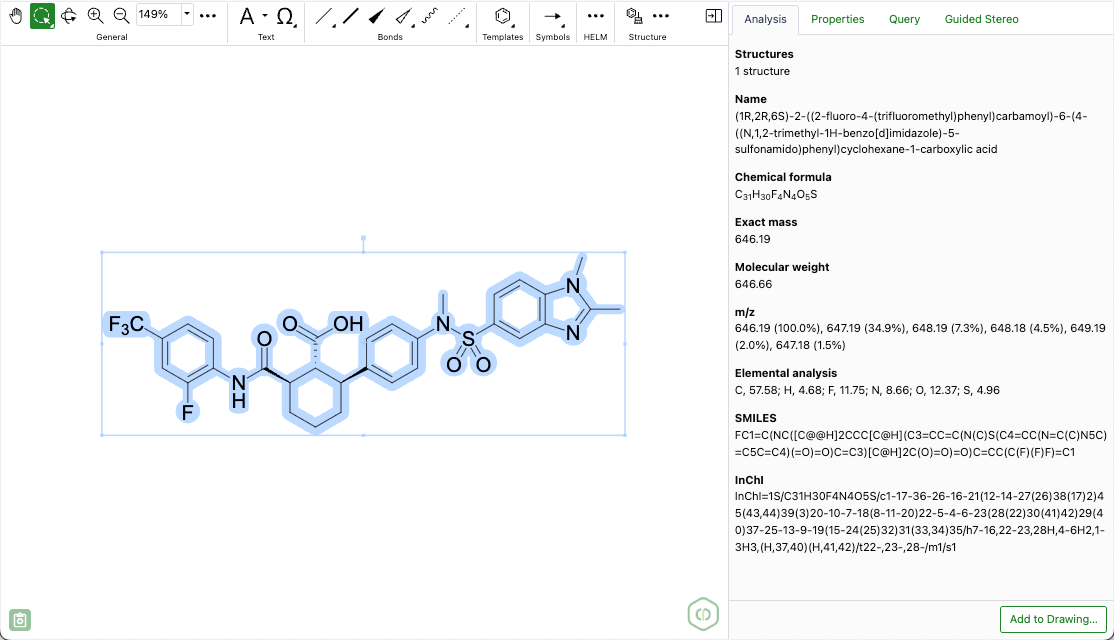
A new 'Analysis' panel in the ChemDraw editor now displays basic chemical properties for structures and biopolymers. These properties are context-sensitive, based on the selection on the canvas, and include information such as chemical name, molecular weight, molecular formula, and exact mass.
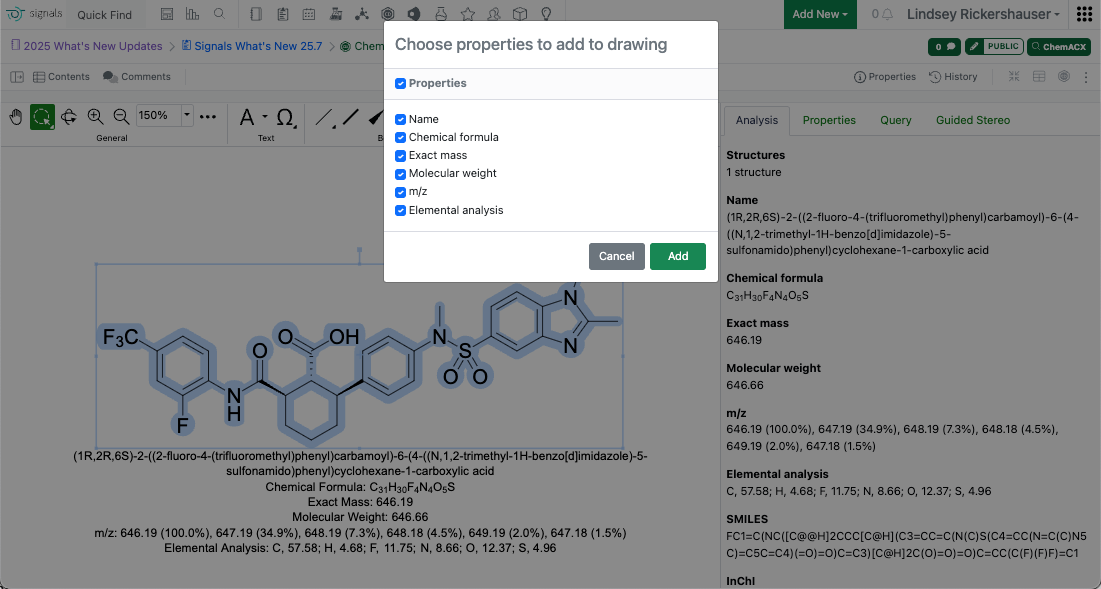
Specific properties from the Analysis Panel can be added directly to the ChemDraw canvas. Clicking the 'Add to Drawing' button at the bottom of the panel opens a window where properties can be selected and pasted onto the canvas.

Hydrogen bonded fragments in ChemDraw will now be recognized as a single structure with properties such as molecular weight, molecular formula and exact mass being calculated accordingly.
Admin Defined Tables & Variation Tables
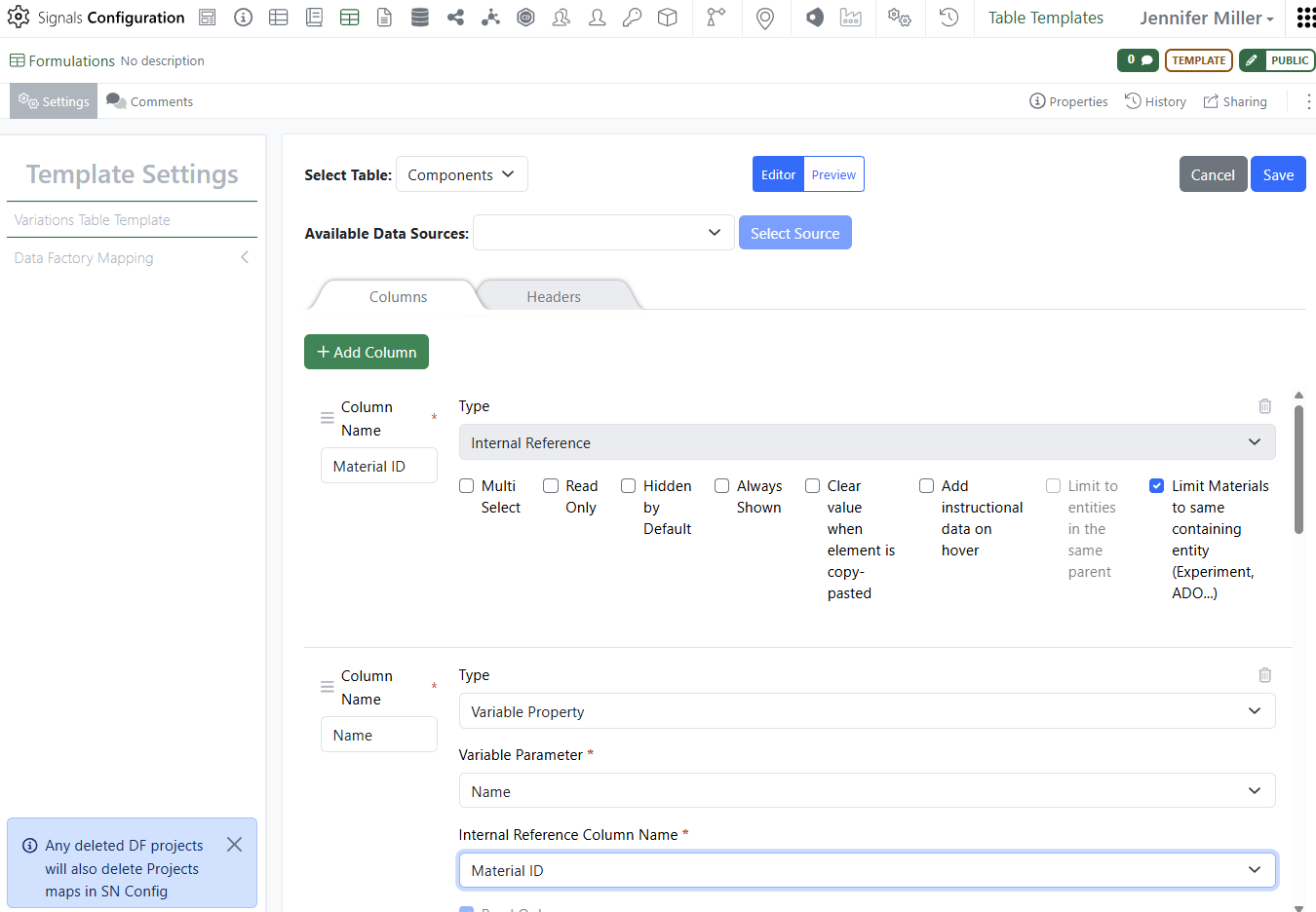
Update to Material selection from experiment to include Name in Variation Table. Administrators will need to add the Material Name field and set it to be of type Variable Property. They will then be able to select the Name for the Variable Parameter and set the Material ID as the Internal Reference Column Name:
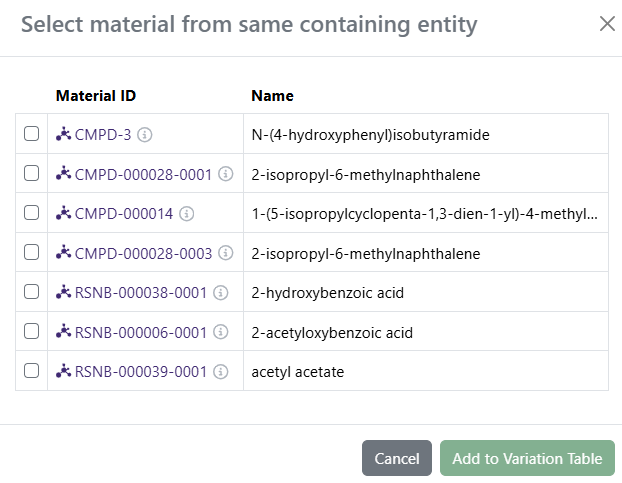
This allows the user when selecting material for the components in the Variation Table, to populate the Name (Chemical or otherwise) at the same time as the Material ID:
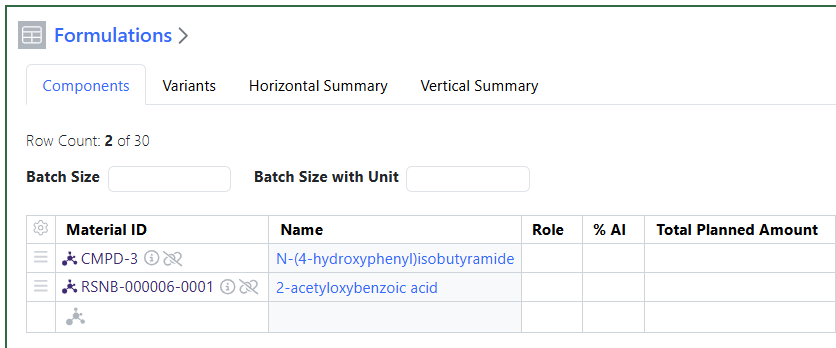
The user will see both columns fill in with data automatically:
Samples
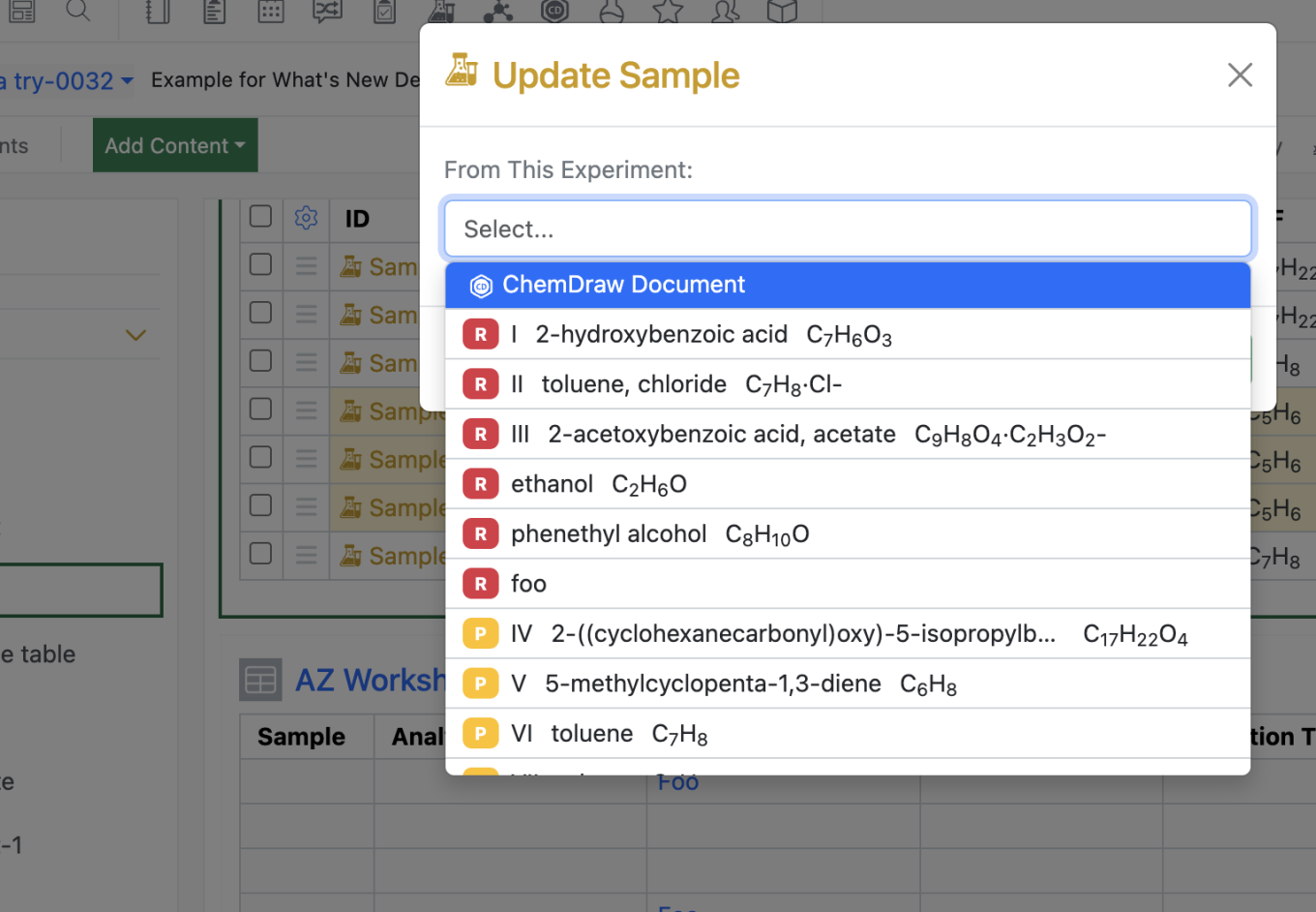
To aid users in selecting the correct structure during the sample update process, we now include the Reaction ID in the sample update modal.
Plates
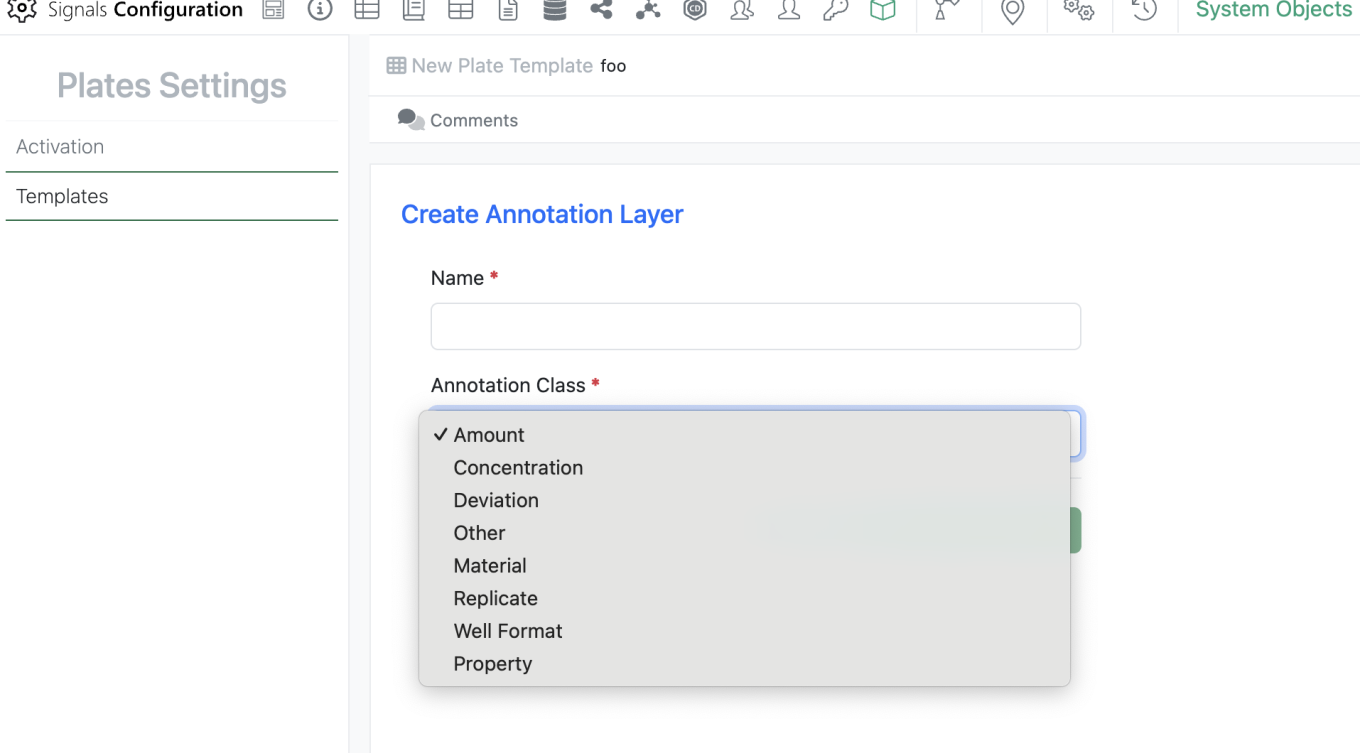
Users can now add a new Annotation layer type, Property. Annotation layers of type Property are collected in a properties tab on the plate and have a single value for every well in the plate.
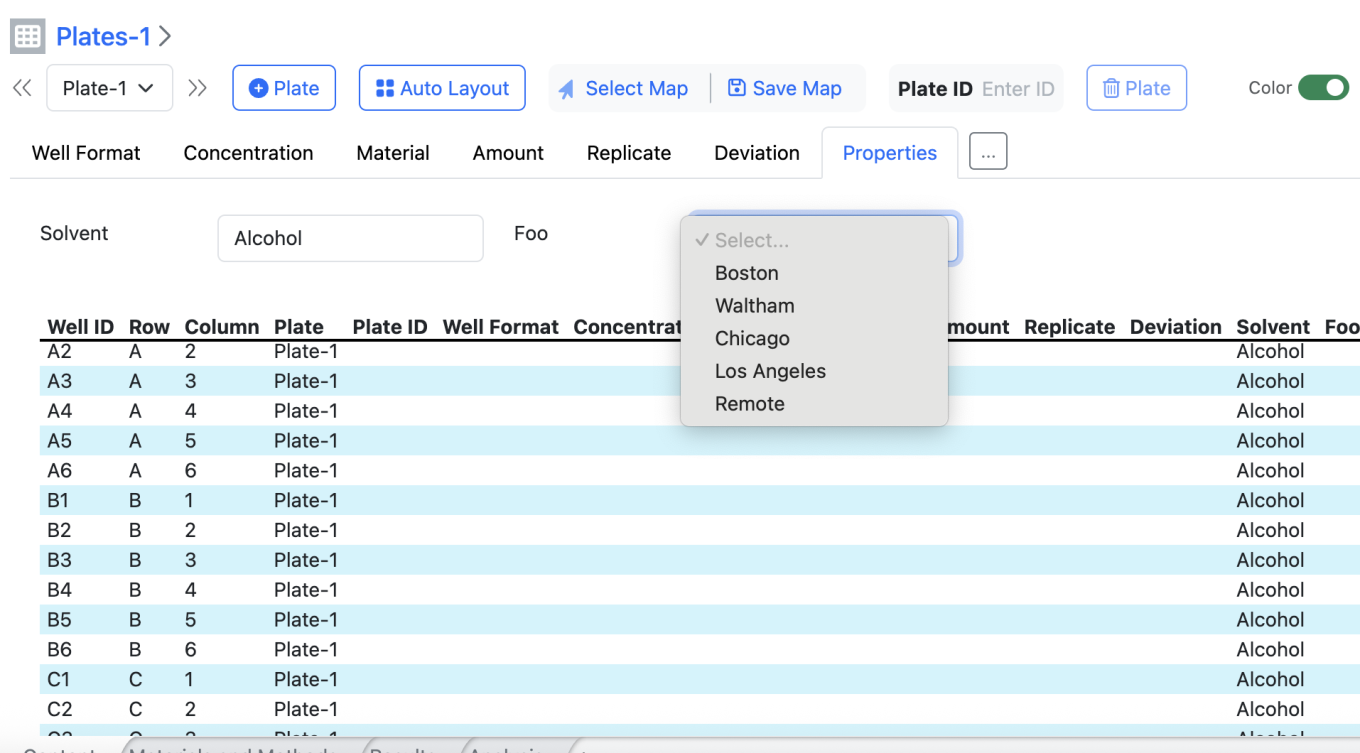
Admins can add Property Annotation layers to plate templates as is currently done with other annotation layers. When end users fill in a value in a property, the value populates for every well in the plate table
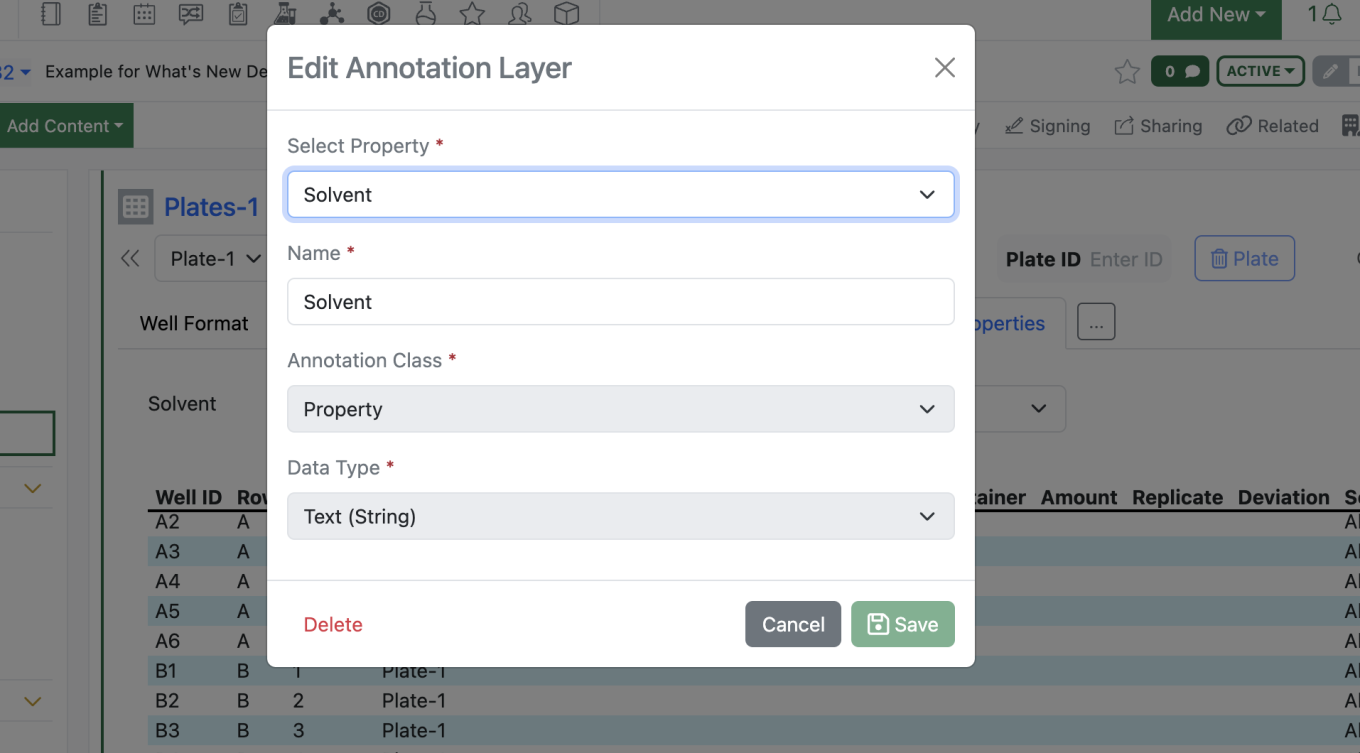
Users can hide or edit the names of the property type annotation layers.
Inventory
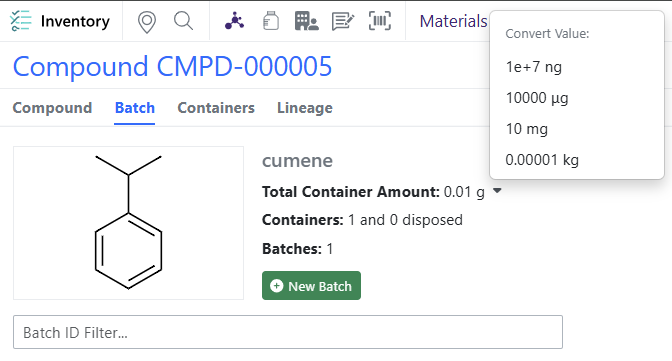
Exponential notation update on Container Amount on Batch/Lots. Scientific notation will appear only after 5 digits (ex: mg in the screenshot)
Materials
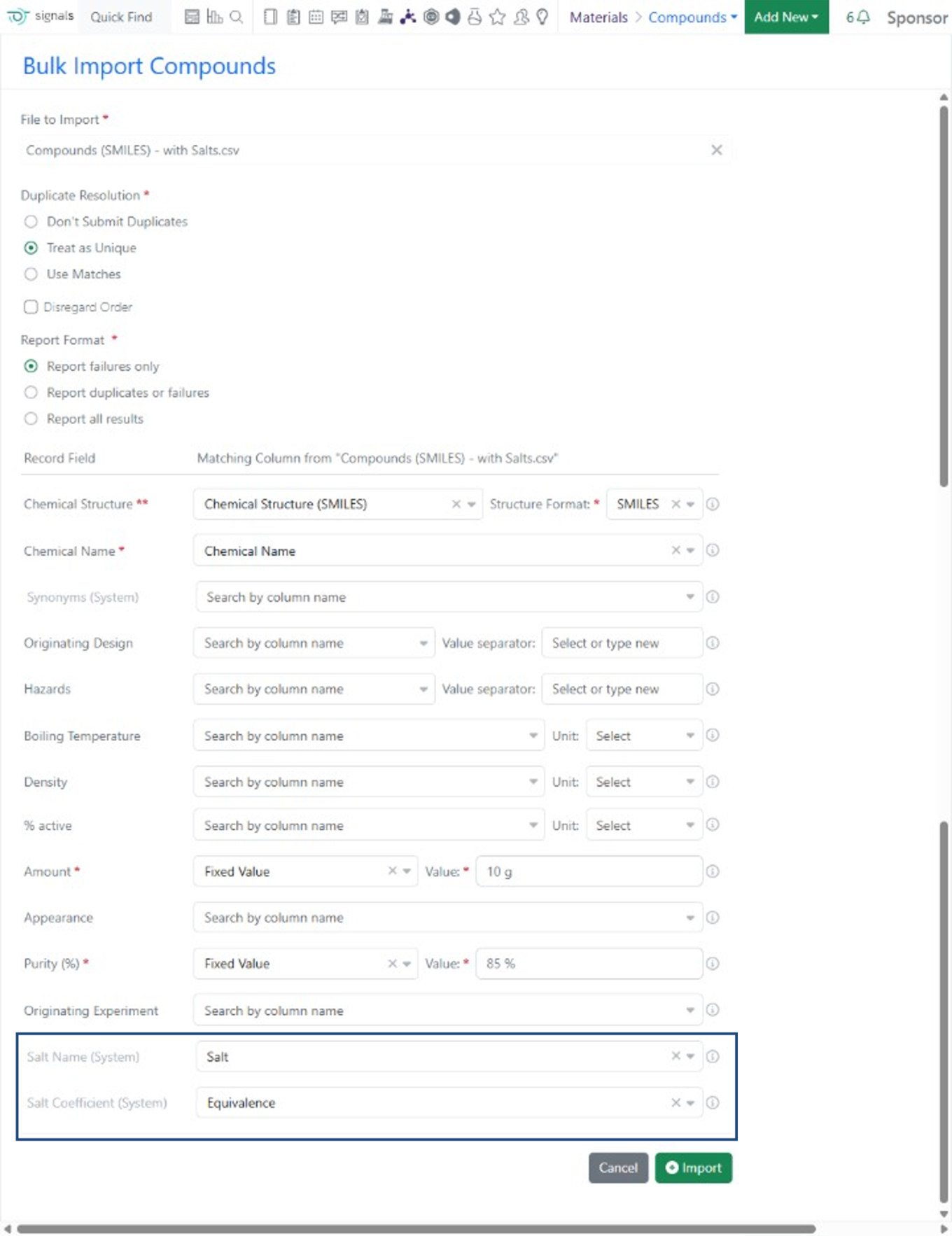
For Materials libraries of type Compounds, Salts can now be included during Bulk Import. Salt Name and Coefficient can be matched to columns in an SD or CSV file. The Salt Name must match an existing system salt (Signals Configuration > System Settings > Salts and Solvates) and only one salt per compound batch is supported.

The ‘dd-MM-yyyy’ format (e.g. ’15-02-2019’) is now available as a Date Format option during bulk importing of materials.
Integrations & APIs

We have updated our Synergy API to support recalling of Work Orders.
PUT /synergy/workOrders/{workOrderId}/status now supports the “recall” action. A Work Order must be in the To-Do state for this action to succeed.

We have added new APIs to move a sub-location to a new parent location. This is an asynchronous API that follows our standard pattern of Begin Move Job, Check Status of Move and Download Report of Move. Only location that include the “movable” system property and have it enabled will be able to move to new parent locations.

We have also added a new API to register a new material from a material table. The table must be configured to allow for material registration in System Configuration. The row being registered as a new material must have all required data for the material to successfully register.
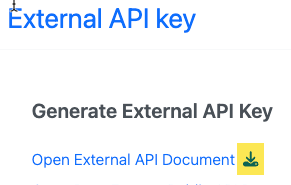
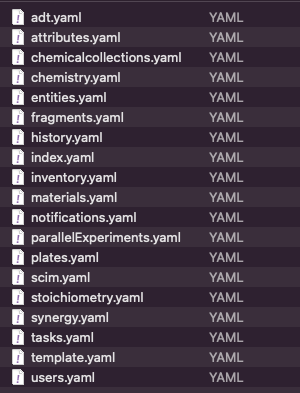
We have also added a method to download all the YAML files which back our Notebook Swagger page via Signals Configuration. This is to make it convenient to access these files for usage with SDK generation tools. They were tested with OpenAPI Generator.
Further Details
The following capabilities are in beta and are available for users, administrators and developers on the Signals platform upon request. Please contact your account representative or our support team if you would like access to the following features.
AI
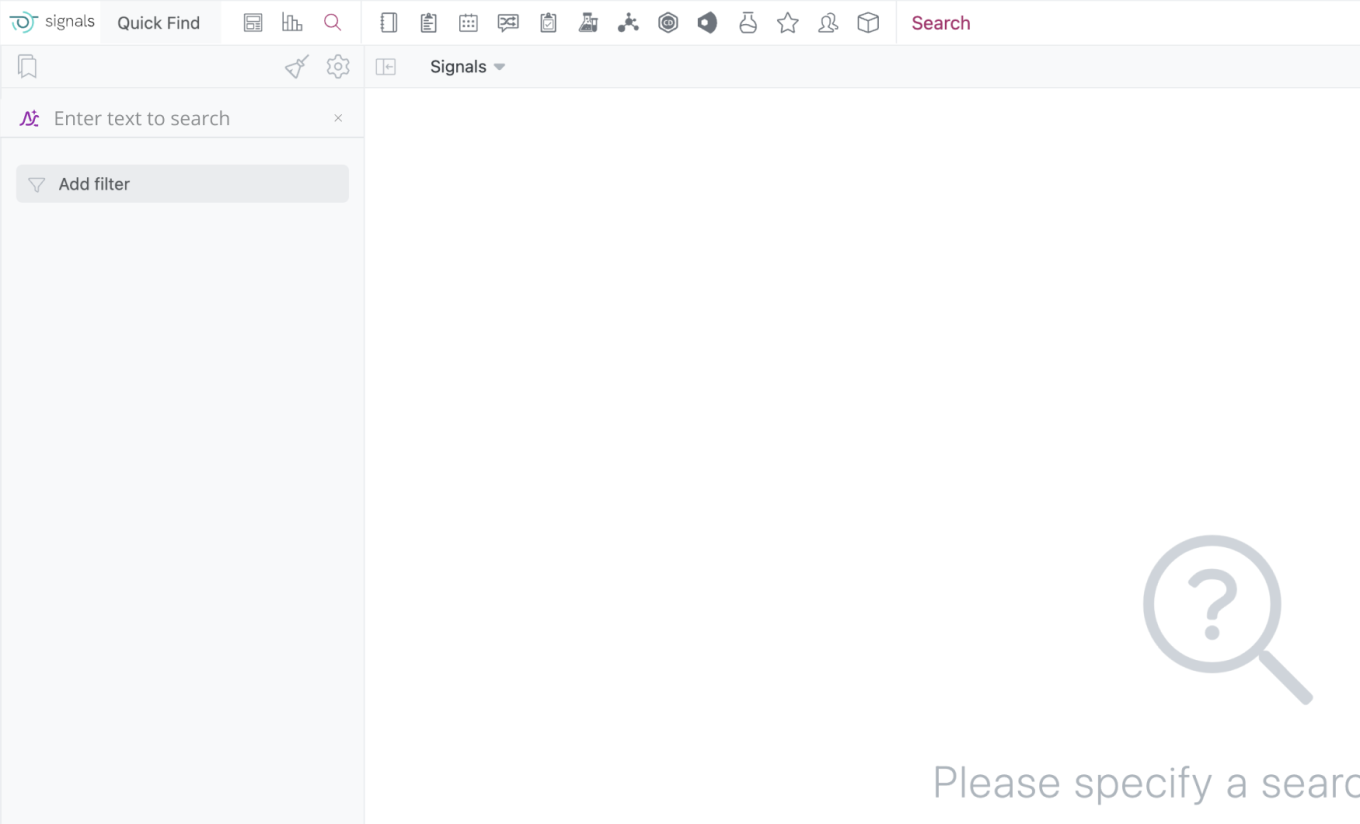
Users with a Signals One license will now have access to the new Semantic Search. Semantic search is an AI-powered method of searching that focuses on understanding the meaning and context of a user's query, rather than just matching keywords. It leverages Natural Language Processing (NLP) and Machine Learning (ML) to interpret the user's intent and deliver more relevant search results.
To enable Semantic Search users just need to click the Sematic Search icon to enable semantic search.
Data Workflows & Analytics

For tenants with a Signals One license, users will now be able to perform In Vitro (screening, assays) data analysis, visualization and results quality control. The first curve fitting method available, is the logistic 4 Parameter (4P) fit.
The first rows of data assembled from multiple sources (instruments data, plates, external lookup tables,…) can now be previewed in the Data Assembly.
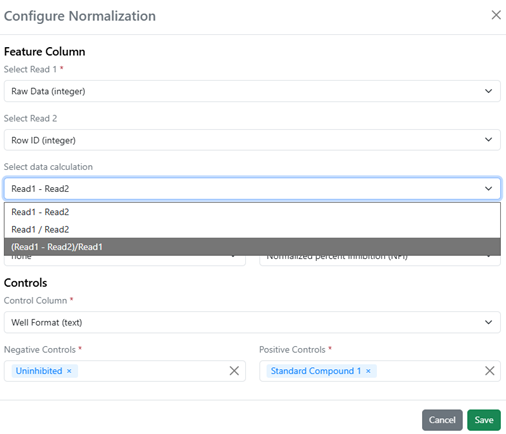
The Preview highlights the columns used for matching and the columns added to the instrument data. A column first added before being used for matching will have the column header highlighted as “Matched” and the content rows as “Added”. The Preview appears upon assembling the data when pressing the “Assemble” button.
Calculations can be applied when analyzing two instrument readouts in Vitro Analysis. Two instrument readouts can now be used (Read 1 and 2) and combined using a predefined calculation.

When user changes like exclusions or settings modification take place in the analytics steps, each step can be recalculated independently from the other steps using the new “Recalculate” button.
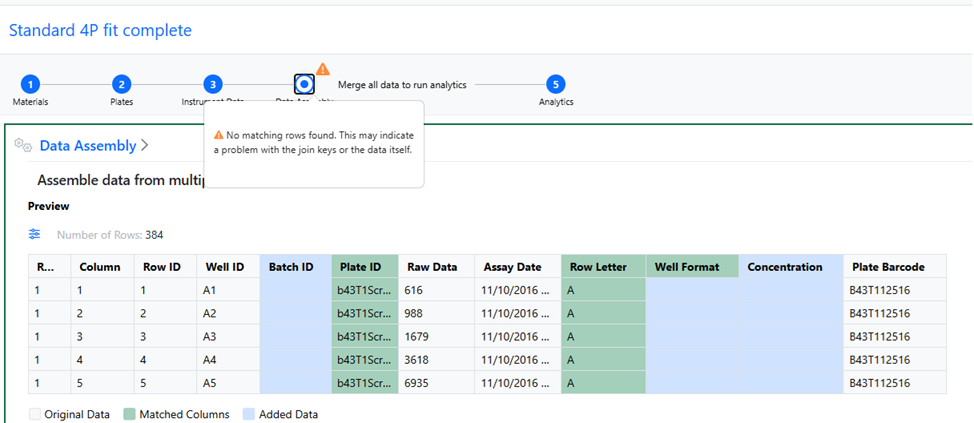
When the next step in the analytics is impacted, the recalculated button of the downstream step is enabled and the user notified that the steps are out of sync (e.g. normalization changes that impact curve fitting).
When potential problems are detected, warnings become visible in the user interface to help users identify early on the sources of problems.
In this example, the matching of two columns returns no rows, which is an indication of a wrong selection of columns to match.
SAR & Decisioning
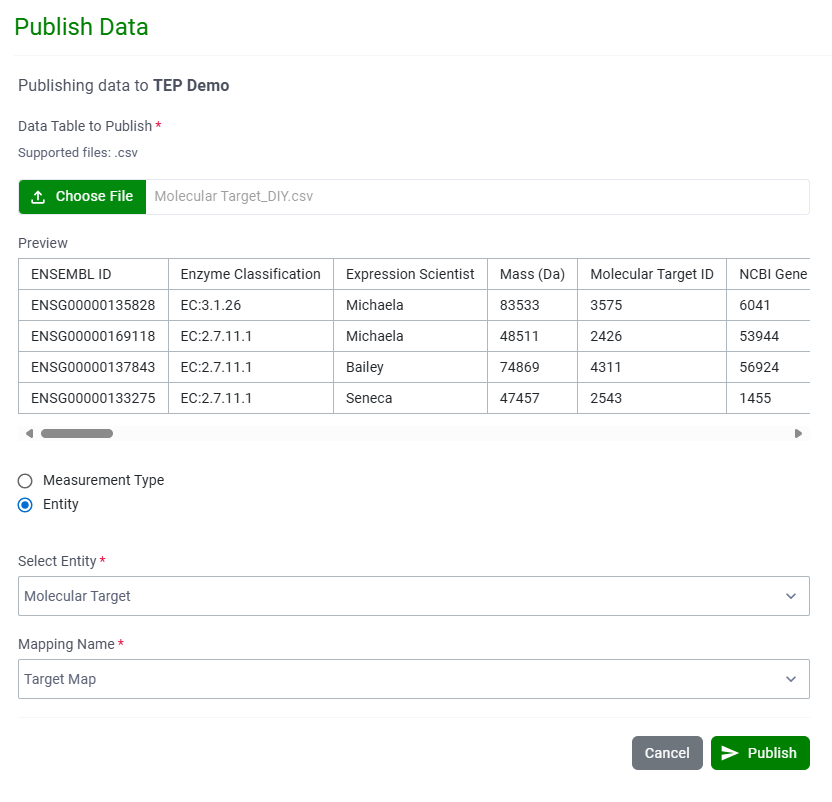
Custom Entity data can now be published directly to Data Factory projects (beta version) from the Inventa Dashboard.
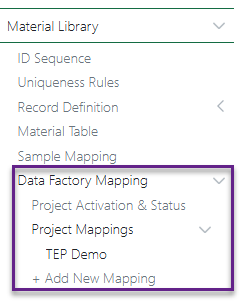
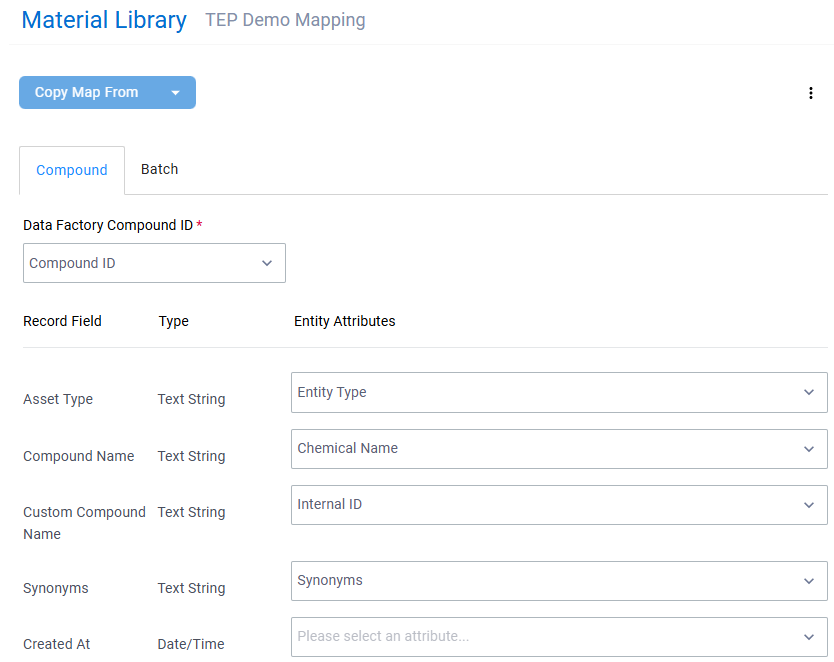
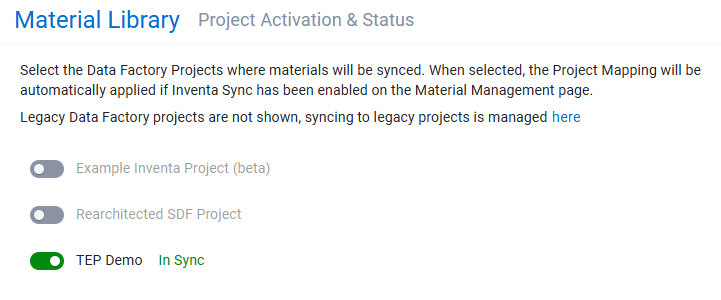
Inventa Sync now supports Data Factory projects (beta version). Map material libraries to projects using the new Data Factory Mapping section (accessible from the Material Management page), then activate sync on a per-project basis though the Project Activation and Status section.
Inventory
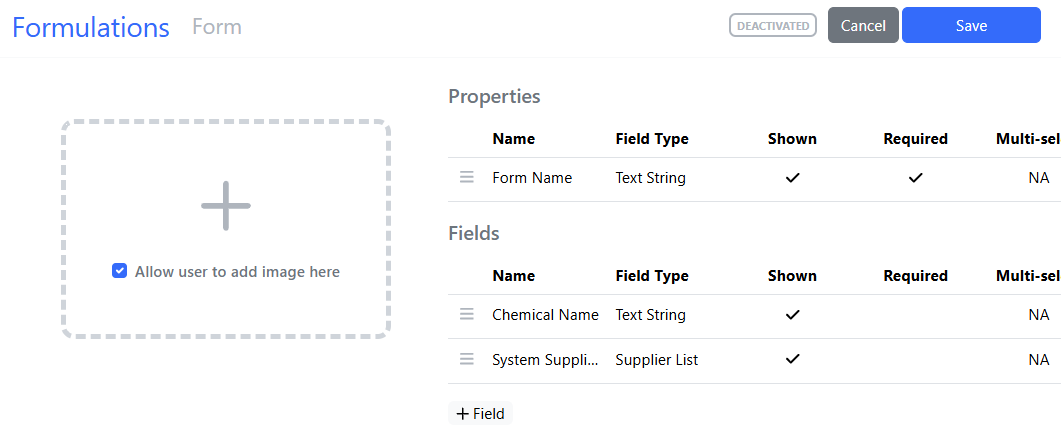
System Supplier List available in Material Library. Administrators can now add the System Supplier List to the Materials Library at both the asset level:
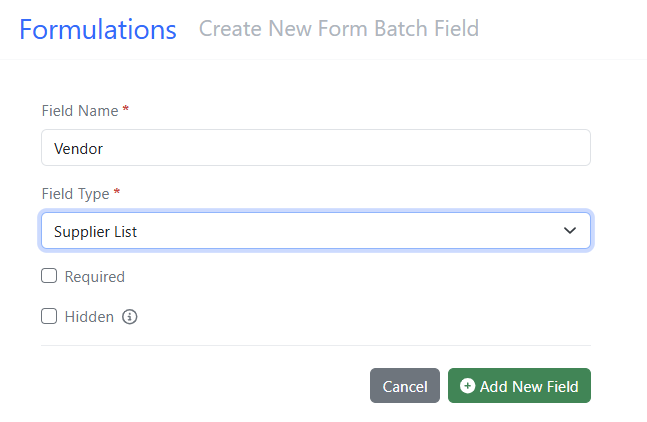
And the batch/lot level:

Multiple Fields can be associated with the System Supplier List and can be added to the Materials Table:

Users will see the fields in the Materials Table when they add them to an Experiment/ADO:
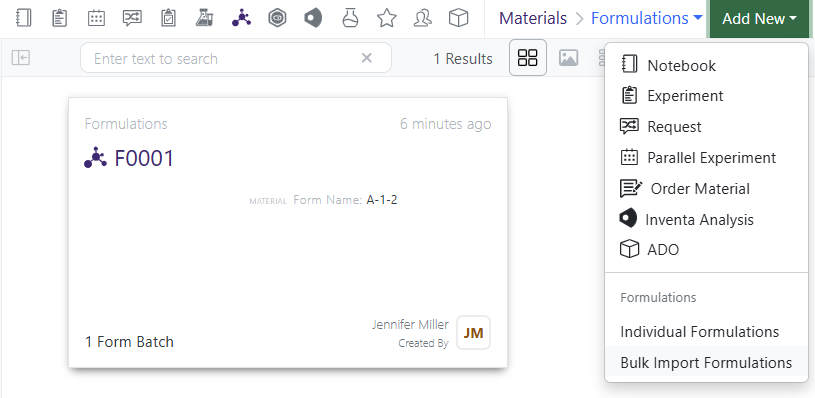
Bulk Import to a Materials Library supports the System Supplier List field type:
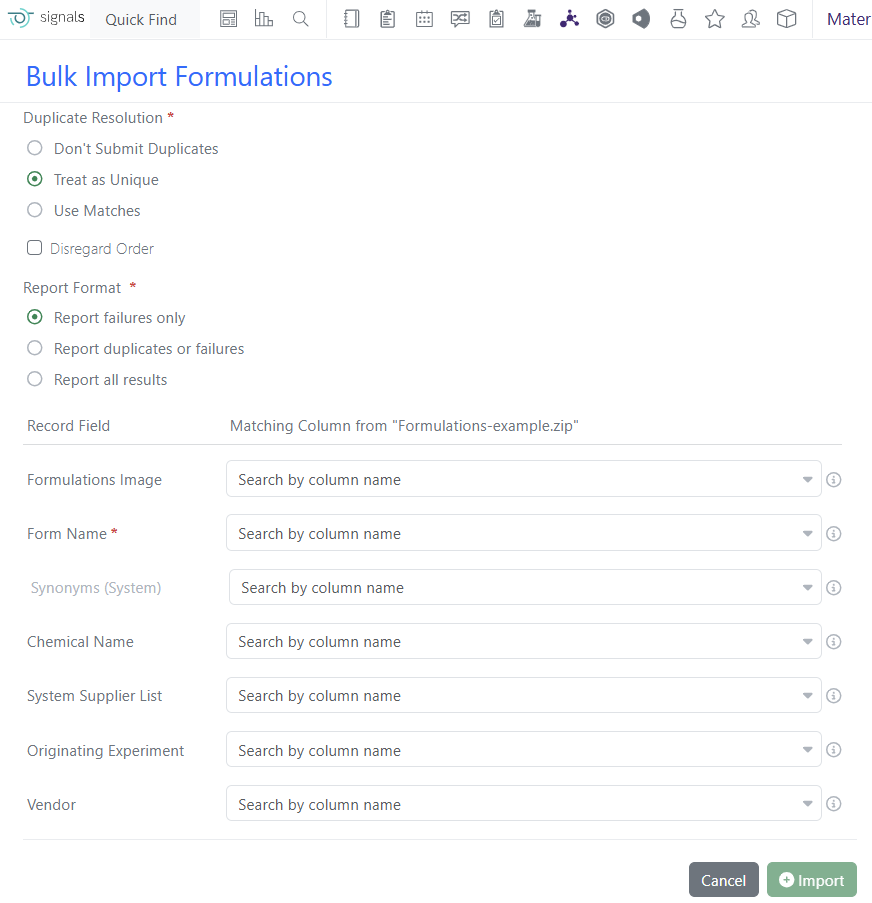
The mapping import screen as well as the example file supports the System Supplier List field:
What's New
We are delighted to release our new version of Signals, 25.6. This release brings enhancements in audit trials, Synergy, Inventory, Variation Tables and Inventa amongst others. We have a new beta capabilities of an In Vitro Analysis object, and extended beta capabilities around publishing results to Data Factory. The beta capabilities around Internal Data Sources in Text Elements are now available to all systems. Finally, we have also fixed a number of small bugs.
The following improvements are available for users, administrators and developers on the Signals platform. Certain features may only be available with appropriate licensing and/or with enablement by an administrator.
- Fundamentals
–Audit trail captures the initial state of content upon copying a system template, experiment, or personal template
- AI
–Schema Updates to support SDK Generation
- Data Workflows & Analytics
–In Vitro Analysis (beta) - SAR &Decisioning
–Internal References support in Inventa Analyses
–Integrated Summary App supports “Is Any Of” for numeric attributes
–Automapping improvements in Publish Results to Data Factory app (beta)
- Synergy
–Support for Normalized Compounds in Synergy Designs and Reference Tables
–Duplicate check Designs against both Designs and Materials of the same material type
–Search and filter Designs by Assigned CRO
–Capture Design ID on Reactants, Products, and Samples created from Designs
–Synergy Experiment properties can be configured to inherit from Collaboration properties
–Share Synergy Experiment Templates to CRO Department(s)
–Append Template to Synergy Experiments for CRO users
–Configuration Transfer support for Reference Table definitions
–Publish Admin Defined Tables from Synergy Experiments to Inventa – available to all systems”
- Chemistry
–Show/hide residue IDs of biopolymers
–Auto-pair tool now accepts RNA/DNA strands with pendant Chem or peptide monomers
–Enhanced selection behavior for atoms, bonds and structures
–Attach Data can now be added as chemically significant
- Admin Defined Tables & Variation Tables
–Include Component Headers in Variant Calculations
–Update to Publish Variation Table to support variable measures in headers and columns
–Variation Table Vertical View update for variant hidden rows
- Samples
–Moles calculation in Samples utilizing Radioactivity
- Plates
–Addition of Mass (g) to Amount Annotation Layer in Plates
- Inventory
–New label
–Update to Internal Request workflow to include Material ID of registered Samples
- Materials
–Bulk import with multipart GenPept and Swiss-Prot files
- Administration
–Spotfire for Signals Access Workflows privilege available
–Internal Data Sources now available in Autotext available to all systems
–IDS checkbox to allow admin to specify which sources are available in text element
- Integrations & APIs
–API for Sequence pairing from two chemical drawings
–API enhanced to export plates as CSV
–API to modify CRO users
–API to fetch CSV example for bulkImport
–API with additional criteria for Data extraction from SDF
We also fixed several small bugs in this release. Details of the enhancements are described below.
Data Factory Administrators should be aware that the maximum number of measurement attributes has been increased to 7000
Data Factory Administrators should be aware that Dataset warnings are now presented in reverse-chronological order (up to 100)
Data Factory Administrators should be aware that the primary API GET /job-service/job has been deleted
Administrators are recommended to subscribe to the channels within our support news site found at https://support.revvitysignals.com/hc/en-us/categories/360004446171-Support-News which contains more information about releases and other pertinent product information.
This content is anticipated for release on our Production E3 environments, and for Private Cloud customers on our deferred release schedule, in November 2025.
Further Details
The following improvements are available for users, administrators and developers on the Signals platform. Certain features may only be available with appropriate licensing and/or with enablement by an administrator.
Fundamentals


The audit trail now captures the initial state of content when copying a system template, experiment, or personal template. When content is copied, the audit trail logs both 'created' and 'edited' records showing the previous version with the initial content. This enhancement applies only to newly created content and is not retroactive.
AI
The Swagger page for Notebook APIs has been enhanced with better Schema information for API responses. This is in preparation for providing access to YAML files to facilitate SDK Generation through OpenAPI tools.
SAR & Decisioning
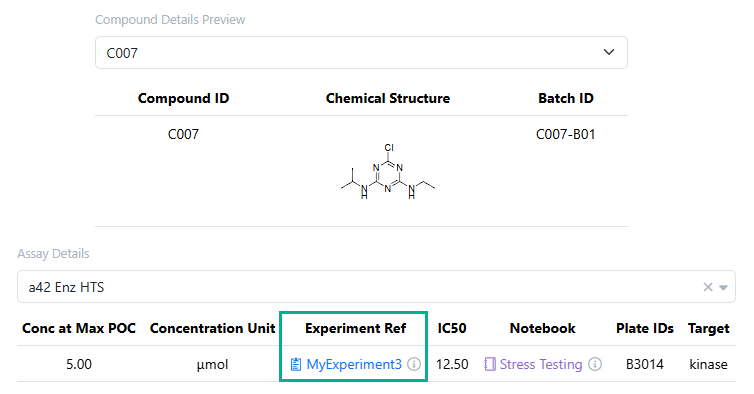
The Assay Details preview section of Inventa Analyses now supports the display of internal references

Integrated Summary App support “Is Any Of” for numeric attributes, allowing users to search for a set of numeric criteria.
Synergy
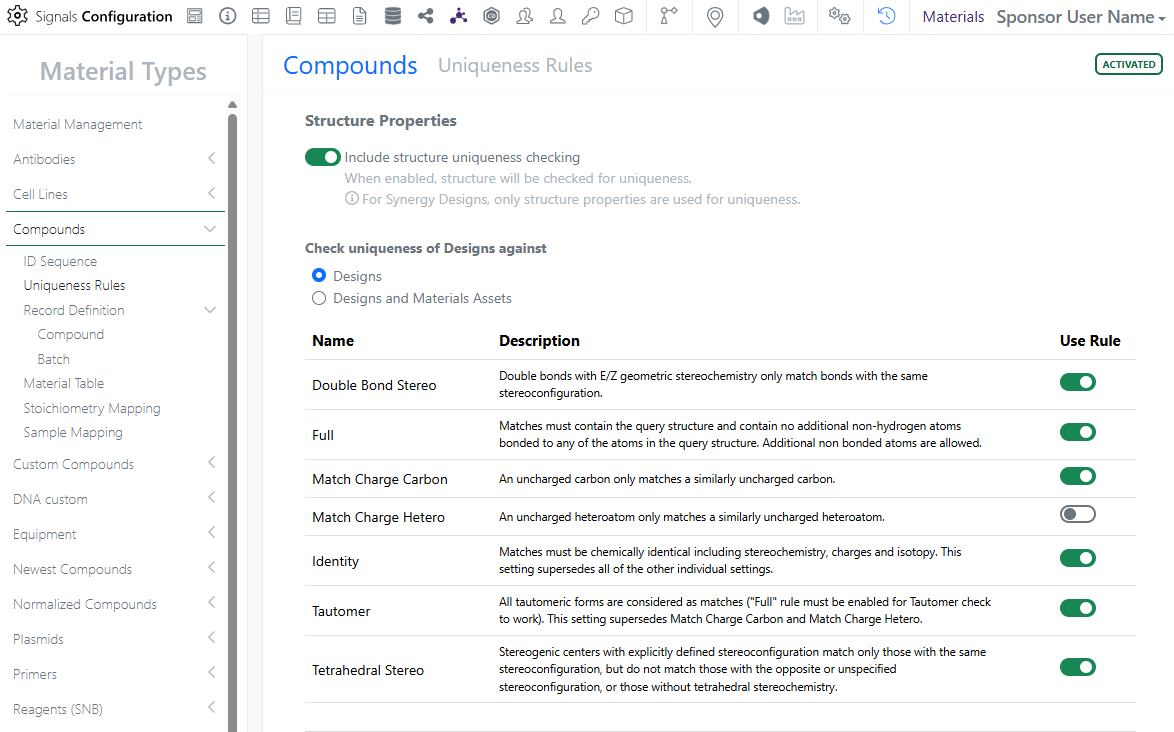
Normalized Compounds are now supported in Synergy for both Designs and Reference Tables. The Normalized Compounds libraries facilitate the registration of materials with a salt-stripped structure as an asset, while still retaining the original raw structure for the batches associated with that asset. Salt stripping is valuable when working with CROs that deliver compounds. To enable a material library of type Normalized Compounds, activate the library for Synergy in Signals Configuration and then configure Designs and Reference Tables in Synergy Configuration.
Release 25.6 also brings several new features in Synergy related to Designs. First, when creating or importing Designs, Designs can be checked for uniqueness against Designs only or Designs and Material Assets of the same Material type. The Administrator can change this setting under the Uniqueness Rules for each Material type in Signals Configuration.
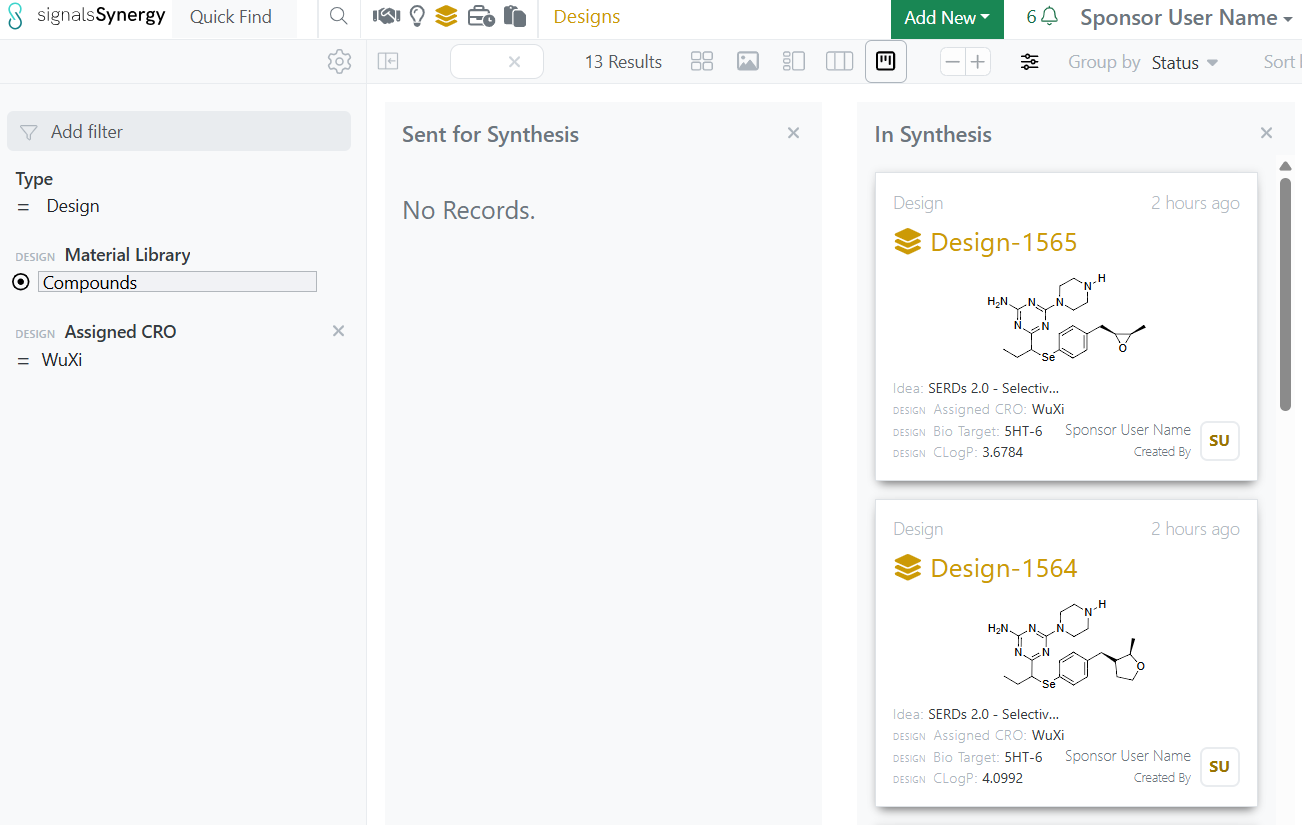
Designs have a new property called Assigned CRO. Assigned CRO is automatically captured when a Design is added to a Work Order for a CRO. Designs can be searched and filtered by Assigned CRO in both Advanced Search.
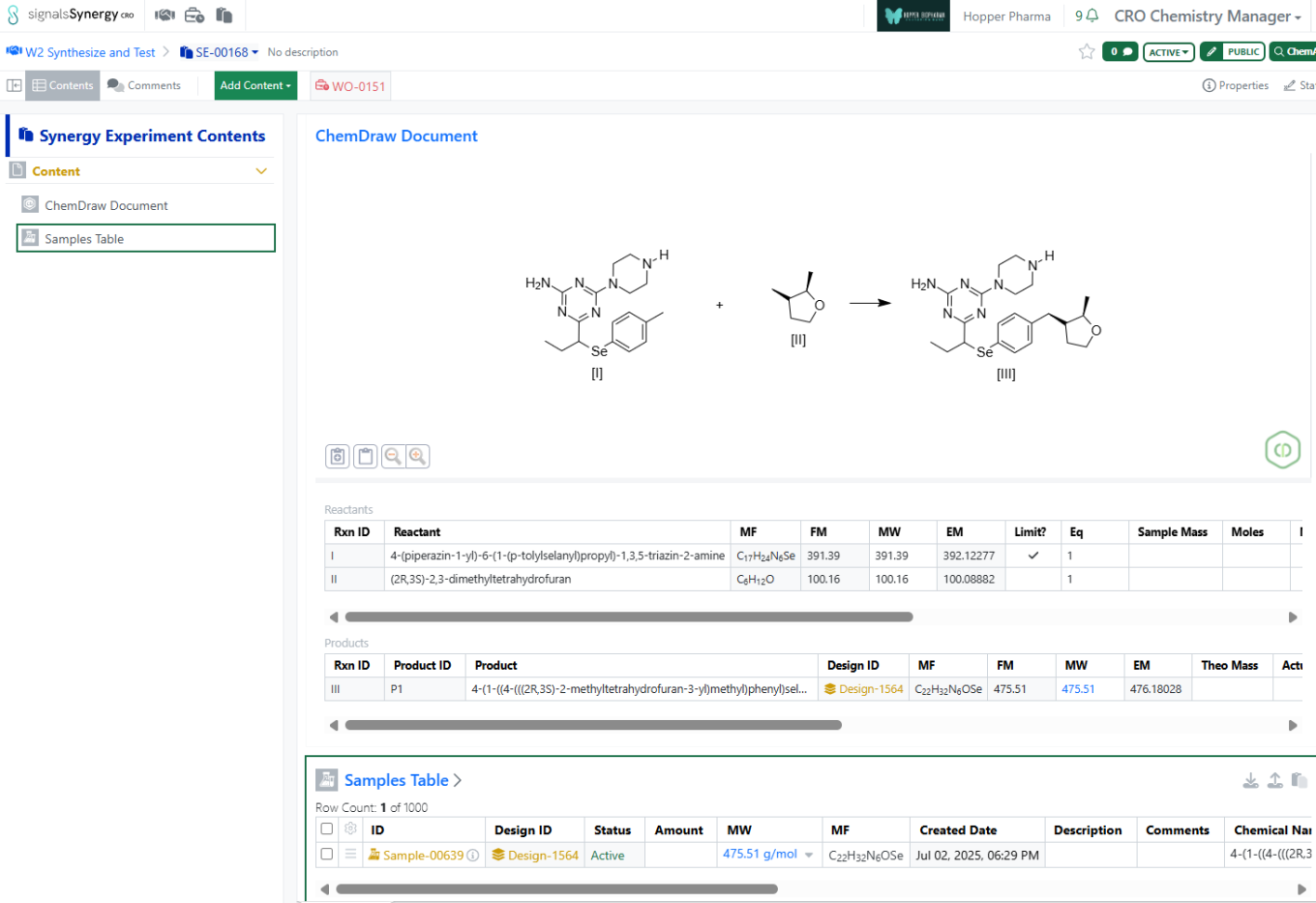
When a CRO user or Sponsor user adds a Design to a Chemical Drawing as a Product or Reactant, the Design ID is captured in the Design ID property in the stoichiometry grid. The Design ID is propagated to subsequently created Samples. If the Sample is then registered, the Originating Design will be added to the Material and the Design status updated to Synthesis Complete. If the Design is added as a Product, the Design ID is also added to the Reference from W.O. property of the Synergy Experiment for ease of search for related Synergy Experiments.
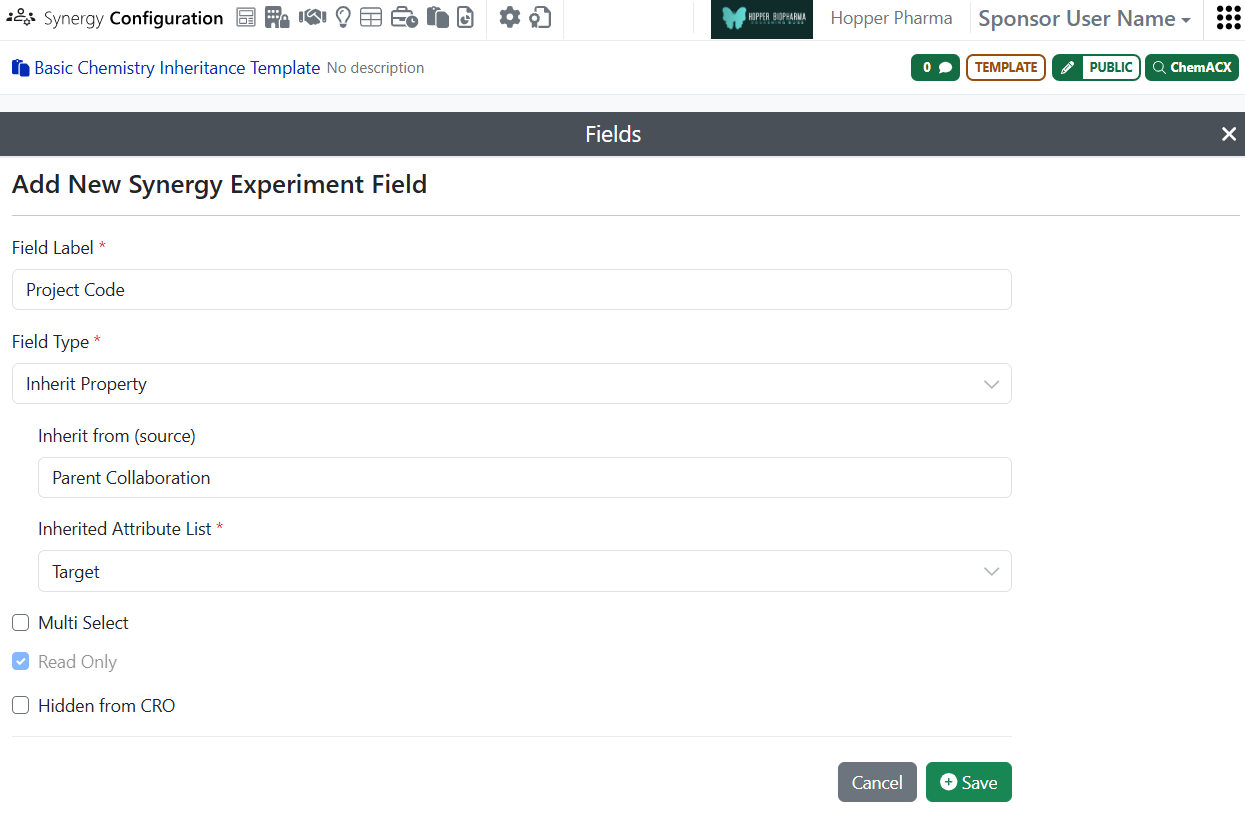
Synergy Experiment Template attribute list fields can be configured to inherit the property from the parent Collaboration. If a field is set to inherit, the field will be automatically populated with the corresponding value from the parent Collaboration on the Draft Synergy Experiment and all subsequent Synergy Experiments created by the CRO users. As a result, the Sponsor or CRO user does not have to repeatedly populate the same property, such as Project Code or Disease Target.
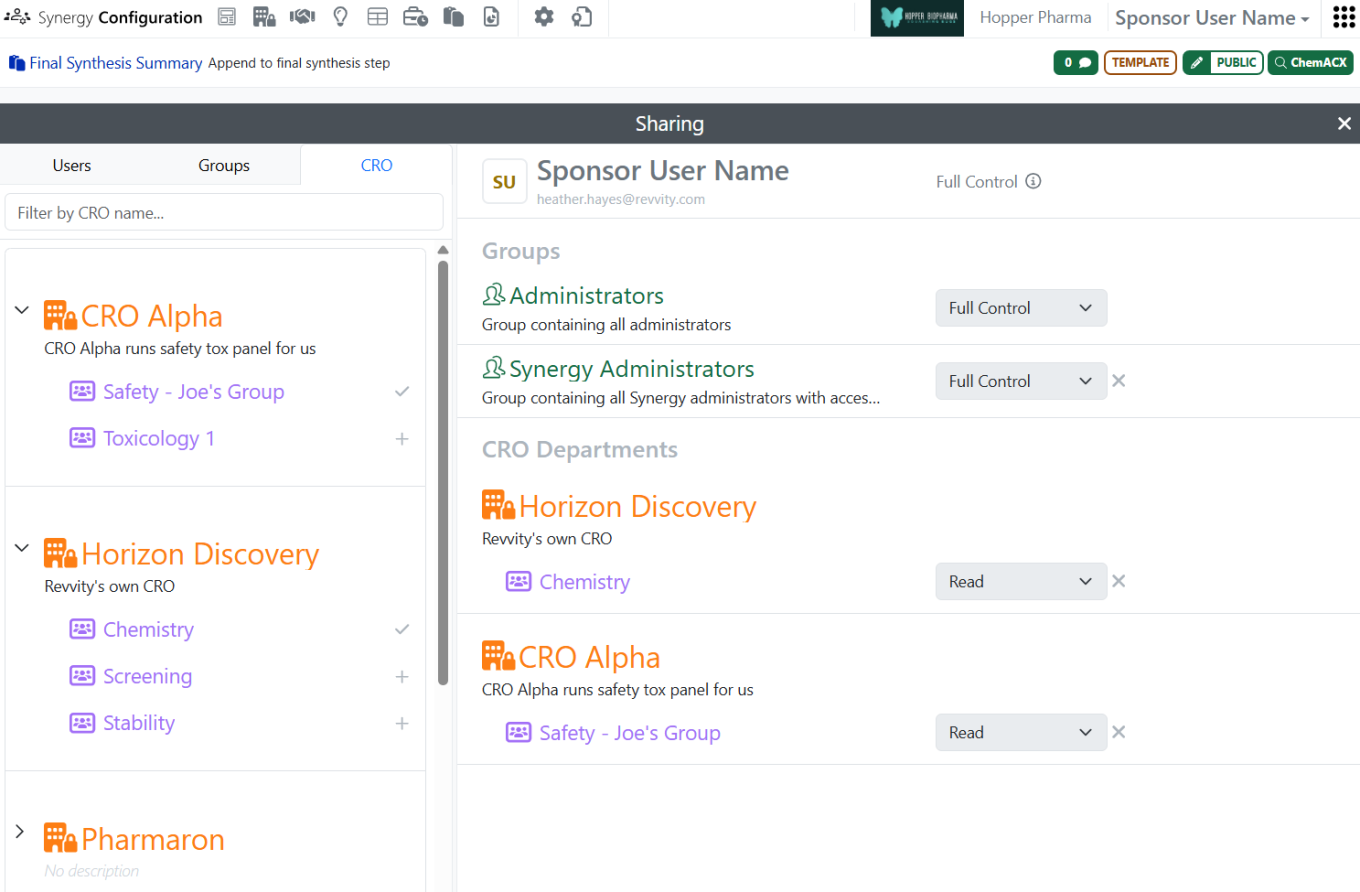
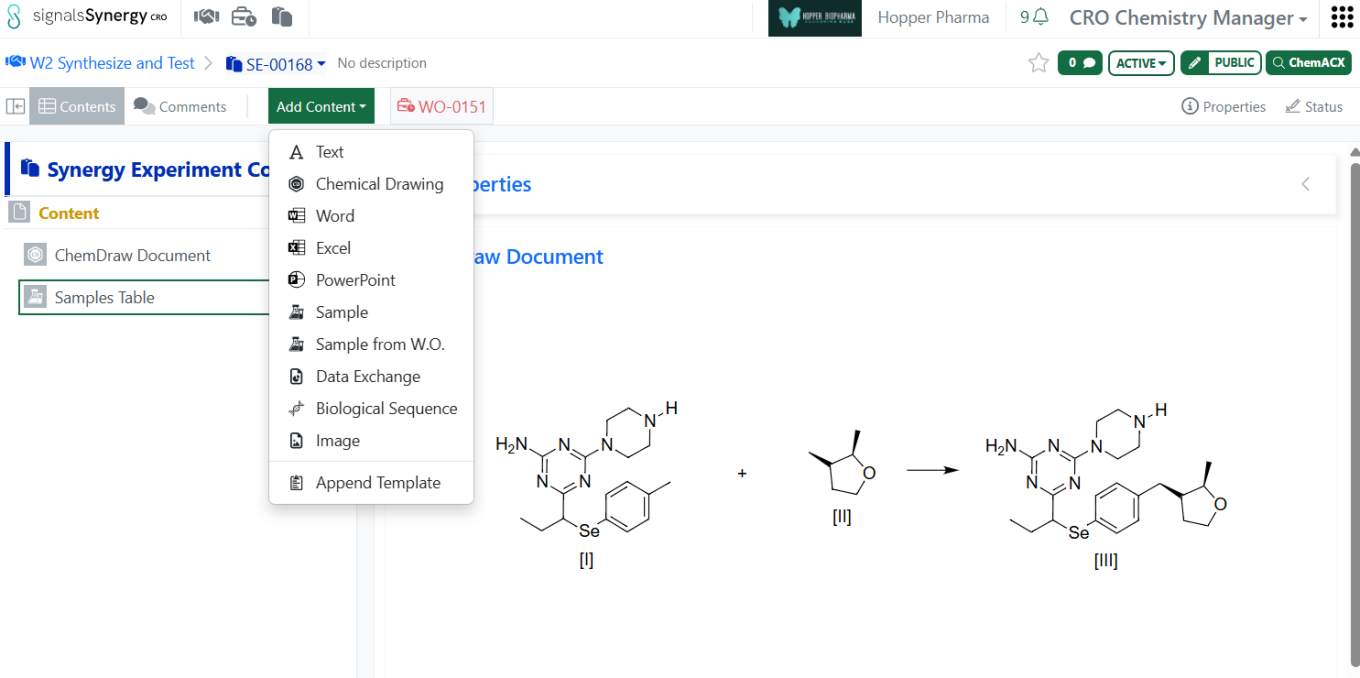
CRO users can now Append Template to a Synergy Experiment. This allows CRO users to add additional content for specific use cases. The Synergy Administrator can share Synergy Experiment Templates to CRO Department(s).
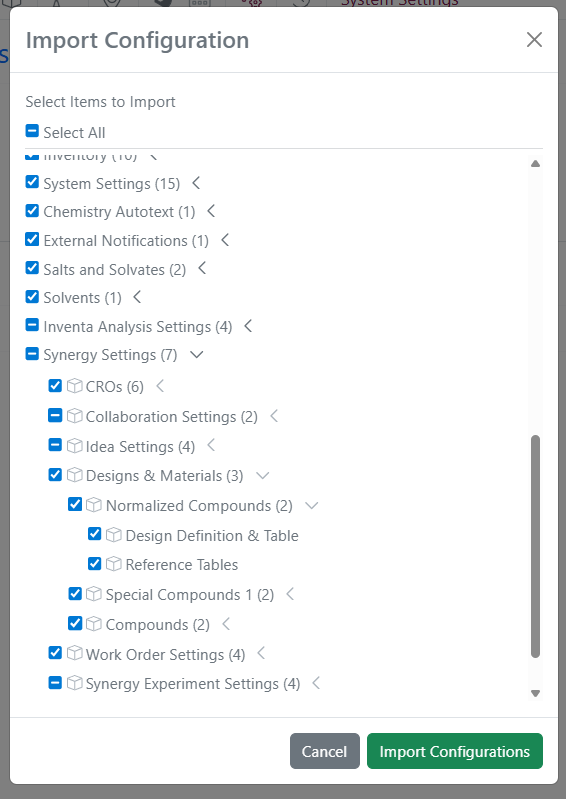
Finally, Configuration Transfer now supports the transfer of Reference Table configuration settings.

The ability to publish Admin Defined Tables (ADTs) to Data Factory from Synergy Experiments is now available to all systems. Similar to the publication functionality in internal Experiments. Properties of the Synergy Experiment, including those that are Hidden from CRO, and columns of the Tables can be mapped to measurement type attributes in a specified Data Factory project and published by the Sponsor user.
Chemistry

The auto-pair tool has been improved to work with a wider range of RNA and DNA strands. This enhancement allows strands that include additional Chem or peptide monomers when finding the complementarity between strands and placing hydrogen bonds between them.
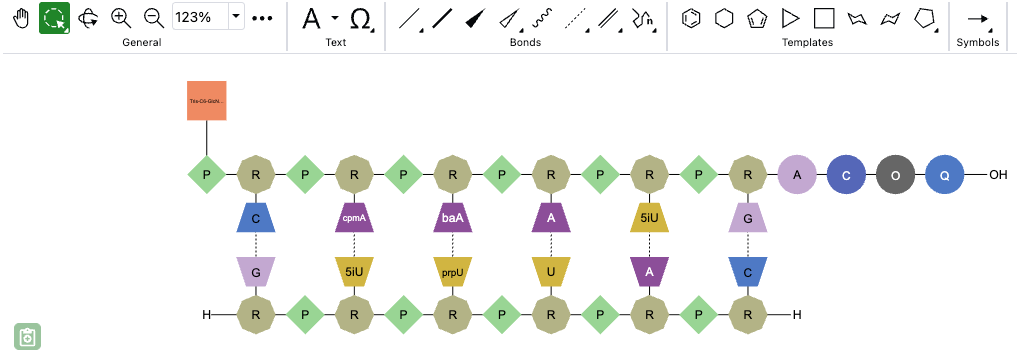
The auto-pair tool has been improved to work with a wider range of RNA and DNA strands. This enhancement allows strands that include additional Chem or peptide monomers when finding the complementarity between strands and placing hydrogen bonds between them.
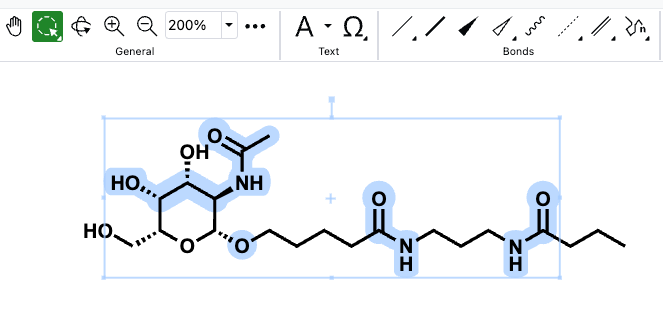
There is now enhanced visualization in ChemDraw when atoms, bonds and structures are selected on the canvas. ChemDraw now individually highlights all the atoms, bonds and structures that are part of the selection, in addition to the selection box that appears upon selection on the canvas. This provides a clear distinction between selected and unselected elements on the canvas.
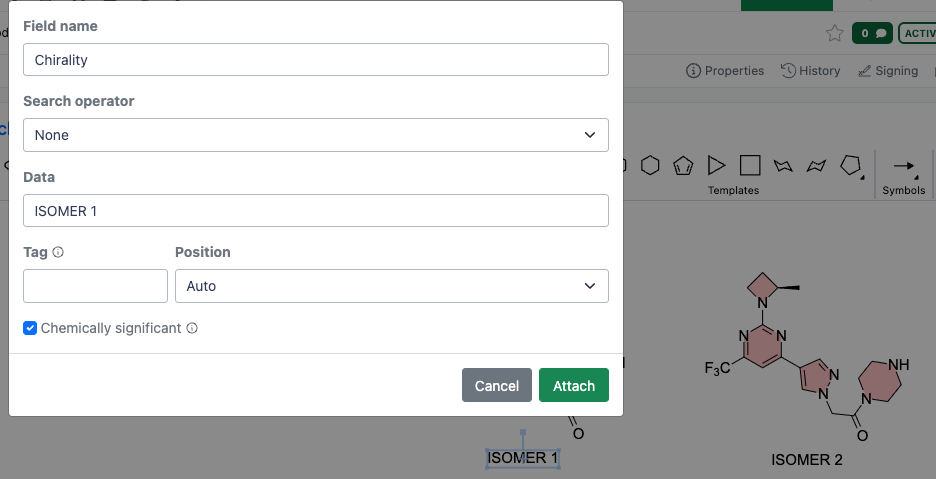
When annotating a molecule or stereocenter in ChemDraw using the 'Attach Data' capability, annotations can now be specified as 'chemically significant'. When this option is selected, annotations become chemically significant and are recognized and honored in chemical searches. Additionally, users can now edit existing annotations by selecting them and reopening the 'Attach Data' dialog in ChemDraw.
Admin Defined Tables & Variation Tables

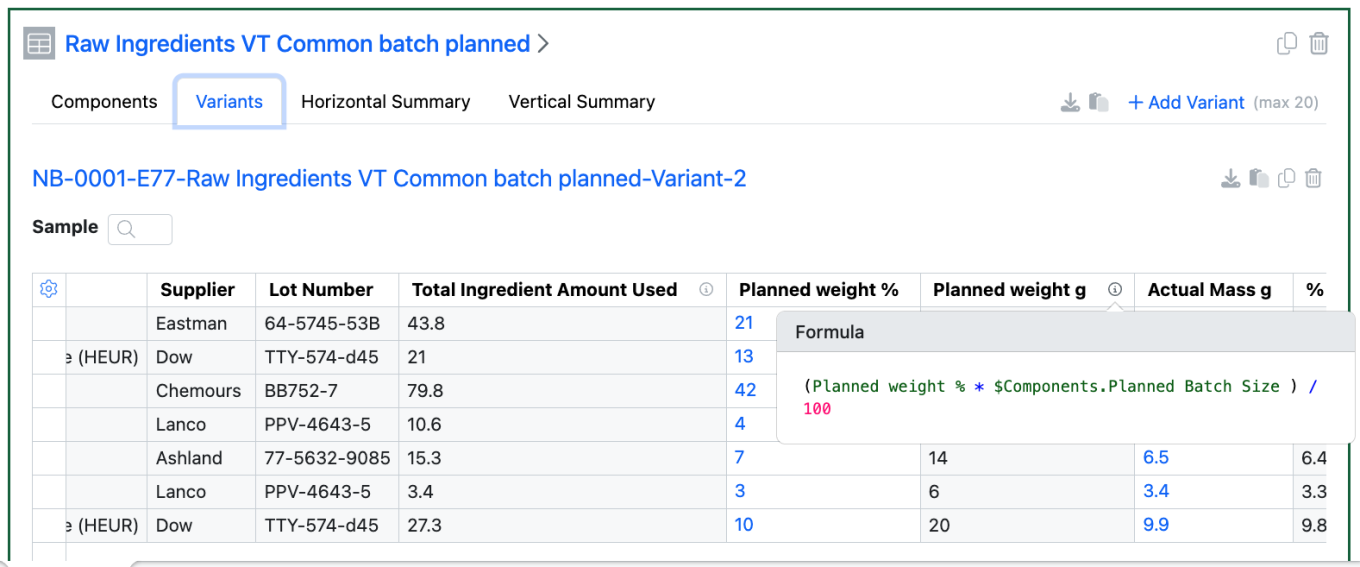
Headers in Components in Variation Tables can now be used in calculations in Variants. The Variant Headers can be found in the selectable properties or can be entered manually.
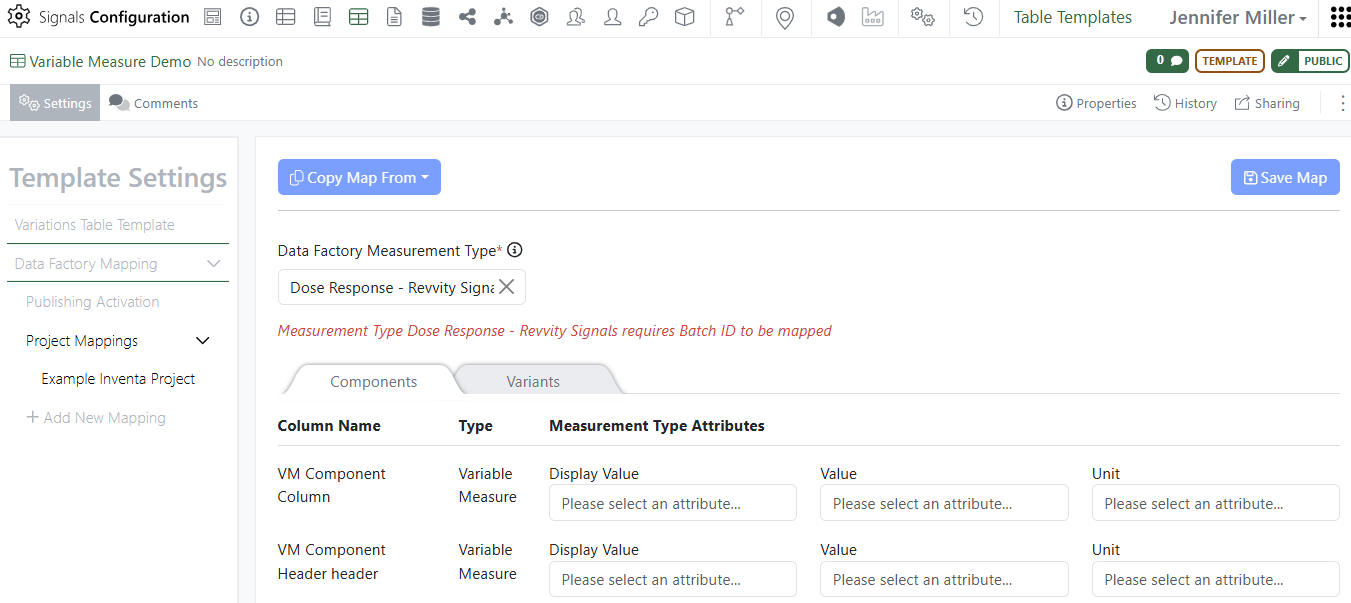

Update to Publish Variation Table to support variable measures in headers and columns. Administrators can now map variable measure field(s) from both columns and headers for both Components and Variants:
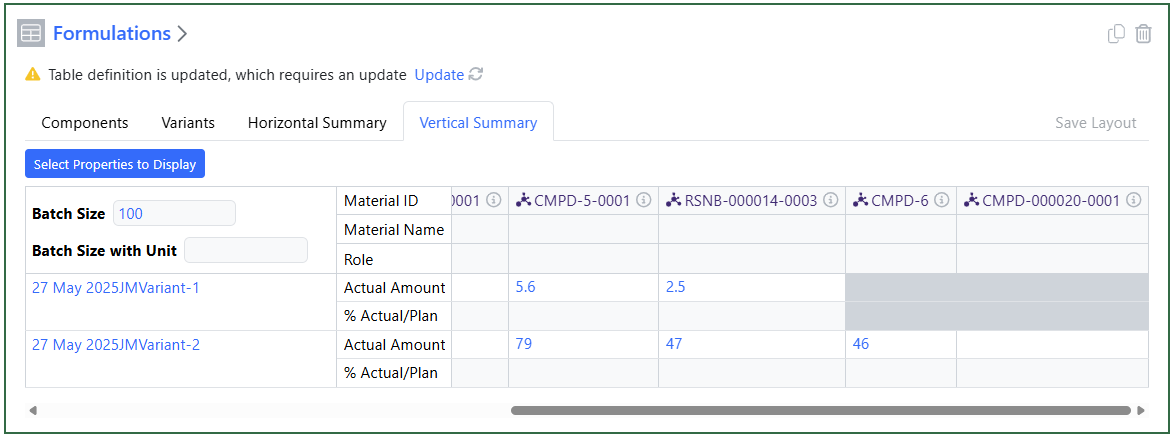
Variation Table Vertical View update for variant hidden rows now is darker gray and will not allow users to type in cells associated with hidden rows:
Samples

A new Moles calculation in Samples utilizing Radioactivity and Molar Activity is now available. If the user enters Radioactivity and Molar Activity values for a Sample, Moles is calculated as “Moles = Radioactivity / Molar Radioactivity”
If the user subsequently enters an Amount on the sample, Moles will be recalculated using the Amount and FM as is standard.
Plates
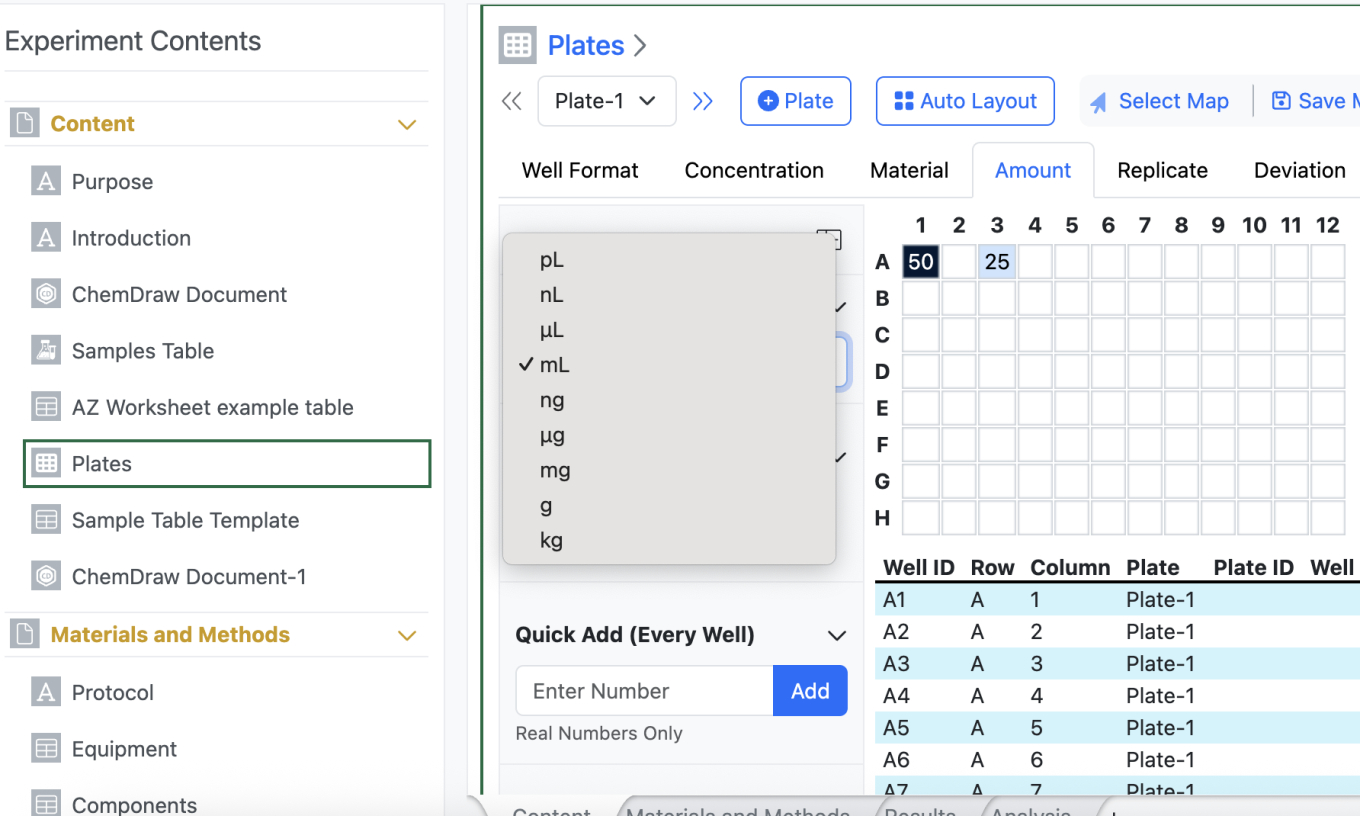
Users can now enter values in the Amount annotation Layer utilizing Mass (g). Values with this new unit are included in the table and export just as the previously available volume amounts.
Inventory
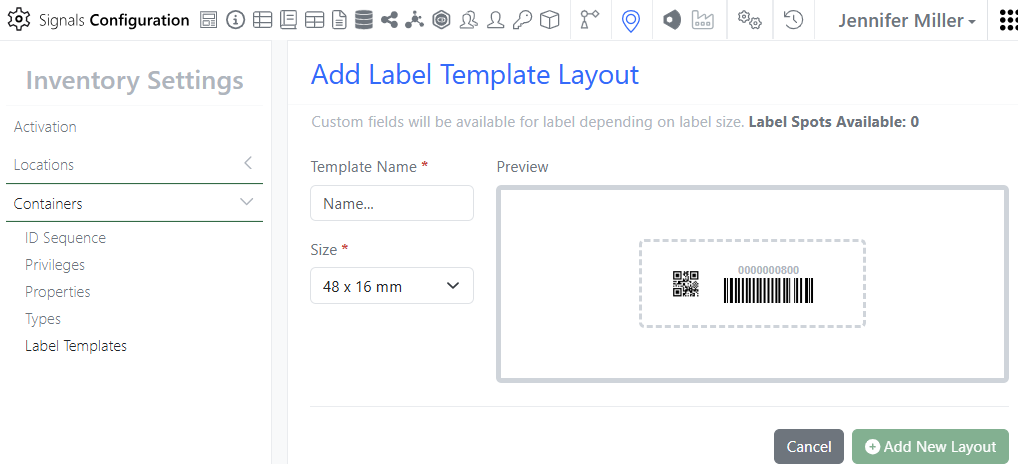
A new 48 by 16 mm label is designed to have the QR code fit inside of a circle that can be added to the top of a tube. The 1-D barcode was designed to fit on a rectangle label next to the circle label and put on the tube vertically:

Update to Internal Request workflow to include Material ID of registered Samples. When users register a Sample from the Samples table the Material ID will automatically be filled in.
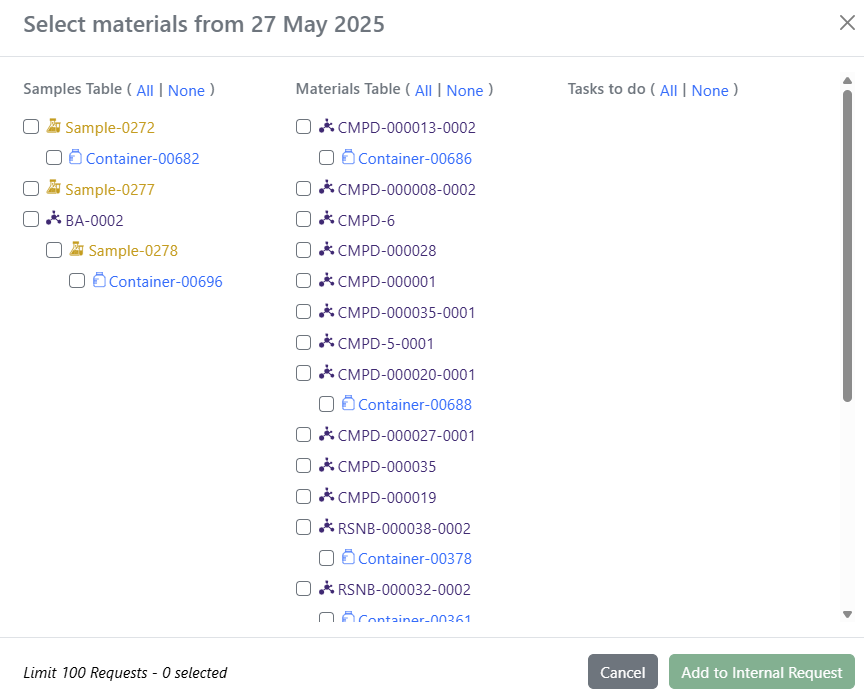
Now in the Internal Request, users will see the Sample ID, the Containers and the Material ID as an option to select from:
Materials

Multipart GenPept, FASTA, and Swiss-Prot files can now be bulk imported into a Proteins material library. Workflows are available to bulk import a collection of single sequence files (current capability), a single multipart file and corresponding meta-data (via .zip folder), or a single multipart file with fixed values (via multipart .gb or .fa file).
Administration

Spotfire for Signals Access Workflows privilege available to control which users can access and substantiate a Spotfire for Signals Workflow. Also controls who can import and export workflows. Users without this privilege can still leverage Workflows embedded within shared DXPs.
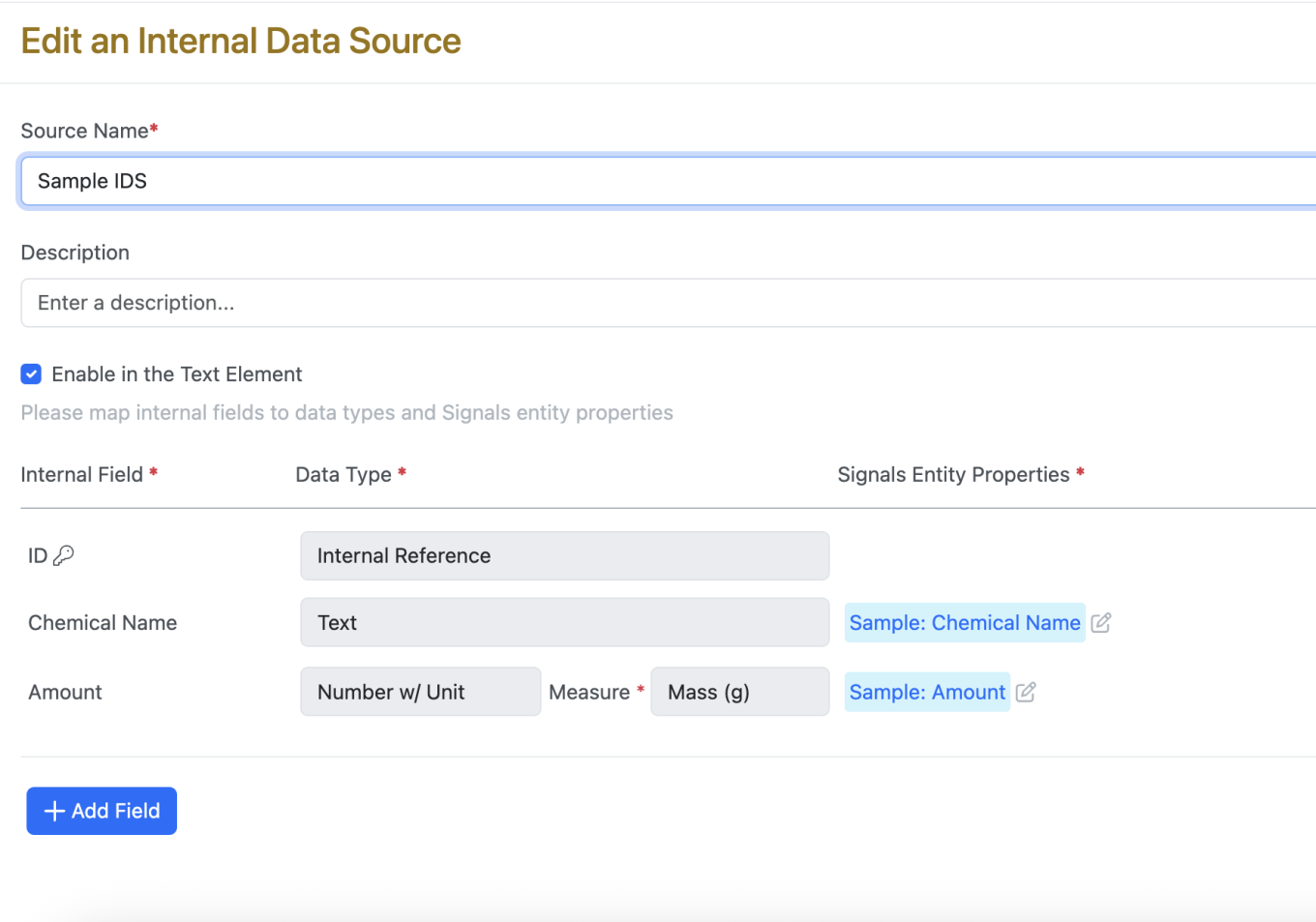
Internal Data Sources now available in Autotext available to all systems. Additionally, Admins are now able to select which Internal Data Sources are available for use in the text element by selecting the checkbox on the IDS in the SN Config.
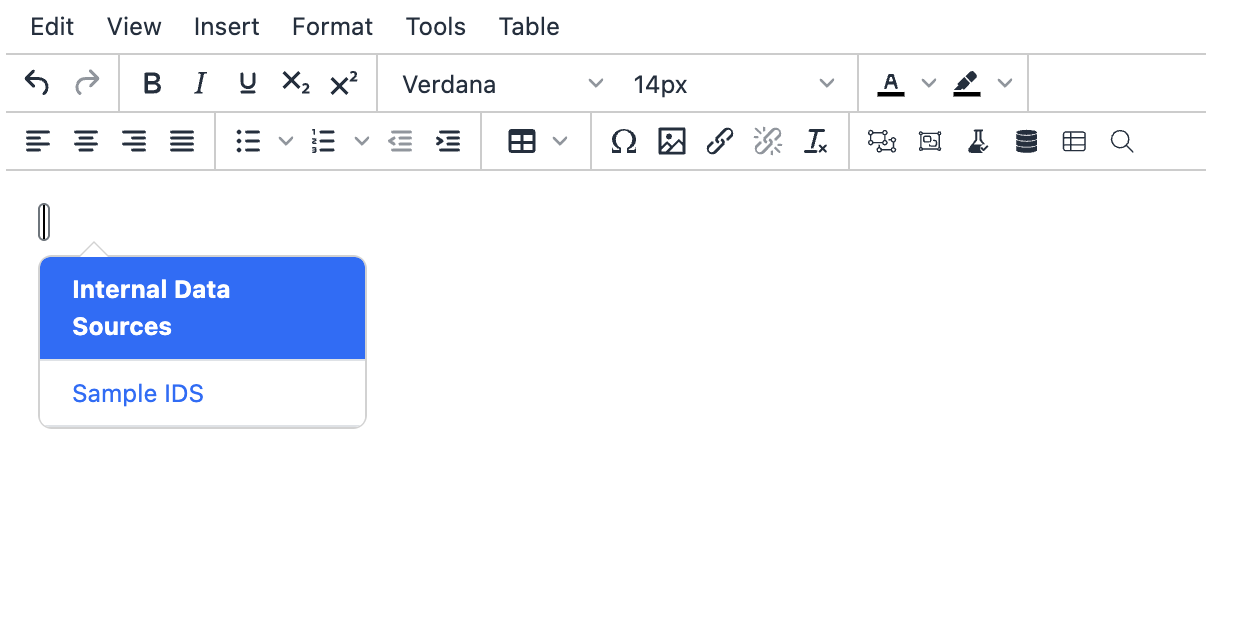
Once the Admin Enables the IDS in the text element, users will be able to select the IDS to utilize in snippets or in the text element.
Integrations & APIs

This update brings new APIs to support modifying CRO users in Signals Synergy. Synergy Users for a provided CRO may be updated in bulk. This is an asynchronous API that allows the bulk update status to be checked once initiated via the POST API. The POST API takes a CSV files with User ID,Email,First Name,Last Name,Country,Alias,Licenses. Field are optional as when applicable.

Plates can now be exported as CSV via the External API. To download the plate as a CSV set the “format” URL parameter to “csv”. The default format will be a JSON file if not specified.

The example zip for material bulk import can now be specified to contain a CSV example. To download the zip with a CSV example set the “dataFileType” url parameter to “csv”. The default data type will be SDF if not specified.

A new API has been added to pair two single oligonucleotide sequences and create a chemical drawing of the paired sequence.
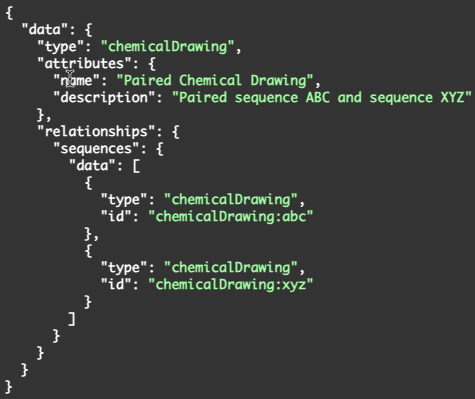
The request takes an eid of a parent as a URL parameter and the body takes two chemical drawings each containing a single oligonucleotide sequence as well as a parent entity. If the pairing is successful a chemical drawing of the resulting pair is added to the provided parent entity.
The parent entity must be capable of having a child chemical drawing.

Two new endpoints have been added to Signals Data Factory for exporting data from projects.
These endpoints will all or a specific measurement type data by Project.
The request will allow for, and the response will contain a search ID and last document id. Providing these in subsequent requests will allow for pagination, and to only capture data that has comes after the provided last document id.
An optional request body can be used to filter the results further.
For all measurement types you can filter on: Entity, Attribute(s), and Tag(s) as well as specify which fields you want returned in the results.
For individual measurement types you can filter on: Entity and Attribute(s) as well as specify which fields you want returned in the results.
Further Details
The following capabilities are in beta and are available for users, administrators and developers on the Signals platform upon request. Please contact your account representative or our support team if you would like access to the following features.
Data Workflows & Analytics
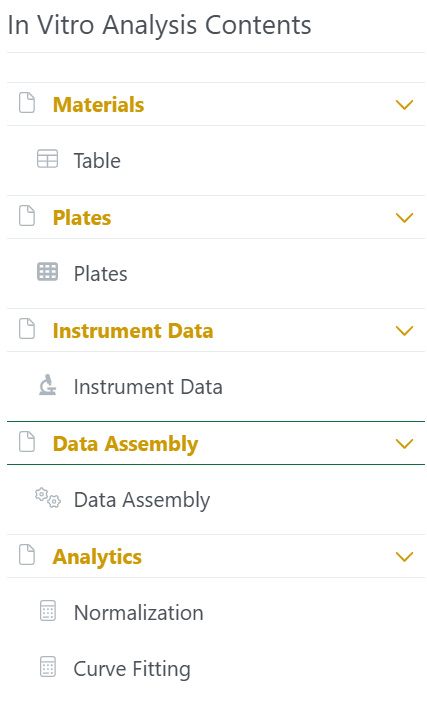

For tenants with a Signals One license, users will now be able to perform In Vitro (screening, assays) data analysis, visualization and results quality control. The first curve fitting method available, is the logistic 4 Parameter (4P) fit.
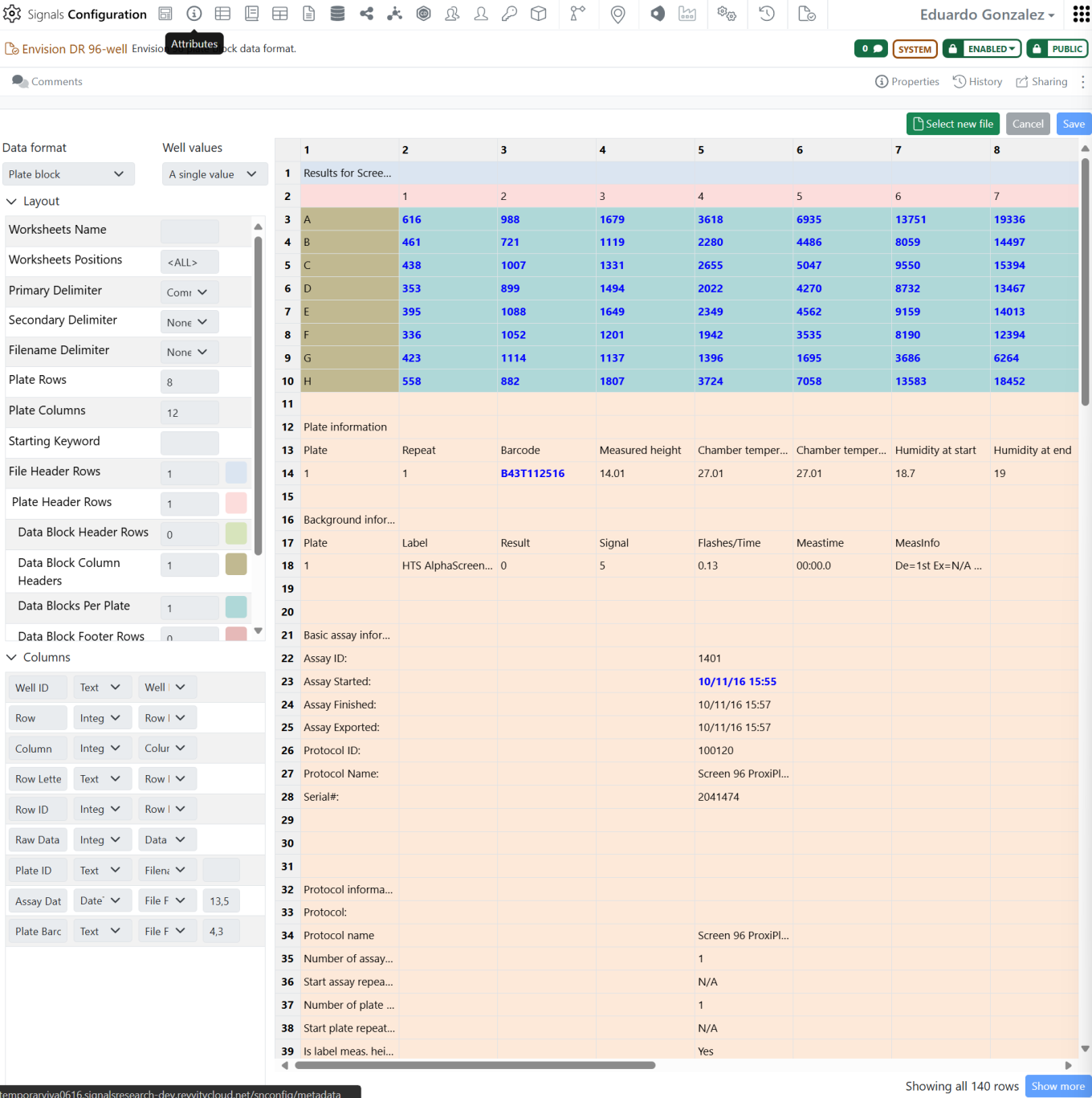
Parsing of instruments output files is now directly available in Signals One to generate analytics-ready tabular data. Some System parser definitions for Revvity plate readers (e.g. EnVision, EnSpire, Operetta,…) are provided out of the box:

The data from the instrument output files can be enriched with the information about the plate format and the materials tested to provide all the information required for the visual analytics steps:
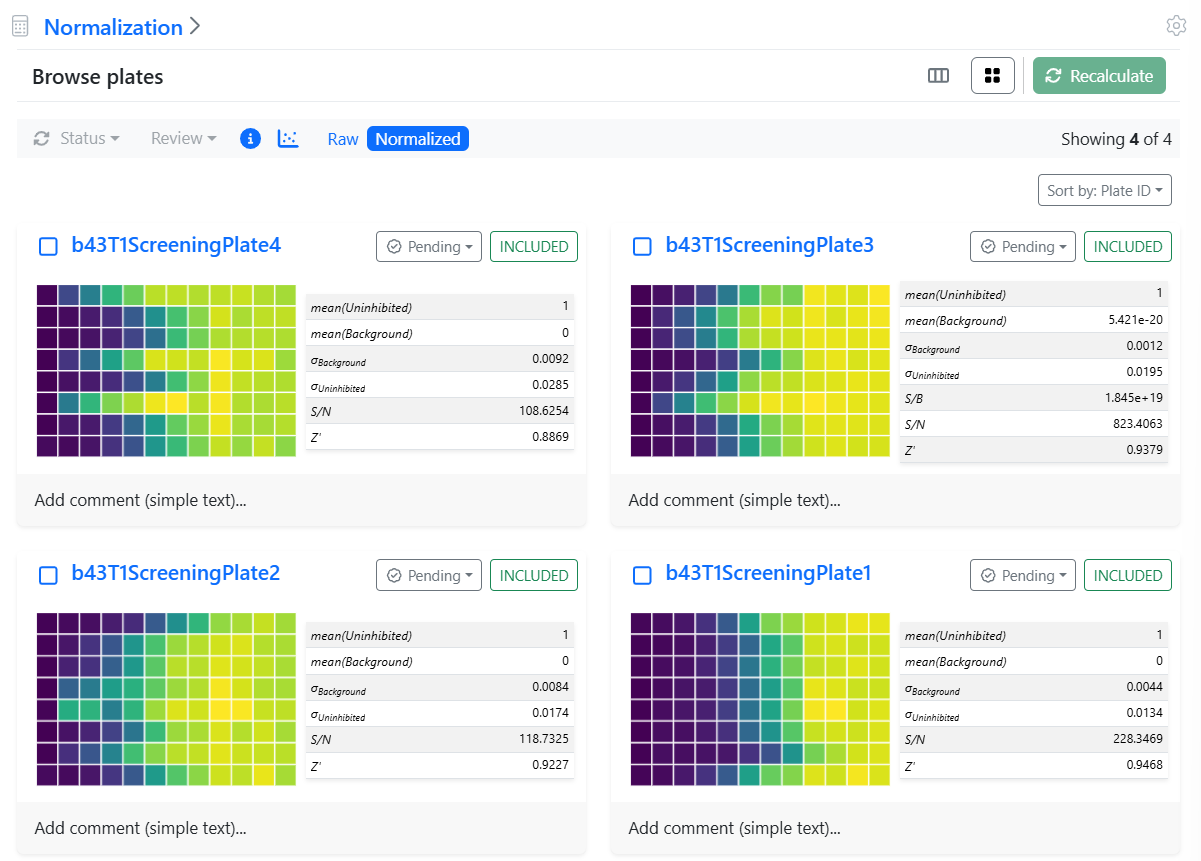
The analysis and visualization is organized in steps. Currently, normalization:
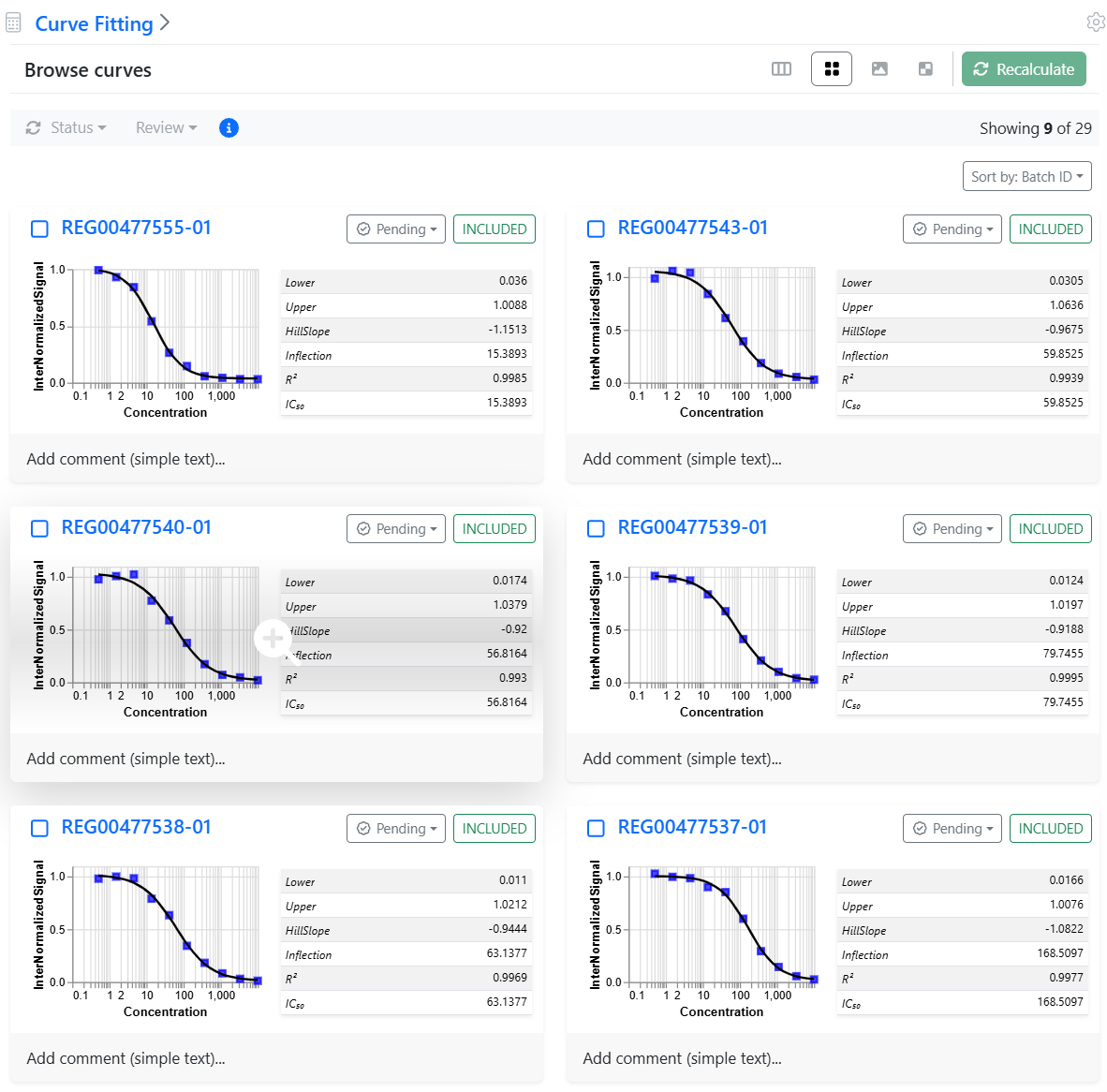
and 4P curve fitting steps are available:
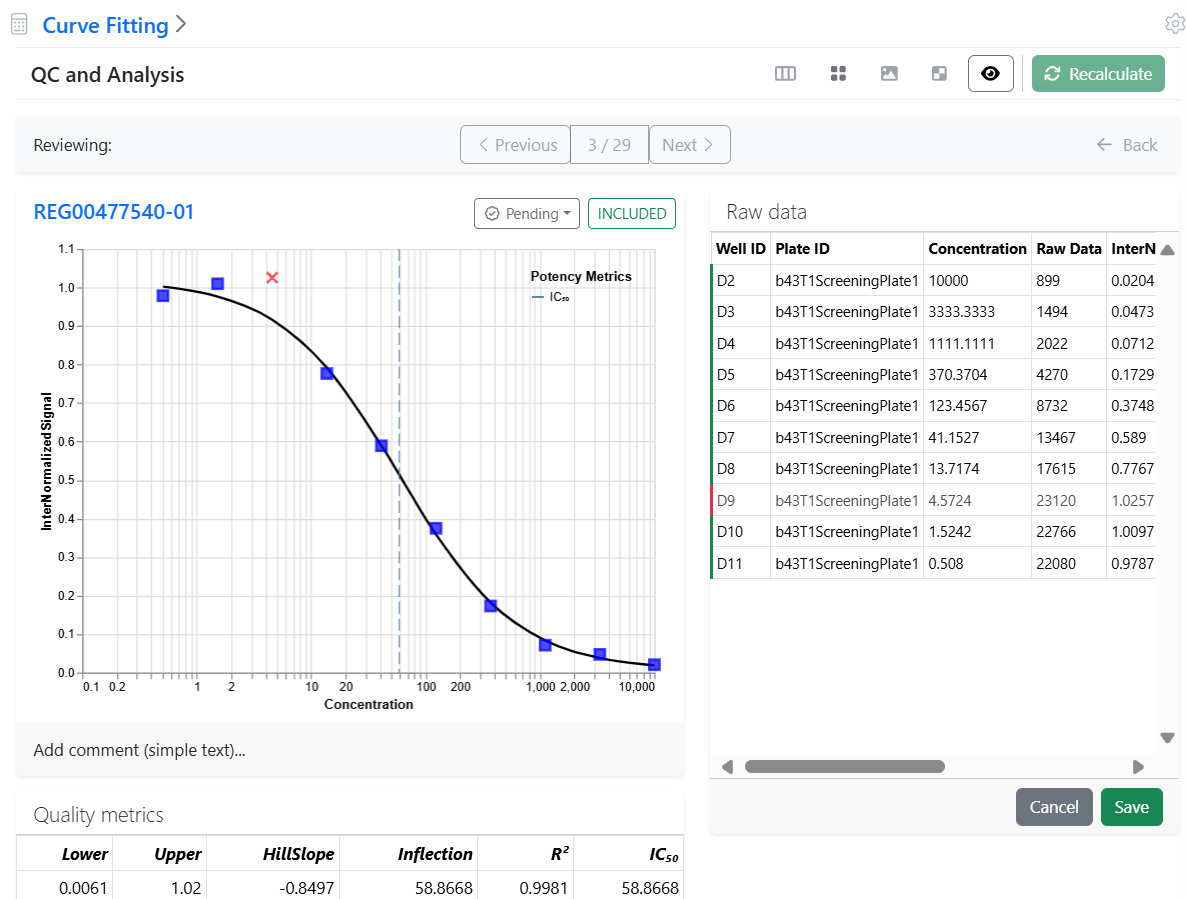
Each curve can be controlled in detail and outliers excluded from the analysis at the level of the data points or even whole curves:
SAR & Decisioning
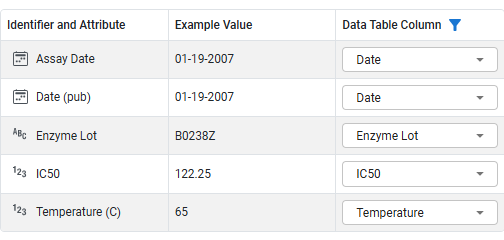
Minor automapping enhancements were introduced to the Publish Results to Data Factory to prioritize the optimal match, even if the same data table column is associated with multiple attributes.
What's New
We are delighted to release our new version of Signals, 25.5. This release brings enhancements in Signals Synergy, our SAR and Decisioning capabilities, Samples, Materials Libraries and Inventory, and to Admin Defined Tables and Variation Tables amongst others. We have new beta capabilities for SAR and decisioning and an AI based capability to extract text from images. Finally, we have also fixed a number of small bugs.
This release of Signals brings updates to the horizontal view, and management of materials, in Variation tables. We have extended import and export flows to and from Signals Synergy, including a beta capability in publishing table data to Inventa. We have redesigned Order and Internal Request Tables in Inventory, extended the material lineage capability and extended our extraction coverage for the ELN archive. We have extended the utility of autotext, and added calculated product equivalents in the stoichiometry tables. Finally, we have also fixed a number of small bugs.
The following improvements are available for users, administrators and developers on the Signals platform. Certain features may only be available with appropriate licensing and/or with enablement by an administrator.
- Fundamentals
–Spotfire Connector Oracle available
–Addition of Plates to Parallel Experiments
–Automatic fill of hierarchical attribute child value if it is the only child
- AI
–Text Extraction from Images (beta)
- SAR & Decisioning
–HELM rendering supports ChemDraw and custom coloring schemes
–Nanobody Structure Prediction Data Function
–Embed GenBank Data Function
–Mapping useability enhancements in Publish Results to Data Factory app (beta)
–Downloadable report for successful publications (beta)
- Synergy
–Create Work Order privilege
–Select default Synergy Experiment Template for a Work Order Template
–Include Reference Table configuration in a Work Order Template
–Admin-defined fields for Reference Tables
–Add Designs to Work Order Reference Tables from multiple Ideas
–Customize Design ID sequence
–Sponsor users Quick Add Designs to Chemical Drawings in Experiments, ADOs, and Synergy Experiments
–Expanded Designs Statuses for Design synthesis tracking and Approve Designs for Synthesis privilege – available to all systems
–Bulk Design status update from Designs Smart Folder Data Grid view – available to all systems
–Kanban board view in Designs Smart Folder for Designs synthesis tracking – available to all system
- Admin Defined Tables & Variation Tables
– CASE function
– Multiline entry in equation editor
– Improvements to the Horizontal Summary View in Variation Tables
– Publish Variation Tables to Inventa available to all systems
- Samples
– Autoscaling of units for Sample Moles calculation
– Significant figure handling improvements in Sample calculations
- Inventory
– New labels
– Requests support Internal Request workflow
– System Supplier List available in new container creation workflow (beta)
– Add Material Library properties to container labels
- Materials
– Updates to the Materials Table material selection
– Change the batch/lot of a selected material
– Calculated properties for DNA and RNA materials
– Bulk import with multipart GenBank and FASTA files
– Disregard Order in Materials Bulk Import
- Administration
– ChemDraw aromatic display preferences are respected in Inventa
- Integrations & APIs
– API update to allow chemical drawing import via HELM
– API for fetching bulk import success reports
– API for fetching Worksheet field definitions
– APIs for fetching and creating CRO users
– External Actions can be hidden from CROs
We also fixed several small bugs in this release. Details of the enhancements are described below.
The following OnDemand videos for Signals Notebook End Users are now available
- Materials Table: Register and Manage Materials within an Experiment
System administrators of Signals Synergy should be aware that there is a new privilege called Add Work Orders that is now required to create Work Orders. Previously, no privilege was required to create Work Orders. For users to continue creating Work Orders, you must grant them this privilege via a role.
Data Factory administrators should be aware that job-service/postJobserviceLoad primary API is now asynchronous and will immediately respond with a 202 and the string “accepted”. It will no longer return the job’s information.
Data Factory administrators should be aware that the DELETE /information-design-service/mtypes/{name} primary API now returns 409: Conflict when trying to delete a measurement type linked to an Experiment, ADO, or Table in Signals One.
Developers should note that we have changed the GET/entities endpoint to no longer allow for both “trashed” and “untrashed” items to be fetched simultaneously. The "includeOptions" will continue default to "untrashed" when no explicit parameters are specified. This change only impacts customers who are explicitly setting “includeOptions” to “trashed,untrashed” or any combination including both.
Administrators are recommended to subscribe to the channels within our support news site found at https://support.revvitysignals.com/hc/en-us/categories/360004446171-Support-News which contains more information about releases and other pertinent product information.
This content is anticipated for release on our Production E3 environments, and for Private Cloud customers on our deferred release schedule, in November 2025.
Further Details
The following improvements are available for users, administrators and developers on the Signals platform. Certain features may only be available with appropriate licensing and/or with enablement by an administrator.
Fundamentals
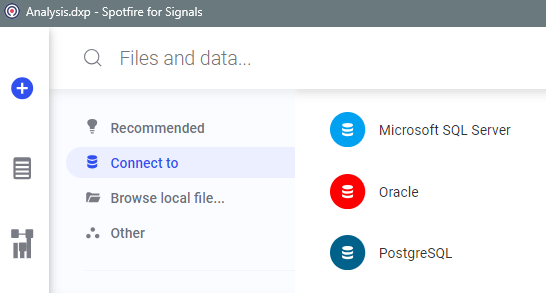
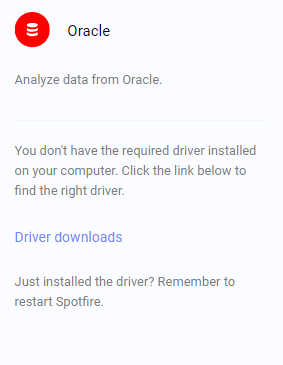
Spotfire Connector Oracle is available within Spotfire for Signals. The end user must install the required driver for function in Spotfire for Signals Analyst. Data Connection information must be embedded in analysis file. Authoring, editing, and creating new is supported in Spotfire for Signals Analyst while Spotfire for Signals Online can consume existing.
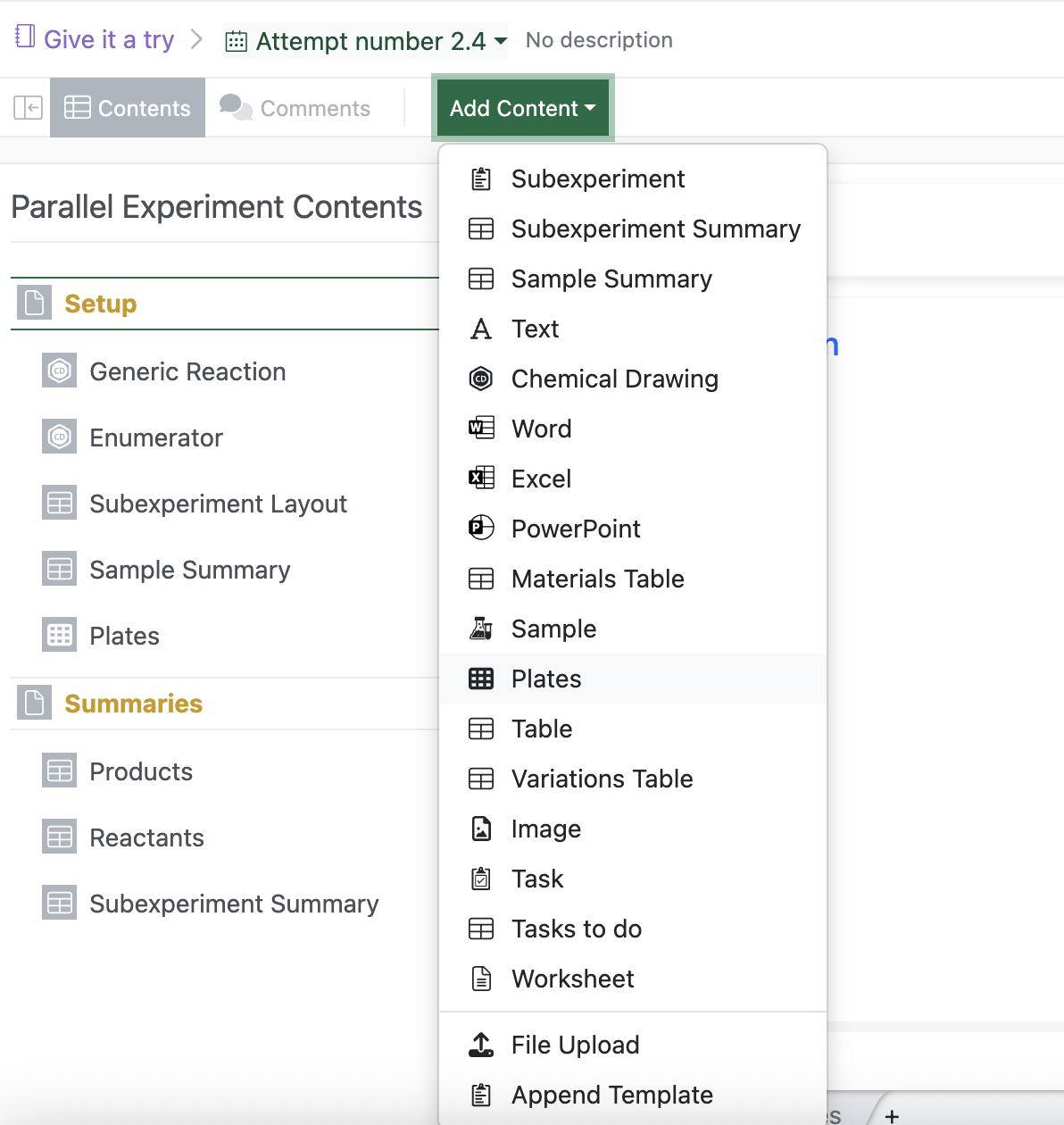
Users are now able to add the standard Plate element in Parallel Experiments using the Add Content dropdown. When populating the plates using Autofill, the user now can populate that plate with samples from the Sample Summary table.
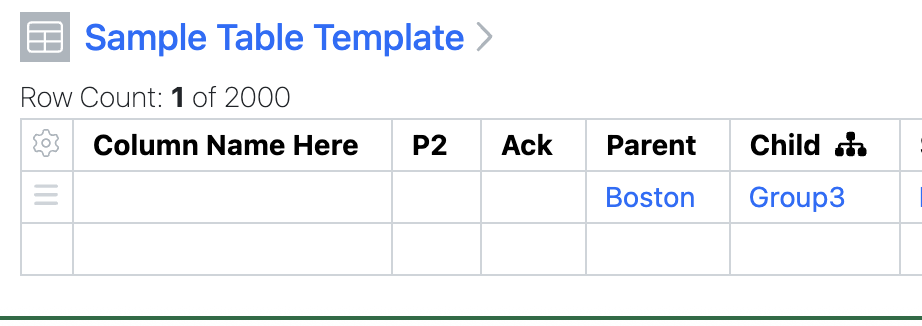
In a click reduction effort, child fields in a Parent/Child Hierarchical Attribute pair will automatically fill if the user only has access to a single child of their selected parent. This is no way alters user access to values in the HA. Users are still able to remove any auto-filled child attributes.
SAR & Decisioning
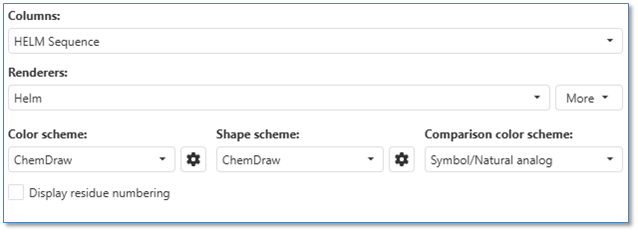


Users can now customize HELM rendering in ChemCharts visualizations by selecting predefined ChemDraw or Pistoia styling, or by creating their own custom color and shape schemes
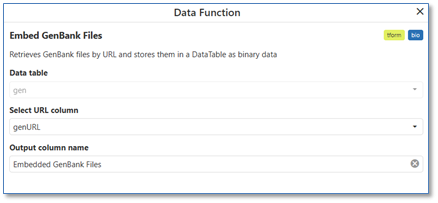

Users can now embed GenBank files into Inventa Analysis using the ChemCharts 'Embed GenBank Files' data function, which extracts GenBank IDs and file content from URLs in Spotfire tables
Users can leverage the new 'Nanobody Dashboard' ChemCharts data function to generate comprehensive visualizations for nanobody developability assessment, including 3D structure prediction, antibody numbering, surface area analysis, developability metrics, and sequence liability identification
Synergy
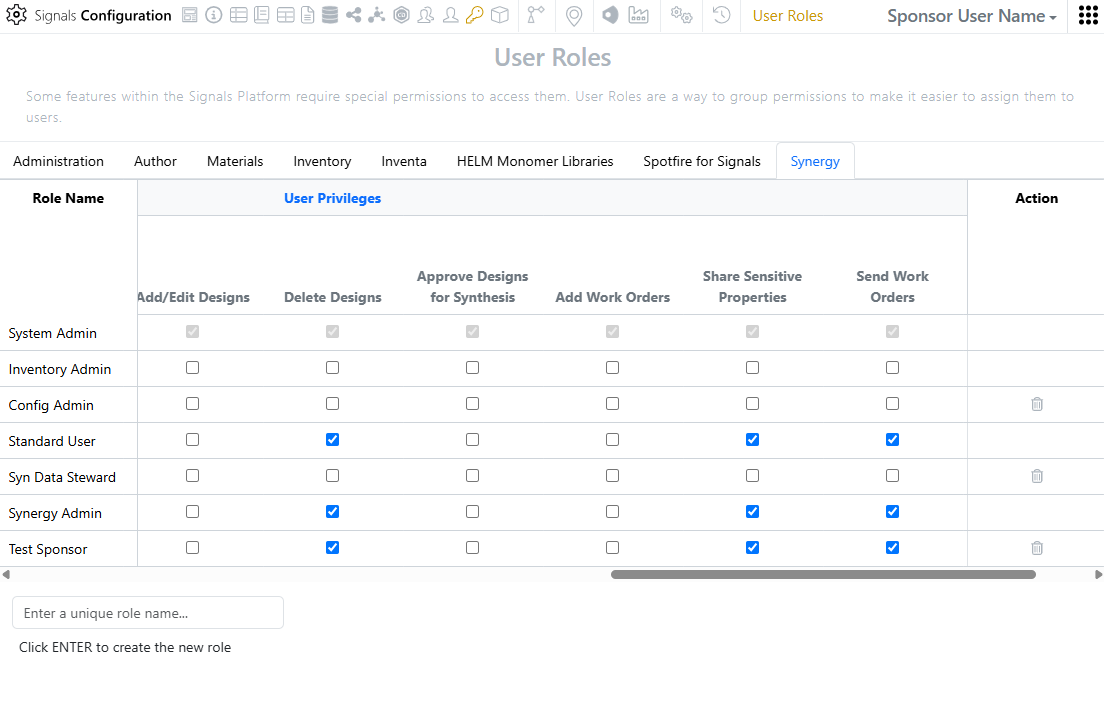
The System Admin can now control which Roles can create Work Orders using the new Add Work Orders privilege. Previously, all users with access to the Synergy App (Synergy App privilege) could create Work Orders; now, users must be granted this privilege in Signals Configuration to create Work Orders.

For commonly used workflows, several improvements have been made to reduce the number of clicks required by the Sponsor end user. First, a default Synergy Experiment template can be selected for a given Work Order Template. This allows the Sponsor end user to create a Work Order and the Draft Synergy Experiment using a single creation screen. In addition, the admin can now add a Reference Table to the Work Order Template and pre-configure the default shared properties.

Reference Table configuration also now supports admin-defined fields, in addition to the shared properties of Designs or Material Assets and Batches. Reference Table admin-defined fields can be used to convey additional information to the CRO, such as which assays to run on specific compounds or the amount and minimum purity requested for Design synthesis.
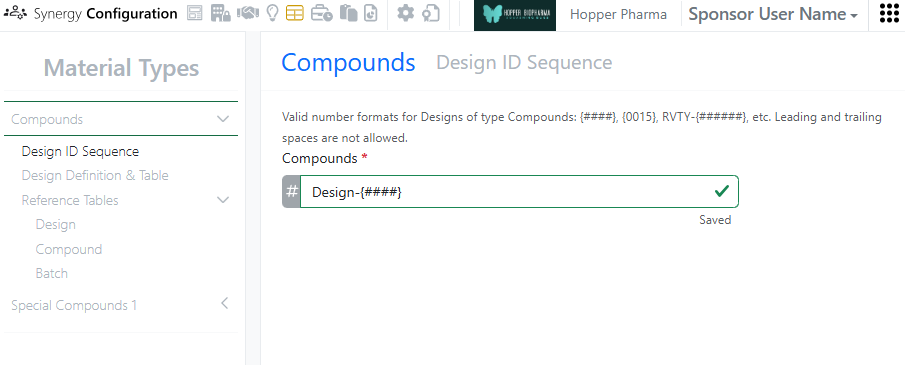
For Designs, the Design ID is now customizable by the admin in Synergy Configuration. In addition, Designs from multiple Ideas (e.g., across chemistry teams or across projects) can now be added to a Reference Table in a single Work Order.
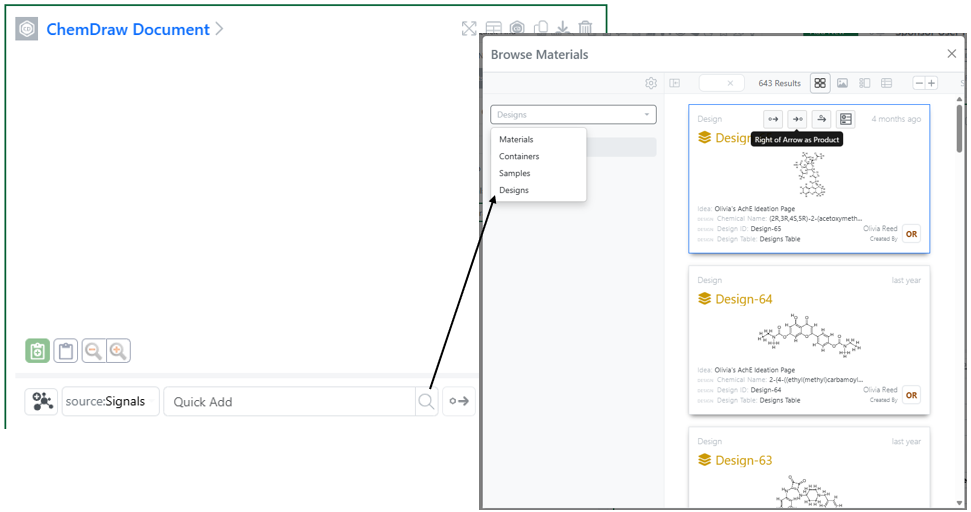
Finally, internal users can now use the Quick Add toolbar to easily add Design structures to Chemical Drawings in Experiments, admin-defined objects, and Synergy Experiments. The Design ID will be added to the stoichiometry grid Product or Reactant Table and propagated to any subsequently created Sample(s) and then into the Originating Design on registered Material(s) from the Sample(s).
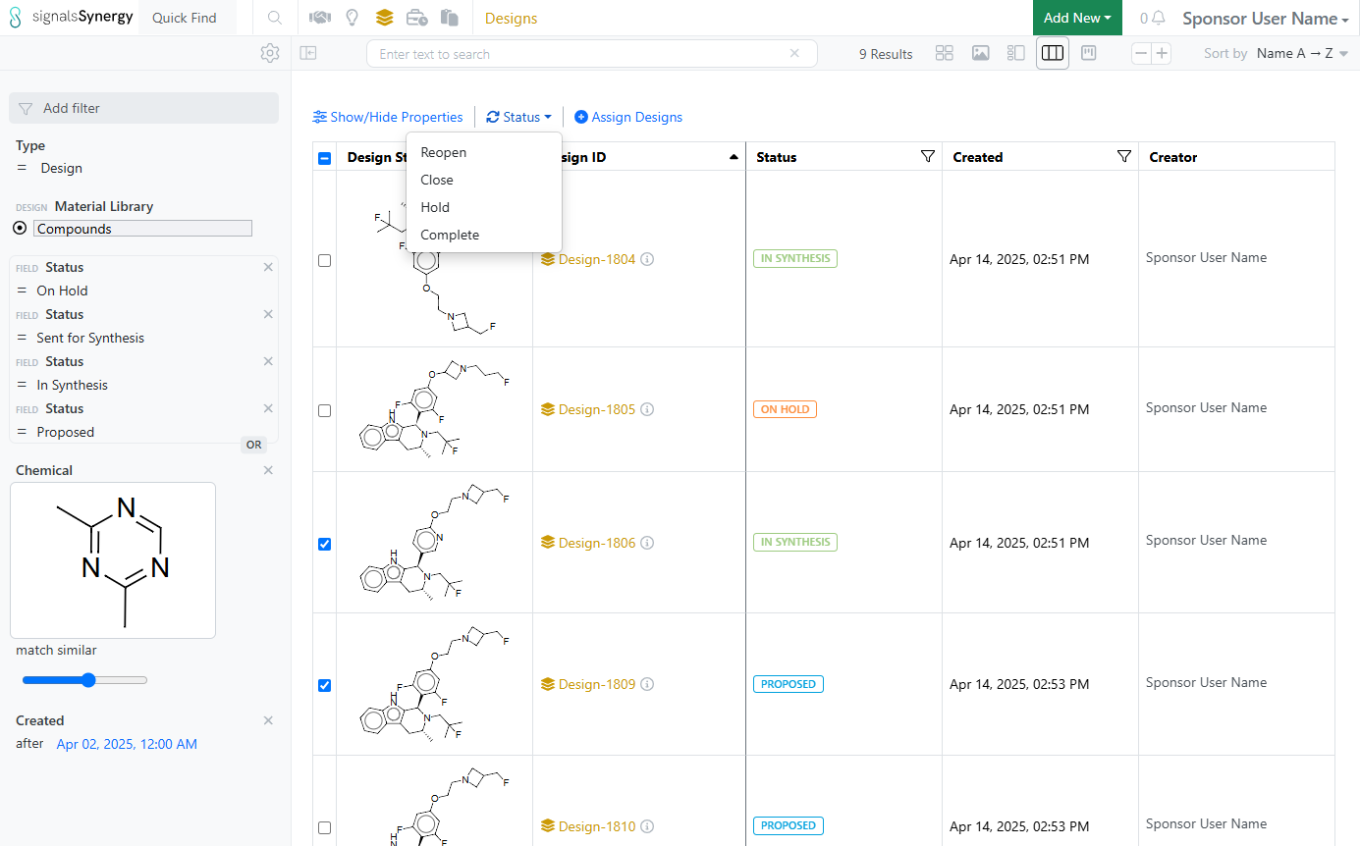
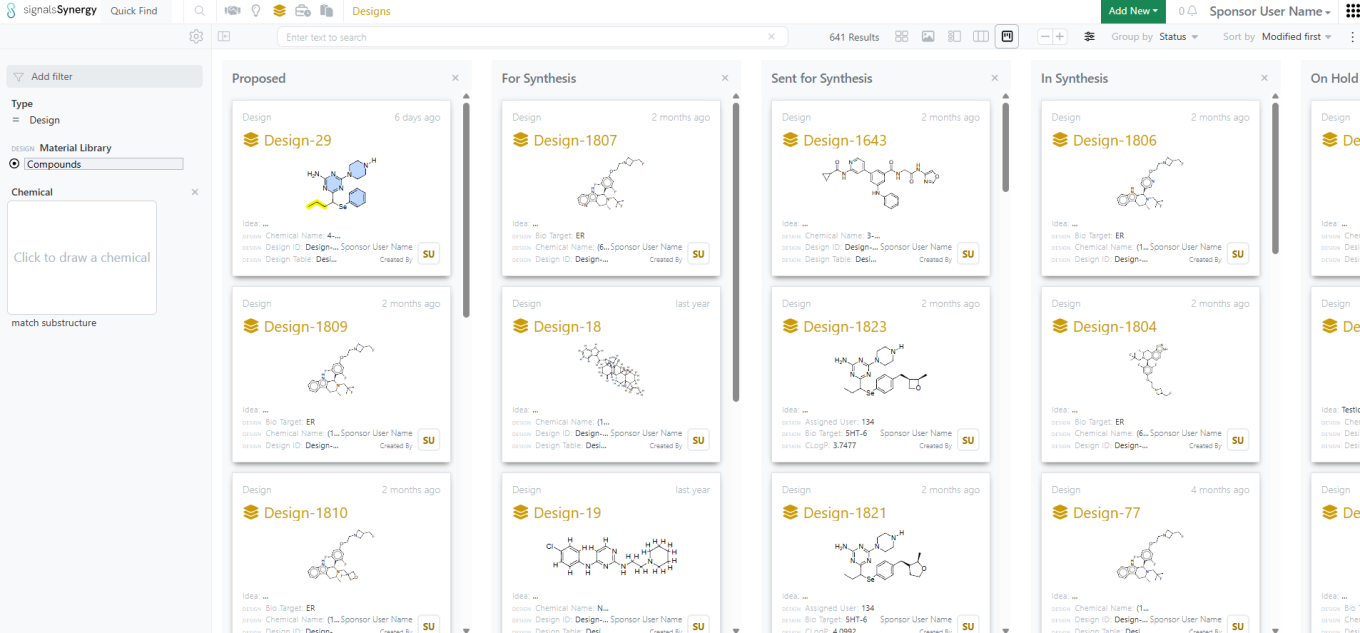
Finally, expanded Design statuses for Design synthesis tracking, Approve Designs privilege, bulk status updates, and a Kanban Board view of Designs by Status in the Designs Smart Folder are now available to all systems.
Admin Defined Tables & Variation Tables
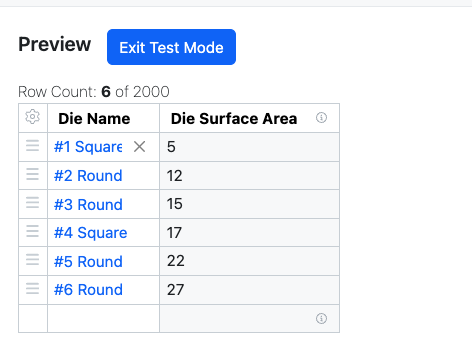
We have added a new conditional function, CASE, to the equation editor in Admin Defined Tables and Variation Tables. The CASE statement allows the admin to define a series of up to 20 different outcomes based off of the results in a given comparison column. The first matching result is provided. The admin can define a final result should no outcomes match. This provides a more elegant alternative to nested IF statements.

We have also updated the equation editor to allow multirow editing to aid in the definition of the equations for more complex equations such as those using the CASE function above.
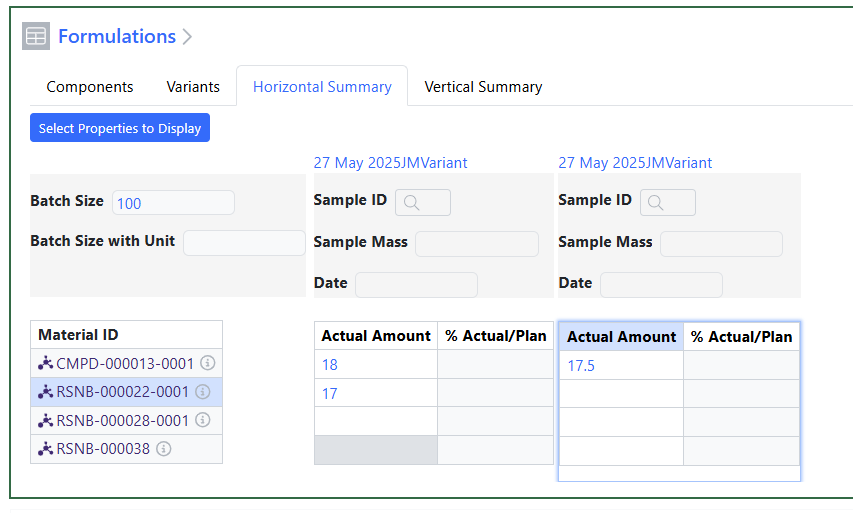
The Horizontal View in Variation Tables has been updated to highlight the variant, the component and the header of the column so users can easily see where they are entering values:
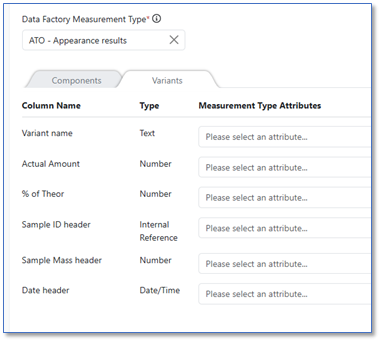
The publication of Variation Tables to Inventa is now available to all systems.
Samples

To conserve the behavior from calculations in the stoich grid in the Sample calculations, autoscaling of units for Sample Moles calculation have been added along with Significant figure handling improvements in Sample calculations.
Significant Figures are now applied to calculated values for Sample Yield and Moles in Samples: Moles should have the same number of Significant Figures as Amount, Sample Yield should have the same number of Significant Figures as Moles in Samples when the number of Significant Figures for Theo Moles in Products is higher, and Sample Yield should have the same number of Significant Figures as Theo Moles in Products when the number of Significant Figures for Moles in Samples is higher.
Inventory
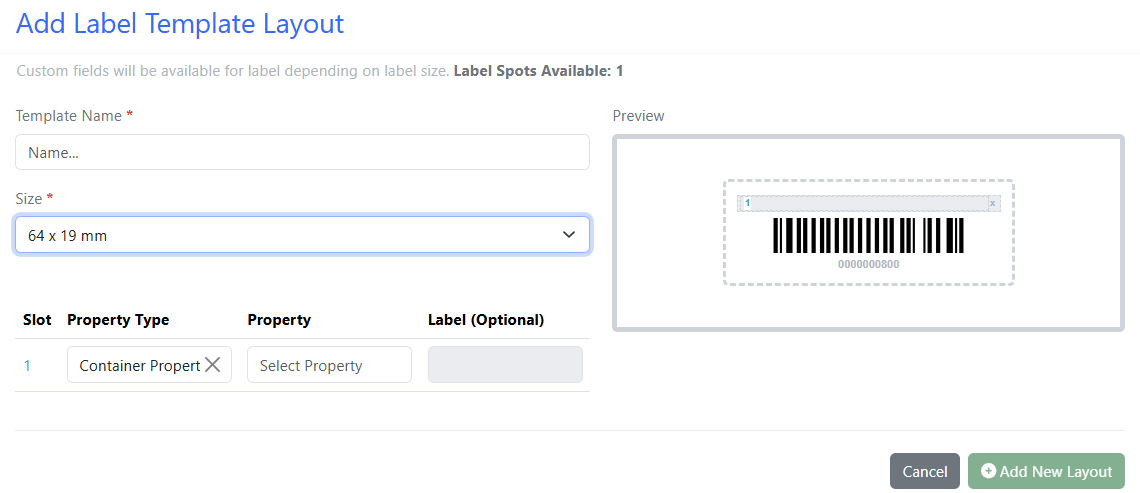
We have added a 64 by 19 mm label:
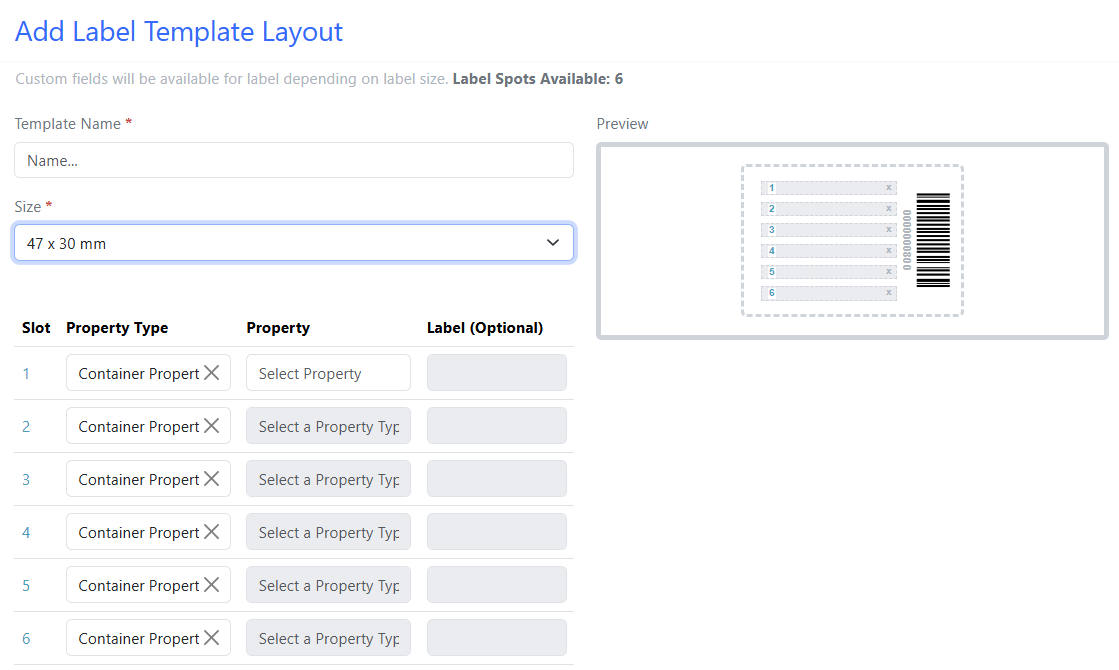
A 47 by 30 mm label:
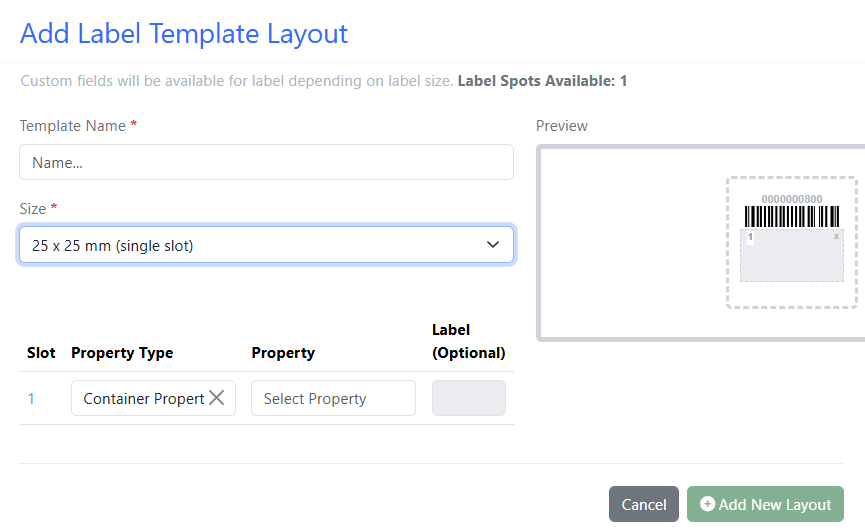
And a 25 by 25 mm option with 1 slot:
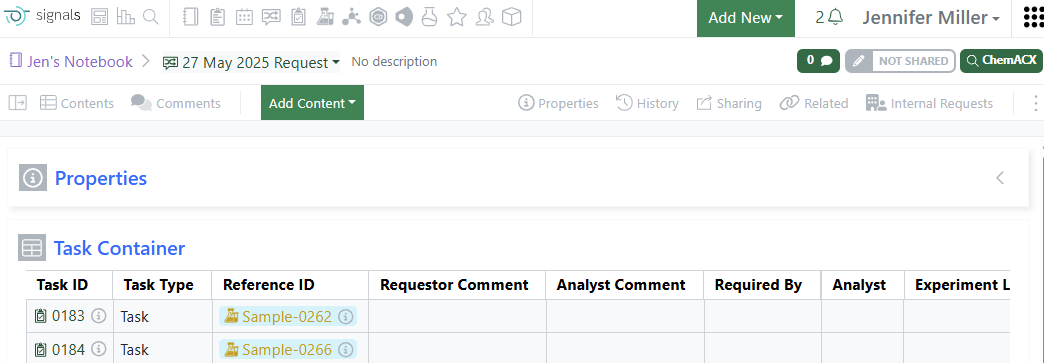
Requests support Internal Request workflow. Users can now use the Internal Request workflow from inside of a Request in the Task and Request workflow:
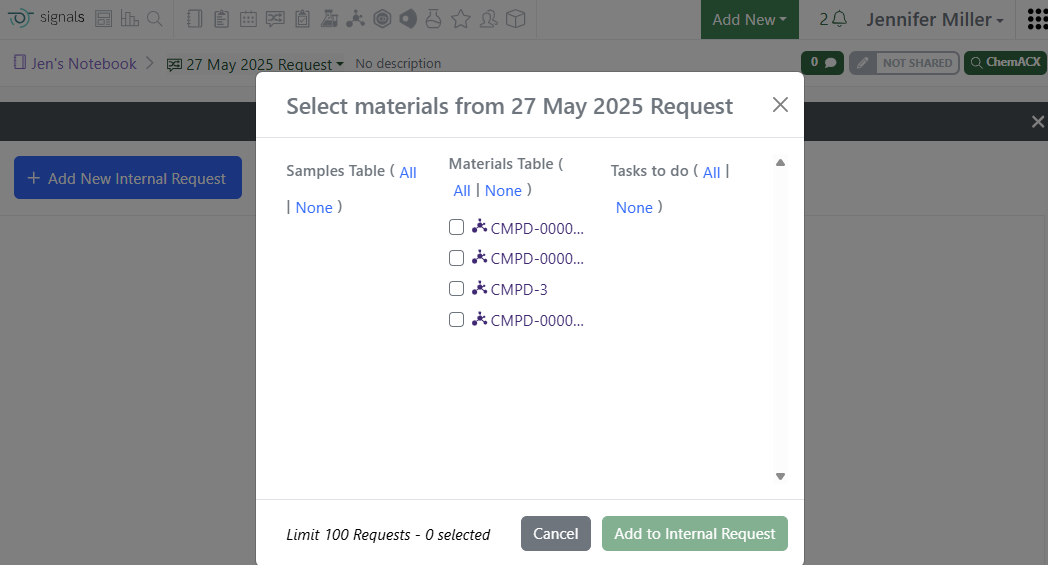
Adding an Internal Request will allow users to choose materials from the Samples, Task To Do or Materials Tables:

The Internal Request will be available from inside of the Request:

And can be seen in the Internal Request Table:
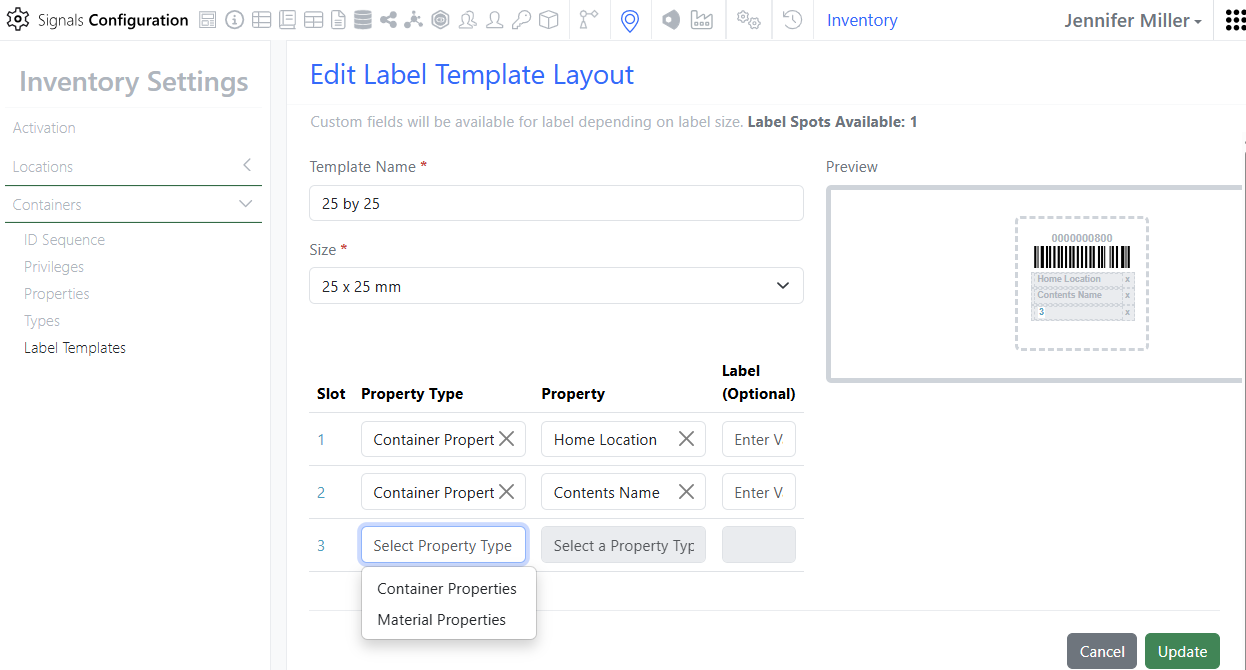
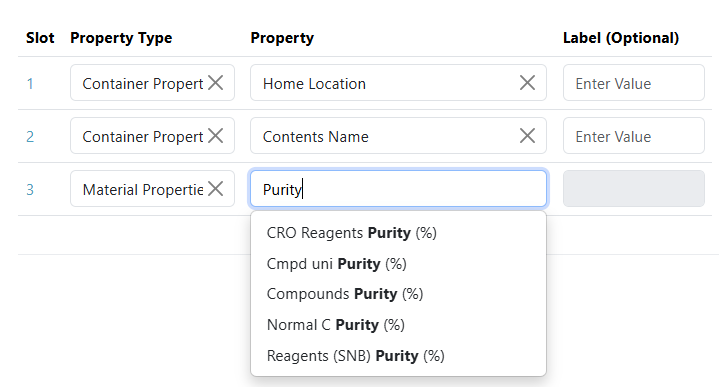
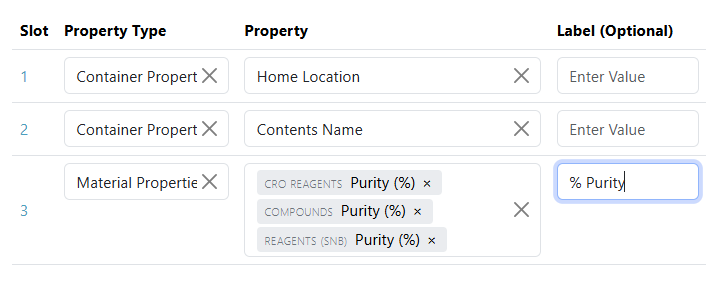
Add Material Library properties to container labels. Some properties make sense to store on the material in the Material Library. To not duplicate data, administrators can now pull the data from Material Libraries into the container label. If multiple Material Libraries have the same property to be printed on a label (ex: purity), the administrator can select the property to be added to the label from multiple Material Libraries in one slot on the label:
Materials

Updates to the Material Table materials selection. Users can now select the asset or the batch/lot to be added to a Materials Table:

Users can select the Batch/Lot or Asset option in the filter on the left to narrow the selection:
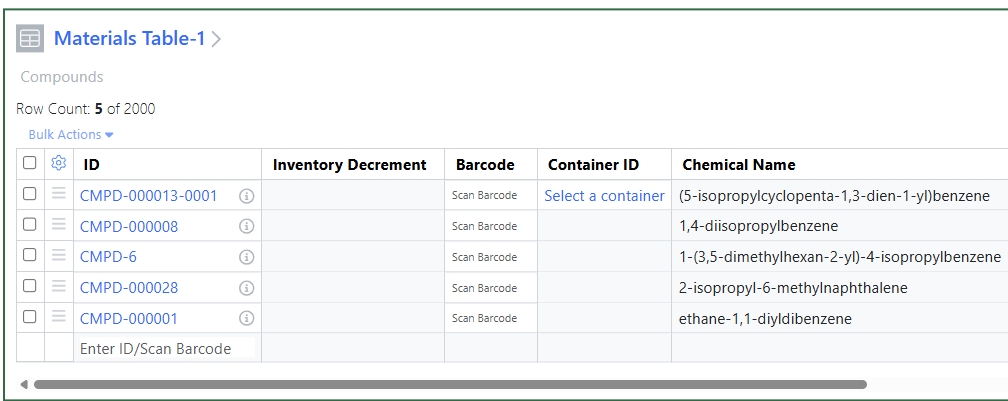
Both Assets and Assets with Batch/Lots will be added to the table:
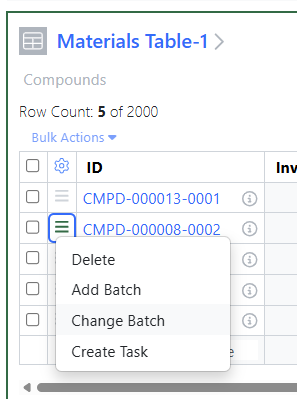
Change the batch/lot of a selected material. If users have selected a specific batch/lot of a material, they can update the batch/lot to a different one:
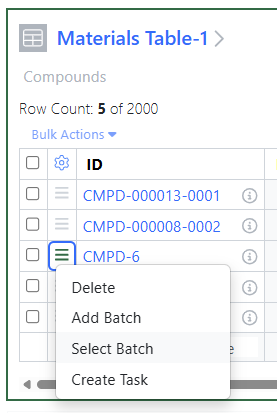
If a batch/lot is not currently selected, one can be selected:

If a container has already been selected and a decrement has been entered and the user wants to update the batch/lot, a message will appear:
If a container has already been selected and a decrement has been entered and the user wants to update the batch/lot, a message will appear:
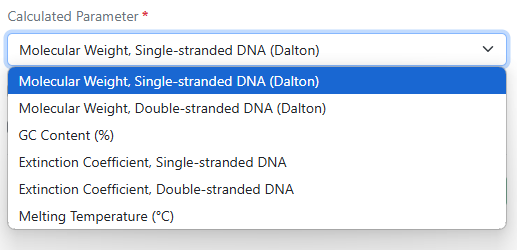
Calculated properties are now available for DNA and RNA material types and in the preconfigured Primers and Plasmids libraries. Molecular weight, GC content, extinction coefficient, and melting temperature are available for single-stranded and double-stranded molecules.

Multipart GenBank and FASTA files can now be bulk imported into a DNA or RNA materials library. Workflows are available to bulk import a collection of single sequence files (current capability), a single multipart GenBank or FASTA file and corresponding meta-data (via .zip folder), or a single multipart GenBank or FASTA file with fixed values (via multipart .gb or .fa file).

There is a new option that allows for the parallelization of Material import while still utilizing matching against materials already stored in SNB. It is critical to note that for uniqueness checking to occur correctly there can be NO DUPLICATE values within the file to be uploaded as these values will be parallelized for import and checked against values within the system.
Administration
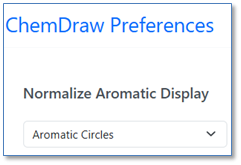
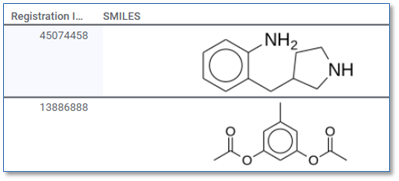
The Signals Research Suite license is now renamed Signals One and can be seen in the Users pages within Signals Configuration. The bulk update user file and integrations such as APIs are unchanged.
Admins are now able to manage the chemistry autotext. Under System Settings, there is a new Chemistry Autotext option that allows the admin to select which properties available in the Stoich grid appear in the Chemistry Autotext. Admins are now able to include custom admin defined stich properties in their Chemistry Autotext.
Integrations & APIs

This update brings additional endpoints for our Synergy product. New APIs have been added to fetch and create CRO users. CRO users may be fetched by CRO using the CRO or you may fetch the CRO a user belongs to by user ID.

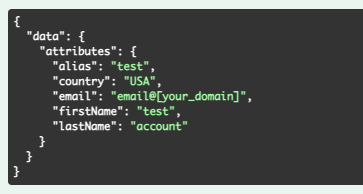
To create a user as member of a CRO the CRO must be specified as part of the URL parameters by CRO ID. The request body should contain the details of the CRO user.
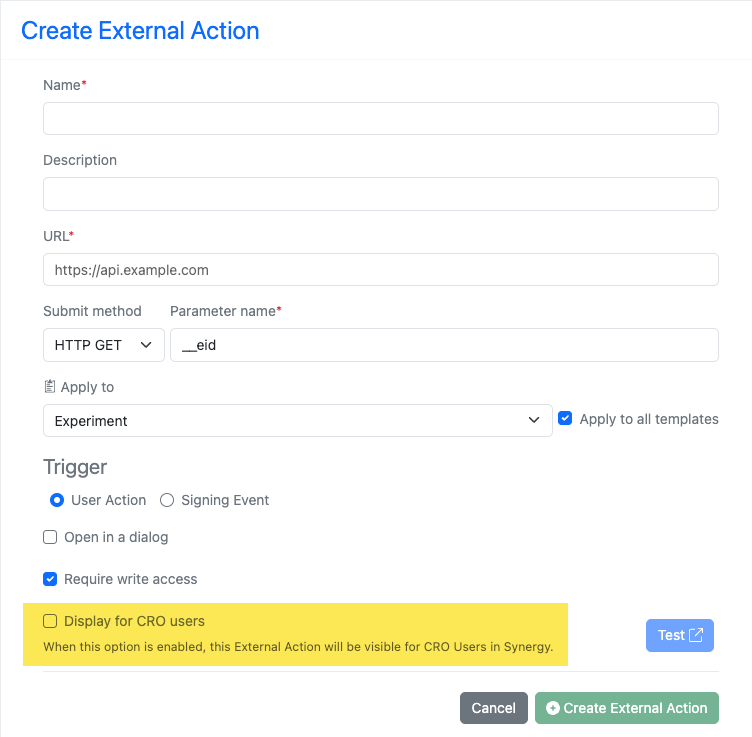
As a reminder CRO IDs can be fetched using GET /synergy/cros.
Additionally, External Actions may now be configured by an Admin to be displayed or not to CRO users similar to External Data Sources. This is specific to each External Action and toggleable during creation or while editing an existing External Action. Existing External Actions and newly created ones will default to not display for CROs.


POST /entity/children/{filename} has been enhanced to allow for using HELM strings for creating child chemical drawings. The content-type should be specified as chemical/x-helm and send a request body containing a HELM string.


POST /materials/{libraryName}bulkImport has been enhanced. You may now specify a reportFormat via URL parameter when creating a bulkImport job: 'FAILURES_ONLY', the report only includes the materials which failed to import. This is the default value; 'DUPLICATES_AND_FAILURES', the report includes the materials which failed to import or duplicated.; 'ALL_RESULTS', the report includes the materials which imported successfully, failed to import or duplicated.
The API now allows for matching the available behavior for report generation via UI.

An API has been added to fetch the report by the jobID returned by the bulkImport request.

A new API has been added to fetch worksheet field definitions via API by a worksheets entity ID. This behaves similar to fetching ADT column definitions.
Further Details
The following capabilities are in beta and are available for users, administrators and developers on the Signals platform upon request. Please contact your account representative or our support team if you would like access to the following features.
AI
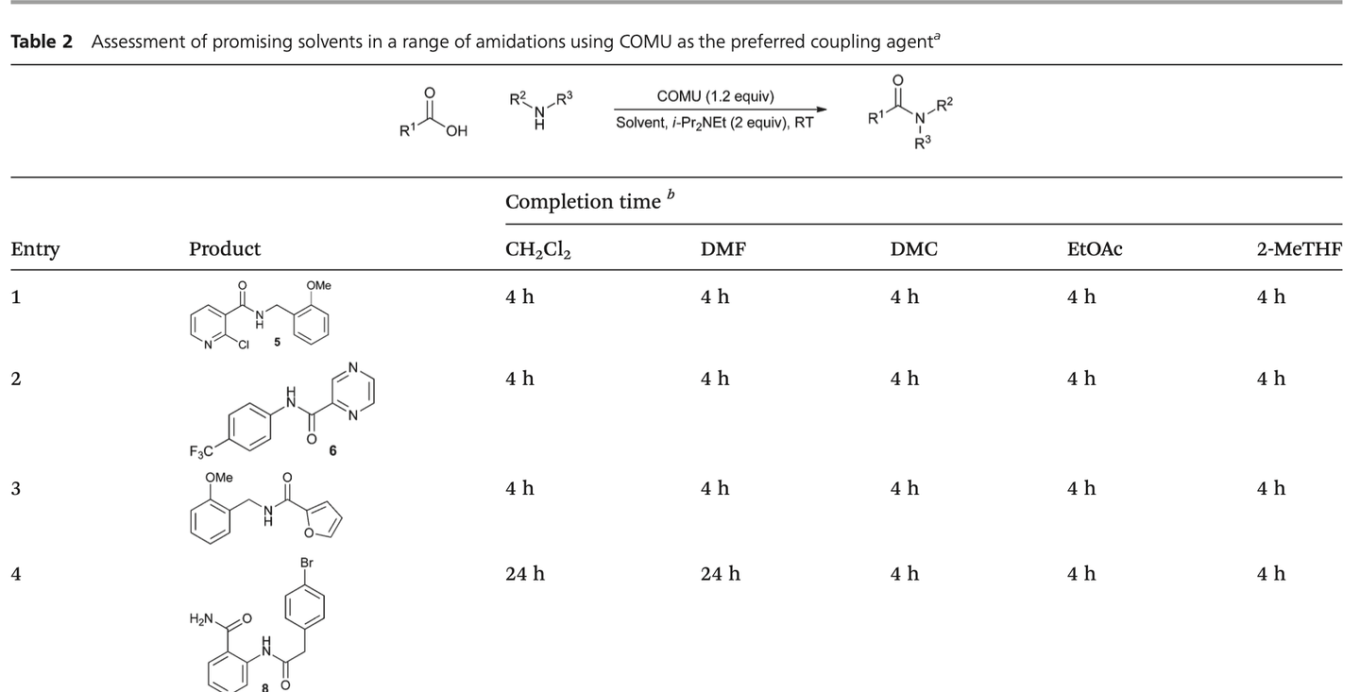
For tenants with a Signals One license, users will now be able to utilize AI to extract and search by text from uploaded Images. This includes files of JPEG, PNG, and TIFF. This will apply to newly uploaded images only. Should a user load an image similar to the one shown here they would be able to search for it using keywords from the image like DMF, DMC, etc.
SAR & Decisioning

As part of the Data Factory beta, enhancements to mapping and reporting are now available.
Data Factory Publication Reports now include downloadable summaries for successful publications, providing key metadata such as file details, project information, and publication date.
The Publish Results to Data Factory app introduces convenient mapping controls including automapping, filtering options for mapped/unmapped columns, and the ability to reset to default mapping
Inventory
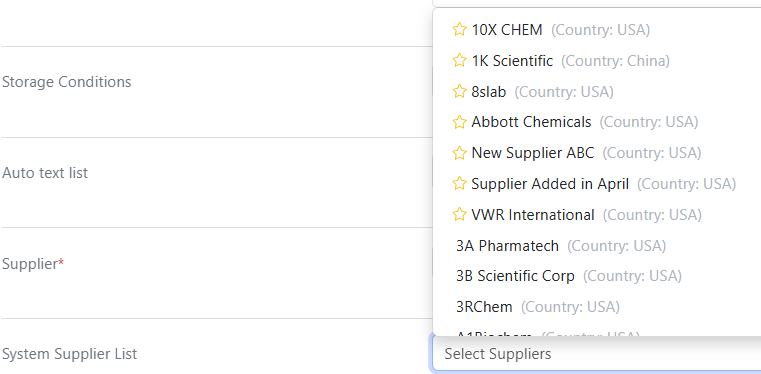
System Supplier List available in new container creation workflow:
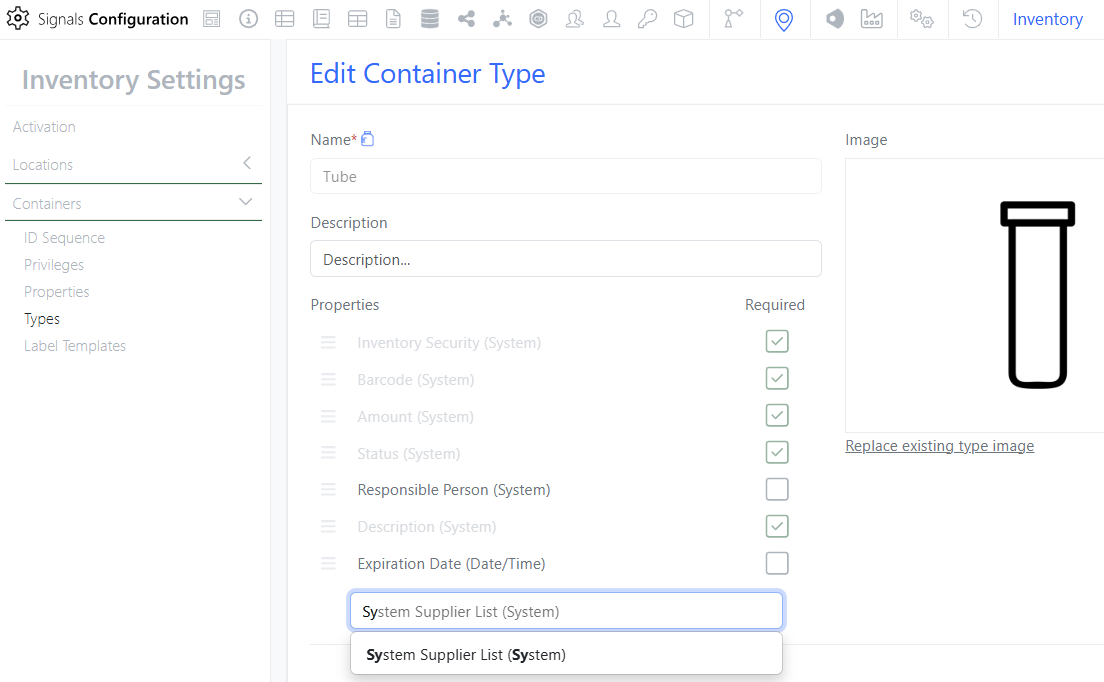
Administrators of existing systems can update the Container Type by selecting the System Supplier List to be added to the Container Type:
What's New
With this version 25.4 release of Signals, we are excited to introduce the new name for Signals Research Suite: Signals One™️. This change marks an important step in our journey toward a more unified, intelligent, and scalable solution. The new name reflects our vision for an integrated end-to-end solution designed to evolve with the future of scientific discovery. This release also includes updates to the Help system, login experience, home page, and app launcher, making it easier to navigate between applications and unlock the full value of the platform.
This release of Signals brings updates to the horizontal view, and management of materials, in Variation tables. We have extended import and export flows to and from Signals Synergy, including a beta capability in publishing table data to Inventa. We have redesigned Order and Internal Request Tables in Inventory, extended the material lineage capability and extended our extraction coverage for the ELN archive. We have extended the utility of autotext, and added calculated product equivalents in the stoichiometry tables. Finally, we have also fixed a number of small bugs.
The following improvements are available for users, administrators and developers on the Signals platform. Certain features may only be available with appropriate licensing and/or with enablement by an administrator.
- Fundamentals
–Updated Help Center
- Synergy
– Bulk create Samples from Designs in Work Order
– Export SDF or CSV (SMILES) of Designs from Data Grid or Designs Table
– Add/Edit Designs privilege
– Warning if re-send Design in Work Order
– Import csv list of Materials or Designs to Work Order Reference Table
– CRO users download Samples Table to CSV/SD file
– CRO users update Samples Table with CSV
– Publish Admin Defined Tables from Synergy Experiments to Inventa (beta)
- Chemistry
– Coordination bonds now behave like dative bonds in chemicals perception
– Product Equivalence included in Product table
- Admin Defined Tables & Variation Tables
–Updates to Horizonal View in Variation Tables
–Select Materials from Experiment in Variation Tables
- Inventory
–1 new label
–Update to Containers Search Table export to sdf
–Redesign of the Order and Internal Request Tables
- Materials
– Filters for selecting nodes in materials lineage viewer
– Show More nodes for entire generation in materials lineage viewer
- ELN Archive
– Support extraction/archive of data from ELN database table fields (dashboard data) for selected ELN section types.
– Support extraction of hidden table columns as visible columns in Signals Notebook.
– Landscape orientation printing supported while Print to PDF in Signals Notebook
- Administration
– Renamed Signals Research Suite license to Signals One
– Admin defined Chemistry Autotext
– Internal Data Sources in Autotext (beta)
- Integrations & APIs
– External Notifications for Containers
– Expanded details when fetching System Attributes
– Assign/Unassign Tasks via API
– Reactivate disabled Users API
– Update Synergy Designs API
– Create Synergy Ideas API
– Bulk Import Synergy Designs API
– SDF Data Export API enhancements
We also fixed several small bugs in this release. Details of the enhancements are described below.
The following OnDemand videos for Signals Notebook End Users are now available
- Chemical Drawing: Drawing for busy scientists
Developers should note that we will have removed the “totalCapacity” and “availableCapacity” attributes from Container entities. These two fields are not used by or visible in the UI and have no functional usage. These properties have long been deprecated and replaced by the singular “amount” property.
Developers should note the isUserDefined flag in the fields object of container details responses will be omitted for the PE_INV_SYSTEM_Amount field (it previously returned false). This change has no impact on functionality.
Administrators should note that rebranding will be seen in default authentication for all tenants including deferred release as of this release. This rebranding is simply revised logos and updated email subjects.
Developers should note that we will be changing the GET/entities endpoint to no longer allow for both “trashed” and “untrashed” items to be fetched simultaneously. The "includeOptions" will continue default to "untrashed" when no explicit parameters are specified. This change will only impact customers who are explicitly setting “includeOptions” to “trashed,untrashed” or any combination including both. This change will occur in a future release.
Administrators are recommended to subscribe to the channels within our support news site found at https://support.revvitysignals.com/hc/en-us/categories/360004446171-Support-News which contains more information about releases and other pertinent product information.
This content is anticipated for release on our Production E3 environments, and for Private Cloud customers on our deferred release schedule, in November 2025.
Further Details
The following improvements are available for users, administrators and developers on the Signals platform. Certain features may only be available with appropriate licensing and/or with enablement by an administrator.
Fundamentals
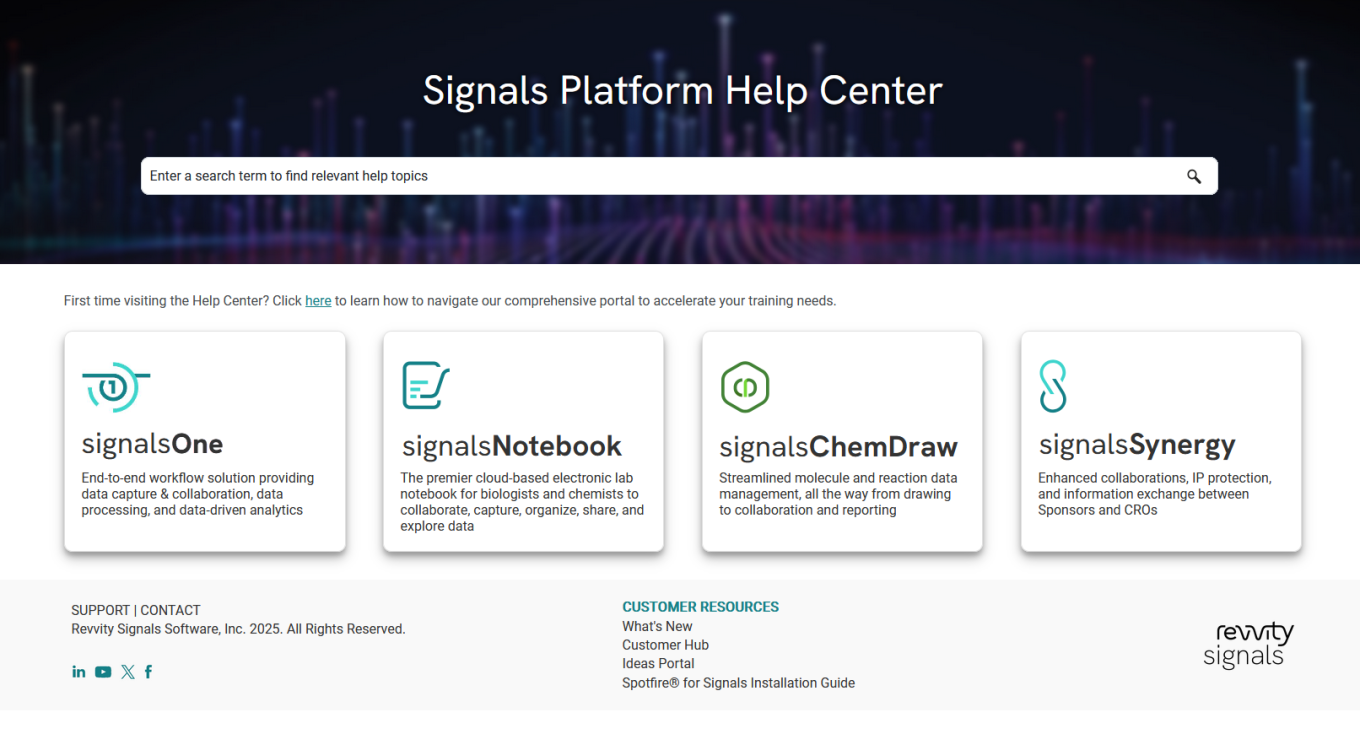
Revised Help Center layout and updates to align with branding.
Synergy
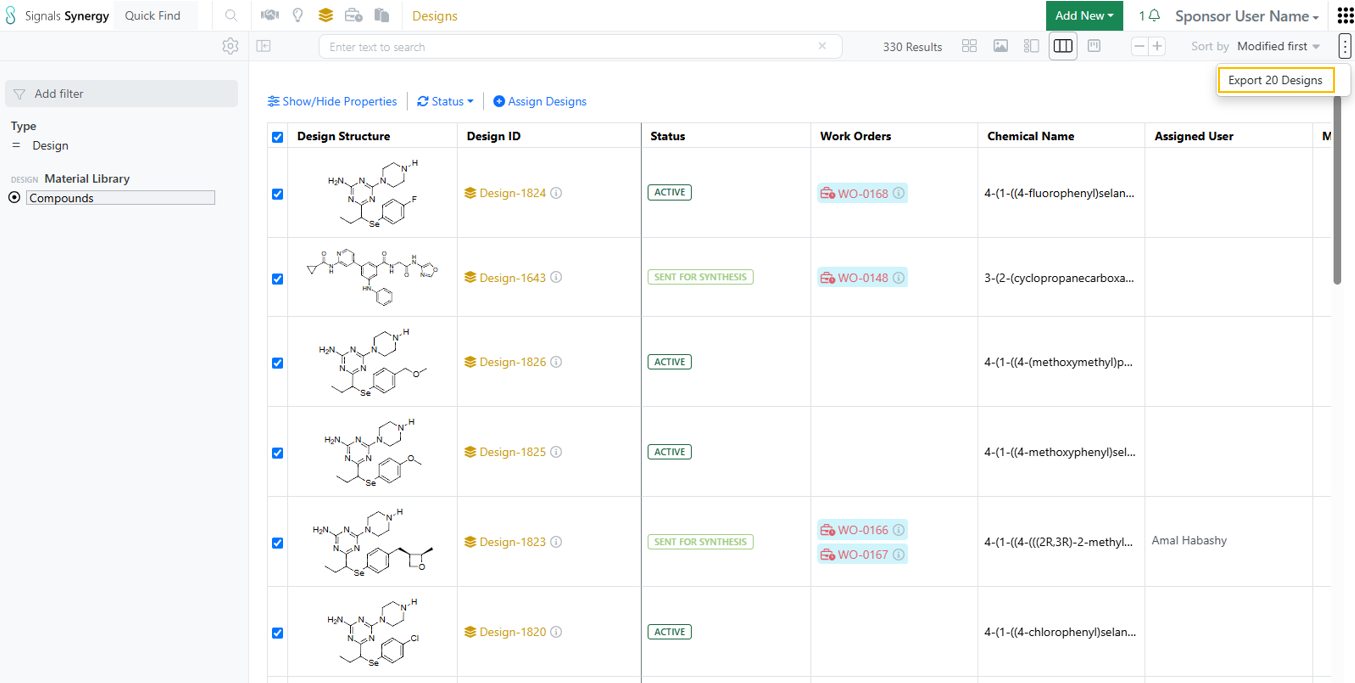
Designs can now be bulk exported to CSV (SMILES) or SD file from the Designs Smart Folder Data Grid, as well as from a Designs Table in an Idea.
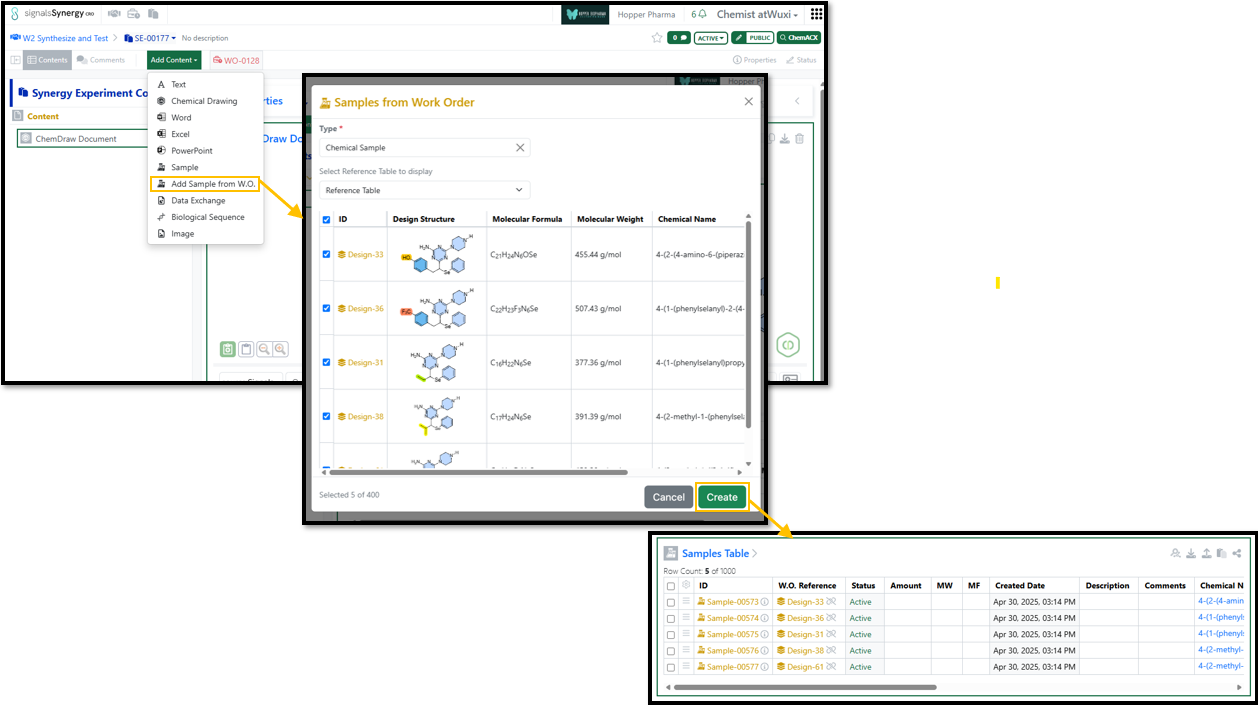
For higher throughput chemistry, CRO users can now bulk create Samples from Designs sent in a Work Order. From inside a Synergy Experiment, the CRO user can use the Add Content > Sample from W.O. menu option to create Samples from all or selected Designs in the associated Work Order. The resulting Samples are automatically related to the Designs, which is then captured as the Originating Design upon future registration from the sample.
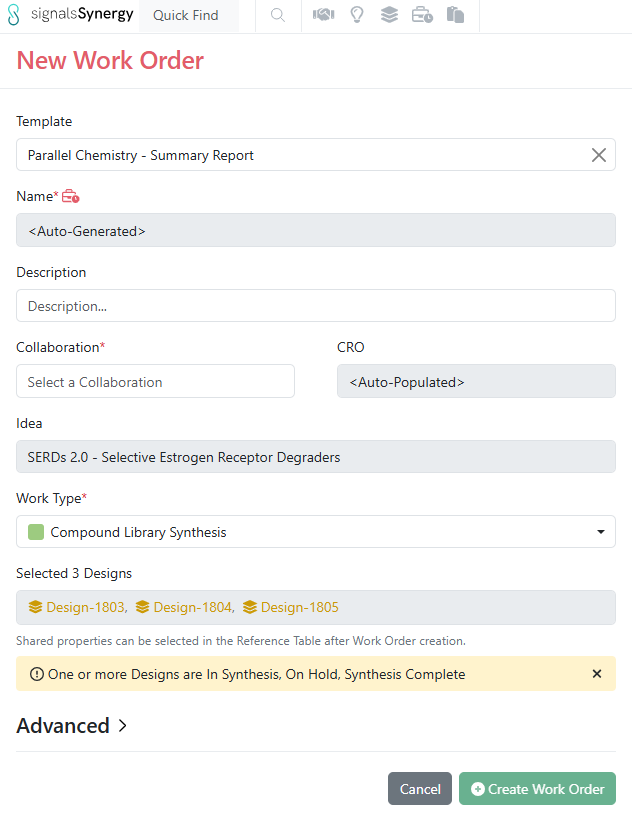
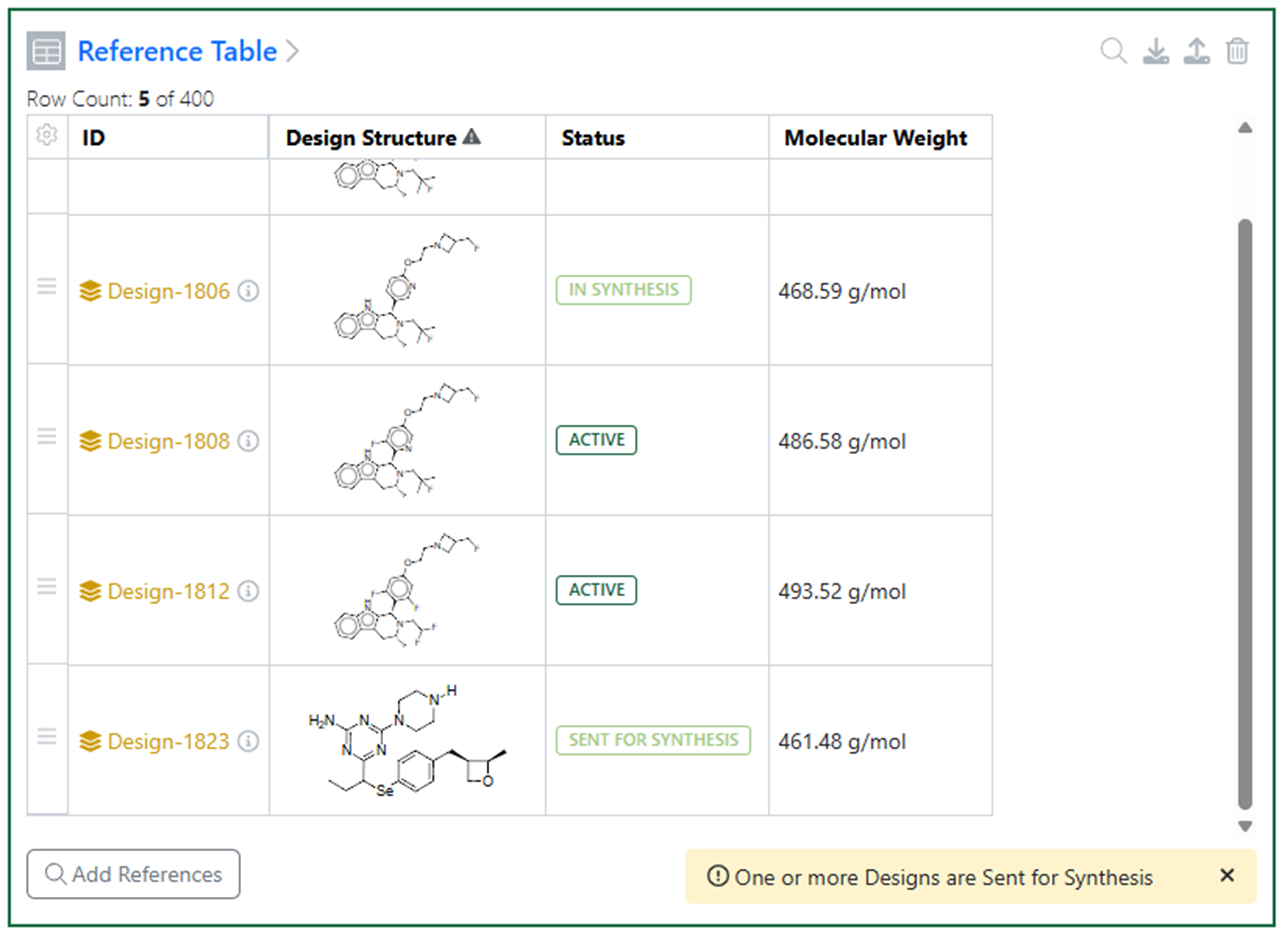
When a Design is added to a Work Order Reference Table, the Sponsor now receives a warning if the Design status is already Sent for Synthesis, In Synthesis, On Hold, Synthesis Complete (registered), or Closed.
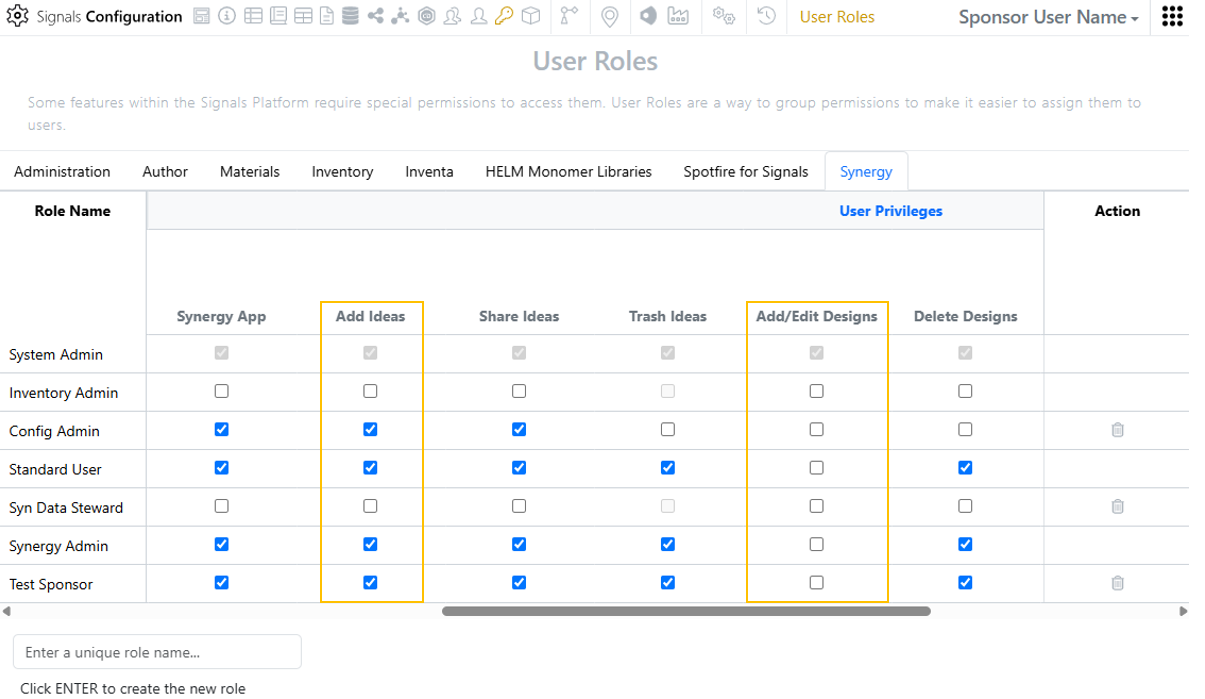
Using a newly split privilege, the System Administrator can now control who can create Ideas versus who can add/edit Designs. Users, such as lead chemists, with the Add Ideas privilege can create new Ideas for projects or groups of chemists, while users with only the Add/Edit Designs privilege can contribute individual Designs or Design sets to those Ideas.

When gathering a large list of test articles for an assay, Sponsor users can now upload a list of assets or batches from a CSV file into a Reference Table in a Work Order.
Regarding Samples in Synergy Experiments, CRO users can now download a CSV or SD file of the Samples Tables, as well as update the Samples Table from a CSV. In both cases, Material IDs are always hidden from the CRO and presented as ExIDs.
Chemistry
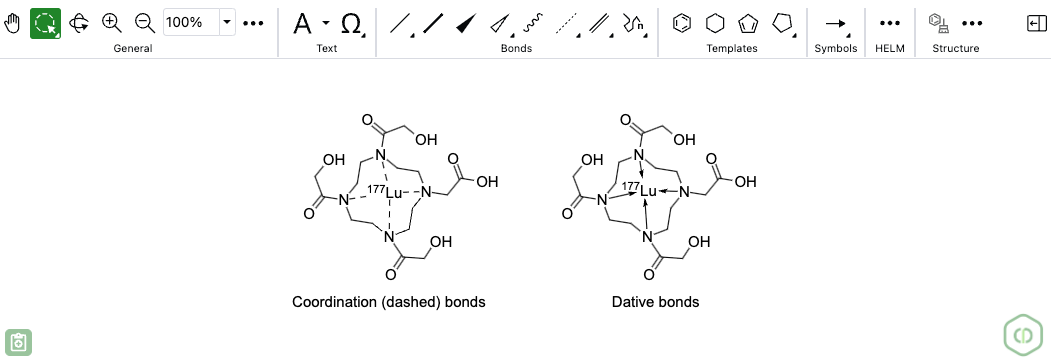
ChemDraw now treats coordination bonds and dative bonds identically, ensuring consistent valence calculations and stereochemical perception for these chemically equivalent bond types.
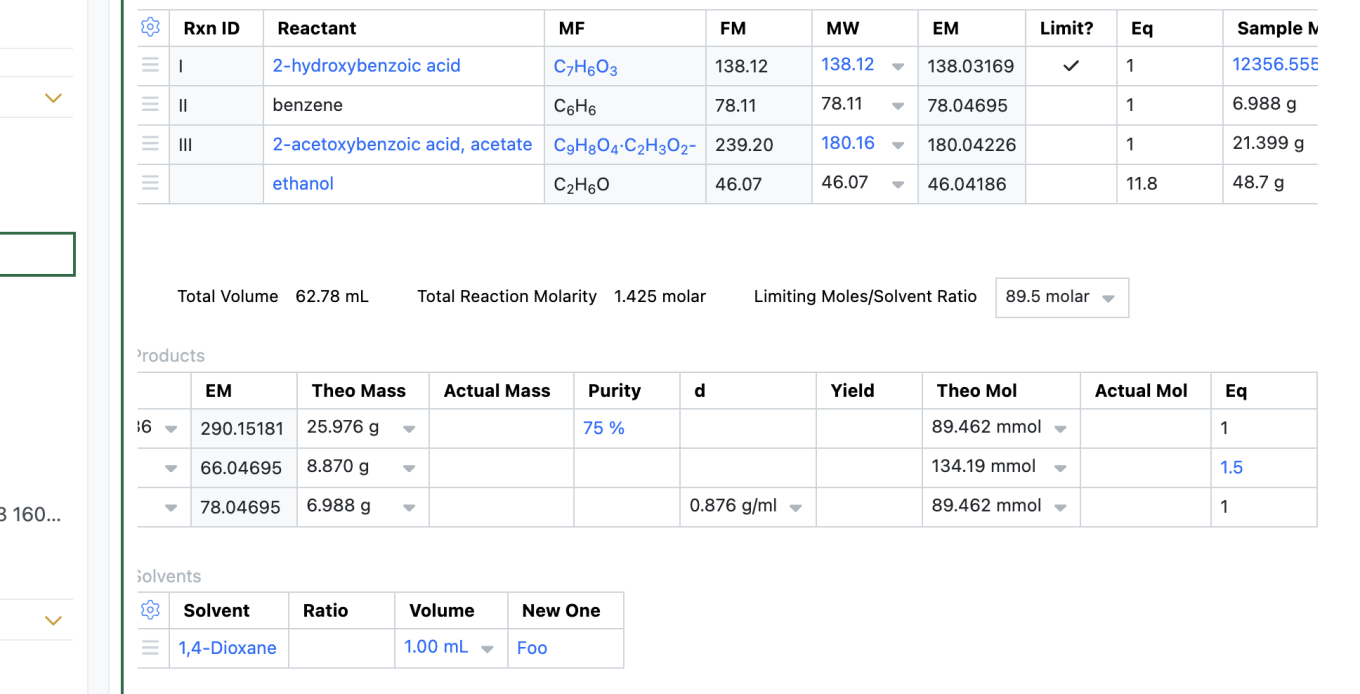
Equivalence (Eq) has been added to the Products table.
Admin Defined Tables & Variation Tables
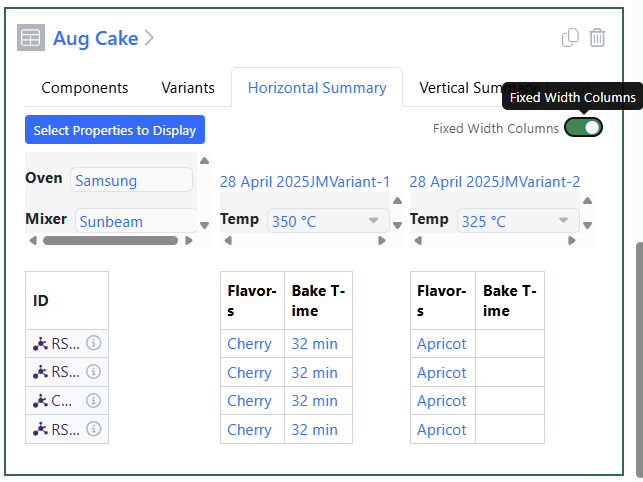
The Horizontal View in Variation Tables has been updated. The component and variant headers are aligned at the top in a grey box. Additional scrolling for the header contents in case the value or the name is long. The Fixed Width Columns selection is at the top right corner for users to control if they want to see a more compacted view.
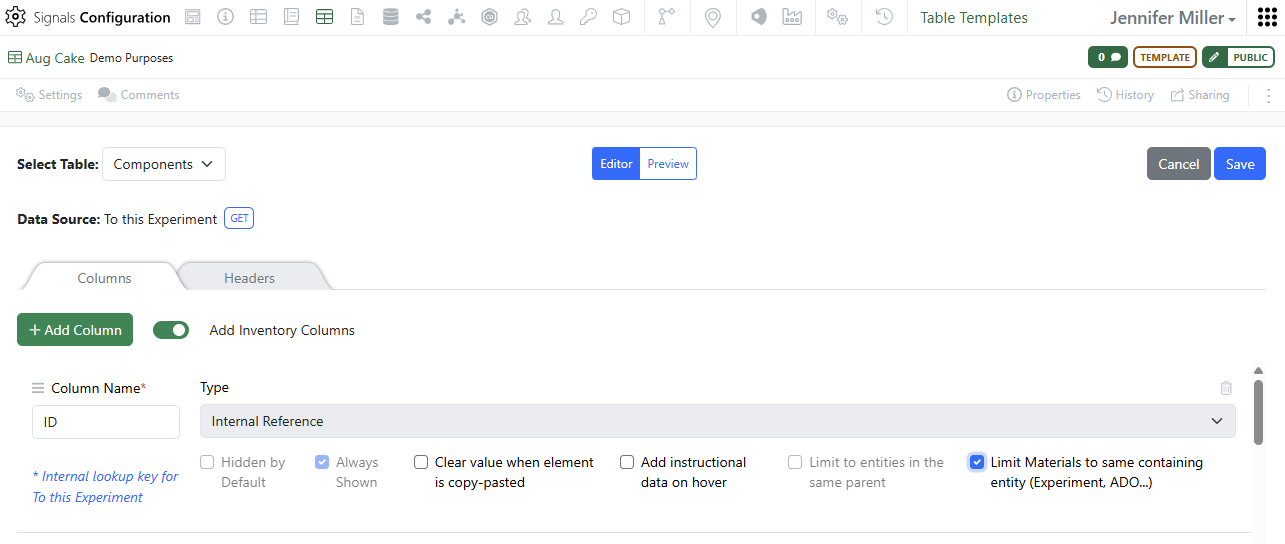
Users can also now select Materials from Experiments. Administrators can choose to give users the option to narrow the search for a given Material to be added to the Variation Table to only the Materials already referred to in the Materials Tables in the Experiment or ADO. In the configuration, the “Limit Materials to same containing entity (Experiment, ADO…) can be selected:
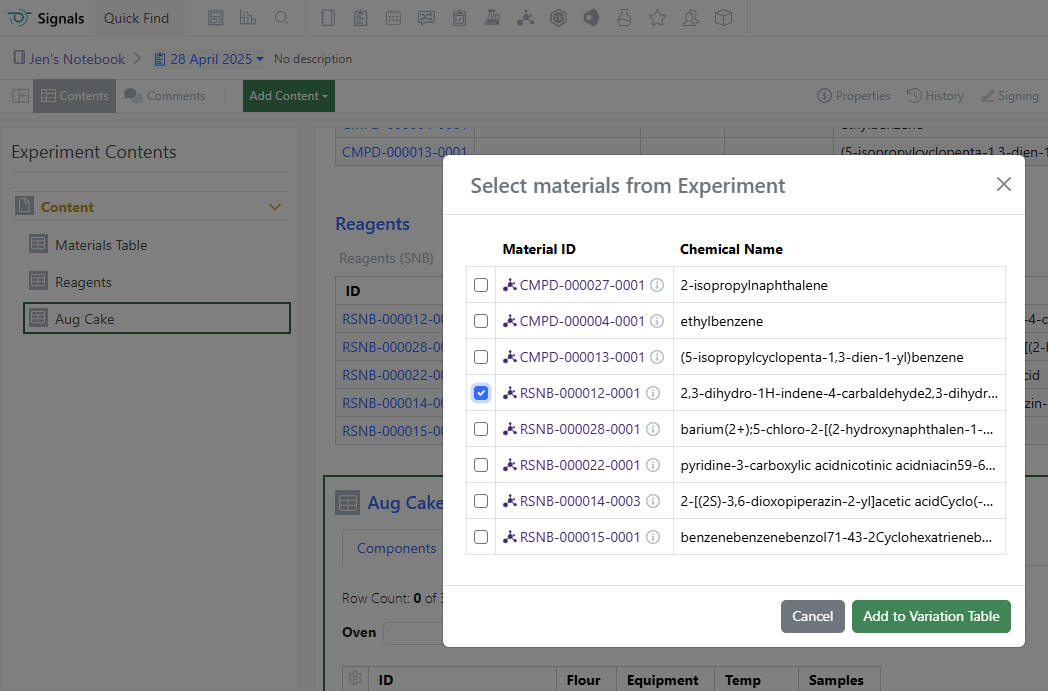

Users will see a new Materials Icon in the Variation Table and it will open a selection window that shows only the Materials previously referenced in the Experiment/ADO:
Inventory
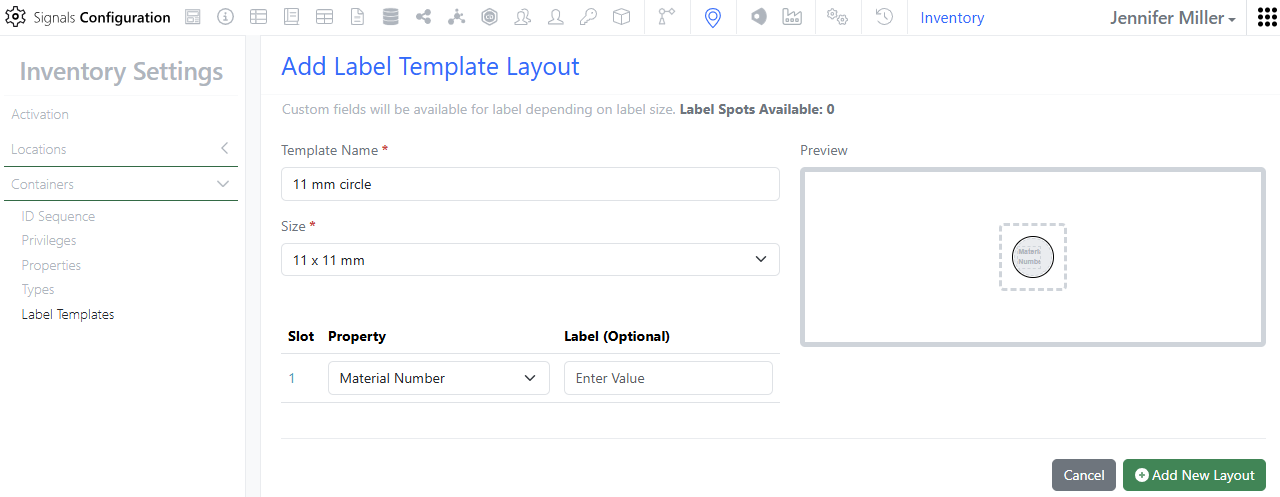
We have added the new label 11 by 11 mm circle with no barcode.

We have also made an update to the Containers Search Table to enable export to SDF. Users with the correct privilege will be able to export containers to SDF.
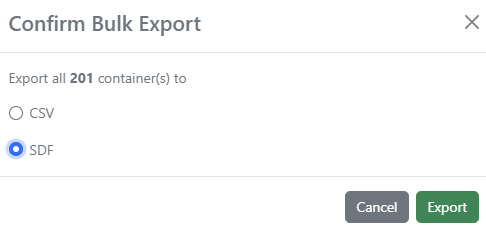
Both CSV and SDF export are supported. Both options will export up to 600K containers.

The export may take some time, and the progress will be displayed at the bottom of the page:

Once the export is completed, users can download the export via the notification or by navigating to the Inventory Bulk Reports under their username:

The export can be viewed/opened in a program that supports SDF type:
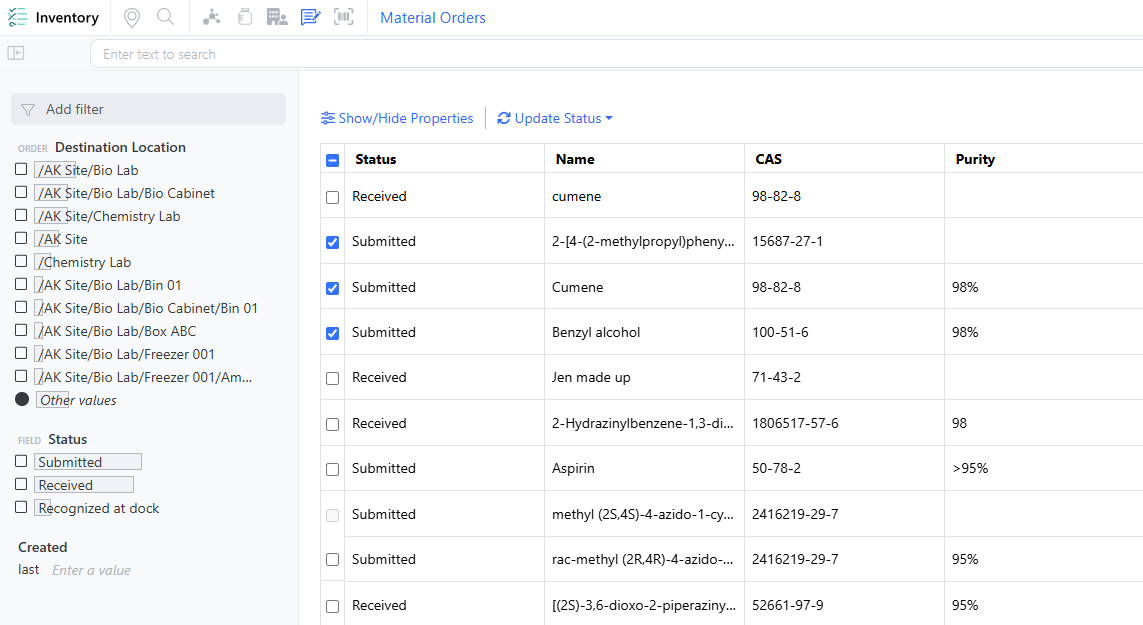
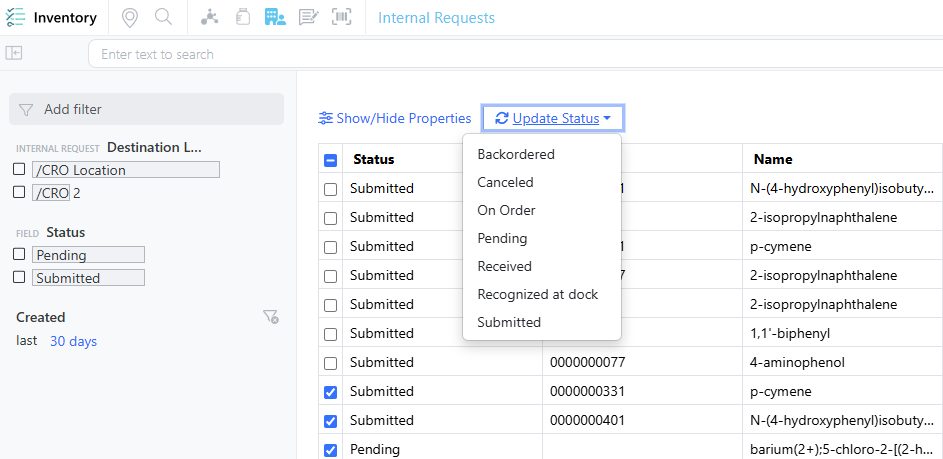
We have redesigned the Order and Internal Request Tables. Order and Request tables work like the Containers Search Table. Show/Hide Properties to add or remove columns that are needed. Add filters or use the provided filters to narrow the results, text search is at the top of the table. Each column header has a filter and sorting option. The “Apply Filters” button has been removed. The Update Status has not changed.
Materials
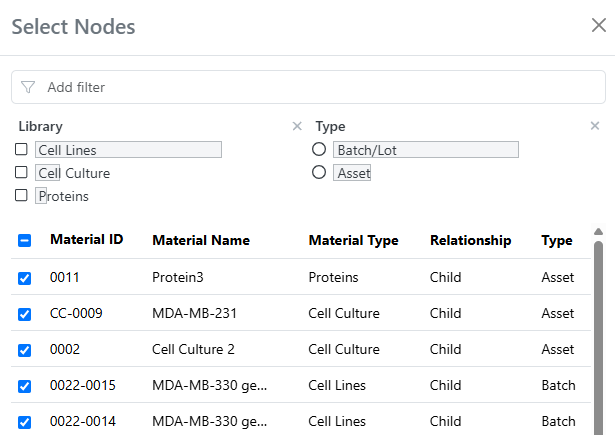
Filters are now available to select nodes of interest in the materials lineage viewer. One or more material property filters can be logically combined (AND, OR) to identify subsets of entities to view.
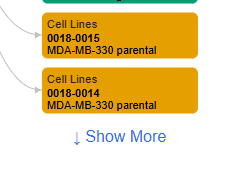
Expansion of multiple parents or children in the same generation can now be performed simultaneously in the materials lineage viewer. Selecting Show More under a column of nodes displays more siblings for all nodes within that generation.
ELN Archive

Users can now extract or archive data from ELN database table fields (dashboard data) for specific ELN section types. This capability allows targeted extraction based on section type, configured through structured entries in the web.config file. Supported fields include: ENStandard9.DBTableField, ENStandard9.DBTableFieldEnhanced, and Metadata Dashboard.

A new key in the web.config file of the Data Extraction Service allows users to control whether hidden table columns are extracted as visible. By default, this feature is disabled (false). To enable it, set the value to true.
Experiments archived from the E-Notebook can now be printed to PDF in landscape orientation, providing improved formatting for wide tables and content.
Administration

The Signals Research Suite license is now renamed Signals One and can be seen in the Users pages within Signals Configuration. The bulk update user file and integrations such as APIs are unchanged.
Admins are now able to manage the chemistry autotext. Under System Settings, there is a new Chemistry Autotext option that allows the admin to select which properties available in the Stoich grid appear in the Chemistry Autotext. Admins are now able to include custom admin defined stich properties in their Chemistry Autotext.
Integrations & APIs
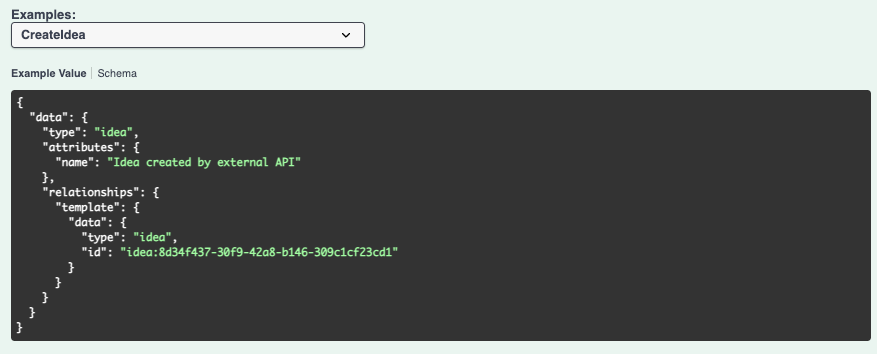
Ideas for Signals Synergy can now be created through the standard entity creation endpoint POST /entities.
Optionally, you can provide a name, description, admin defined fields, and template during creation.

Synergy designs may now be updated via the API.
Update is handled with two new APIs one for the updating of attributes and properties of a design and one for updating a designs chemical structure.
PATCH /synergy/designs/{designId}: This endpoint is used to update the attributes of a design
PUT /synergy/designs/{designId}/drawing: This updates the chemical drawing of a design to a provided chemical structure. The Accepted Formats under Content-Type are: cdxml -> chemical/x-cdxml; mol -> chemical/x-mdl-molfile or chemical/x-mdl-molfile-v3000; smiles -> chemical/x-daylight-smiles or inchi -> chemical/x-inchi.
Synergy Designs may now be bulk imported via the API. This is an asynchronous process with three new APIs to support it. One endpoint to kick off the import, one to check the status, and one to download the report of the import.

Synergy Designs may now be bulk imported via the API. This is an asynchronous process with three new APIs to support it. One endpoint to kick off the import, one to check the status, and one to download the report of the import.
PATCH /synergy/designs/{designId}: This endpoint is used to update the attributes of a design
PUT /synergy/designs/{designId}/drawing: This updates the chemical drawing of a design to a provided chemical structure. The Accepted Formats under Content-Type are: cdxml -> chemical/x-cdxml; mol -> chemical/x-mdl-molfile or chemical/x-mdl-molfile-v3000; smiles -> chemical/x-daylight-smiles or inchi -> chemical/x-inchi.
Synergy Designs may now be bulk imported via the API. This is an asynchronous process with three new APIs to support it. One endpoint to kick off the import, one to check the status, and one to download the report of the import.

This update includes a new API for fetching results from Signals Data Factory for a specific entity in a given project.
GET /api/v1/projects/{projectId}/{entityName}/{entityId}/results. You must provide the project, entityName, and entityId in the request. The maximum results per request is 1000. The response will contain a search ID and ids for each response. Providing these in subsequent requests will allow for pagination, and to only capture data that has comes after the provided id (typically the last id in the response will be used)
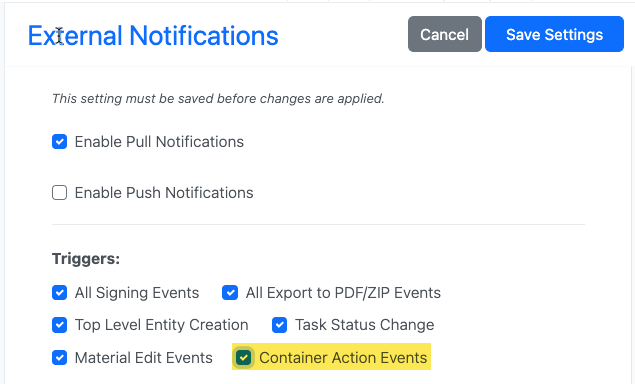
External Notifications have been expanded to include the following actions taken on containers: Check In; Check out; Update Amount; Aliquot Container; Request Container; Dispose
These notifications are available via Push or Pull (via API) based on System Configuration. The behave similarly to all previous notifications and include identifying meta data and basic information based on the action taken.

GET /attributes/{eid}/options has been enhanced to return descriptions of attributes when available. Currently there are only descriptions for a certain System Attributes (i.e Hazard Statements).

Tasks in task tables may now be assigned/unassigned to users or groups via the API.
PATCH /tasks/tasksTable/{tasksTableId}/rows has been enhanced to support two new actions.
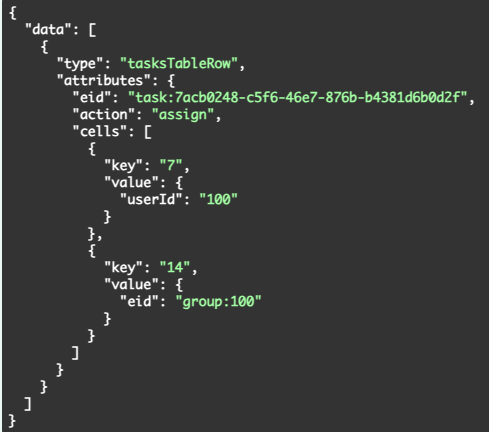
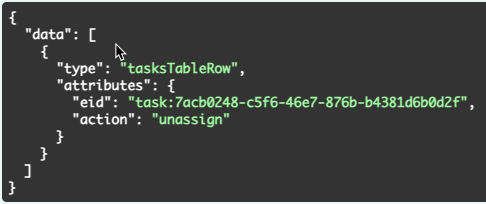
assign: user and/or group is required as part of the request body. These are specified as values for their respective fields on the task entity, fetchable via API: GET /tasks/{taskId}/properties. Completed or Cancelled tasks may not be assigned. Unassign: Completed or In Progress tasks may not be unassigned.

Users may be reactivated via API. This is a new API POST /users/{userId}/reactivate
This requires a User ID of a deactivated user. Deactivated users can be fetched via GET /users with the “enabled” flag set to “false”.
Further Details
The following capabilities are in beta and are available for users, administrators and developers on the Signals platform upon request. Please contact your account representative or our support team if you would like access to the following features.
Synergy

Admin Defined Tables (ADTs) can now be published to Data Factory from Synergy Experiments, similar to the publication functionality in internal Experiments. Properties of the Synergy Experiment, including those that are Hidden from CRO, and columns of the Tables can be mapped to measurement type attributes in a specified Data Factory project and published by the Sponsor user.
Admin Defined Tables & Variation Tables
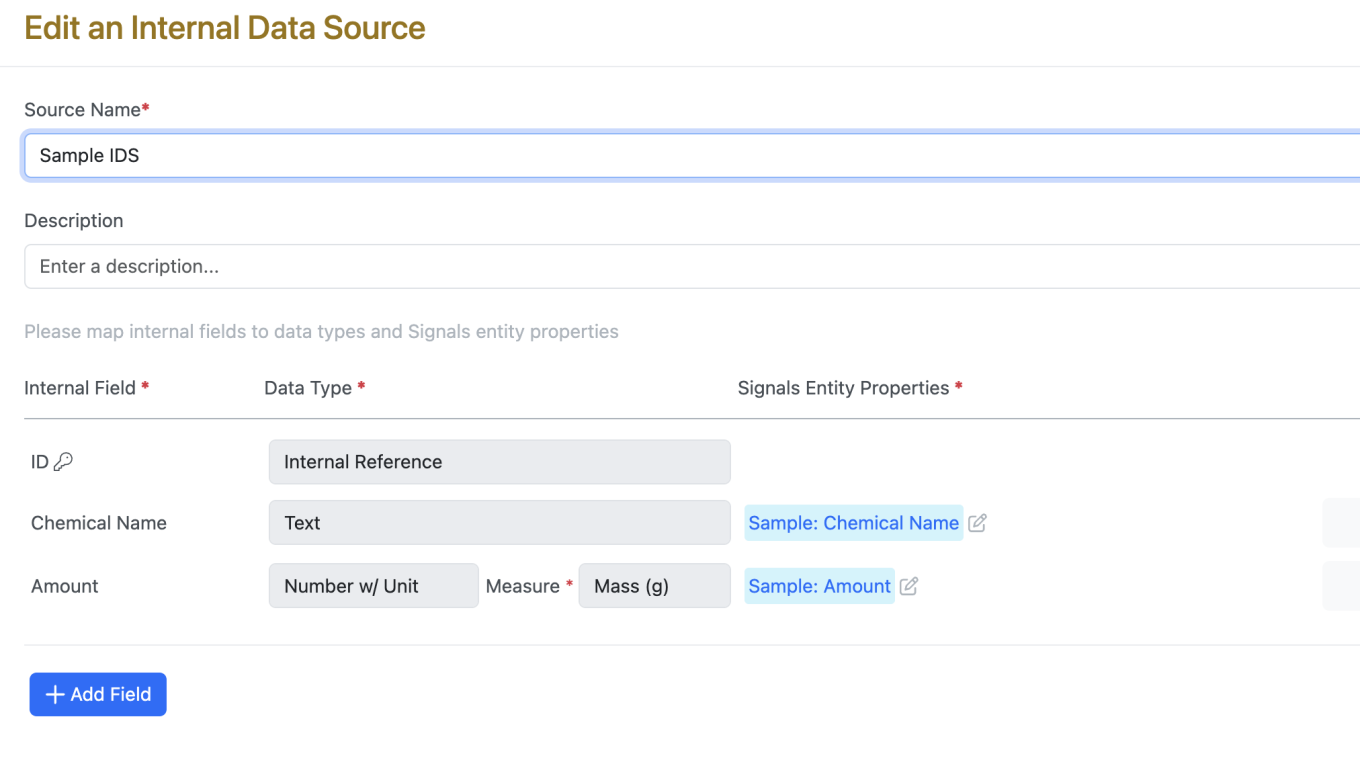
Users are now also able to insert references to internal data sources in the text element similar in format to the chemistry autotext.
The admin should define an internal data source mapping fields that will be included in the autotext parentheses.

Users can insert an internal data source by selecting the new data source icon and picking the data source they intend to use.

Clicking on the blue Internal Data source name allows the user to either enter directly or search for the ID of the entity they want to reference.
Once the entity is selected the ID will populate followed by the mapped fields within the ().
What's New
This version 25.3 release of Signals brings a series of calculation improvements to ADTs, Variation Tables and Samples. We have extended the view of data types in the ELN Archive. We have extended Signals Synergy with duplicate checking on Designs, and improved our Materials handling of containers and sequences. The updated ChemDraw sketcher and the Materials Lineage views are now fully available to all systems. We have continued to work on our ongoing beta capabilities for Signals Synergy and added beta callabilities around publishing Variation Tables, a common Suppliers list, and providing a new architecture for Signals Data Factory. Finally, we have also fixed a number of small bugs.
The following improvements are available for users, administrators and developers on the Signals platform. Certain features may only be available with appropriate licensing and/or with enablement by an administrator.
- Fundamentals
– Spotfire Connector PostgreSQL available
- Synergy
– Custom Work Order templates
– Duplicate checking on Designs
– Designs Import now provides a file report of failed and duplicate Designs
– Share Design Status to CROs in Work Order Reference Tables
– Bulk internal assignment from Designs Smart Folder Data Grid view
– Bulk Design status update from Designs Smart Folder Data Grid view (beta)
– Kanban board view in Designs Smart Folder for Designs synthesis tracking (beta)
- Chemistry
– New ChemDraw editor available to all systems
– Chemical Symbols available to all systems
– Generate complementary strand tool available to all systems
– HELM Auto-pair tool available to all systems
– Show 3' and 5' ends of oligonucleotides available to all systems
– Join tool available to all systems
– HELM in-line annotation support for monomers and polymers
– Biopolymer connections now appear curved instead of sharp corners
– Addition of new property type and Radioactivity parameter to Reactants table
- Admin Defined Tables & Variation Tables
– Publish Variation Tables to Inventa (beta)
– Aggregate and Conditional Aggregate calculations in Headers
– Standard Deviation-Sample calculations
– Row number function
– Addition of padding to a number
– Hide Components in the Variants
- Samples
– Addition of Radioactive Yield as a calculated property in Samples
– Update to Sample Table and Sample Summary Table via csv upload
- Inventory
– 2 new labels
– Update to Containers Search Table column filters
– System Supplier List (beta)
– Move Locations to other locations- including grid locations
– Manage Inventory Attributes separately
- Materials
– Visualization of lineage-parent relationships and batches available to all systems
– Prepopulate name from sequence file during registration
– Disallow Reset of Material Library if Containers exist
– Add Materials to a Material Table and Link to Container later
- ELN Archive
– Support extraction/archive of BioAssay/Structured Data Protocol Definition configuration and display using Primary/Summary Data in Structured Data Viewer from the Signals Notebook
– Protocol and Summary Definition General Field configurations
– Protocol and Summary Definition Graph Templates and CurveFit templates Configuration
– Protocol Definition Analysis Template configurations
– Protocol and Summary Definition Calculation Configurations for fields
– Structured Data – Data loading and pagination
– Support Extraction/archive of E-Notebook Master details table field contents
- Administration
– Update to Hierarchical Attribute lists to allow for children to have multiple parents
– Rearchitected SDF Projects, improved performance with row-level updates, and new methods for project creation and data publication (beta)
– Spotfire for Signals Custom Apps Configuration available for Private Cloud Linux support
- Integrations & APIs
– API Key limit increased to 25
– Additional Chemical Structure formats for Material Import
– New Material Table actions to update/sync with Material Library
– New APIs to fetch Synergy Designs and their Structures
– External Actions available for Synergy Design Tables
– Print Synergy Experiment to PDF API
– New APIs for updating Reference Tables in Synergy Work Orders
We also fixed several small bugs in this release. Details of the enhancements are described below.
The following OnDemand videos for Signals Notebook End Users are now available
- Worksheets - Learn to fill out your Worksheet
Administrators should be aware that the SDF primary API: DELETE /project-service/projects/{projectUid} has been deprecated in favor of the public DELETE /api/v1/projects/{projectId}
Developers should note that with the enhancement to Hierarchical Attribute lists—allowing child options to have multiple parents—there is a minor change in the attribute fetch response. The "hierarchicalOptions" array previously containing only the options not associated with a parent value ("parentValue": "") will now include the full list of options.
Administrators should note that this release of Signals Notebook implements a 7000-atom limit for chemical structure registration and search. With these updates, users cannot submit structures exceeding 7000 atoms as search inputs and structures containing more than 7000 atoms cannot be registered with uniqueness checks in the system.
Developers should note that we will be changing the GET/entities endpoint to no longer allow for both “trashed” and “untrashed” items to be fetched simultaneously. The "includeOptions" will continue default to "untrashed" when no explicit parameters are specified. This change will only impact customers who are explicitly setting “includeOptions” to “trashed,untrashed” or any combination including both. This change will occur in a future release.
Developers should note that we will be removing the “totalCapacity” and “availableCapacity” attributes from Container entities. These two fields are not used by or visible in the UI and have no functional usage. These properties have long been deprecated and replaced by the singular “amount” property. This change will occur in a future release.
Administrators are recommended to subscribe to the channels within our support news site found at https://support.revvitysignals.com/hc/en-us/categories/360004446171-Support-News which contains more information about releases and other pertinent product information.
This content is anticipated for release on our Production E3 environments, and for Private Cloud customers on our deferred release schedule, in July 2025.
Further Details
The following improvements are available for users, administrators and developers on the Signals platform. Certain features may only be available with appropriate licensing and/or with enablement by an administrator.
Fundamentals

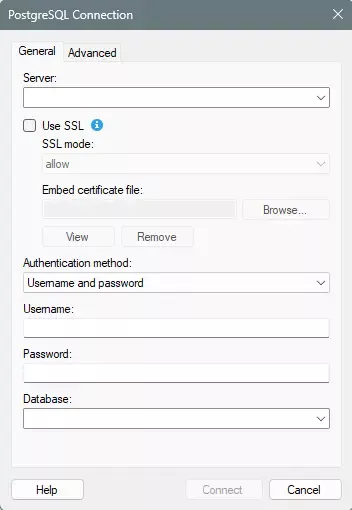
Spotfire Connector PostgreSQL is available within Spotfire for Signals. Data Connection information must be embedded in analysis file. Authoring, editing, and creating new is supported in Spotfire for Signals Analyst while Spotfire for Signals Online can consume existing.
Synergy
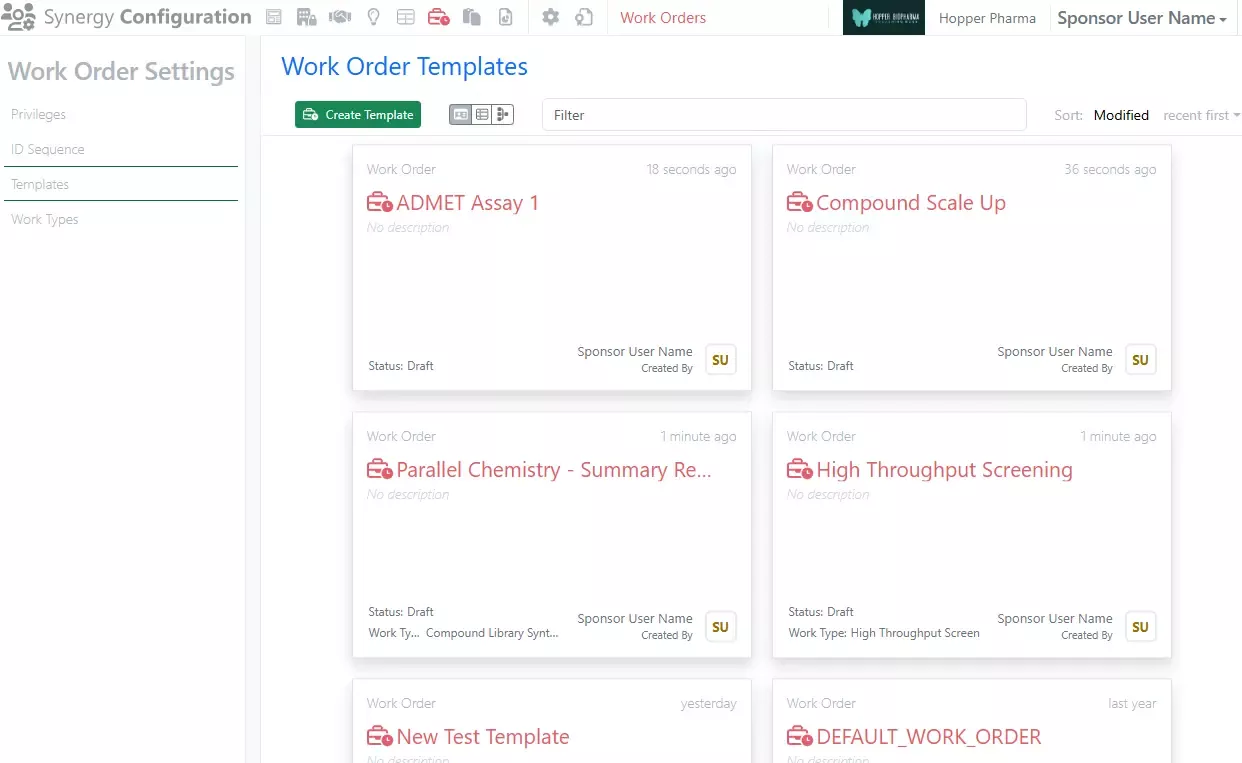
Synergy Administrators can now add custom Work Order templates, allowing for varying Work Order templates for different types of work.

Several enhancements to Design functionality are also included. First, duplicate checking is now available during Design creation and Design import. Designs are compared across all Designs of the same material library using the Uniqueness rules of the library (structure only). During single Design creation, if a duplicate is identified, the user can Cancel or Treat as Unique after reviewing duplicate Designs.

During Design import, the user can specify whether to Don’t Submit Duplicates or Treat as Unique. In addition, Designs import now provides an optional Report of failures, failures and duplicates, or all results.

Design Status can now be shared with the CRO via the Reference Table, allowing the Sponsor to keep the CRO informed of changes. (See beta section for expanded Design Statuses.)

Bulk assignment of Designs to an Internal User (Sponsor) or Internal Group can now be made from the Designs Smart Folder Data Grid View as well as from the Designs Table.
Chemistry

The new ChemDraw editor is available to all systems. This redesigned drawing interface features a dynamic toolbar, enhanced zoom controls, and several new tools. Additionally, it introduces resizable panels for templates, properties, queries, and guided stereo annotations, offering users a more comprehensive and efficient drawing experience.
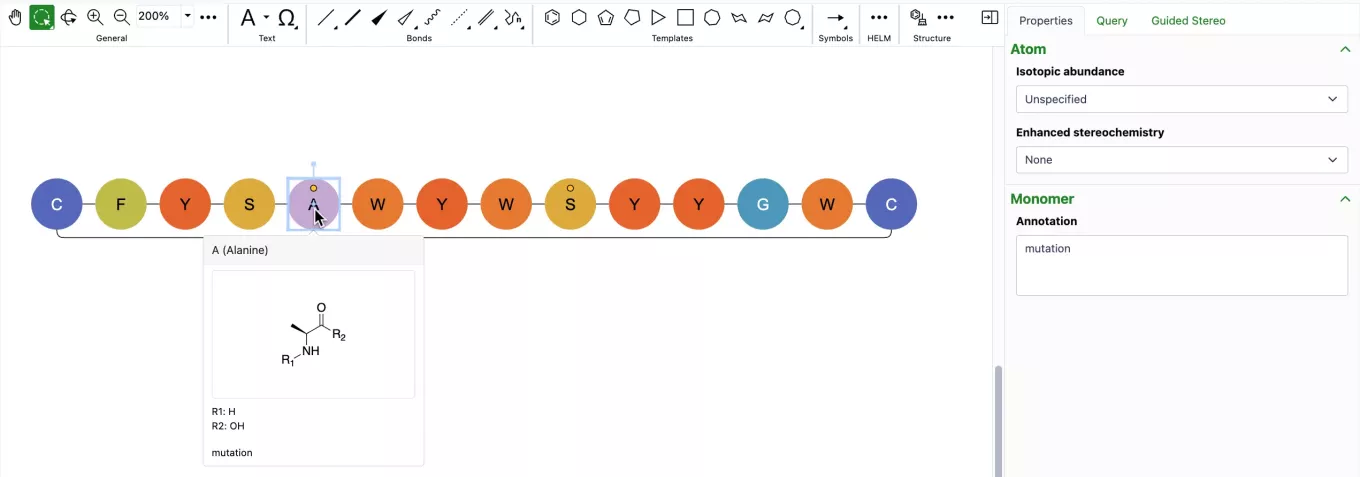
Annotation capabilities are now available for monomers and biopolymers through the properties panel. When a monomer or biopolymer is selected, users can access a new Annotation field in the Biopolymer section, allowing them to add simple text and descriptions to specific parts of their sequence. For annotated monomers, a badge appears on the graphic to indicate the presence of an annotation which is also viewable in the hover-over preview.
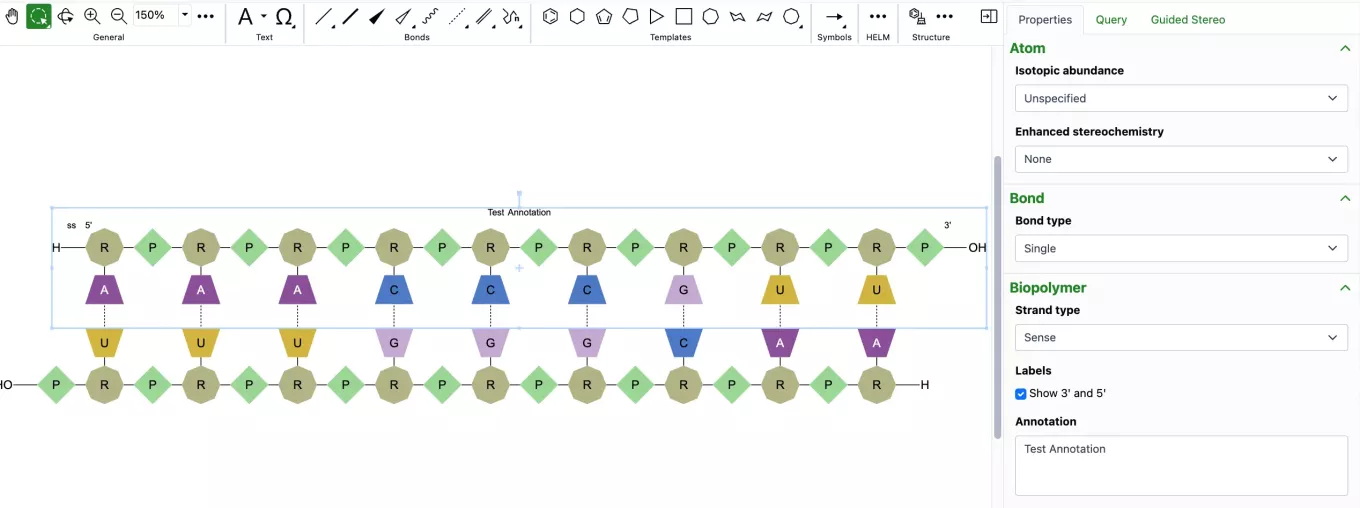
Biopolymer annotations are directly added to the ChemDraw canvas, appearing centered above or below the sequence. These annotations are added as in-line annotations to the HELM string when copied, and can also be imported through HELM strings.


Conditional aggregate calculations in the Header can be constructed using an OVER function, such as AVGOVER, with the format AVGOVER(Arg1, Arg2=Arg3) and where Arg1 is a Number column being aggregated, Arg2 is a Text column being compared to Arg3, when the comparison is true the value is aggregated.
IF functions also allow greater flexibility to operate within other functions, so conditional aggregate calculations can also be enabled using an IF statement inside the aggregate function. Such a nested function would follow a construction similar to AVG (IF(Arg1, Arg2, Arg3) where Arg1 sets up the condition being tested, and Arg2 and Arg3 are the results used if the condition is met, or not met.

A new function, ROW(), has been added to calculate the row number. The function contains no arguments and outputs a number, the function can be used in an equation on a Number or Text property and included within more complex equations. ROW() will be recalculated if the rows are moved or rows are removed.

For cases when the number requires padding, an additional function PADSTART has been added. This function is constructed as PADSTART(Arg1, Arg2, Arg3) where Arg1 is a number that is padded, and Arg2 defines the number of digits the number is padded to. The third argument is optional and allows definition of the character used for padding, if not set then a zero is used. This function will operate only on a property of type Text and can be included in a more complex equation.
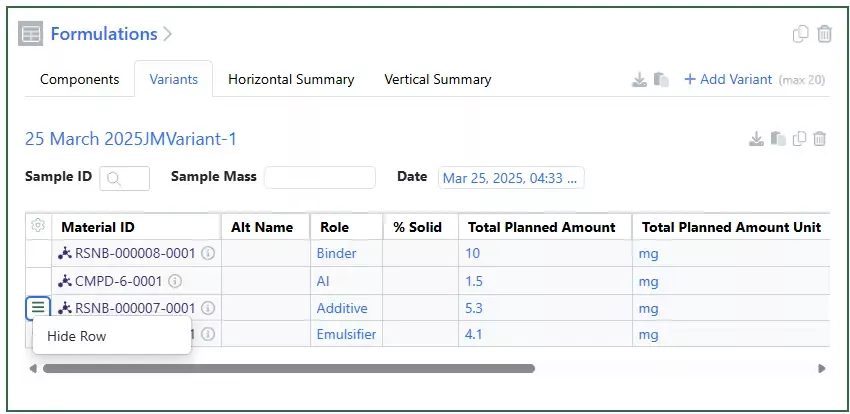
Users are now able to Hide Components in Variants if they do not need all the components for a given variant:
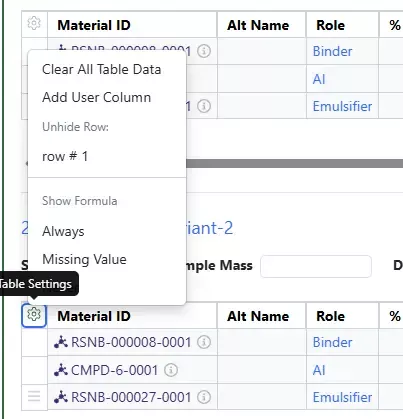
Only rows that do not have user entered data are allowed to be hidden. If users duplicate the variant, the hidden row will remain hidden. To unhide the row, click in the gear icon.
Hidden rows are not part of calculations and will be ignored if used in a row designated calculation.
Samples

A new calculated property parameter, Radiochemical Yield is now available for Samples. The Radiochemical Yield is calculated as follows:
Sample Radiochemical yield = Sample Radioactivity / Limiting Reagent Radioactivity


The Sample Table in an Experiment and Sample Summary Table in a Parallel Experiment can now be updated via csv upload. Samples cannot be added or removed via the csv upload. Only Active Samples will be updated by a csv.
Inventory
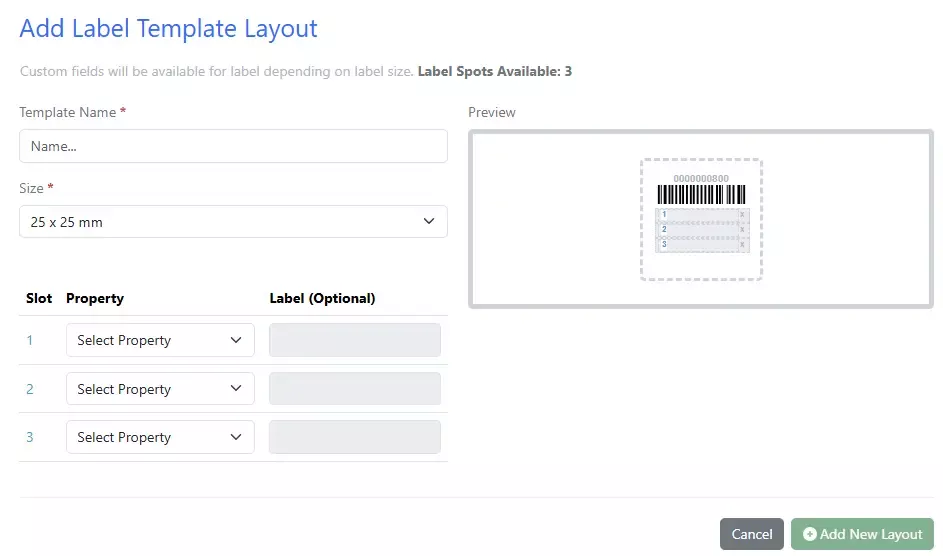
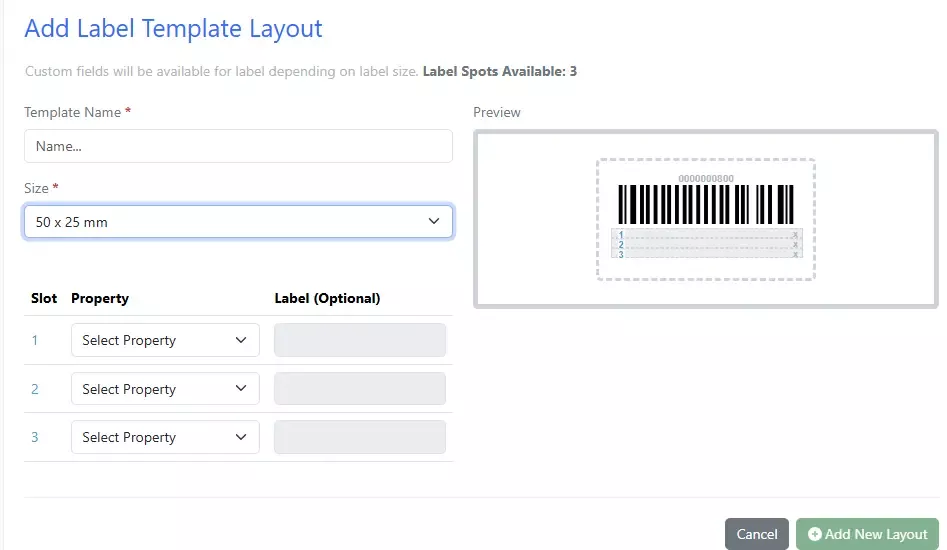
2 new labels are now available for smaller containers: 50 x 25mm and 25 x 25mm
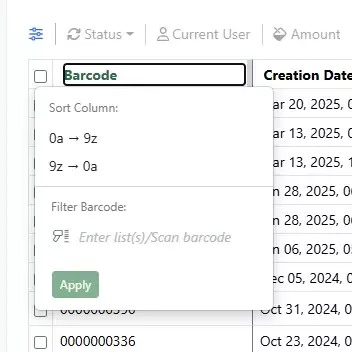
Update to Containers Search Table column filters. An Apply button has been added to all the filter columns so that users do not have to click out of the box/filter for the update:
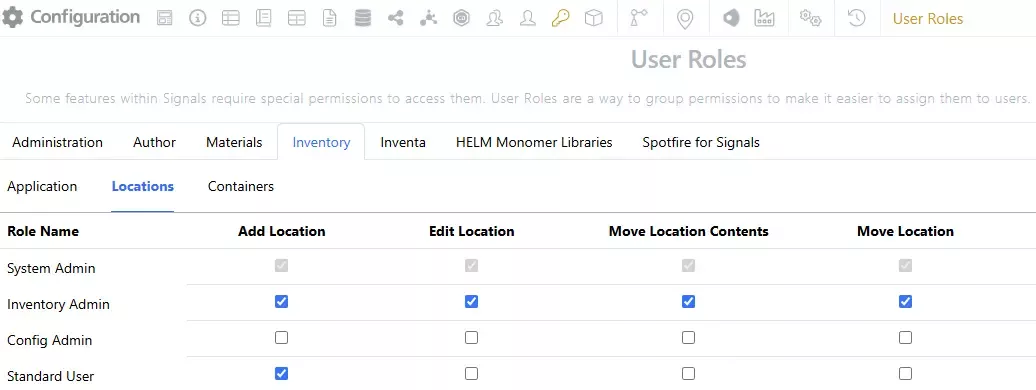
Move Locations to other locations- including grid locations. A new Move Location option has been added to the Inventory. The previous Move Location privilege has been renamed to Move Location Contents and will move the contents of the entire location including the sublocations and containers and is recommended for Administrators only; ex: a freezer breaks, and the entire contents need to be moved to another freezer. The new Move Location privilege is for moving locations within/to other locations and can be assigned to users; ex: user takes a box with containers from the freezer to the bench.
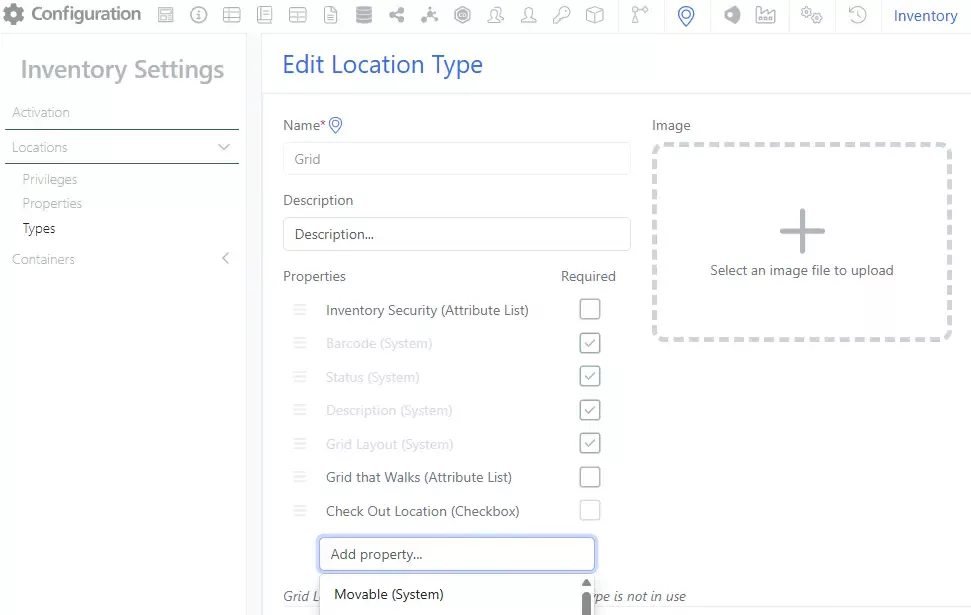
For a location to be considered movable, the Location Type will need to be updated by an administrator to have the Movable (System) property. This update can be done to existing Types or new Location Types.

When a new instance of the Location Type is created, the user will be presented with a checkbox for if this Location should be able to be moved:

This is available for gridded locations and non-gridded locations:

If the location is a movable location and the user has the correct privilege, they will see a Move Location button:

Locations can be found by barcode, type ahead or using the Search icon in the top right corner:
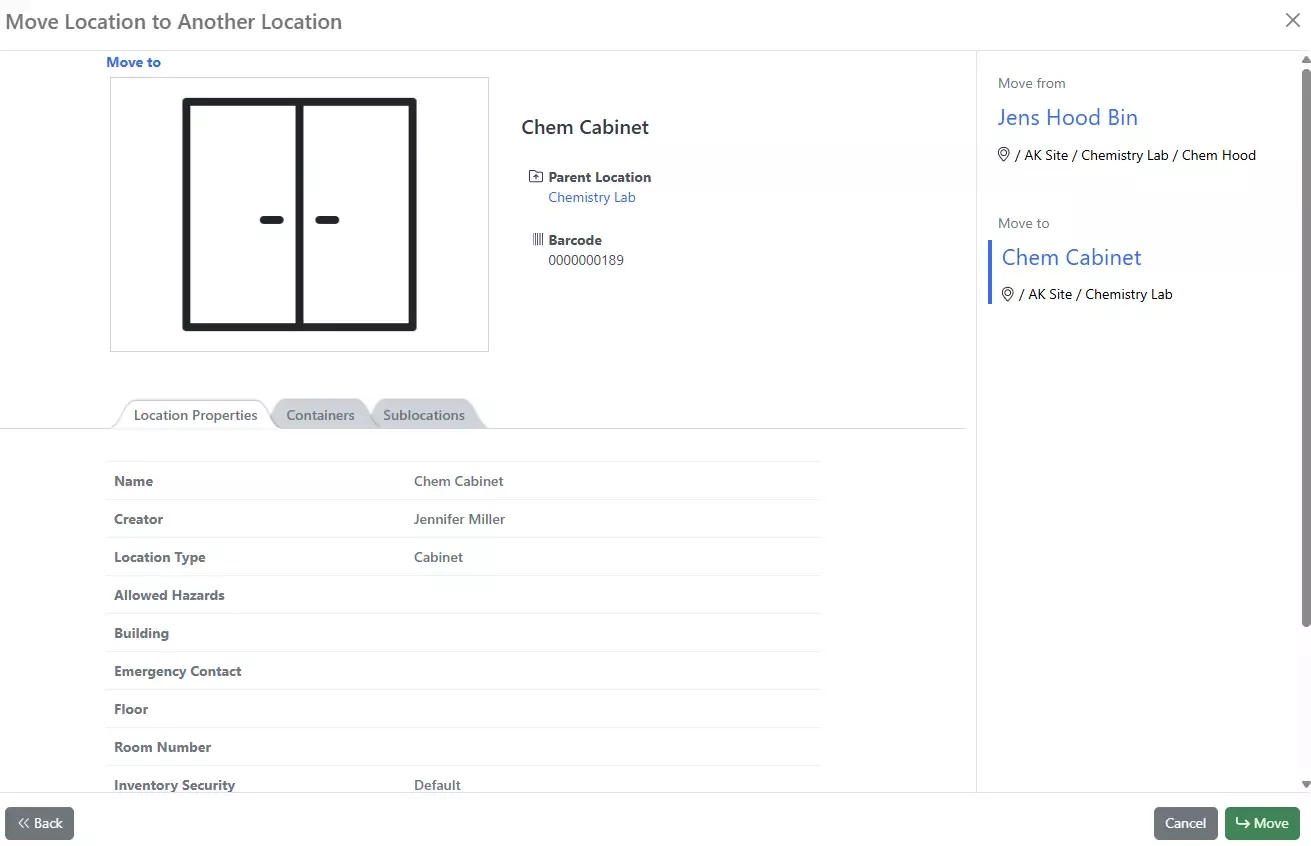
Once a location has been selected the move will be started. This may take a few minutes:
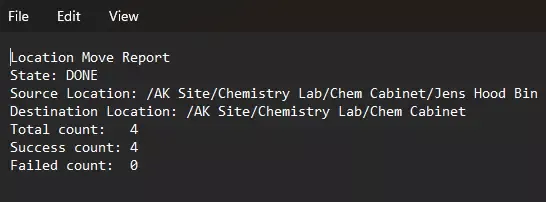
A report will be generated:
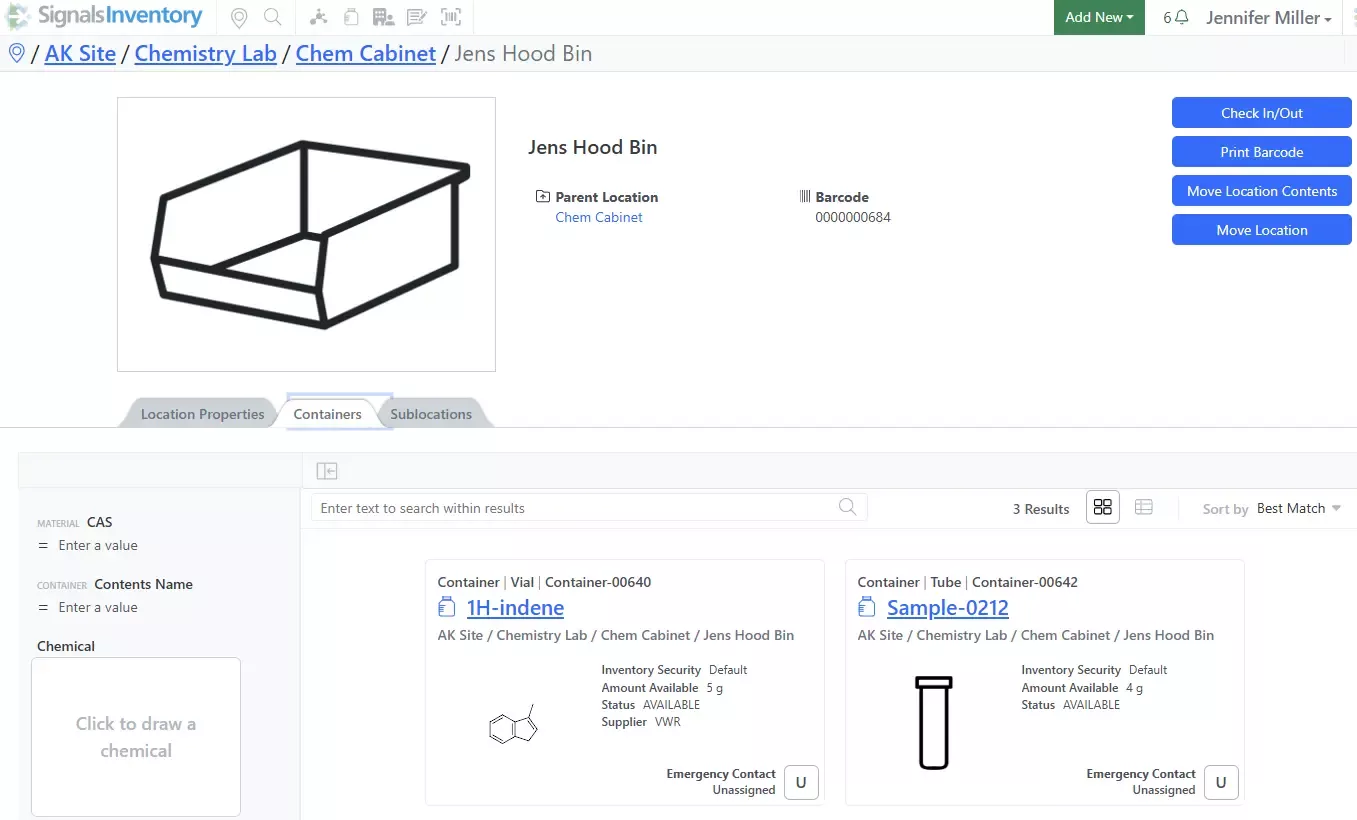
The location as well as the containers and sublocation with containers will be moved:
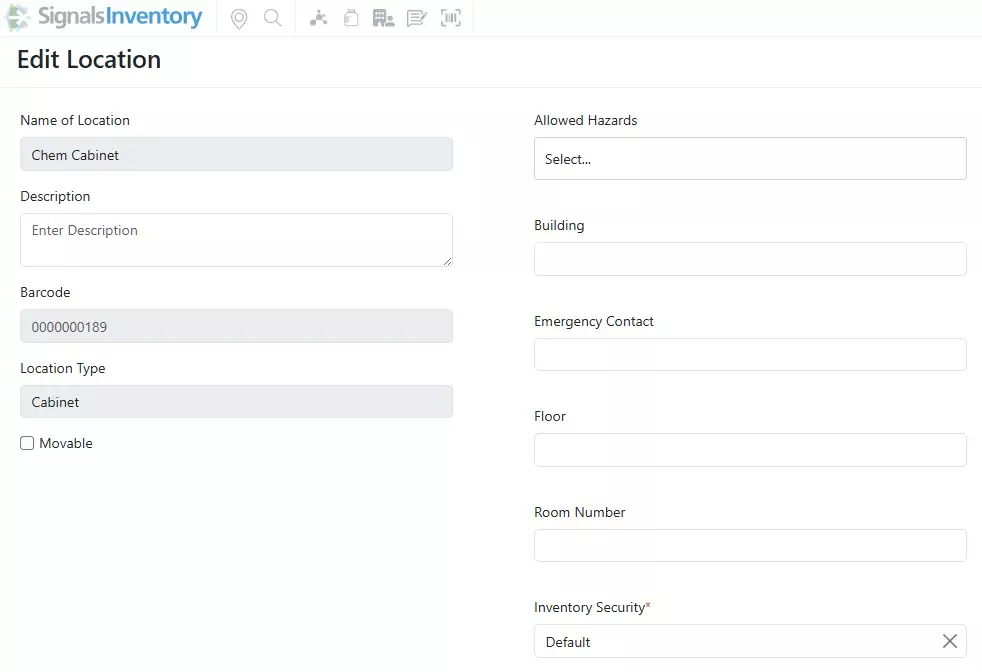
Currently existing locations can be updated by users with Edit privileges to the Location. The Movable checkbox will be available to be updated:

Manage Inventory Attributes separately. For organizations that do not want to give Inventory Administrators control over all Attributes in Signals Notebook, the Inventory Attributes have been separated out and a new privilege called Manage Inventory Attributes has been created.
This will give the Inventory Administrator full control over Inventory Security, Container and Location Library Attributes.
Materials
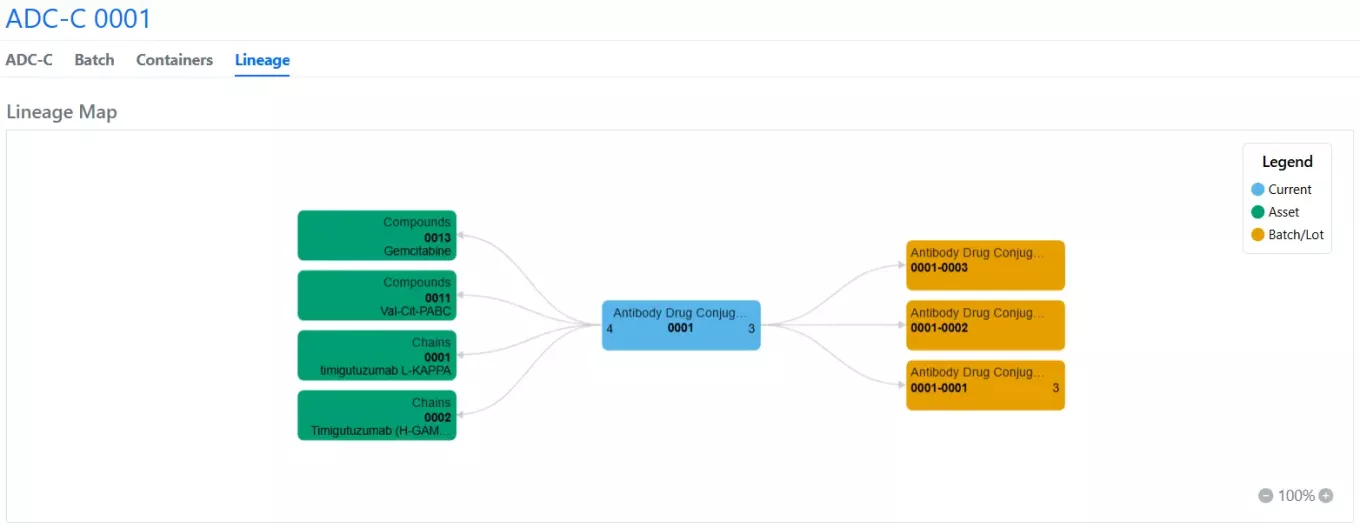
The material lineage visualization feature is now available to all systems. Lineage-parent relationships and batches are displayed in a new Lineage tab to allow end-users to visually explore related entities.
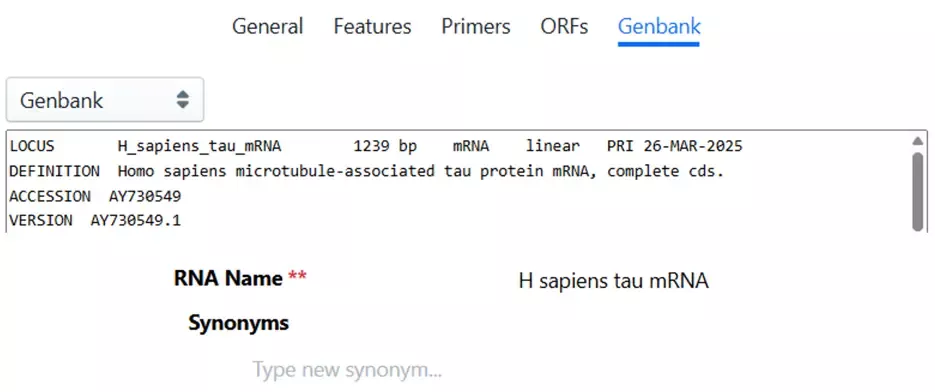
Biopolymer visualization has been refined in this release with the introduction of curved crosslinks and connections, replacing the previous sharp-cornered design. This enhancement significantly improves the visual clarity of complex structures, allowing users to easily distinguish between crosslinks and chemical linkers between monomers.
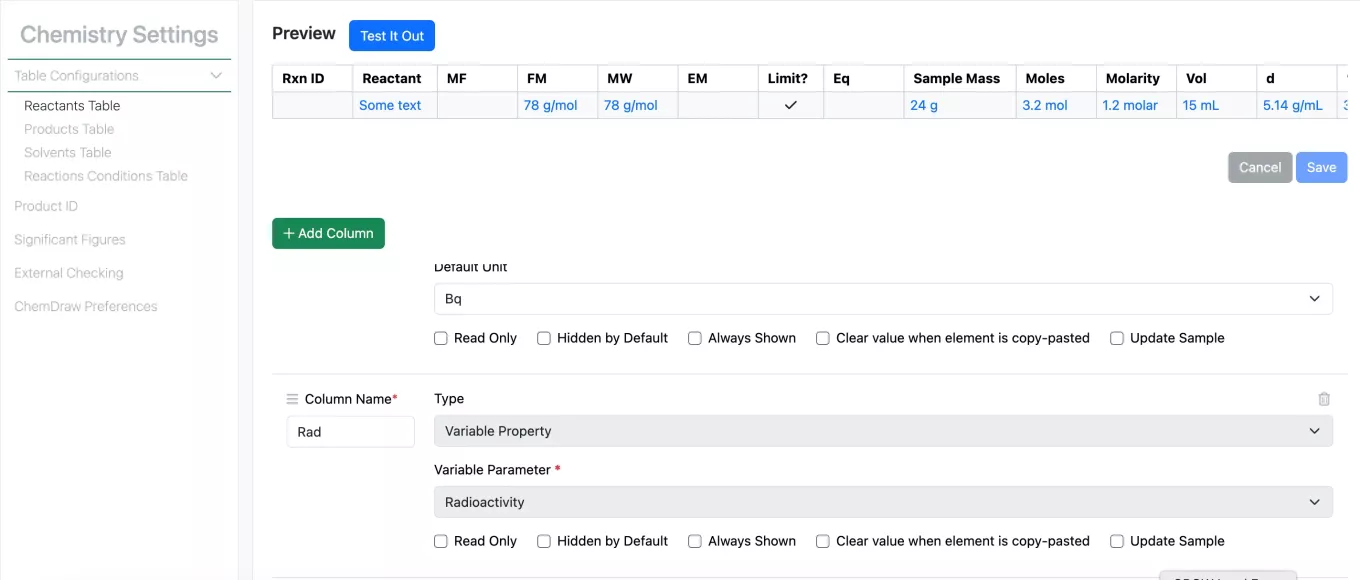
To better allow for calculations utilizing Stoich values a new property type, Variable Property, has been added to the Reactants table. Currently the Variable property includes the Variable Parameter, Radioactivity.
Admin Defined Tables & Variation Tables

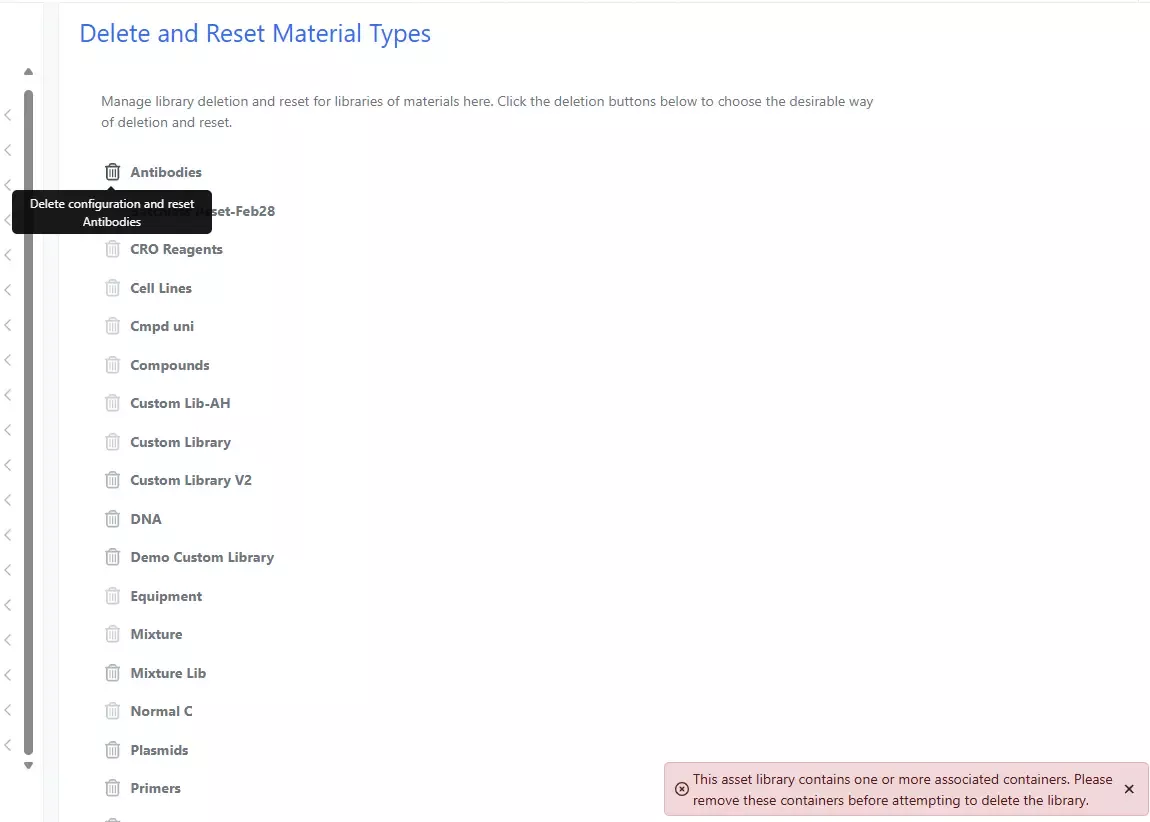
Disallow Reset of Material Library if Containers exist. Administrators are no longer able to accidentally delete and reset a Material Library that has containers associated:

Add Materials to a Material Table and Link to Container later. Users that would like to use the Materials Table for planning before acquiring a container can now select a container at a future time:

Clicking on the Select a container will give users the list of available containers to choose from:

Clicking on the Select a container will give users the list of available containers to choose from:
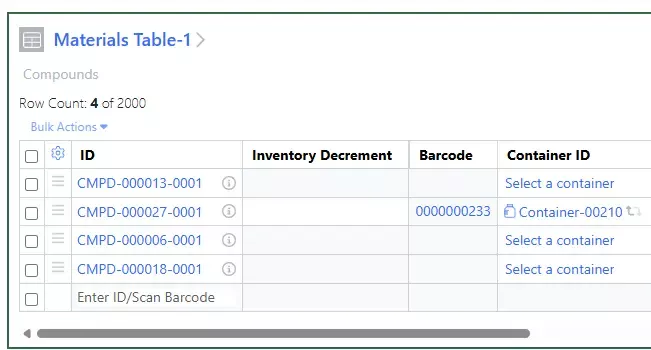
After the container has been selected the Inventory Decrement cell will become active and the icon to switch the container will become available:
ELN Archive
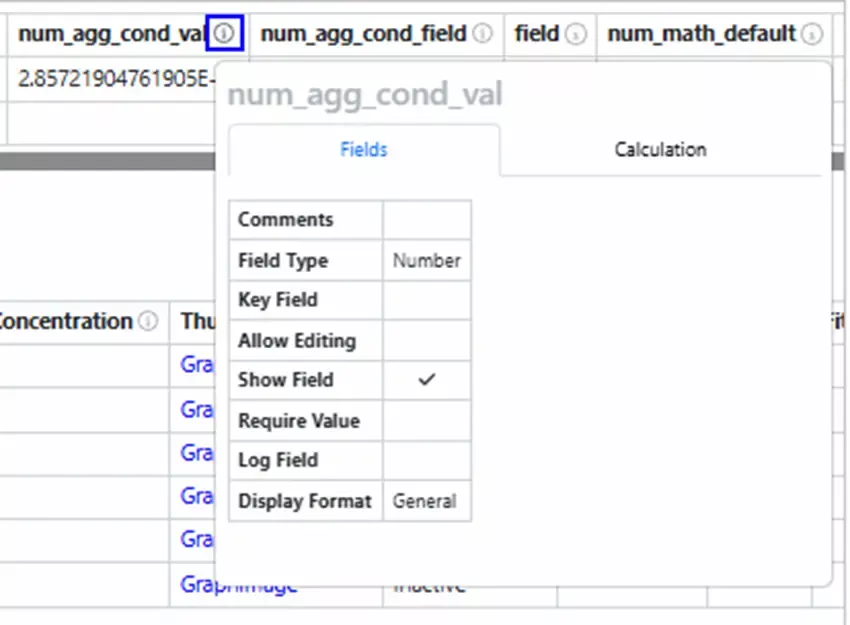
An information icon ("i") now appears next to each column header in the Primary/Summary data section of the Structured Data Table View.
Hovering over the icon opens a popup that shows the field's general settings in a table format.
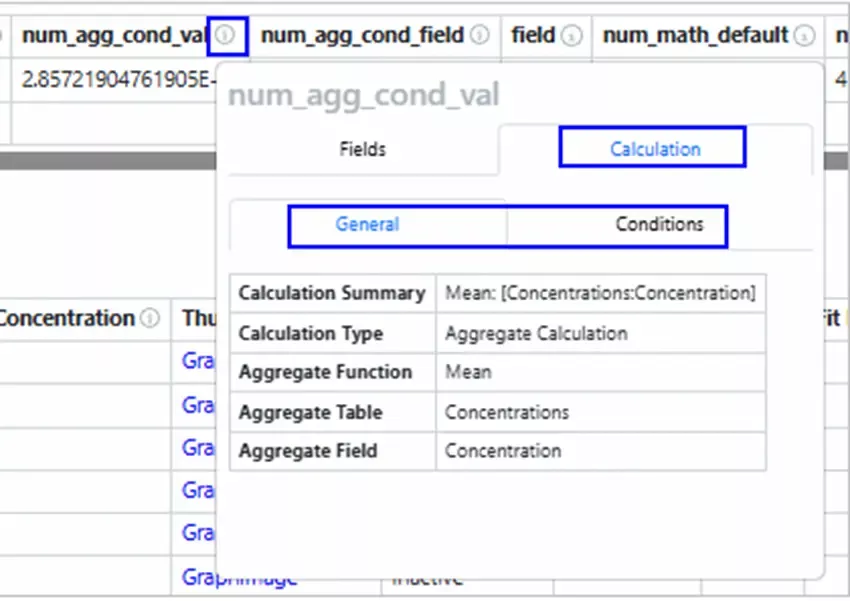
Hovering over the "i" icon next to a field name in the Primary/Summary data section shows a popup with the Calculation tab if there's a calculation, the General configurations by default, and the Condition tab if there are any conditions.
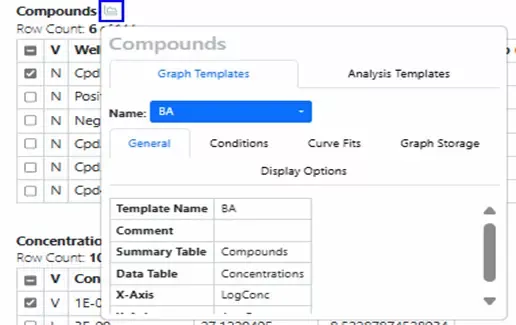
In the Structured Data Table View, a graph icon appears at the table level. When you hover over the graph icon, a popup window displays the Graph Templates configurations.
Note: The graph icon is only available if the table has any graph configuration or analysis template defined.
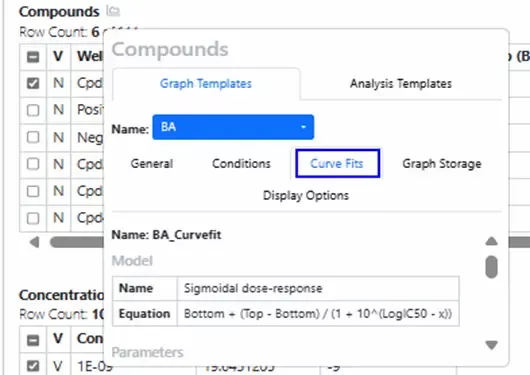
The Curve Fit template information is available in the graph templates configuration pop-up window, under the Curve Fits tab.
Note: Only Curve-Fits used by graph templates can be viewed here.
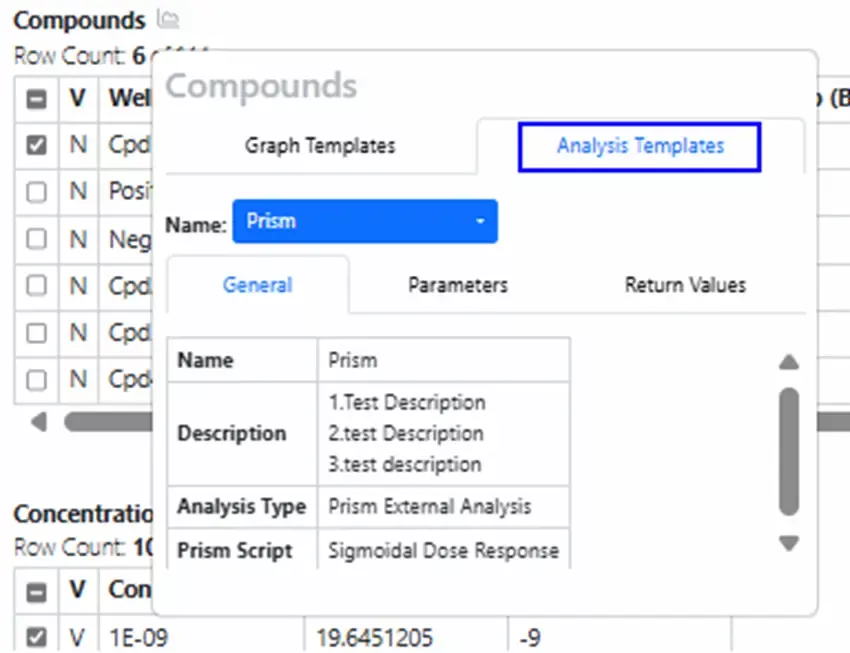
The Analysis Templates information is available in the graph templates configuration pop-up window.
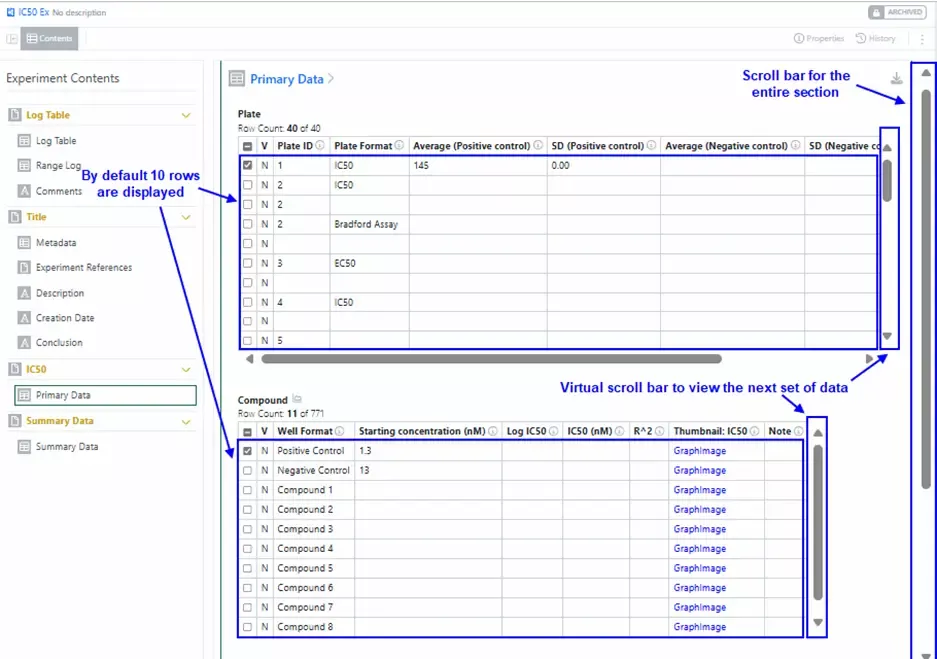
The Structured Data viewer maintains a hierarchical data structure with parent-child relationships. It supports pagination with virtual scrolling for large selections. The default view shows ten rows, with more rows loading via vertical scrolling.
Note: If the Structured Data table size exceeds 20 MB, the Signals Structured Data viewer will display the message “Unable to render the table view due to large content size.” Data will only be available for download as a .csv file.

Support displaying the contents of Master Details table fields in Signals Notebook as table element types.
Administration
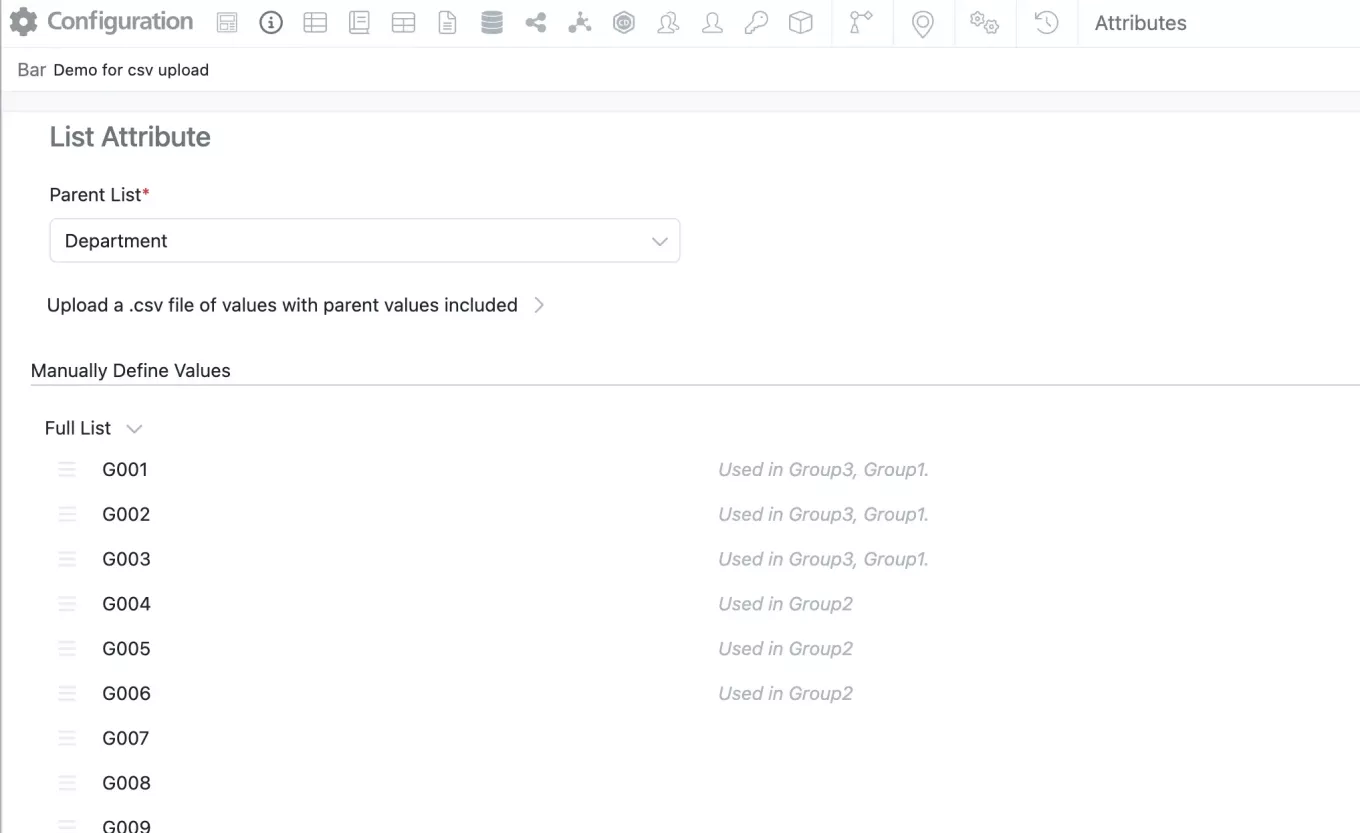
The user experience for administrator managing hierarchical attributes has been updated to facilitate assigning child value to multiple parents.
Admins can now review the full list at the top where each child value has its parents indicated to the right of the value. Values can no longer be dragged from the top list to the parents but values can be reordered within a parent by click and drag. As before new values can be added by typing the value directly into “Add New Value” either in the Full list or directly under a specific parent. If the value is entered under a specific parent it will also appear on the Full List.
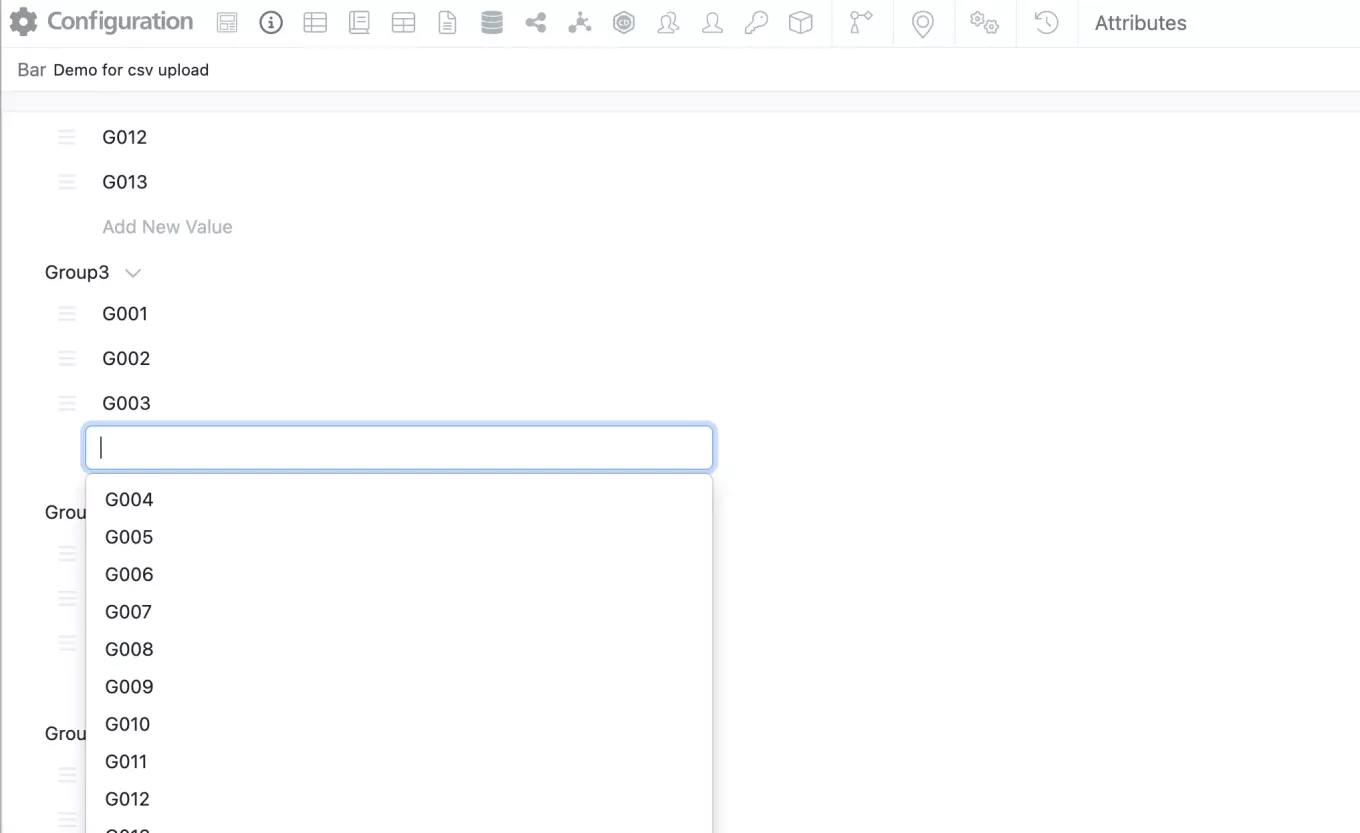
Admins should now be able to add values directly under the parent either from the available dropdown or type-ahead.
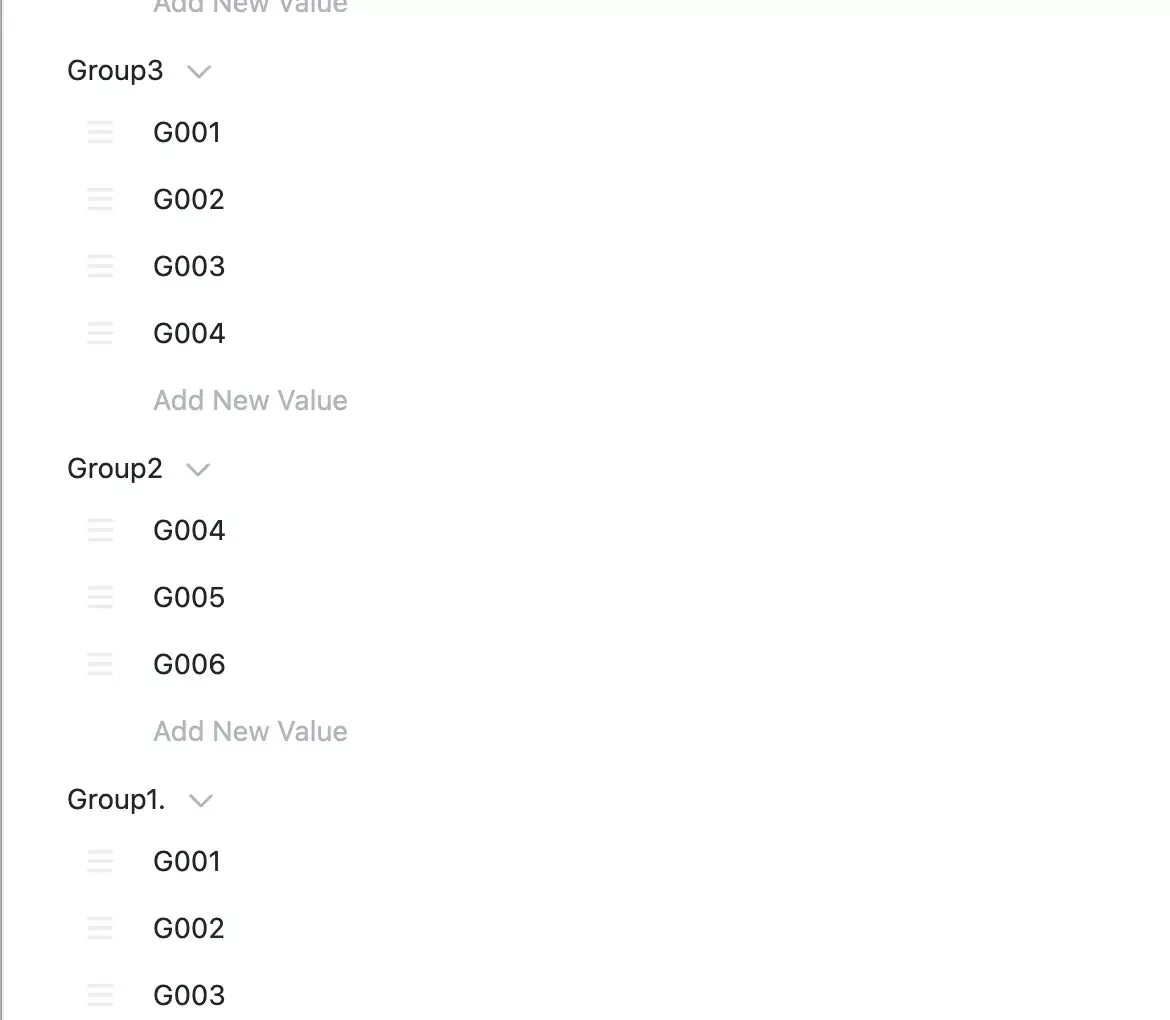
Child values can be added to multiple parents but cannot be added to the same parent multiple times. Values can be removed from a specific parent by selecting the trashcan next the value.
To remove a child value from the list (including all parent lists), the value should be deleted from the Full List.
This new option to assign a child value to multiple parents is also available via csv upload. The behavior of the csv upload is unchanged.
Signals Research Suite Private Cloud environments with Spotfire for Signals Custom Apps enabled now support Linux. Each Custom App requires a Windows and Linux version for full functionality within Spotfire for Signals Analyst and Spotfire for Signals Online. Deployment now allows selection but still fully replaces current deployment. Audit Log specific to Spotfire for Signals Custom App Configuration now available.
Integrations & APIs

Synergy Designs can be fetched via a new API endpoint /synergy/designs/{designId}. This will contain a JSON detailing the attributes, fields, field definitions and other related data for a design. This will not download the chemical structure of the design.

The chemical structure of a design can be exported via the existing entity export API. The format to export in is specified as a URL parameter with the same options available as other existing entities with chemical structures.
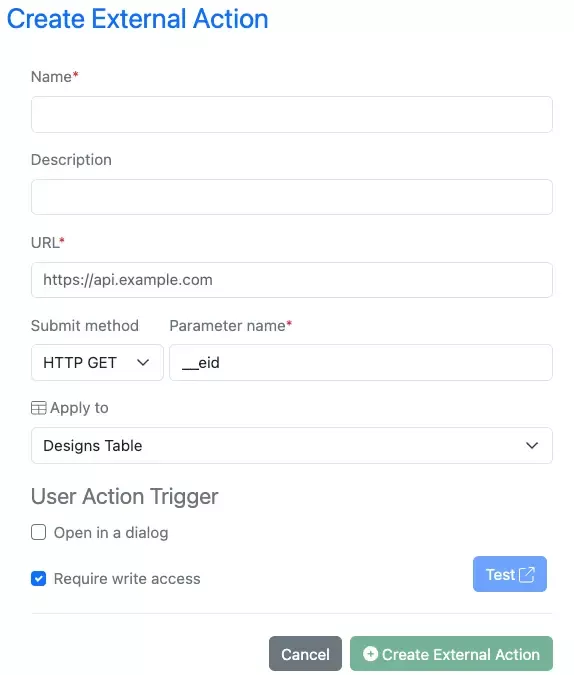
External Actions are now available to be configured for Synergy Design Table.

The existing endpoints for exporting entities to PDF have been enhanced to allow for Synergy Experiments to be printed to PDF.

New APIs for updating fetching the details of a Reference Tables and configuring which properties of the referenced entity are available as Shared Properties to the CRO as columns in the table. This include an API to fetch the available properties based on the referenced entity.

The API Key limit has been increased to 25.


Endpoints for importing materials via the External API using the JSON request body have been enhanced to allow for Smiles, HELM, and InChI chemical structures. Previously this only allowed for CDXML. To add non CDXML the “contentType” must be specified in the request body.

A set of new actions have been introduced to allow syncing Material Tables with their matching Material library in both directions.
The endpoint PATCH /materialsTable/{materialsTableID} has been enhanced to add two new actions, “updateFromMaterials”, for syncing of a row with its material library and “updateToMaterials”, for updating a material library at the same time as a row. These are only available for single row updates, not as part of a bulk actions.
Further Details
The following capabilities are in beta and are available for users, administrators and developers on the Signals platform upon request. Please contact your account representative or our support team if you would like access to the following features.
Synergy
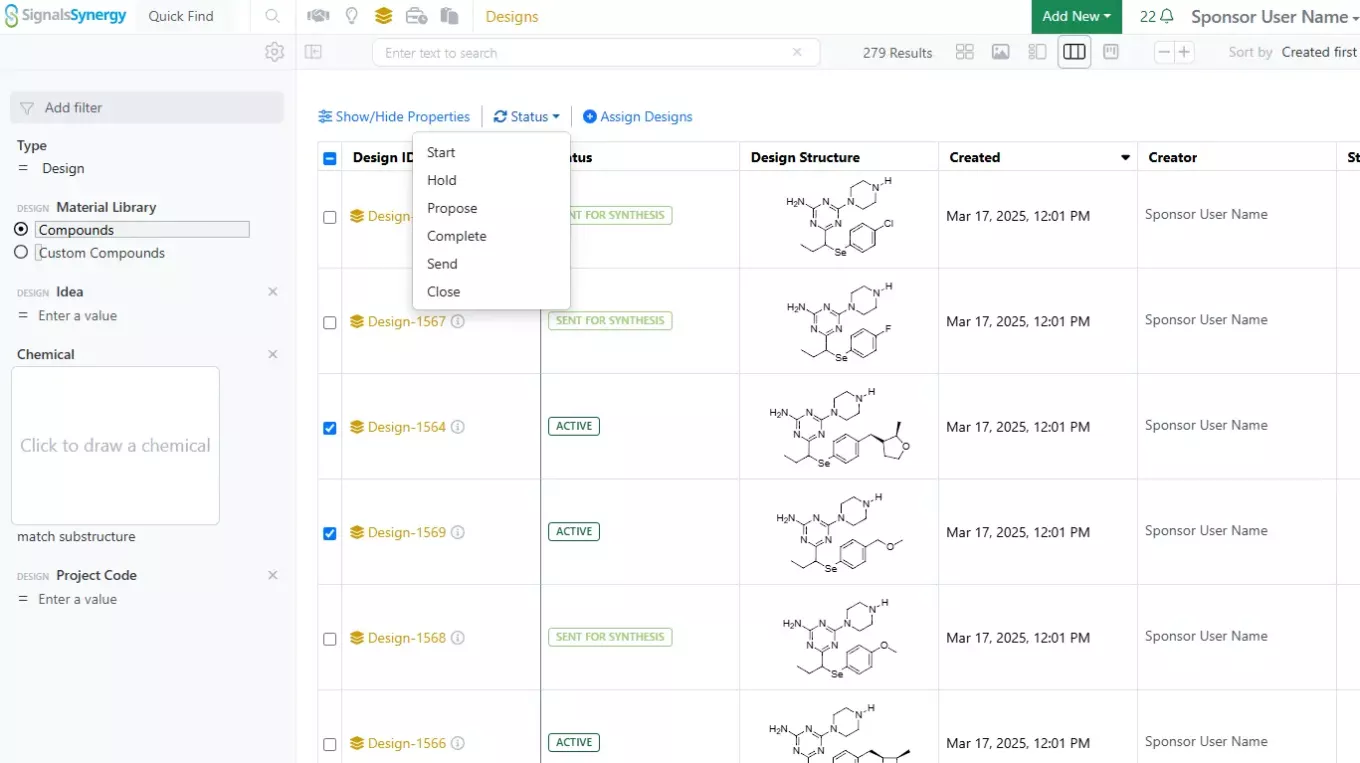
We have further enhanced our design synthesis tracking features. Design Statuses can now be bulk updated from the Designs Smart Folder Data Grid View.

In addition, the Designs Smart Folder now offers a Kanban Board view for Designs by Status. This board allows chemists to track the progress of Designs through the synthesis pipeline from proposed to synthesis complete.
Admin Defined Tables & Variation Tables

Administrators can now map Variation Tables to publish data to Inventa:
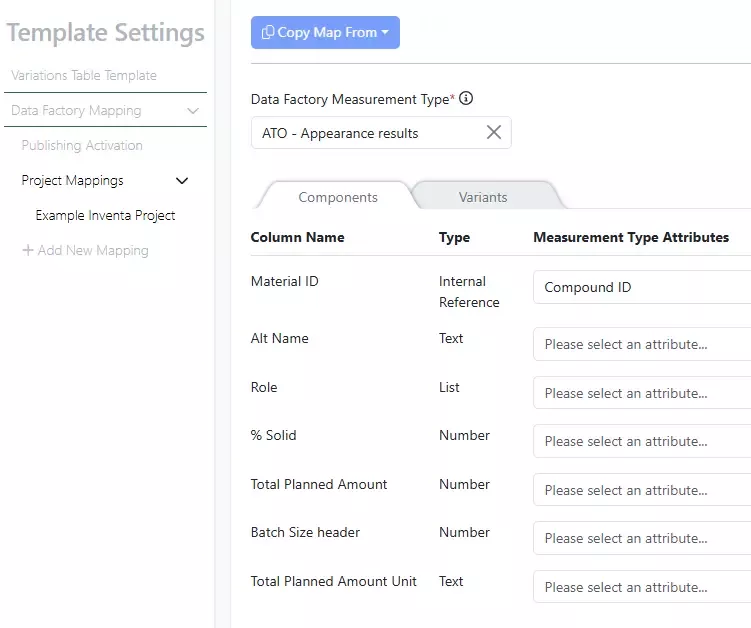
Note that all the component columns and headers are listed in one place for mapping:

Switch to the Variants tab to continue to map additional attributes. Both columns and headers are listed together:

For users to be able to publish the Variation Table, the map must be activated. Users will see the Variation Table(s) as options for publication:
Inventory
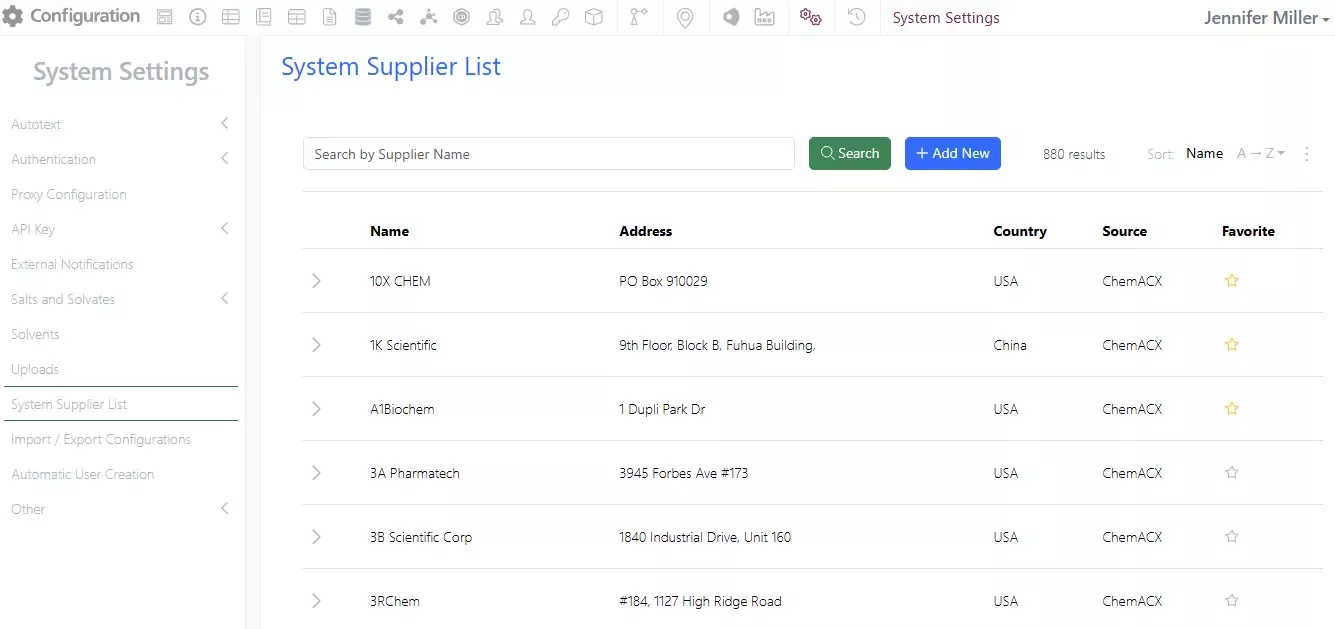
In the System Settings there is a new option for a centralized Vendor/Supplier List that can be added to. The list is pre-populated with the Suppliers from ACX. Administrators can mark “Favorite” Suppliers by clicking in the star:

Administrators can add New Suppliers as needed:

Only Administrator added Suppliers will be available for editing or deleting:
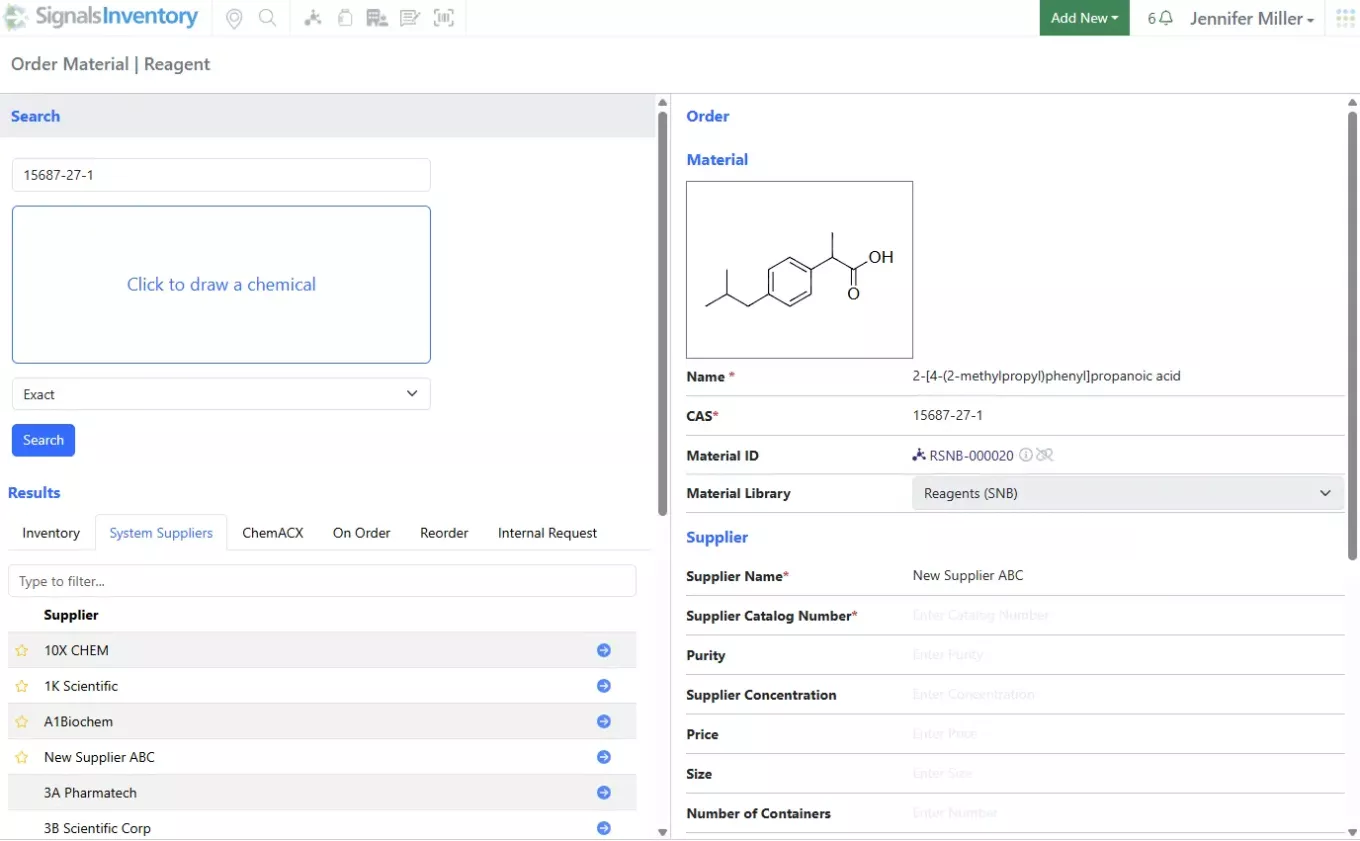
Users will be able to see the System Supplier List in the Order workflow under the System Suppliers tab. The favorite Suppliers will show at the top of the list:
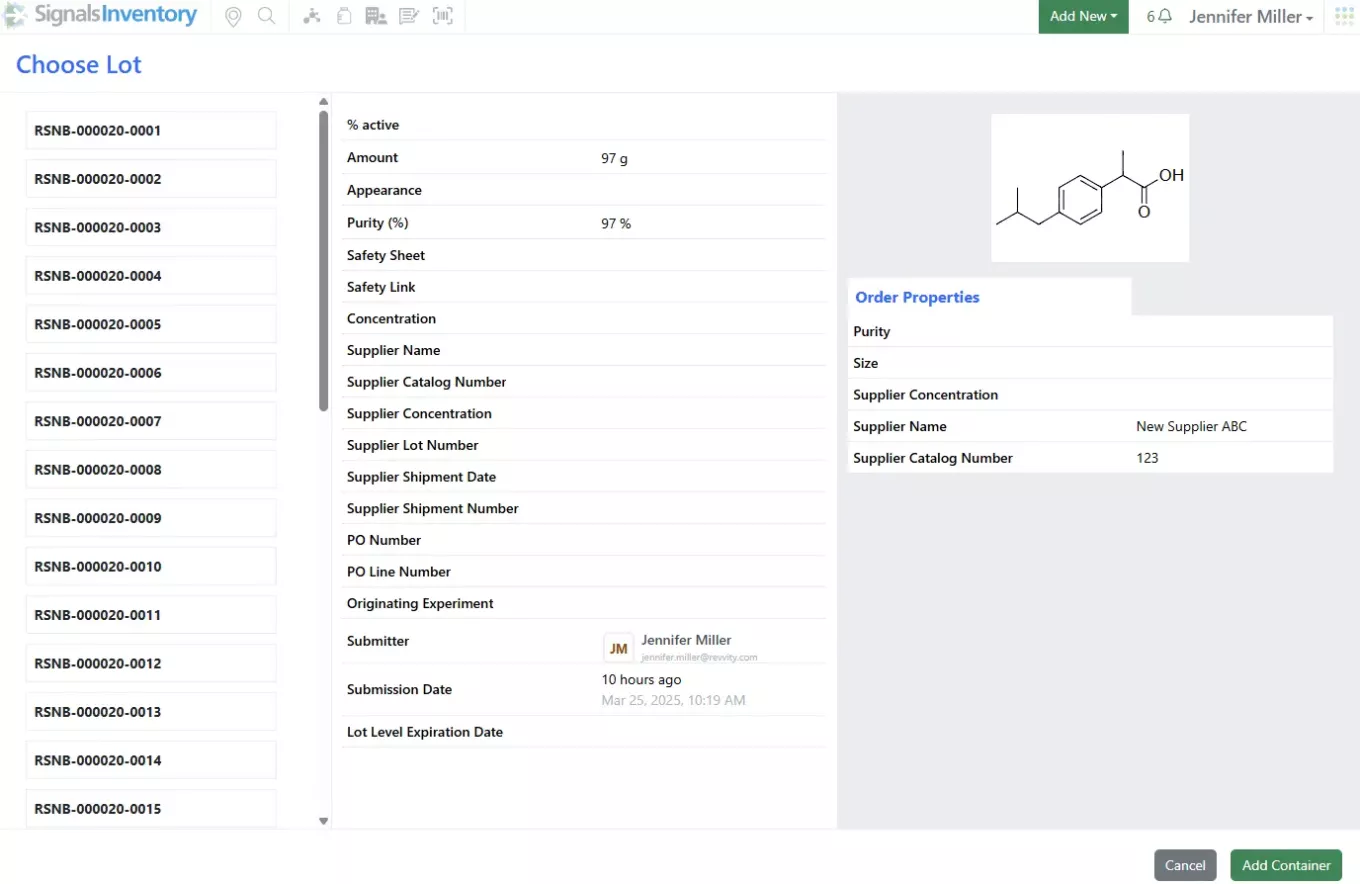
Administrators and Inventory Administrators will see the Suppliers in the Receiving workflow
Administration
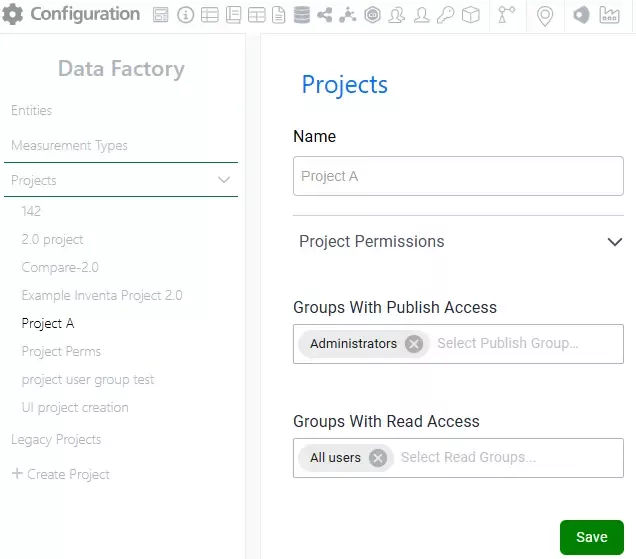
Rearchitected SDF Projects, improved performance with row-level updates, and new methods for project creation and data publication (beta)
Data Factory has been redesigned for enhanced performance, introducing row-level update capabilities. Data is now referenced by a user-defined, unique result ID rather than organized into datasets.
As a result, the Project Management page, now located in Signals Configuration, has been significantly streamlined.
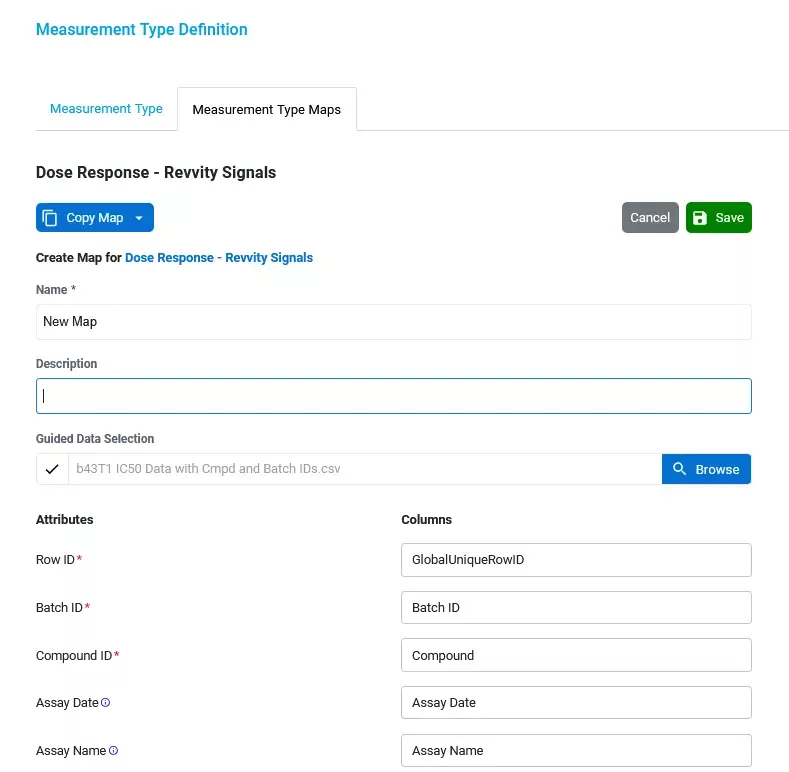
Entity and Measurement Type maps can be created directly on their respective definition pages within Signals Configuration. Admins may use an optional reference file for column mapping. All measurement type maps must include a unique result ID mapping to enable row-level updates.



Users can publish data directly from the Inventa Dashboard using these admin-defined maps. They'll receive notifications upon completion and can review publication reports from the Inventa dashboard.


For workflows in Spotfire for Signals, users can leverage the new Publish Results to Data Factory app. Note that legacy projects will continue to use the legacy Publish Measurements App.

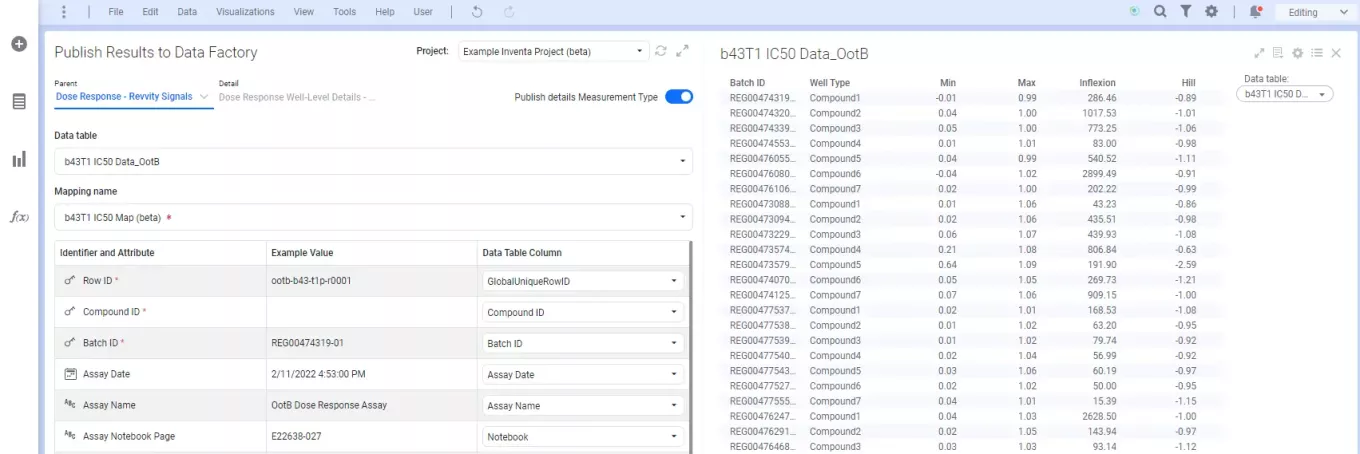
For workflows in Spotfire for Signals, users can leverage the new Publish Results to Data Factory app. Note that legacy projects will continue to use the legacy Publish Measurements App.


Publication is also supported through new public APIs, which can be reviewed in the “Data Factory Public API 2.0 Document”
What's New
This version 25.2 release of Signals brings the ability for admins to define their own solvents list and associated properties. We have added new workflows in Signals Synergy, Signals Inventa and the Inventory. We have added new calculations and properties, and improved views in tables, in addition to some new calculated properties in Samples. We have added a new capability whereby administrators can enable self registration of users. We have continued to work on our ongoing beta capabilities with the updated ChemDraw sketcher and added new beta capabilities around statuses for Signals Synergy. Finally, we have also fixed a number of small bugs.
The following improvements are available for users, administrators and developers on the Signals platform. Certain features may only be available with appropriate licensing and/or with enablement by an administrator.
- Inventa
– Access externally published datasets in the Publish Measurements App
- Synergy
– Data Grid view and Chemical search in Designs Smart Folder
– Assign Designs to internal (Sponsor) user or user group
– Capture Originating Design on Registered Materials
– Option to require a Synergy Experiment Template field On Synergy Experiment Draft
– Expanded Designs Statuses for Design synthesis tracking and Approve Designs for Synthesis privilege (beta)
- Chemistry
– Admin Managed Solvent List
– Selection of attachment points between monomers to create biopolymer crosslinks
– Complementary strands generated from text tab now contain hydrogen bonds
– Chemical Symbols (beta)
– Generate complementary strand tool (beta)
– HELM Auto-pair tool (beta)
– Show 3' and 5' ends of oligonucleotides (beta)
– Join tool (beta)
- Admin Defined Tables & Variation Tables
– Reuse of Containers in Inventory linked tables
– Enhanced data column Headers and Variant highlighting in Horizontal view in Variation Tables
– Variable Measure property in ADTs and Variation Tables
- Samples
– Addition of Radioactivity as a calculated property in Samples
– Addition of Molar Activity (Specific Activity) as a chemical property in Samples
- Inventory
– Bulk Move on Containers on Containers Search Table
- Administration
– Autocreation and licensing of users
- Integration & APIs
– Draft Synergy Experiments for Work Orders via API
– Work Orders creation via API enhanced to allow specifying Designs
– Sending Work Orders via API
– Partial Print Experiments via API
We also fixed several small bugs in this release. Details of the enhancements are described below.
The following OnDemand videos for Signals Notebook End Users are now available
- CRO User Fundamentals for Signals Synergy
Administrators should be aware that the SDF primary API: DELETE /project-service/projects/{projectUid} has been deprecated in favor of the public DELETE /api/v1/projects/{projectId}
Administrators are recommended to subscribe to the channels within our support news site found at https://support.revvitysignals.com/hc/en-us/categories/360004446171-Support-News which contains more information about releases and other pertinent product information.
This content is anticipated for release on our Production E3 environments, and for Private Cloud customers on our deferred release schedule, in July 2025.
Further Details
The following improvements are available for users, administrators and developers on the Signals platform. Certain features may only be available with appropriate licensing and/or with enablement by an administrator.
Inventa
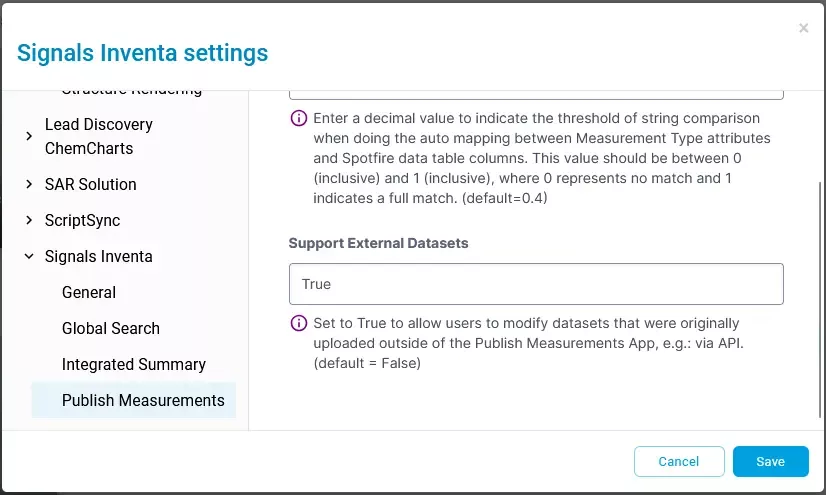
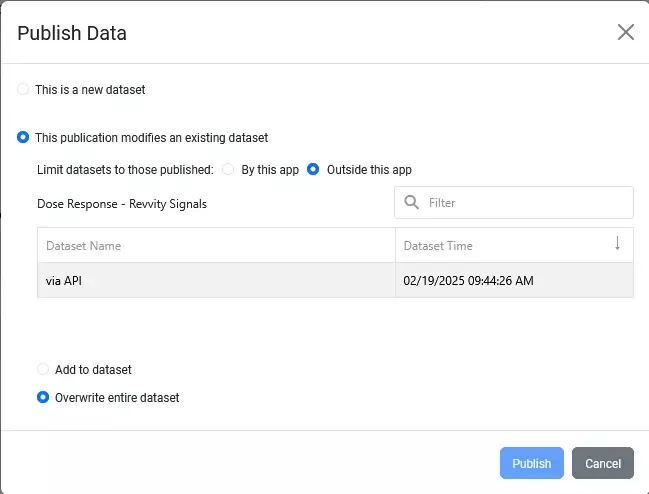
Previously, the Publish Measurements App only accessed datasets published directly from the app. Now, admins can also allow access to datasets published externally, such as via APIs.
Synergy

The Designs Smart folder can now be viewed as a Data Grid. In addition, the Designs Smart Folder now includes chemical search functionality, previously only available in Advanced Search.
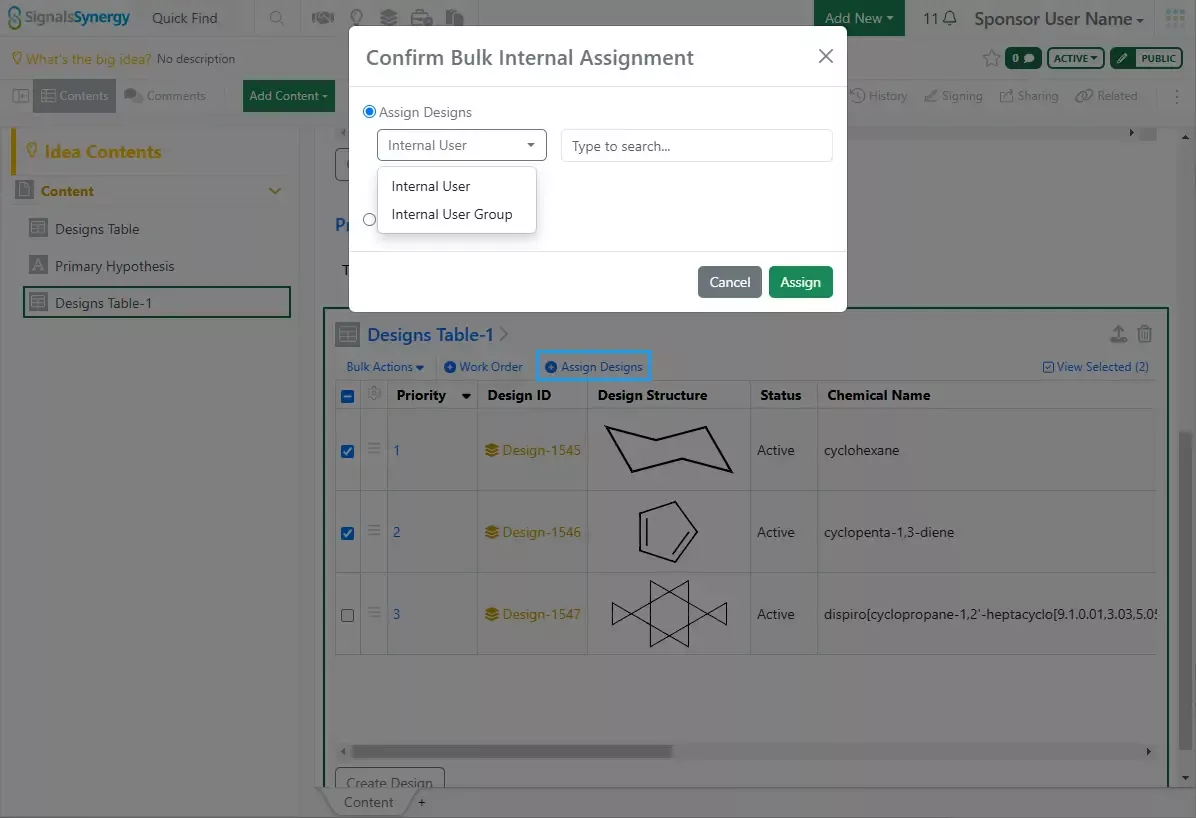
Designs can be assigned to an internal user or user group. Assignment is stored on the Design as Assigned User and Assigned Group. Note that this functionality is only available on newly created Designs.
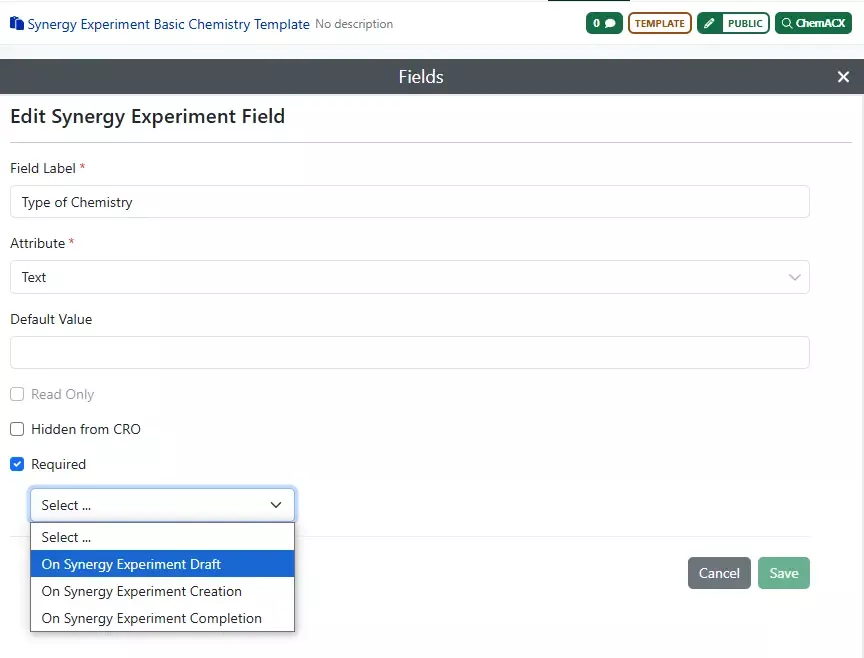
Material assets have a new property called Originating Design, which allows the user to capture the Design from which a material derived. Originating Design is automatically populated when a user registers a Sample with the W.O. Reference set to a Design or when the user associates a Material ID with a Design. Originating Design can also be manually added during individual material creation or bulk import.
Finally, Synergy Experiment Templates now have three options for required fields: Required On Synergy Experiment Draft (new), Required On Synergy Experiment Creation, or Required On Synergy Experiment Completion. Required On Synergy Experiment Draft requires the Sponsor to enter a value before sending to the CRO, whereas Required on Synergy Experiment Creation requires the CRO to enter a value before creating a Synergy Experiment from the Draft.
Chemistry
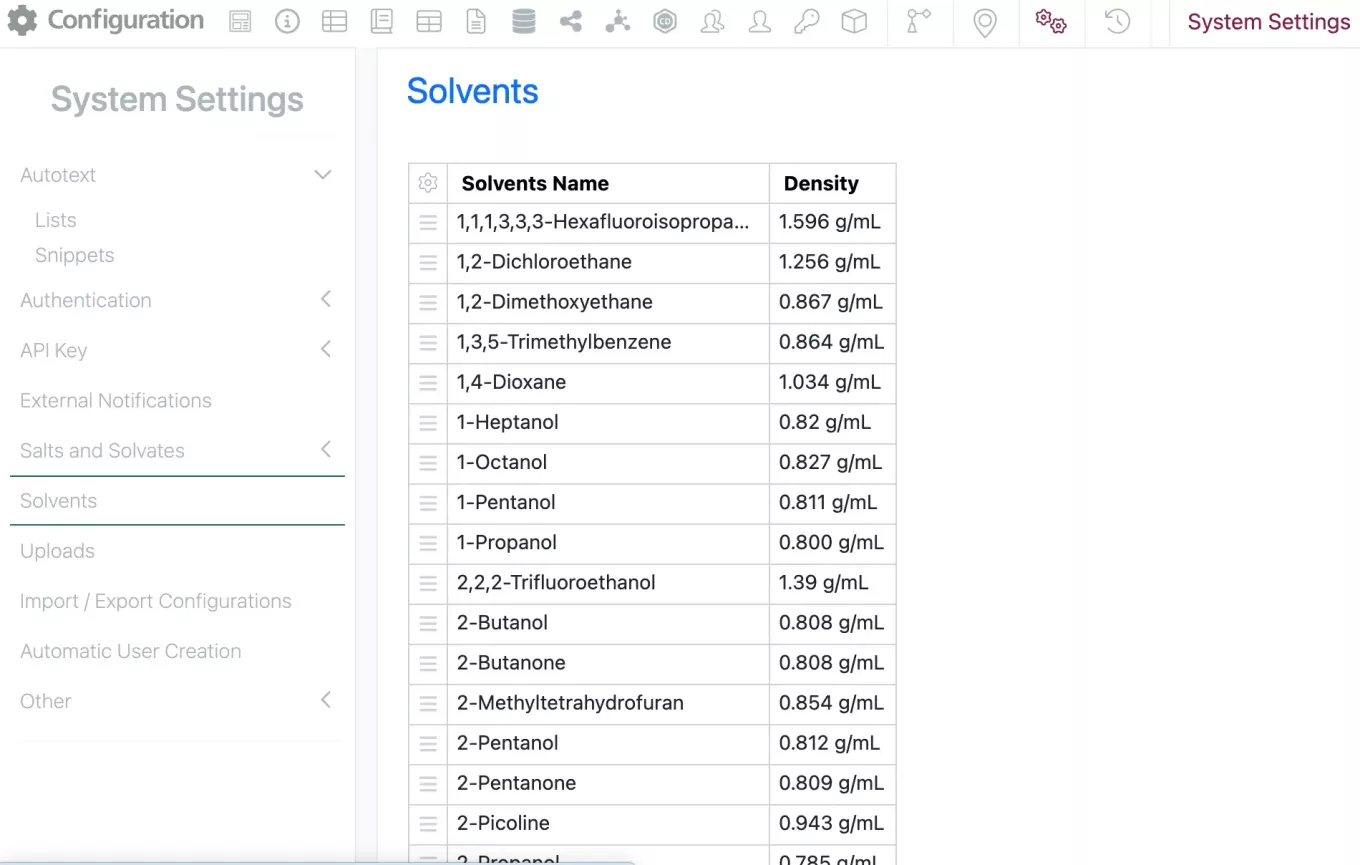
Admins are now able to manage the Solvent list under the system settings in the SN Config.
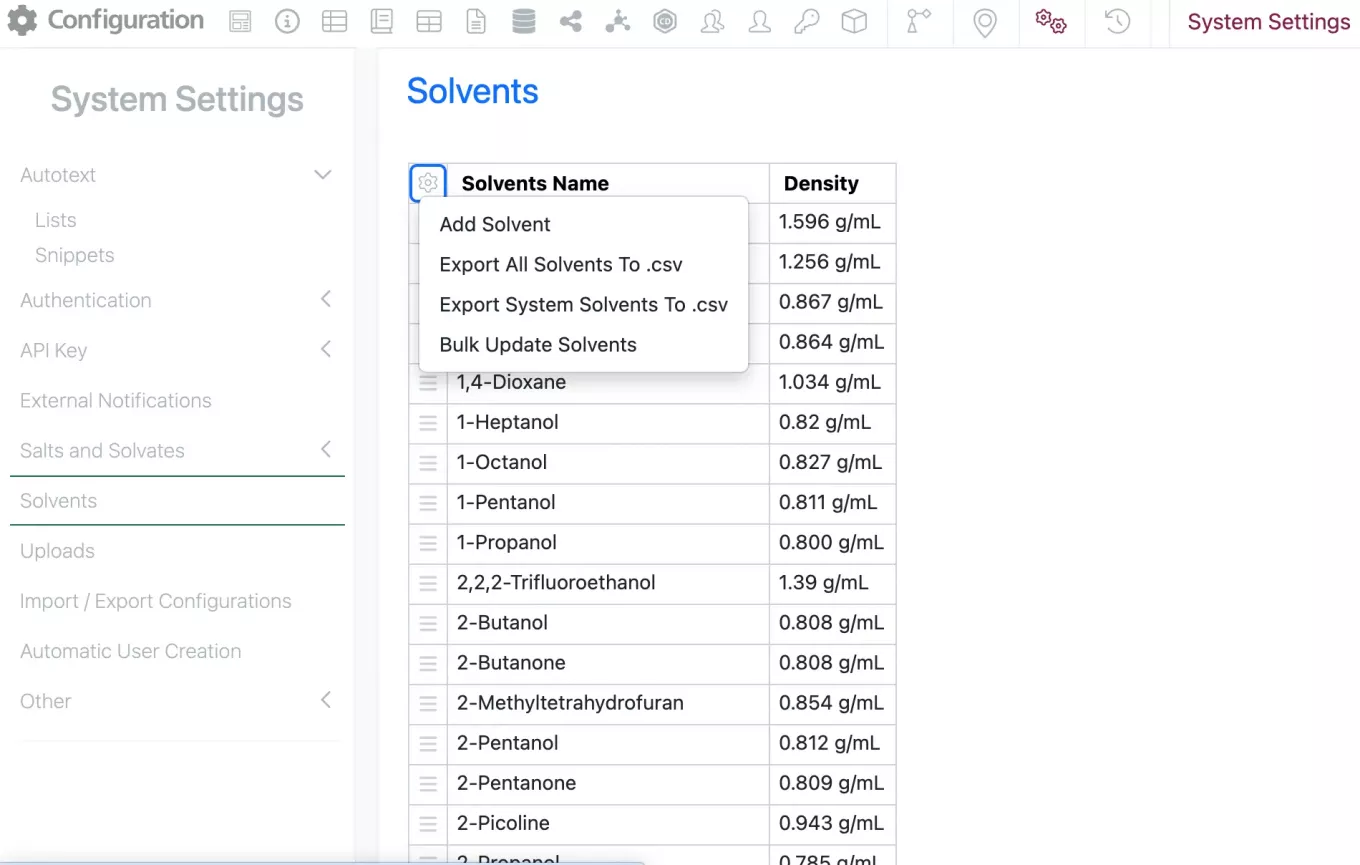
The admin can add individual solvents or upload a csv of solvents by selecting the gear in the top left corner.
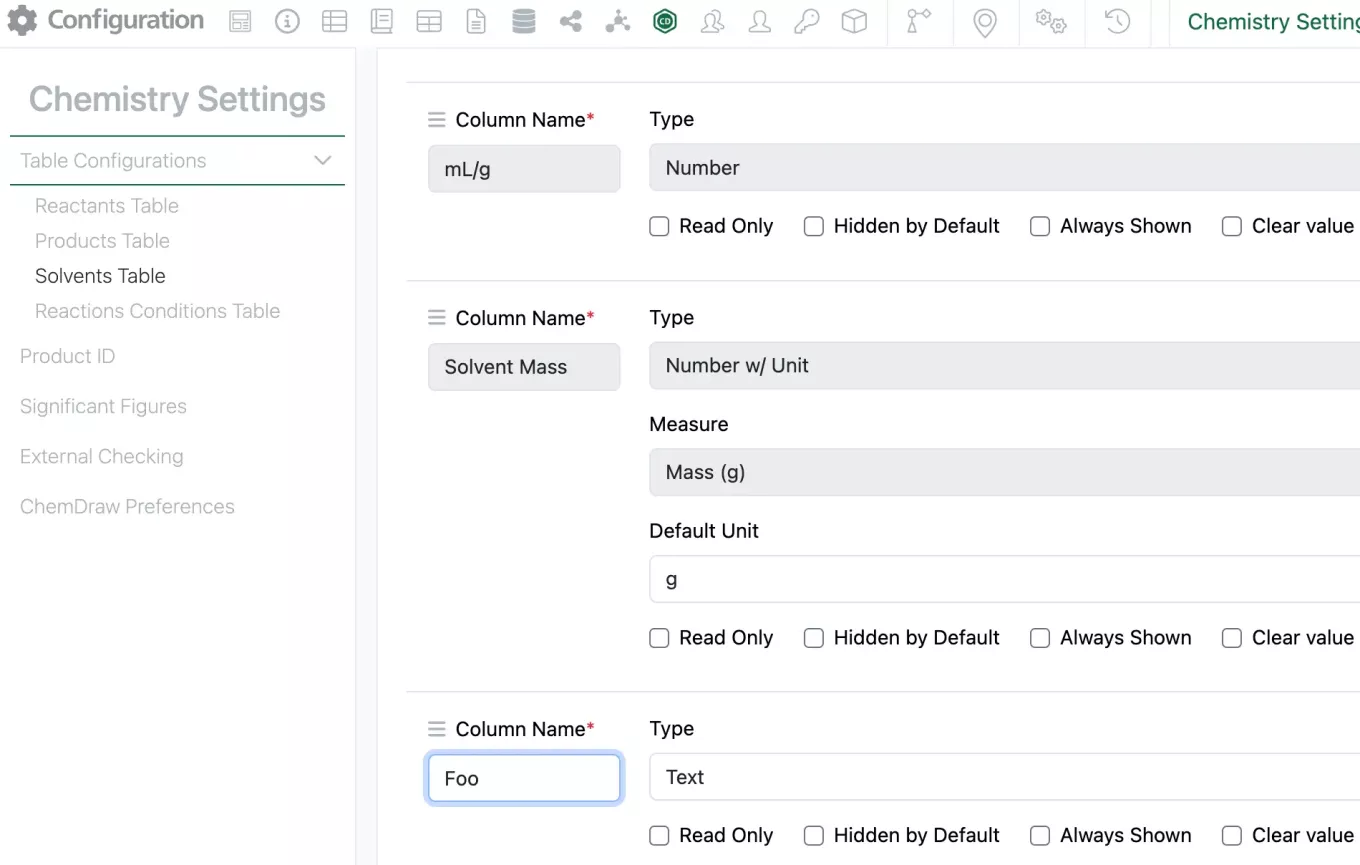
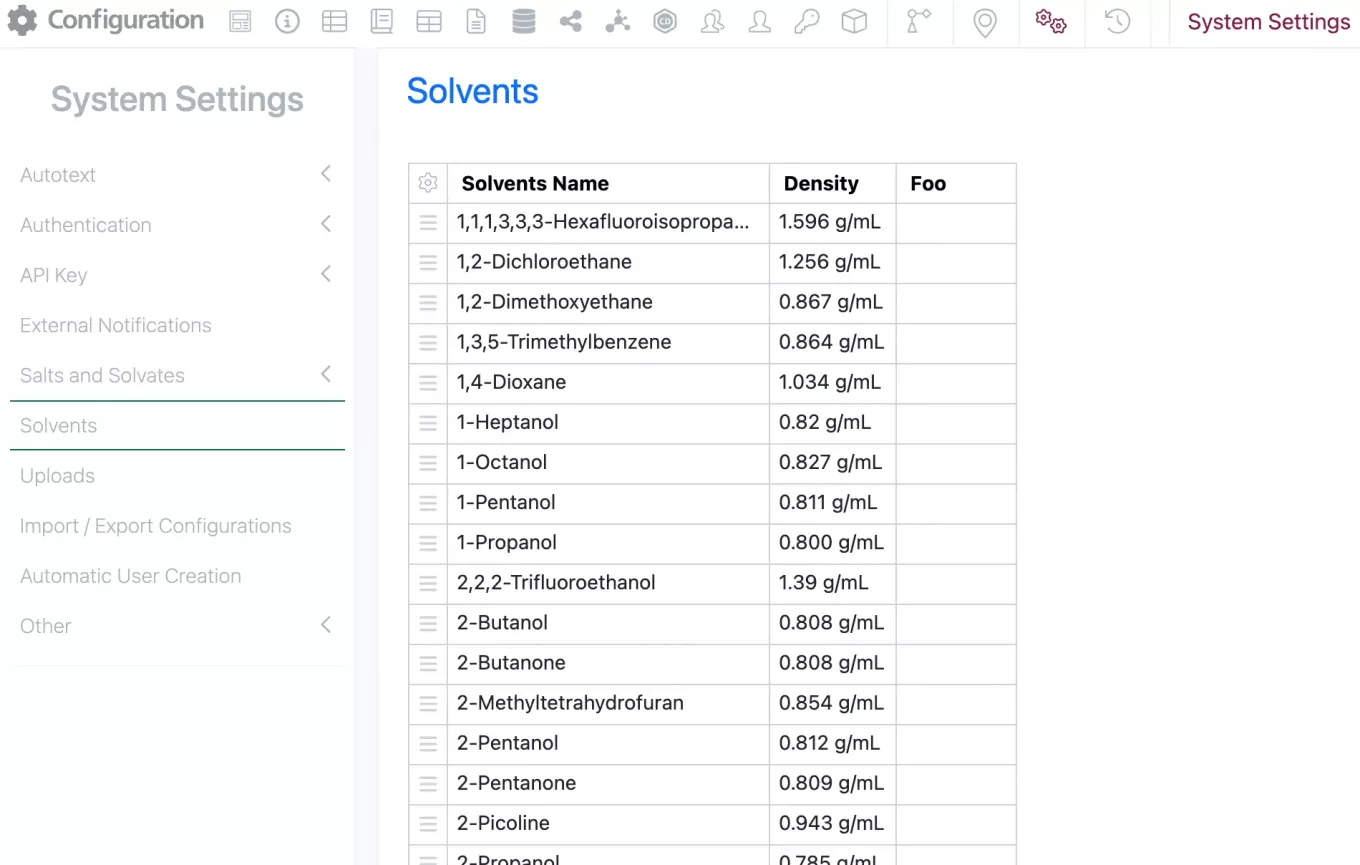
To customize the columns available in the Solvent list, the admin can add the column to the Solvent table in the Chemistry settings. The new column will then be available in the Solvent list. Currently only Text type columns can be automatically mapped.
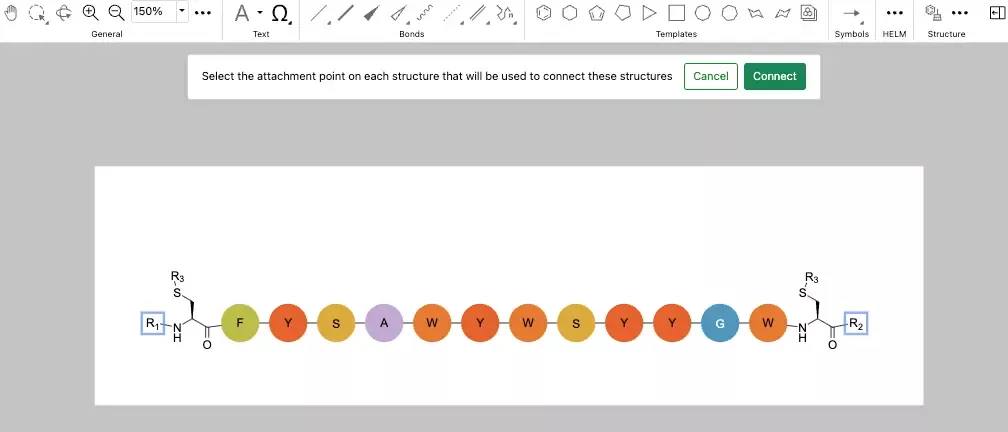
These new columns can then be populated in the solvent list manually or via csv upload. If the column is removed from the Solvent Table in the chemistry settings, it is removed in the Solvent list.
The creation of biopolymer crosslinks between monomers with multiple possible attachment points is now supported. When creating a crosslink, the monomers will now expand, allowing users to select specific attachment points to make the connection.

After making the selection, users can finalize the process by selecting "Connect," and the monomers will be successfully crosslinked. This new capability is available in both the legacy and new ChemDraw editor in beta.

Complementary strands of RNA or DNA that are created from the text tab of the HELM editor are now created with hydrogen bonds automatically mapped between the strands. The hydrogen bonds are placed according to Watson-Crick base pairing. Hydrogen bond pairing information is now supported in ChemDraw when inserting HELM strings or pasting them on the canvas. Additionally, when generating a HELM string for a sequence containing hydrogen bonds, the resulting HELM string will now contain the pairing details. This new capability is available in both the legacy and new ChemDraw editor in beta.
Admin Defined Tables & Variation Tables
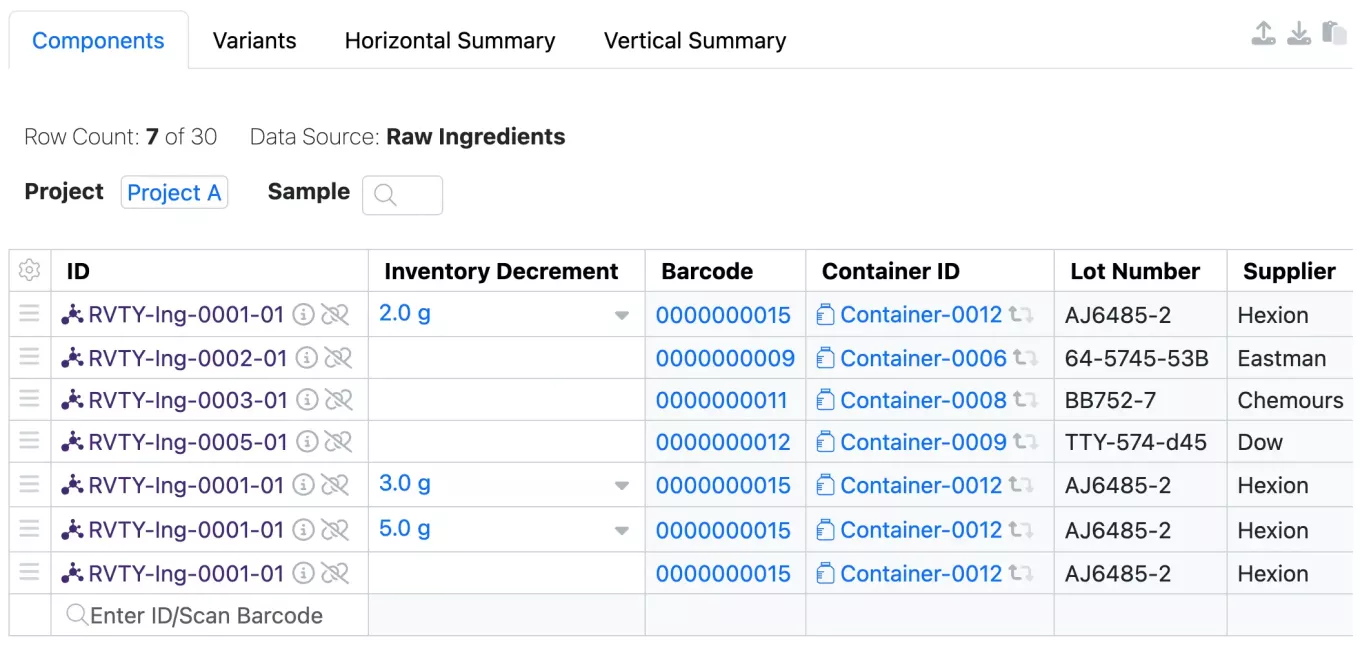
We have relaxed the restriction on the multiple use of Containers in Admin Defined Tables and Variation Tables that are enabled with the Inventory Columns. Tables must be configured to use an Internal Data Source and the Inventory Columns enabled. Now the user is not prevented from adding the same container multiple times to the Admin Defined Table or the Components Table in Variation Tables.

Enhanced data column Headers and Variant highlighting in Horizontal view in Variation Tables
A new option to fix the column width and allow wrapping of the table headers is available to administrators when creating or editing Variation Tables:

This allows for a more compact visualization of the horizontal summary view. Now the entire variant is highlighted when users click into a cell to enter data:
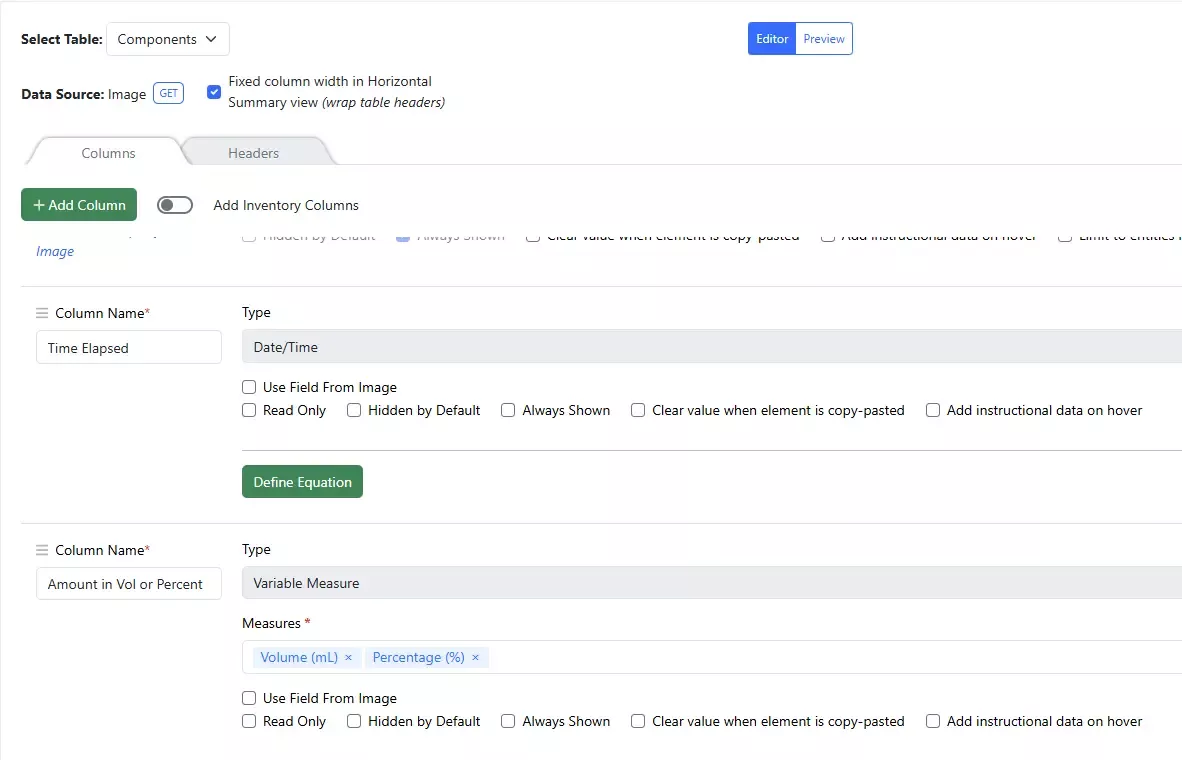
Variable Measure property in ADTs and Variation Tables:

Administrators can now create Columns with the Type of Variable Measure and can set the Measures that users can choose from when entering data into Admin Defined Tables (ADTs) or Variation Tables:
Samples
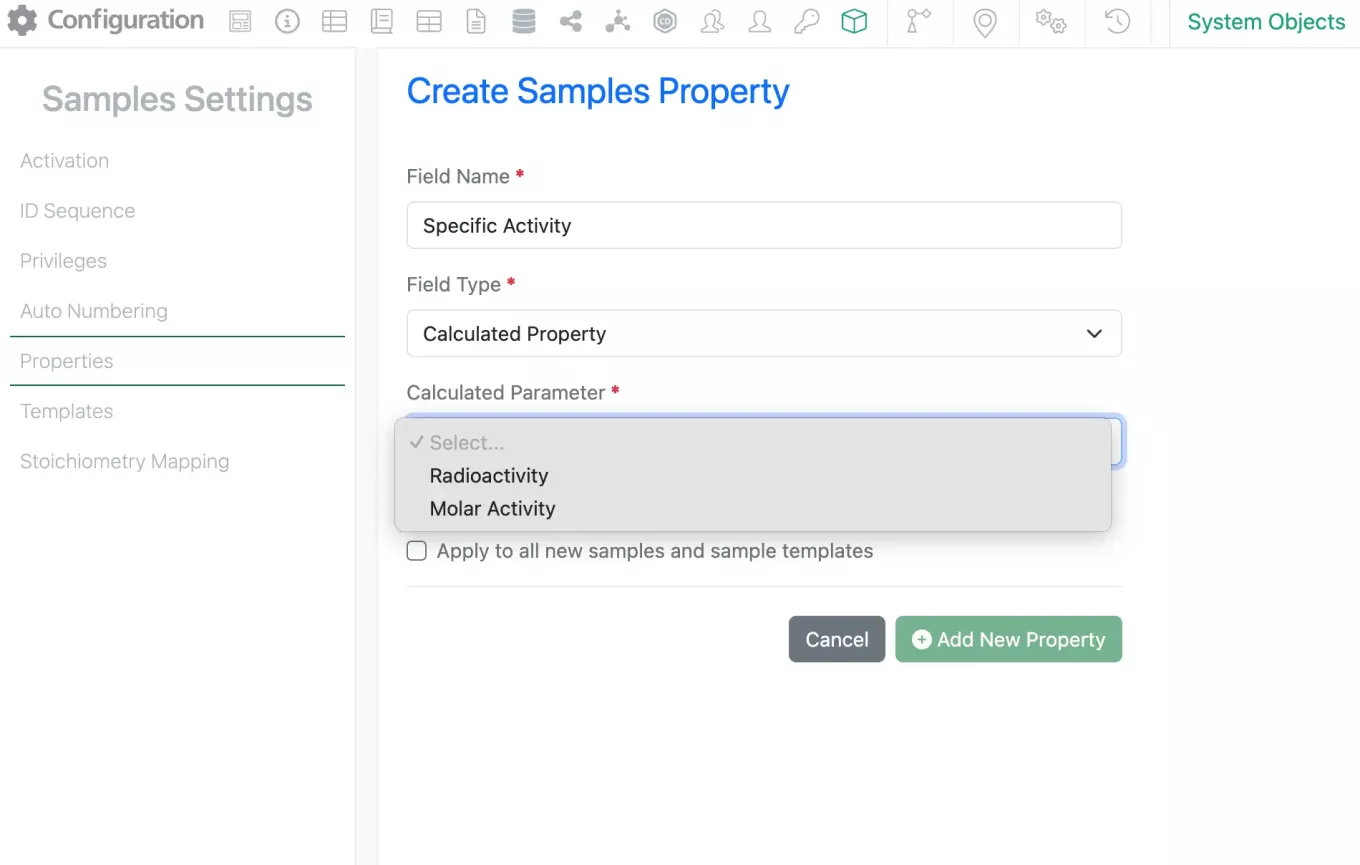
New calculated properties for Samples have been added using the new Radioactivity units. Now available under Sample settings are the Radioactivity and Molar Activity (Specific Activity).
The calculations for these properties are as follows:
Radioactivty = [Molar Activity (aka Specific activity)] * [Moles]
Molar Activity (aka Specific activity) = [Radioactivity] / [Moles]
Inventory

Bulk Move on Containers in Containers Search Table:

After choosing the containers to Move, the location search dialog displays and a location can be searched or entered via barcode or type ahead:

If a gridded location is selected, the coordinates will need to be selected. Once the Move is done a notification will be given at the bottom of the page:

There are no reports or bell notifications given with the bulk Move, but the Location will be updated in the table:
Administration
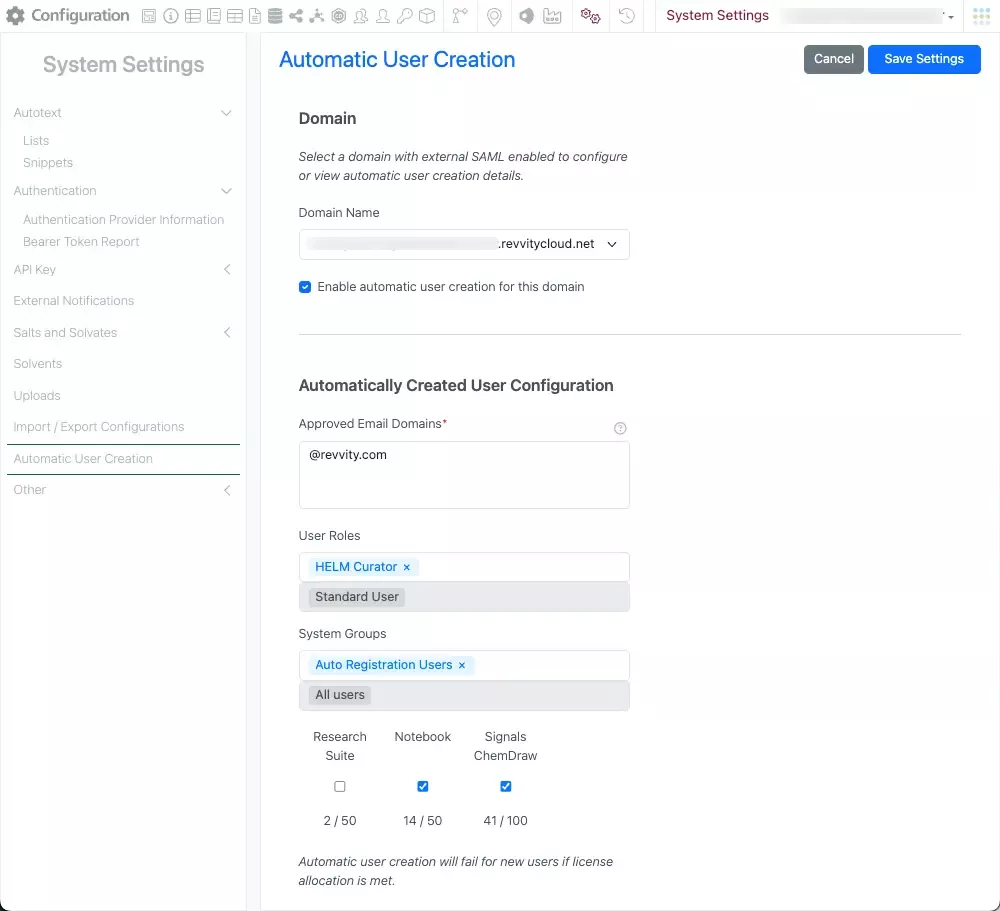
Admins can now configure the automatic creation and licensing of users for a domain on their tenant in System Settings. This new configuration requires admins to define approved email domains, user roles, and system groups. They must also specify which licenses will be assigned to automatically created users upon successful login. Additionally, there is an option to enable license allocation notifications emails when a certain threshold is reached. It's important to note that automatic user creation can only be configured and enabled for domains that have been configured to authenticate using an external IdP (Identity Provider) using SAML integration. After enabling this feature, users who successfully log in with an approved email domain will be automatically created and licensed based on the configuration settings.
Integrations & APIs

This update brings additional integrations capabilities for our Synergy product.
First the ability to create Draft Synergy Experiments for Work Orders via API. This is an enhancement to the POST /entities API.

The body must contain the collaboration and workOrder as part of the relationships object. Optionally designs can be specified as part of the attributes object field “W.O. Reference”.

Next is an enhancement for creating Work Orders via the API that allows Designs to be specified as part of creation. This is an enhancement of the POST /synergy/workOrders API.

The update allows you to include designs as part of the relationship object. This API will require an Idea also be specified as part of the Work Order creation and the designs will need to be related to that idea.

Lastly you are now able to send Work Orders via the API. This is a new API, PUT /synergy/workOrders/{workOrderId}/status.
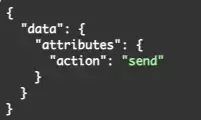
You must specify the action as part of the request body. Currently the only acceptable action is “send” this is to change a work order from “Draft” to “To-Do” status.

The asynchronous print flow/endpoints have been updated to allow for only printing specified children when applicable (i.e. Experiments and Samples).
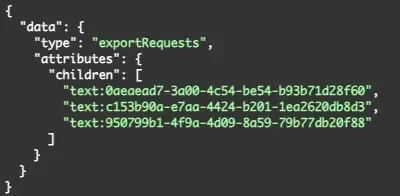
When creating the asynchronous print request via PUT /entities/export/pdf you may now specify the children by eid that you wish to include. If you do not include a request body all children will be included.
Further Details
The following capabilities are in beta and are available for users, administrators and developers on the Signals platform upon request. Please contact your account representative or our support team if you would like access to the following features.
Synergy
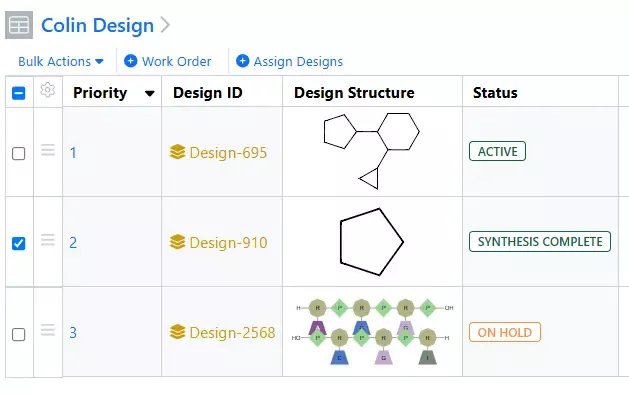
Expanded Design Statuses for tracking Design progress in Synergy are now available upon request. Statuses now include Active, Proposed, For Synthesis, Sent for Synthesis, In Synthesis, On Hold, Synthesis Complete, and Closed. Transitioning a Design from Proposed to For Synthesis requires a new privilege, Approve Designs for Synthesis. Design Statuses can be manually updated individually or in bulk, but several actions automatically update Design Status to reduce manual oversight. Sending a Work Order with referenced Designs automatically transitions the referenced Designs to Sent for Synthesis. When a CRO user starts a Work Order with referenced Designs, the Designs are automatically transitioned to In Synthesis. When a material is registered with an Originating Design, the Design is transitioned to Synthesis Complete.
Chemistry
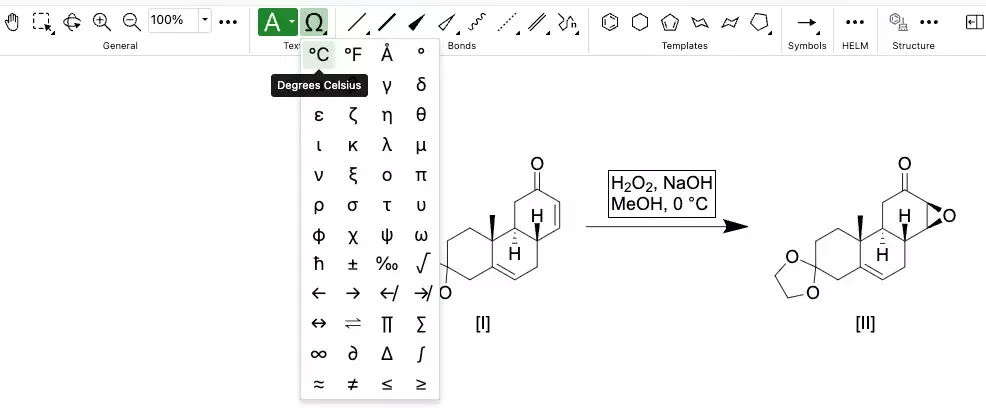
Common symbols used in chemical names and reaction conditions can now be added to a ChemDraw text element in the new ChemDraw editor using the new Chemical Symbols tool. This tool is available in the ‘Text’ section of the new drawing toolbar.

Complementary strands of oligonucleotides can now be generated from a selected oligonucleotide on the ChemDraw canvas. This new tool in the HELM section of the drawing toolbar allows users to generate a complementary strand when an oligonucleotide is selected.
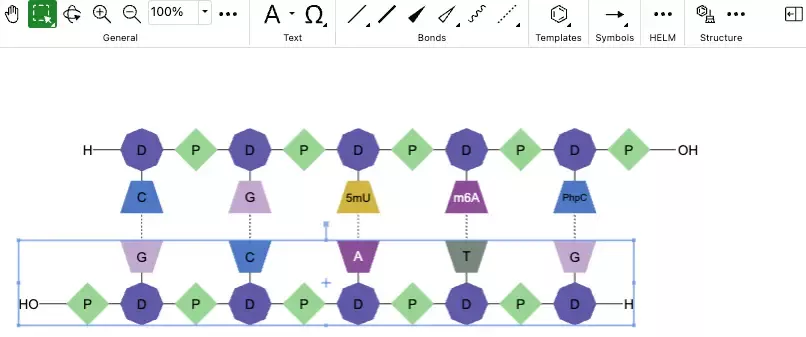
When this new tool is used, a complementary strand will be generated with hydrogen bonds automatically mapped between the strands. The hydrogen bonds are placed according to Watson-Crick base pairing. For sequences containing custom monomers, the complement will be based on the natural monomer equivalents of the selected sequence.

Complementary strands of oligonucleotides can now be selected and automatically paired in the new ChemDraw editor. When paired, hydrogen bonds will be placed between the strands according to Watson-Crick base pairing, with maximum overlap in complementarity between the strands. For sequences containing custom monomers, the hydrogen bonding will be placed according to Watson-Crick base pairings based on the natural monomer analogs. The auto-pair tool is accessible in the HELM section of the new toolbar, and will be active when two oligonucleotide sequences are selected.
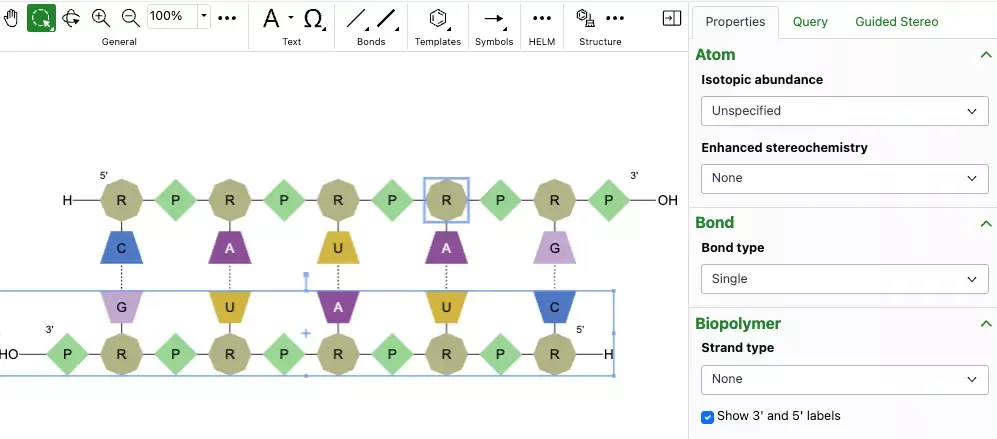
A new option has been added to the Biopolymer section of the Properties panel which allows users to display the 3' and 5' ends of an oligonucleotide on the canvas. When an oligonucleotide is selected, users can choose to show or hide the label by selecting or unselecting this option.
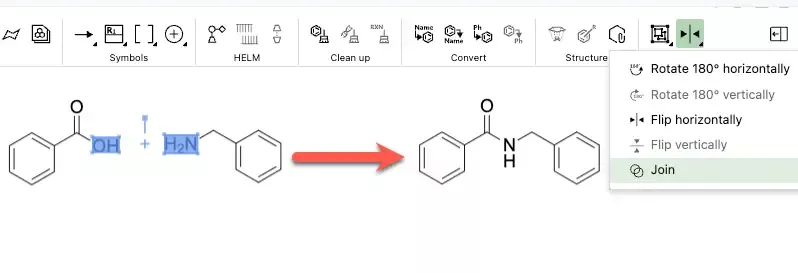
A new join tool is now available in the object section of the new ChemDraw toolbar. When used, the join tool allows users to combine structures on the ChemDraw canvas by merging two or more selected atoms into a single atom.
What's New
This version 25.1 release of Signals brings s series of enhancements to Work Orders with multiple Synergy Experiments and elsewhere in Signals Synergy. We have added the ability to inherit data into tables, and to reorder rows. We are also calculating new data on Samples. We have enhanced Inventory workflows, searches and labels. Our beta capabilities around publishing ADTs to Signals Inventa, and around Normalized Compound Libraries are now available to all systems. We have added new beta capabilities around viewing lineage information for Materials and an updated chemical sketcher. Finally, we have also fixed a number of small bugs.
The following improvements are available for users, administrators and developers on the Signals platform. Certain features may only be available with appropriate licensing and/or with enablement by an administrator.
- Inventa
– New privileges to access Inventa Apps
– Quick access to Hide Attributes in Global Search
- Synergy
– Work Orders can now be fulfilled by a series of multiple Synergy Experiments, such as multiple Synergy Experiments for multi-step synthesis, synthesis of multiple requested Designs, or multiple runs or steps of an assay
– Chemical Structures from Work Orders can now be added to Chemical Drawings in Synergy Experiments using the Quick Add toolbar
– Print of Synergy Experiments, including Data Exchange reports and results tables
– Due Date and Priority are now optional on Work Orders
- Chemistry
– New ChemDraw editor (beta)
– Improved visualization and clean-up of biopolymers
– Drawing hydrogen bonds between complementary strand base pairs
– Complementary strands inserted to canvas in a single line with no line wraps
– Atom-mapped SMILES now supported in HELM strings for copy/paste
- Admin Defined Tables & Variation Tables
– Publish Admin Defined Tables to Inventa available to all systems
– Reorder rows
– Experiment Name inherited into Headers
– Attribute List values in Experiment inherited into Headers
- Samples
– Automatic Calculation of Sample Moles
– Automatic Calculation of Sample Yield
- Inventory
– Enhancement to the Sample with Container creation workflow
– Update to Task request with Container, Sample and Material reference
– New Label Size for Containers
– Expanded text Search on Containers Search Table
– Update to Container Disposal process
– Bulk update Expiration Date on Containers
- Materials
– Normalized Compounds available to all systems
– Additional sorting options added to the Batch/Lot page
– Visualization of lineage-parent relationships and batches (beta)
- Administration
– Entry of non List values into List Properties
– Addition of Radioactivity and Molar Activity Measures
– Admins can now access Information Design via the Data Factory section of Signals Configuration
- Integration & APIs
– Work order creation in Collaborations
– Design table can be added to an Idea
– Designs can be added to Design Tables
– External Data Sources can now be enabled for CRO users by System Admins
– Edit calculated values in ADTs and Variation Tables
We also fixed several small bugs in this release. Details of the enhancements are described below.
The following OnDemand videos for Signals Notebook End Users are now available
- Troubleshooting Bulk import of Materials
Administrators are recommended to subscribe to the channels within our support news site found at https://support.revvitysignals.com/hc/en-us/categories/360004446171-Support-News which contains more information about releases and other pertinent product information.
This content is anticipated for release on our Production E3 environments, and for Private Cloud customers on our deferred release schedule, in July 2025.
Further Details
The following improvements are available for users, administrators and developers on the Signals platform. Certain features may only be available with appropriate licensing and/or with enablement by an administrator.
Inventa

Administrators can also grant access, or not, to the Spotfire Inventa Apps to specific User Roles:
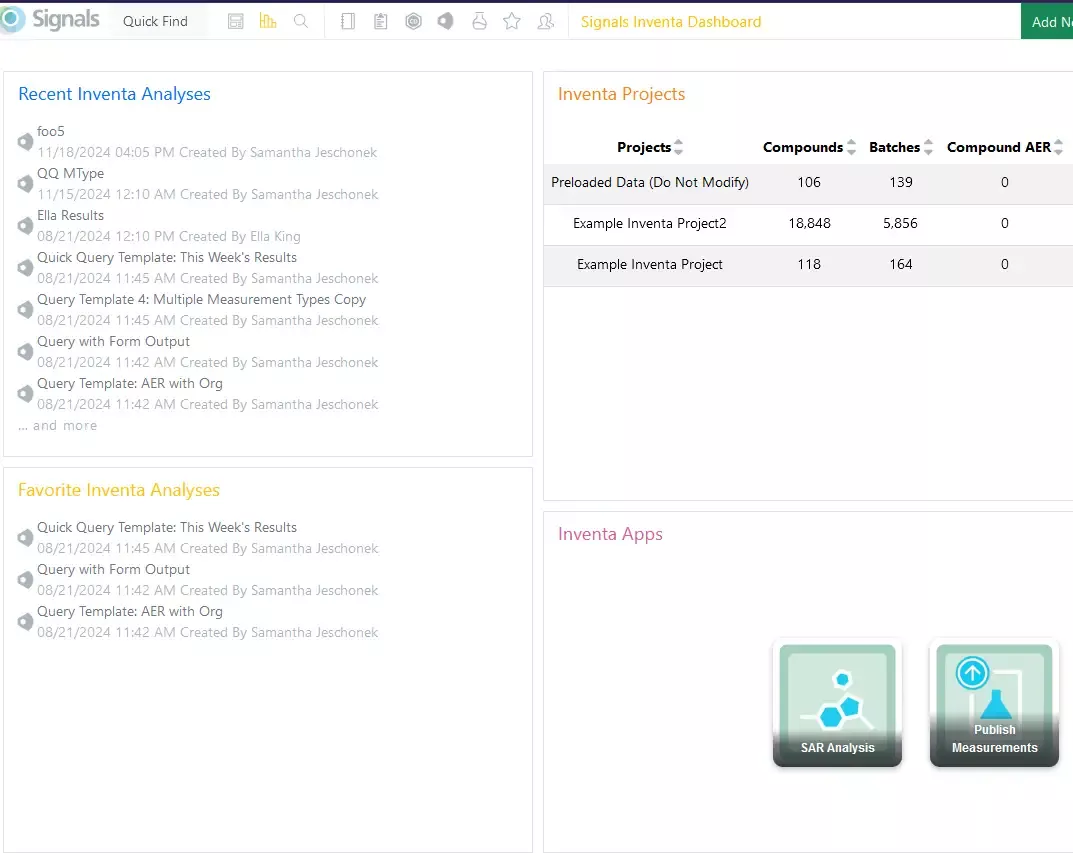
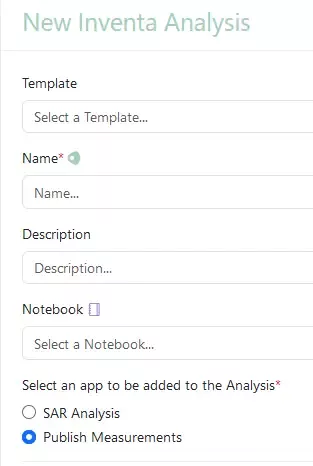
Users without these permissions will not see the Apps in Spotfire for Signals. The apps will also be hidden from the Inventa Dashboard as well as the Create Inventa Analysis flows. The screenshots show a user with access only two the SAR Analysis and the Publish Measurements apps, but not Global Search, Integrated Summary App, etc.

The Exclude Attributes option has been elevated in Global Search for easier access. Excluding attributes quickly restricts Global Search to Assay Endpoint Results data and may improve download performance.
Synergy

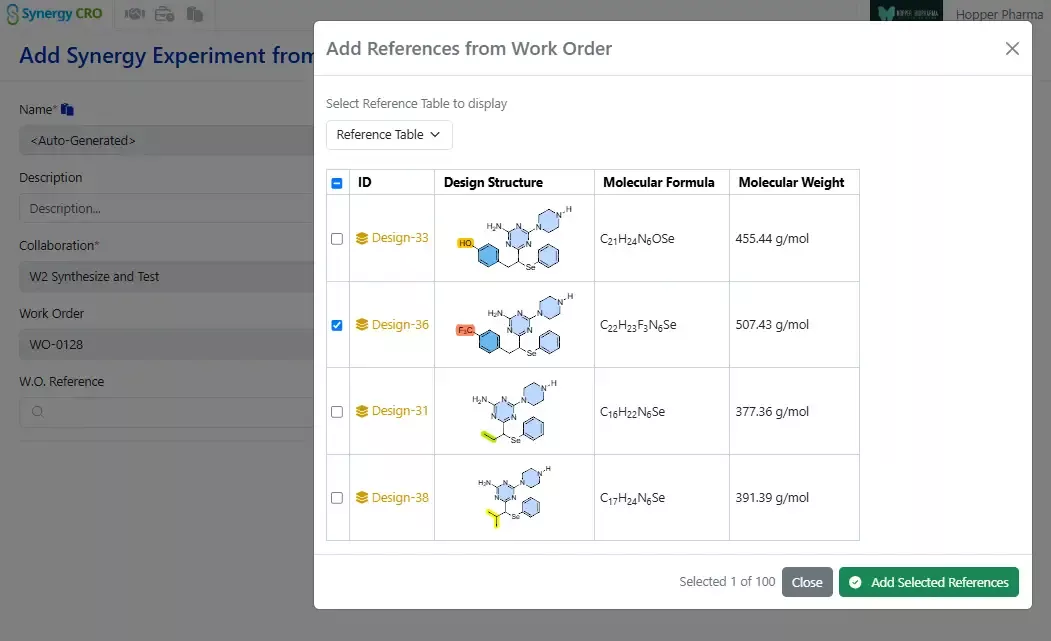
Works Orders can now be fulfilled by a series of Synergy Experiments, allowing the CRO user to add as many Synergy Experiments as required to complete the work. Multiple Synergy Experiments may be useful when synthesizing a large set of Designs, carrying out multi-step chemical synthesis, or reporting multiple runs of an assay. The Sponsor first creates a Draft Synergy Experiment for a Work Order, allowing the Sponsor to specify the template to be used and set any Hidden from CRO fields. Subsequent Synergy Experiments created by CRO users will inherit hidden properties without being visible to the CRO. CRO users can also relate each Synergy Experiment to specific requested Design(s) being synthesized or material(s) being tested.

Finally, both the Sponsor and CRO can track the progress of the work in the automatically generated Synergy Experiments Table within the Work Order.
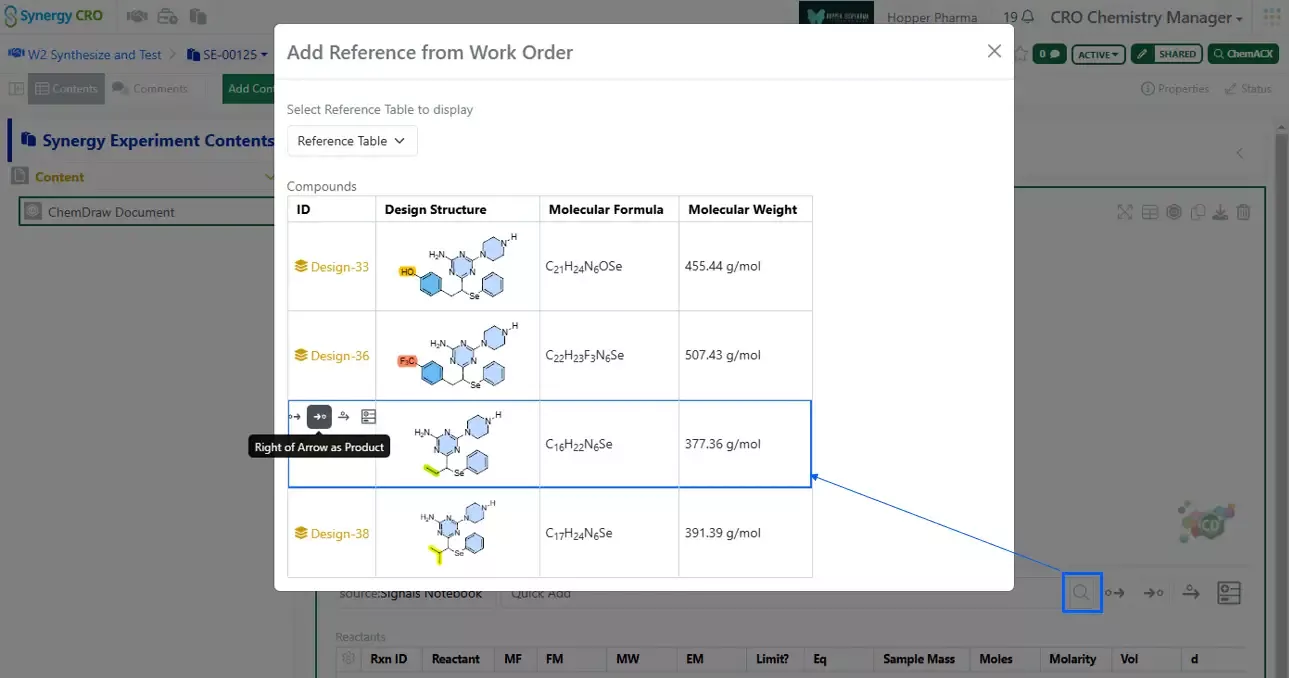
From inside a Synergy Experiment, CRO users can now utilize the Browse button in the Chemical Drawing quick add toolbar to easily bring in Design or Chemical Structures from the Work Order.



Sponsors can now Print to PDF Synergy Experiments, including components of the new Synergy Data Exchange; the original CRO report loaded into the Data Exchange as well as the resulting structured tables can be included as embedded attachments.

Finally, Due Date and Priority fields are now optional when creating and sending Work Orders.
Chemistry
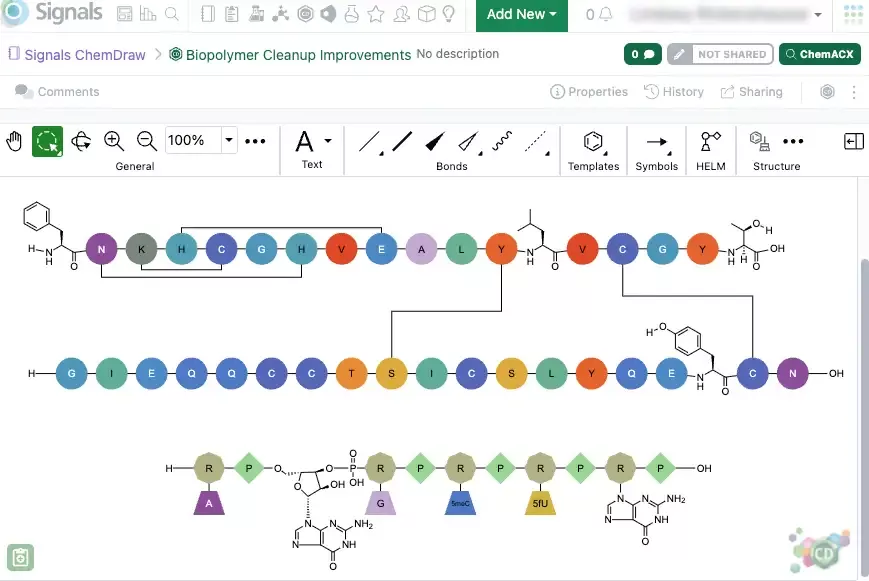
There have been significant improvements to how ChemDraw renders biopolymers to provide a clear and concise representation of complex sequences. These improvements include updates to the visualization and routing of crosslinks between sequences, as well as clean structural visualizations for all monomers that may be expanded to structures. This new capability is available in both the legacy and new ChemDraw editor in beta.
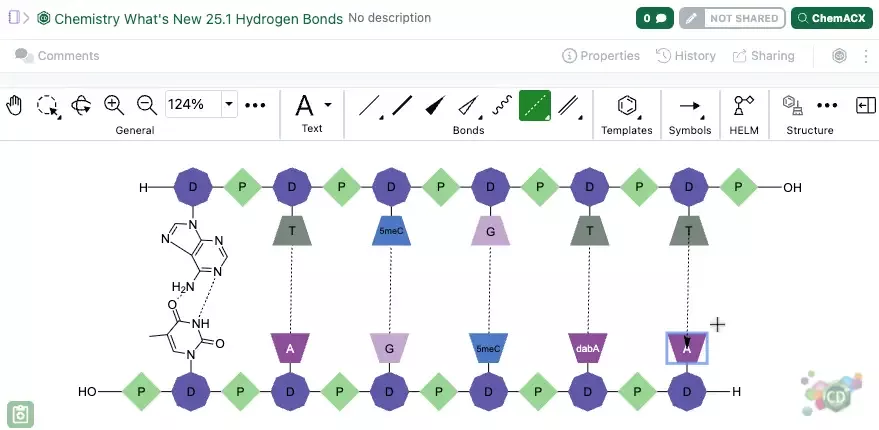
Chemists can now manually draw a hydrogen bond between complimentary strands of DNA/RNA that are generated via the HELM editor Text tab. The hydrogen bonding tool can be selected and used to place the appropriate hydrogen bonds between nucleobases according to Watson-Crick base pairing. This new capability is available in both the legacy and new ChemDraw editor in beta.
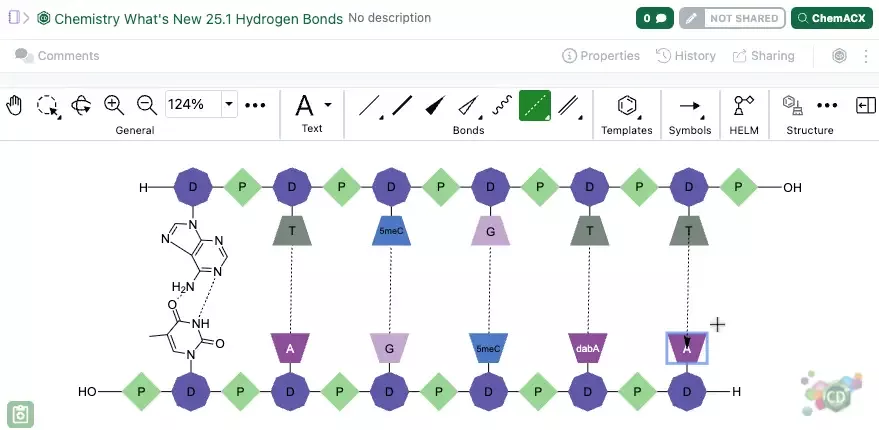
Complementary strands of any sequence length are now inserted onto the ChemDraw canvas from the HELM Text tab in a single horizontal line without line wrapping. The strands are aligned based on the complementarity of the base pairing. This new capability is available in both the legacy and new ChemDraw editor in beta.
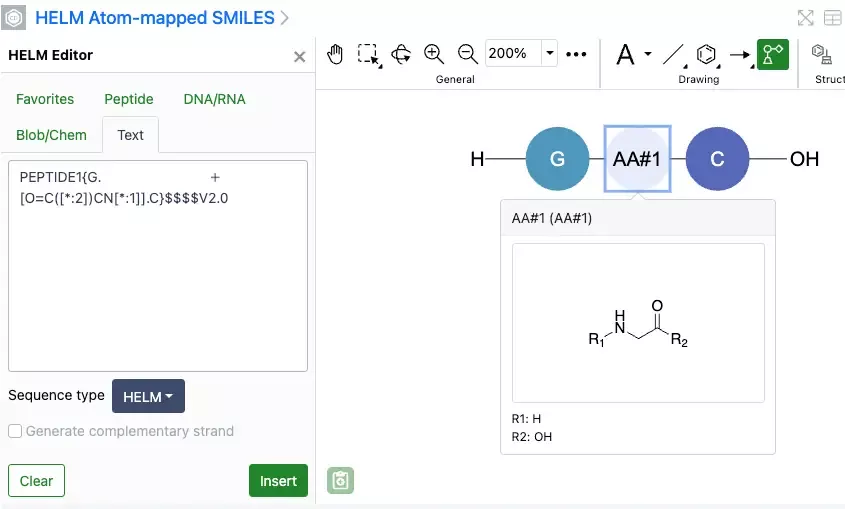
Atom-mapped SMILES are now supported in ChemDraw when inserting HELM strings or pasting them to the canvas. Additionally, when generating a HELM string for a sequence that includes an unknown or in-line monomer, the resulting HELM string will now use atom-mapped SMILES. This replaces the previously used extended SMILES format. This new capability is available in both the legacy and new ChemDraw editor in beta.
Admin Defined Tables & Variation Tables
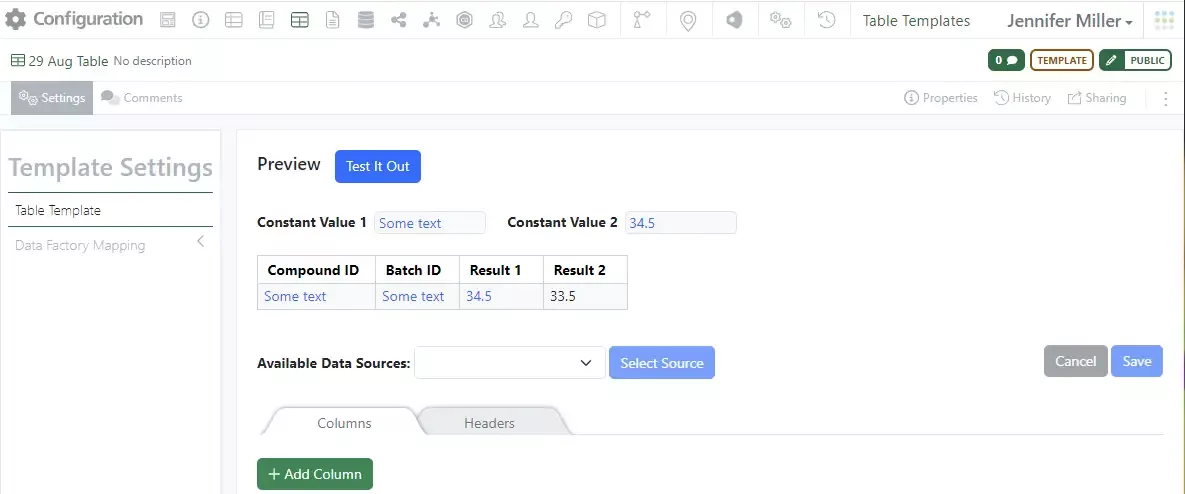
Publish Admin Defined Tables to Inventa is now available to all systems

Rows in Admin Defined Tables, and the Components view in Variation Tables, can now be reordered. Users can move a selected row up or down, or move to the top or bottom of the table. When reordered in the Components table, all the Variants will be similarly reordered. Any calculated columns where the value depends on the row order, such as using the rowOffset function, will be recalculated.
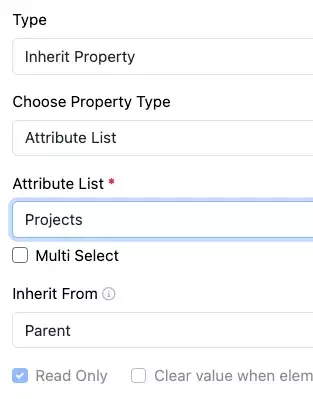

Headers in Admin Defined Tables and Variation Tables can be set to copy their values from the Name of the Experiment, or other object, that they are in. They can also be set to inherit the value(s) of an Attribute List from that Experiment.
The new Property Type “Inherit Property” can be added to Headers. The configuration Admin chooses if the property inherits a Name or values from an Attribute List, and if a list they define which Attribute List to inherit values from. Finally, the admin can choose between the “Parent” or “Ancestor”. The Parent and Ancestor are the immediate and highest level primary objects. In most cases these are both the Experiment. However, for the example of where the table is added to a Sample in an Experiment, the Parent is the Sample and the Ancestor is the Experiment.
The values are added into the Header at the time the Table is created. Should the value subsequently change, the experiment author is prompted to refresh the copied value.
Samples
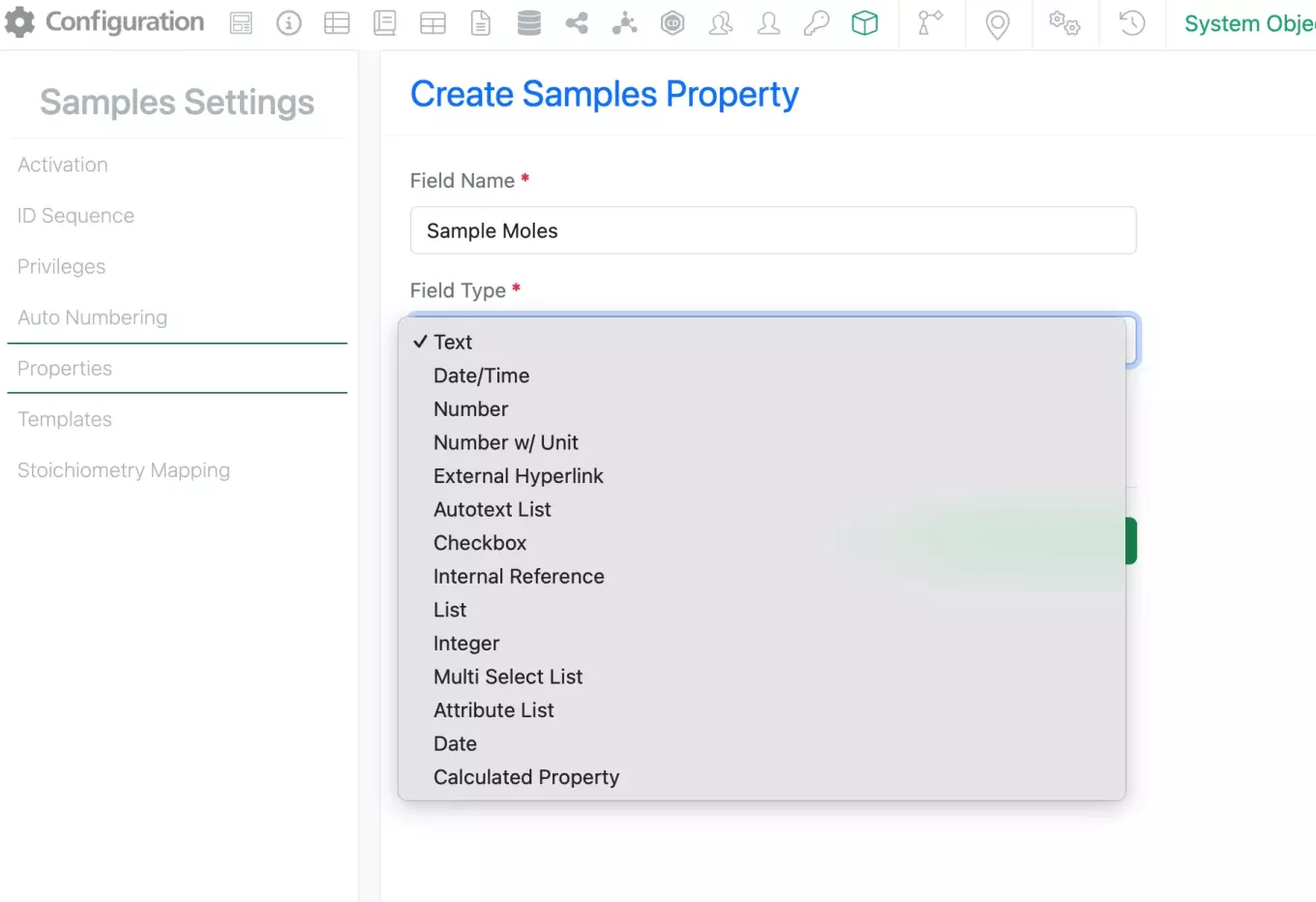
Admins can now add the Calculated fields Moles and Yield to Samples. To add these calculated fields the admin can select “Add Property” on the Sample settings and select the new Calculated Property Field type.
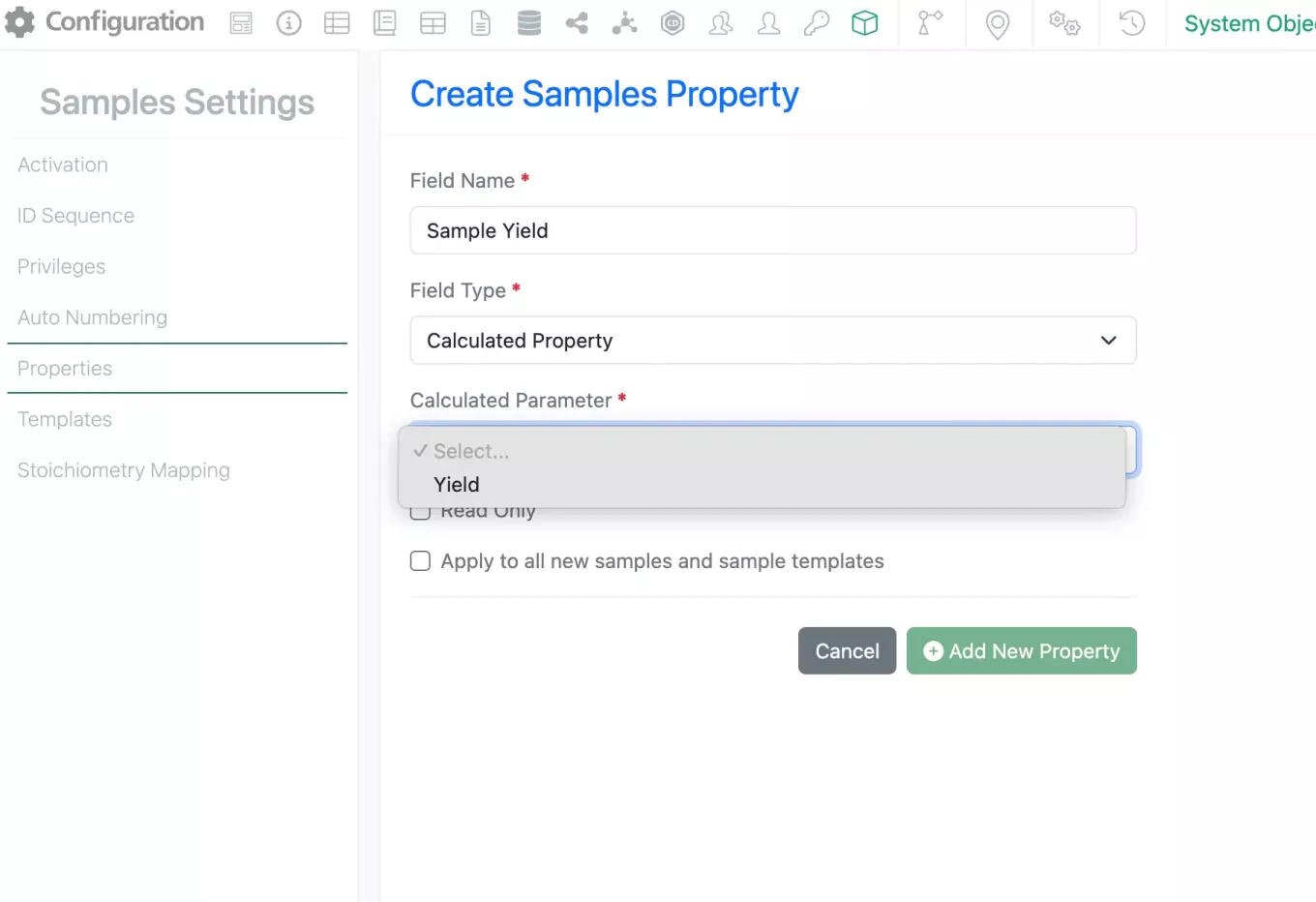
Once Calculated Property is selected as the field type, the available calculations will appear in the dropdown under “Calculated Parameter”. Currently the only options are Mole and Yield calculations (equations found below).
Moles (Sample) = Sample Amount (g)/Molecular Weight (g/mol)
Sample Yield (Sample) = Moles (Sample) / Theo Mol (Product)
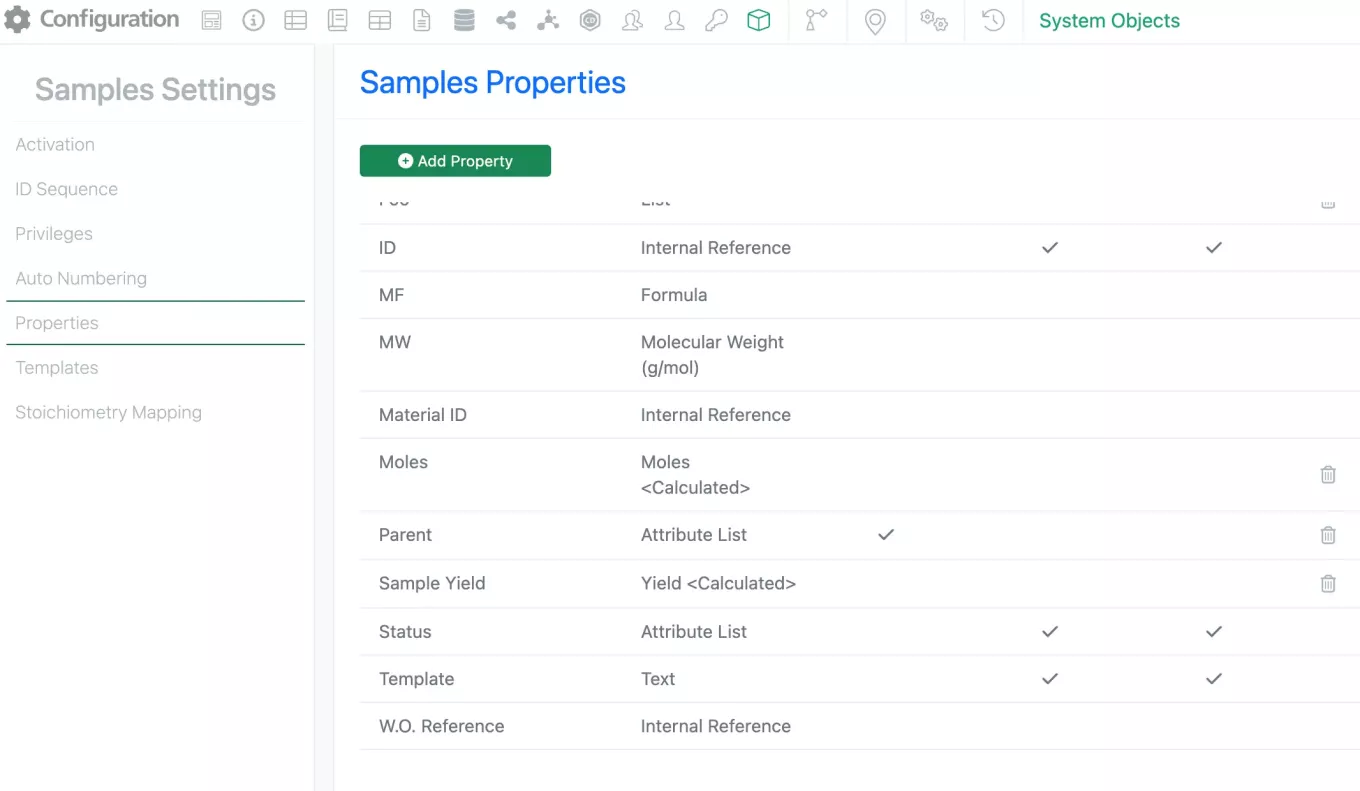
Each of these calculated parameters can only be used once and duplicates are not allowed. The properties can then be added Sample templates just like any other property.
Inventory
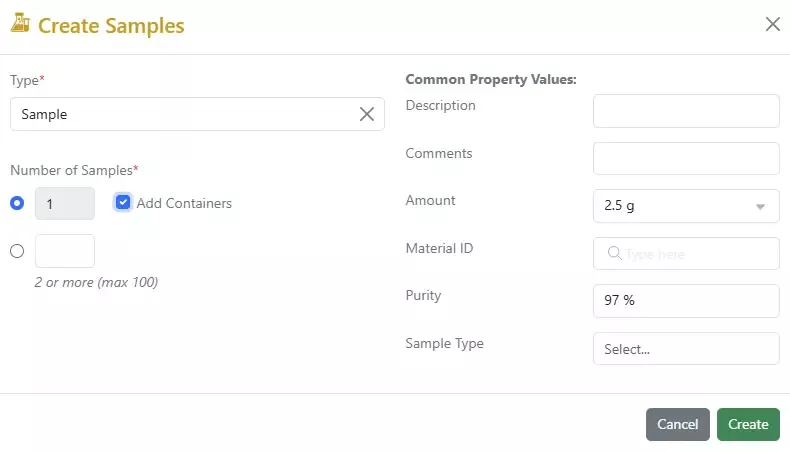
Enhancement to the Sample with Container creation workflow: When creating a new Sample, a check box is available to Add Containers at the same time. If the box is checked the container creation workflow will begin after the Sample information has been entered:

The Amount information from the Sample will be prefilled in the container:

The workflow completes with the barcode printing screen:
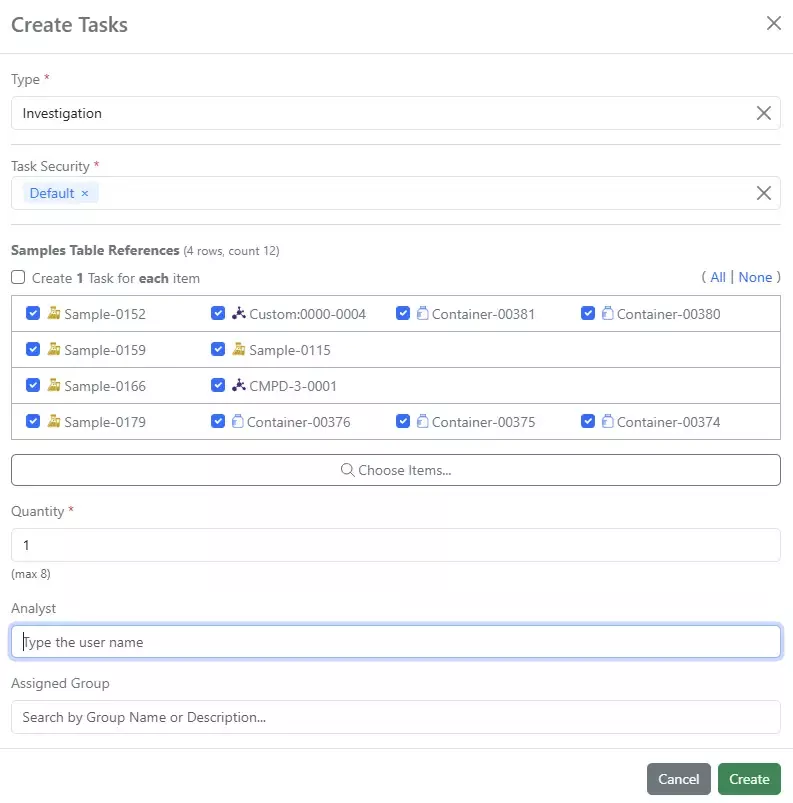
Update to Task request with Container, Sample and Material reference: When you have Containers, Material ID, and/or Sample IDs associated with a Sample in the Sample Table, they will appear in the bulk Task creation screen. All options will be checked by default:

When the tasks are created, all the references will appear grouped in 1 row:

If a task needs to be created for each reference individually, click the “Create 1 Task for each item” above the list.
New 34 x 12mm Label Size for Containers:

Expanded text Search on Containers Search Table: The Enter text to search box has been expanded to return results for all text fields, including CAS. Number and Number with unit fields will not return results:
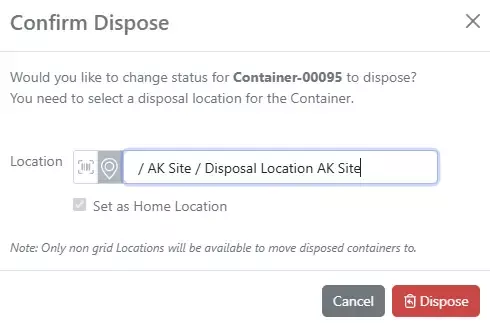
Update to Container Disposal process: When users dispose of a container, they are prompted to update the location of the container to a proper disposal location:
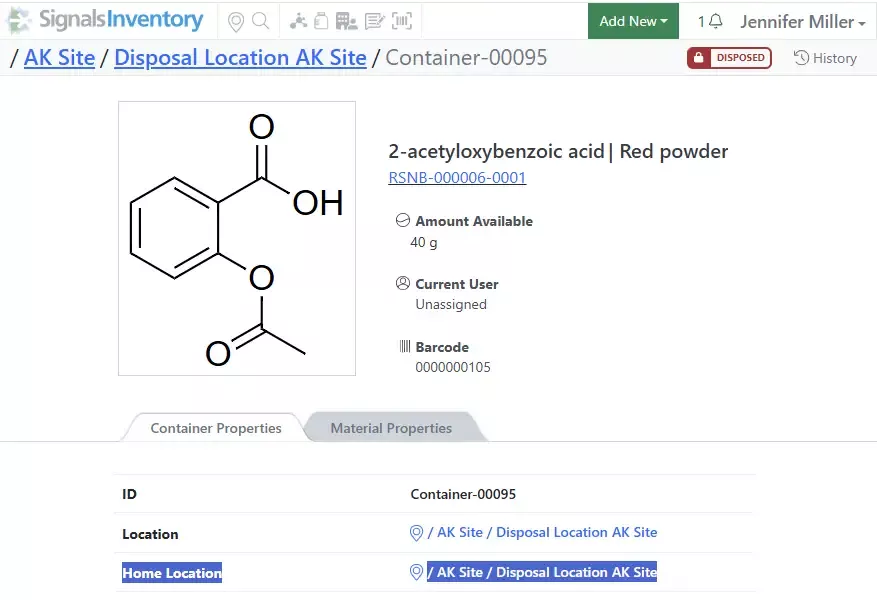
The Home Location will automatically be updated as well, this will free up any space in a gridded location when the disposal is completed.
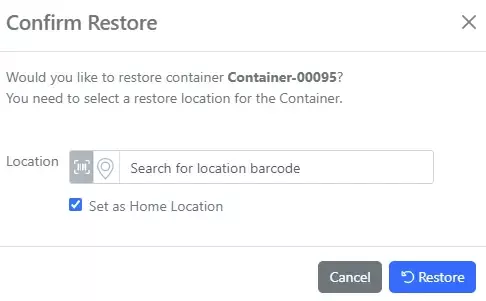
If the container is restored, a new location and Home Location will need to be selected:

Bulk update Expiration Date on Containers from the Containers Search Table: Select containers to update, then select the Expiration Date option:
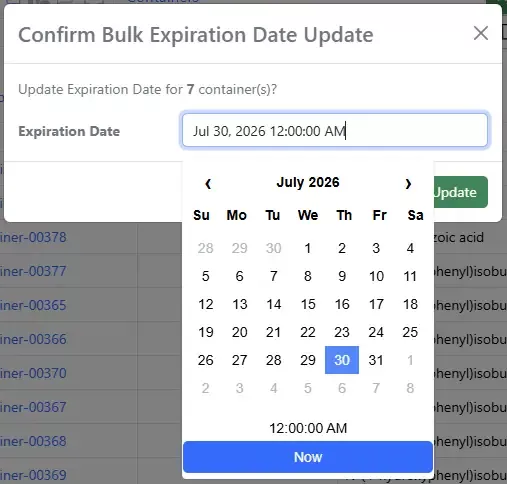
Select a new date for all the containers:
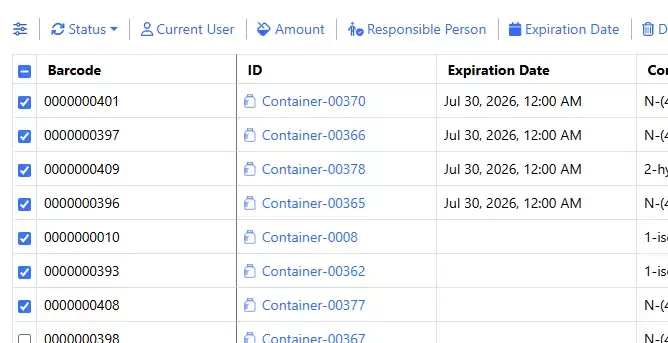
Container types that have the Expiration Date field will be updated. Container types that do not have the Expiration Date field will show as an error and will be found in the Inventory Bulk Report Container Updates:
Materials
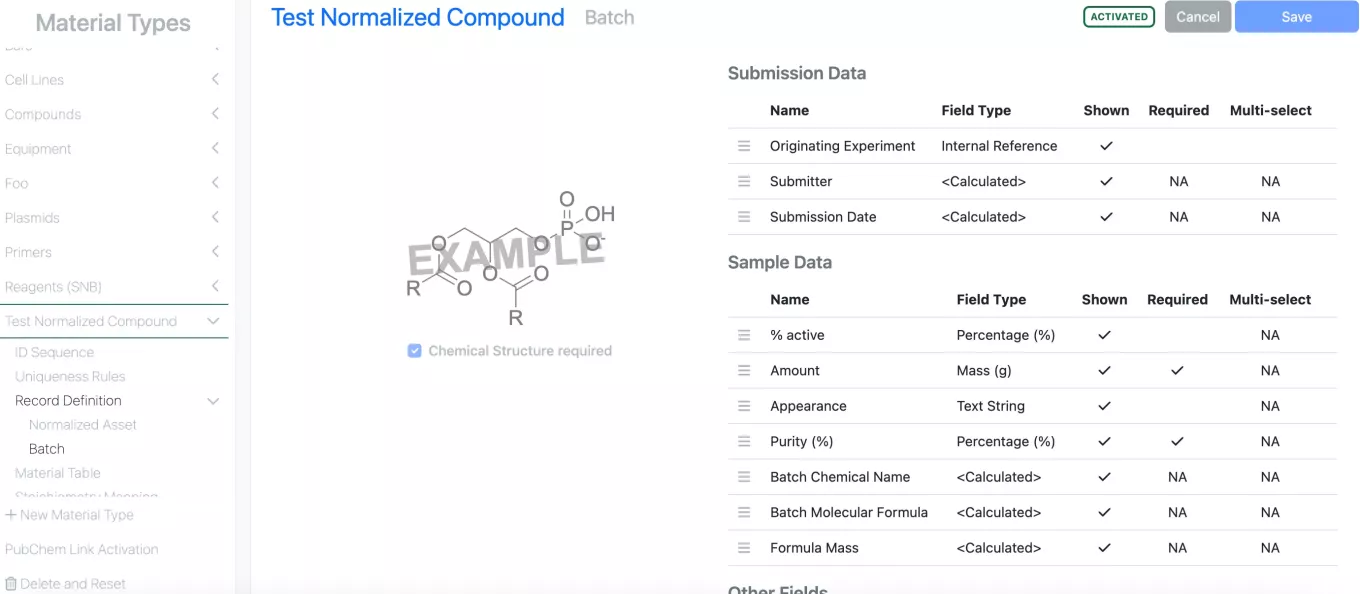
The Normalized Compounds Library type is now available to all tenants with its associated batch level chemical drawing and out of the box salt stripping on registration.
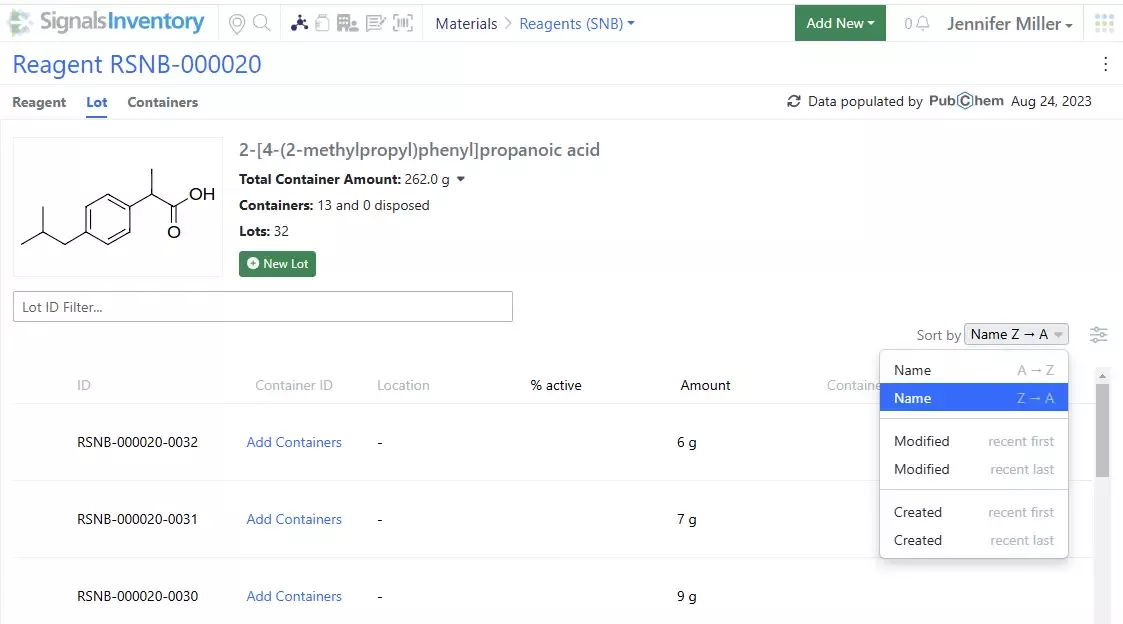
Additional sorting options added to the Batch/Lot page: User can now sort the Batches/Lots by Name, Modified or Created date:
Administration


Administrators can now define that end users can enter their own values into List properties. If the setting “Allow end user entry” is selected end users can choose from predefined list values or enter their own value. This capability is enabled for Admin Defined Tables, Variation Tables, Worksheet and stoichiometry tables.

We have added Radioactivity and Molar Radioactivity as new Measures, available in properties of type Number with Unit.
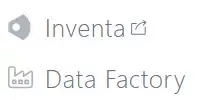

Administrators should note that the Information Design of Data Factory has moved locations to Signals Configuration. The Data Factory icon will open the configuration for Entities, Measurement Types, and their corresponding Attributes. SDF Project information will continue to be accessed from the Inventa icon.
Administrators should note the character limit for workflow signing statements has been raised to 500 characters.
Integrations & APIs

This update brings our first set of endpoints for Synergy entity creation. Only sponsors have access to APIs and configuration of external sources.
The initial set of creation API endpoints is focused on creating Work Orders, adding Design Tables to Ideas, and adding rows to Design Tables.
Work Orders are created through the new POST endpoint /synergy/workOrder

Endpoints are available to fetch required details about CROs, collaborations, departments, and work type for Work Order creation in the previous released Synergy API endpoints.
New rows (Designs) can be added to existing Design Tables via the new PATCH /synergy/designTables/{designTableId}/rows endpoint.

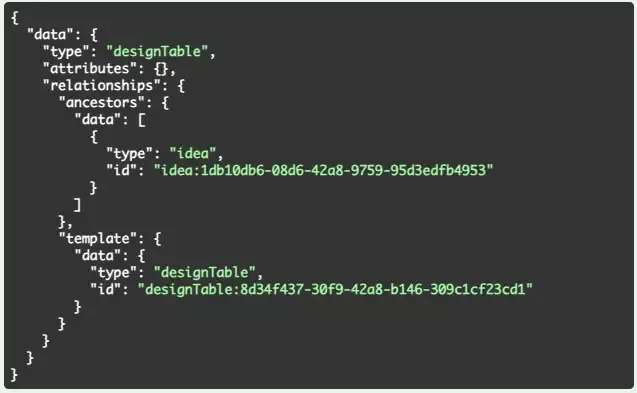
This is currently limited to adding new rows to a Design Table.
Design tables can be added to Idea’s via the POST /entities API with an appropriate request body.
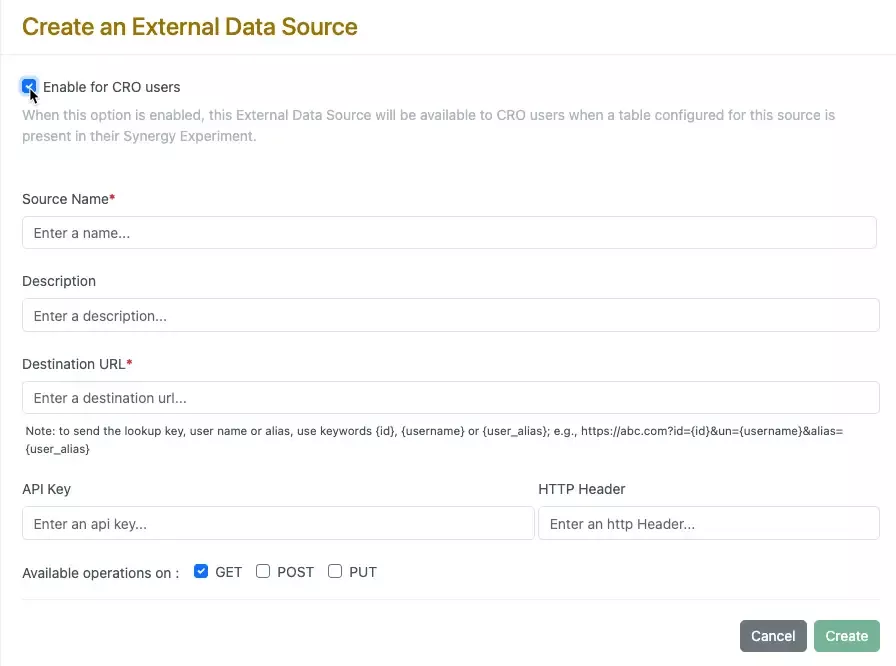
External Data Sources are now able to be enabled for CRO users. A new checkbox is available during external data source configuration. This can be used for external data sources, external list sources, and external chemical sources.


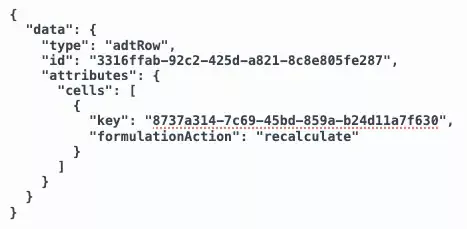
PATCH /adt/{eid}/{rowid} can now be used to update calculated values and maintain the value set until they are recalculated via the UI affordance or the API.
Read Only calculated columns are able to be updated via the API and will be unable to be recalculated via the UI but can be via the API.
Further Details
The following capabilities are in beta and are available for users, administrators and developers on the Signals platform upon request. Please contact your account representative or our support team if you would like access to the following features.
Chemistry
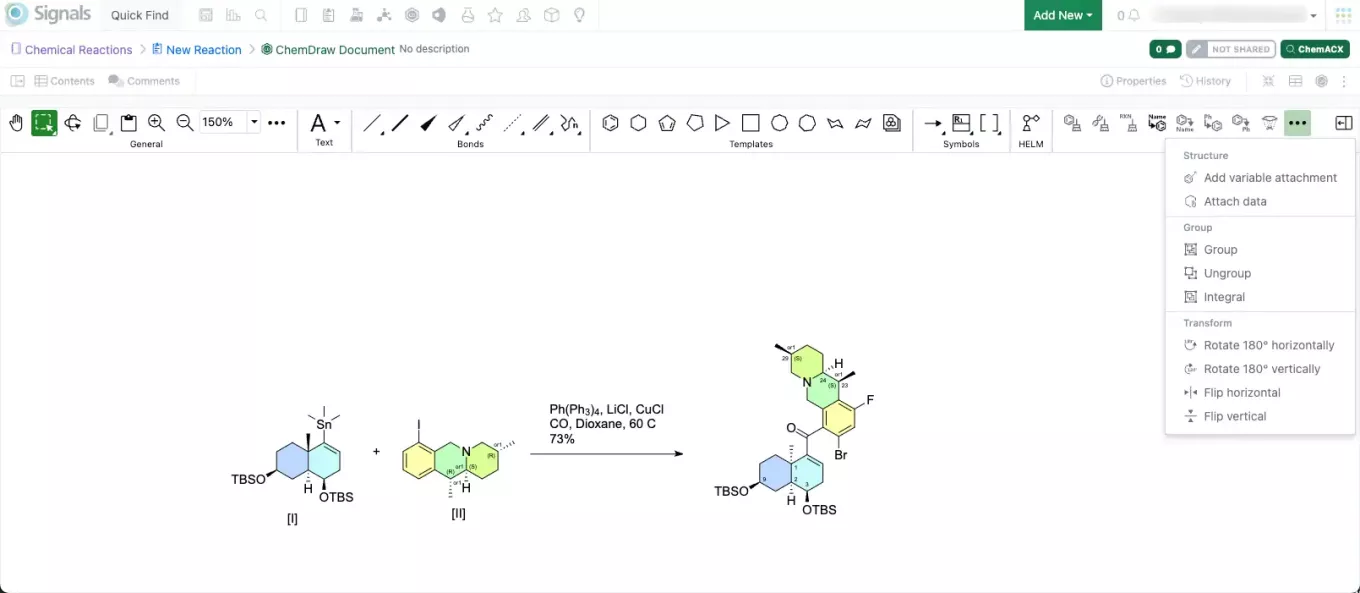
A new ChemDraw editing experience is now available upon request. The new drawing experience provides a redesigned interface with a dynamic toolbar that adapts to the space available. As tools collapse to fit the view, they remain easily accessible through menus on the toolbar.
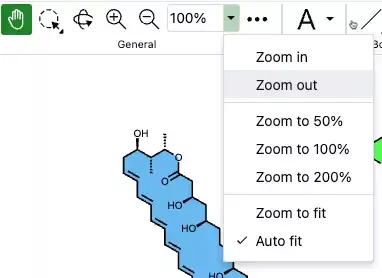
A new pan tool and adjustable zoom controls are available in the General tools of this editor. Zoom now offers enhanced control options, including 'Zoom to fit', 'Auto fit', and custom percentages that users can manually input.
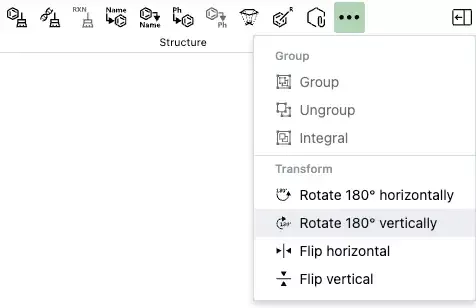
New rotate tools are available in the Transform section of the new toolbar. When used, these allow 180-degree rotation both horizontally and vertically, preserving molecular stereochemistry. This differs from flip tools, which mirror stereochemistry within a structure when used.
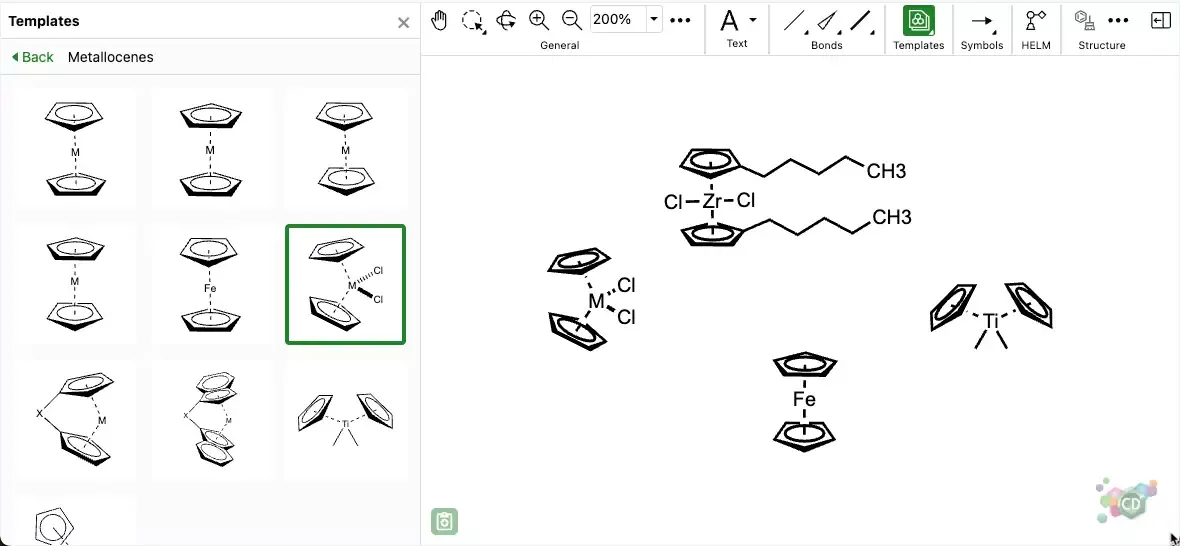
Templates have been redesigned and are now accessible via a tool that opens a resizable panel on the left side of the drawing canvas and provides users with a variety of different structures, graphics and bioart to use for drawing complex structures, reactions and figures.

New collapsible and resizable ‘Properties’, ‘Query’ and ‘Guided Stereo’ panels are available in the new ChemDraw editing experience on the right side of the editing canvas.

Users can view and modify atom, bond, bracket and biopolymer properties in the ‘Properties’ panel. The properties are context based according to the selection made on the canvas and any changes or updates made in the panel are captured in real time.
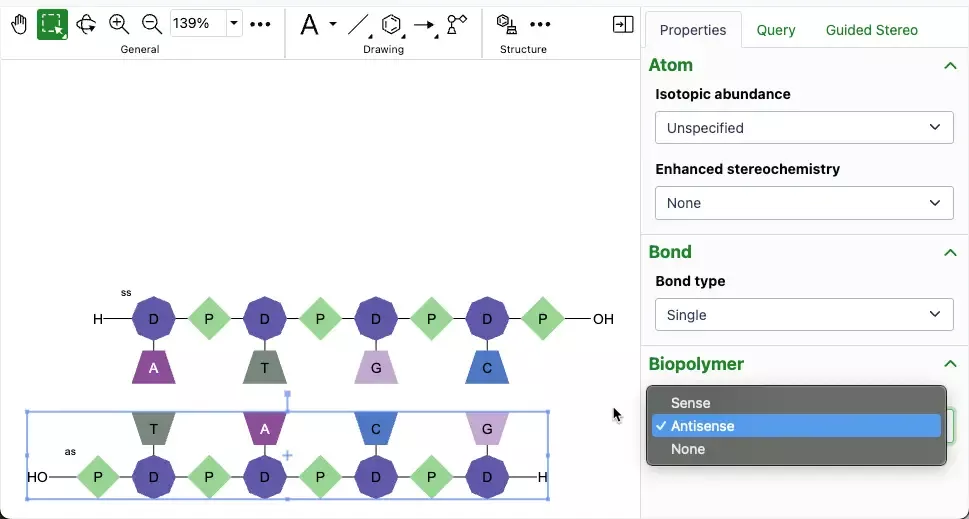
A biopolymer section in the Properties panel will allow the addition of sense & antisense annotations to an oligonucleotide in the new ChemDraw editor. When an annotation is applied, a label will be added to the oligonucleotide on the canvas. The annotation will also be included in the generated HELM string for that biopolymer.

Additional atom and bond parameters are available for the purpose of setting up a search in the ‘Query’ panel, which is also context based according to the selection made on the canvas.
Materials
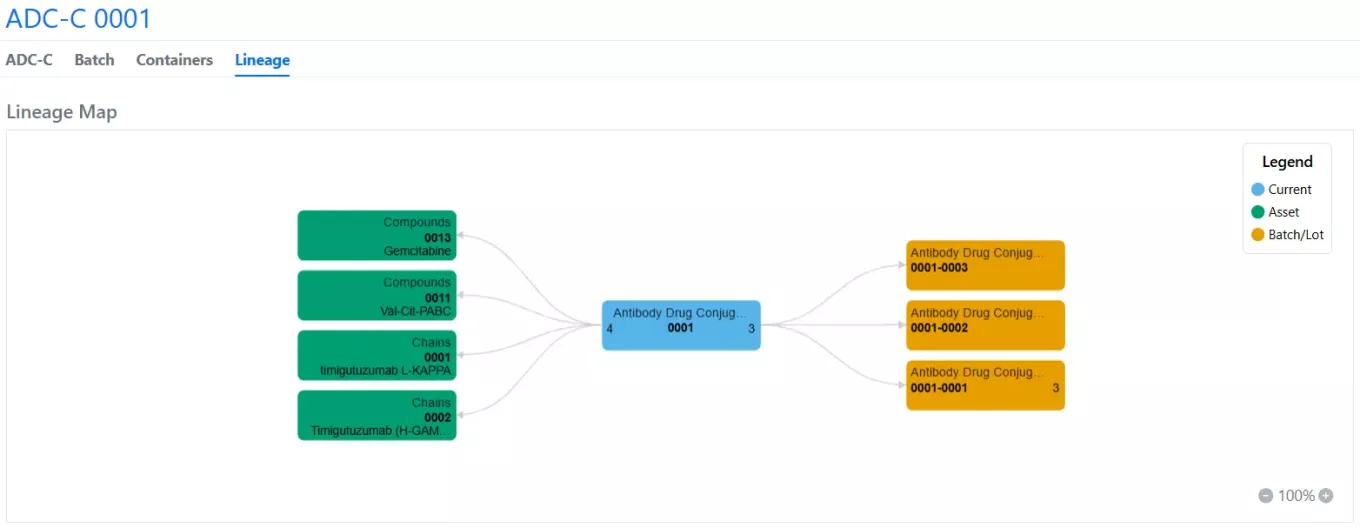
A new materials library feature called “Material Lineage Visualization” is available upon request. With it, lineage-parent relationships and batches are displayed in a new “Lineage” tab to allow end-users to explore relationships visually.

Parent objects are displayed to the left of a root node (the current Asset), and child objects and batches are displayed to the right. Options are available to expand more nodes on the graph (Expand Lineage), expand multiple generations of relationships (Expand Levels), select specific nodes for display, collapse or hide nodes, change the root node to a different entity (Mark as Current), and navigate to a specific entity in a new tab (View Entity).
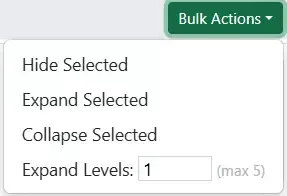
Bulk actions for multiple nodes are also available in the Actions menu under “Select Lineage Nodes.”

A table summary of all parent/child objects is also provided with editable columns via the Show/Hide Properties function.
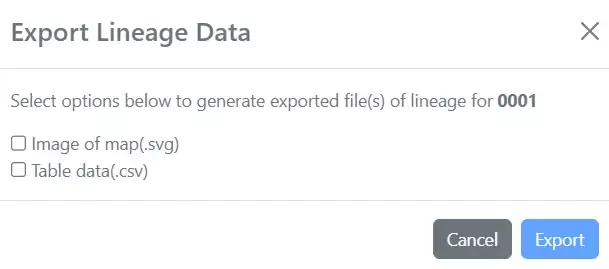
An image of the map and the table data can be exported out in the Actions menu under “Export Lineage Data.”